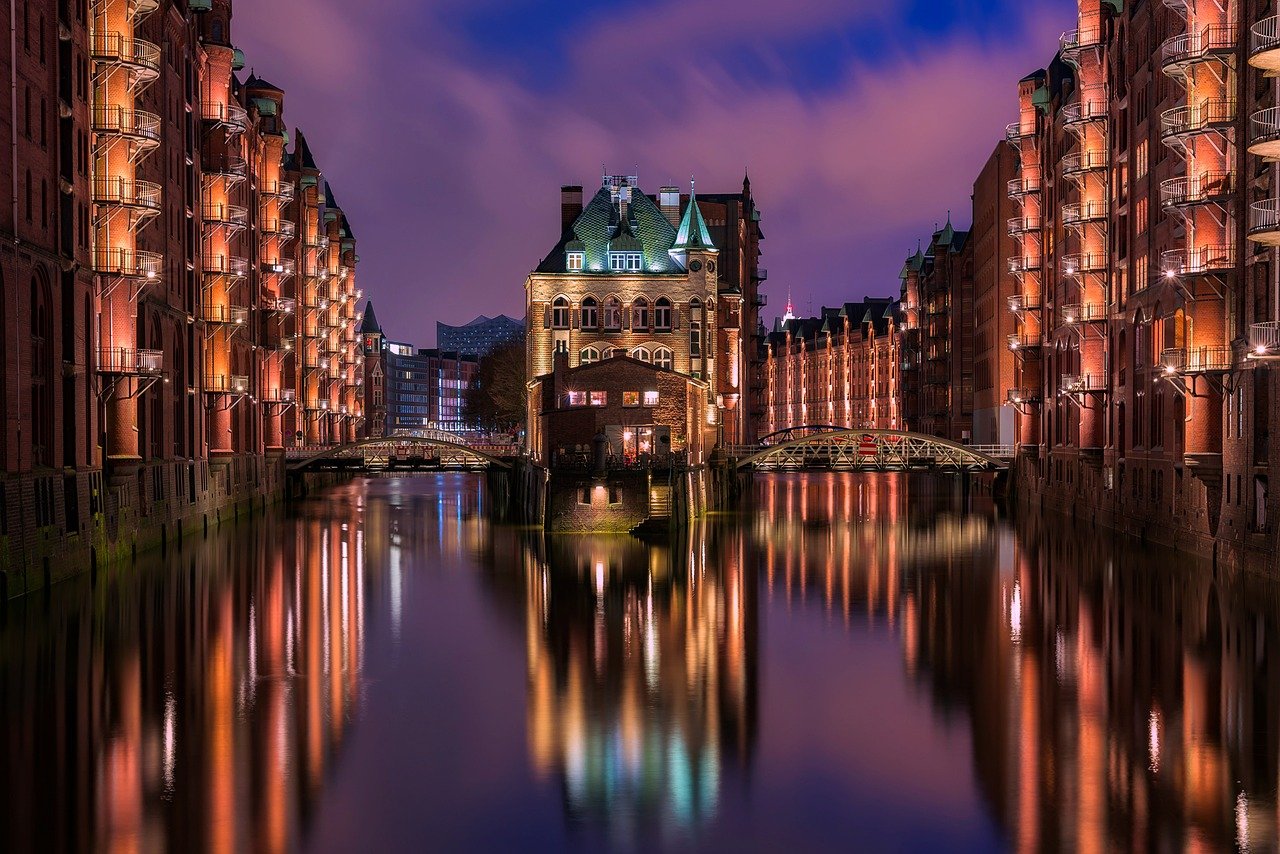

Gute Reise! Have a Great Trip! Travel Phrases in German
- Post author: Language Garage
- Post published: December 16, 2020
- Post category: German / Travel / Vocabulary
In this post we’ll look at a lot of German vocabulary and expressions that will come in handy when you travel. Let’s start with the basics.
Mein Koffer: My Suitcase
Before you travel, you of course need to pack. So let’s start there.
- der Koffer, -Ø suitcase
- Ich muss meinen Koffer packen. I need to pack my suitcase.
- Mein Koffer ist schwer/leicht/voll/leer. My suitcase is heavy/light/full/empty.
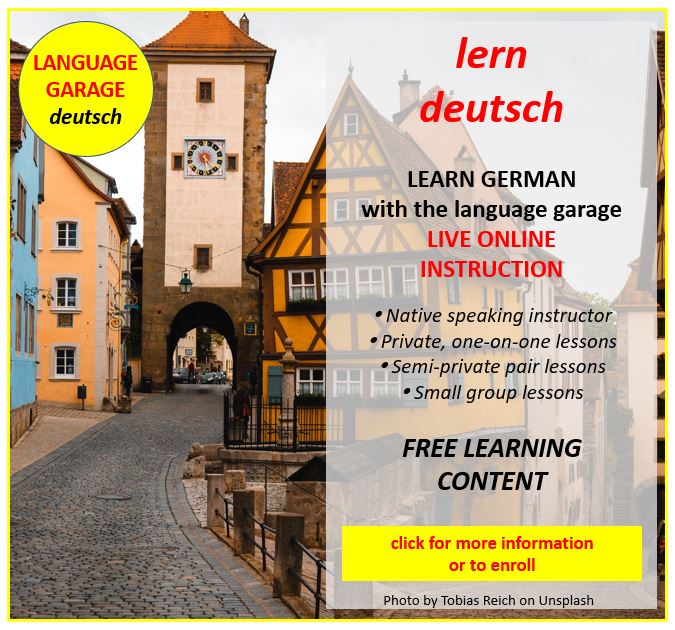
- Meine Sachen passen nicht in meinen Koffer. My clothes don’t fit in my suitcase.
- Ich brauche eine andere Tasche/einen anderen Koffer. I need another bag/suitcase.
Am Flughafen : At the Airport
If you’re traveling, you’re probably going to leave from and arrive at an airport.
- das Flugticket, -s/die Bordkarte, -n/der Pass, -¨e/der Flug, -¨e plane ticket, boarding pass, passport, flight
- die Ankunft/der Abflug/das Gate, -s/die Gepäckausgabe arrivals, departures, gate, baggage claim
- die Passkontrolle, der Zoll passport control, customs
- Ich muss mein Gepäck aufgeben. I need to check my luggage.
- Ich habe Handgepäck. I have a carry-on bag.
- Wann geht der Flug ab? When does the flight leave?
- Bei der Sicherheitskontrolle gibt’s eine lange Schlange. There’s a long line at security.
- In zehn Minuten gehen wir an Bord. We’re boarding in ten minutes.
- der Fensterplatz/Gangplatz/Mittenplatz window seat, aisle seat, middle seat
- der Pilot, -en/die Pilotin, -nen/der Flugbegleiter, -Ø/die Flugbegleiterin, -nen pilot, flight attendant
- Bitte legen Sie die Sicherheitsgurte an. Please fasten your seatbelt.
- Bitte stellen Sie ihr Mobiltelefon ab. Please turn off your cell phone.
- Wir lang ist der Flug? How long is the flight?
- Wir landen in zehn Minuten. We’re landing in ten minutes.
- Wir müssen durch den Zoll und die Passkontrolle. We need to go through customs and passport control.
- Wo ist die Gepäckausgabe? Where’s the baggage claim area?
- Wo stehen die Taxis? Where are the taxis?
- Fährt ein Zug/Bus in die Stadt? Is there a train/bus to the city?
- Ich muss Geld wechseln. I need to exchange money.
Im Hotel: At the Hotel
You’ve finally arrived, so let’s get you settled in your hotel room.
- Wo ist das Hotel? Where is the hotel?
- Ich würde mich gern anmelden. I’d like to check in.
- Ich habe eine Reservierung auf den Namen _____. I have a reservation. My name is ______.
- Wo ist der Aufzug? Where’s the elevator?
- Auf welcher Etage ist mein Zimmer? What floor is my room on?
- das Zimmer, -Ø/das Bett, -en/das Badezimmer, -Ø/das Fenster, -Ø/der Fernseher, -Ø/das Telefon, -e room, bed, bathroom, window, television, phone
- das Bettlaken, -Ø/die Wolldecke, -n/das Kissen, -Ø/der Bademantel, -¨Ø sheets, blanket, pillow, bathrobe
- Gibt es Zimmerservice? Is there room service?
- Kann ich bitte eine Extrawolldecke bekommen? Can I have an extra blanket?
- Kann ich ein Bügeleisen und ein Bügelbrett bekommen? Can I have an iron and an ironing board?
- Kann ich einen Föhn bekommen? Can I have a blow-dryer?
- Kann ich meine Sachen waschen lassen? Can I have my clothes washed?
- Die Heizung funktioniert nicht. The heat isn’t working.
- Die Klimaanlage funktioniert nicht. The air conditioning isn’t working.
- Lassen Sie bitte mein Zimmer sauber machen. Please clean my room.
- Kann ich ein anderes/größeres/ruhigeres Zimmer bekommen? Can I have another room / a bigger room / a quieter room?
- Wo wird das Frühstück serviert? Where do we eat breakfast?
- Gibt es ein Fitnesscenter? Is there an exercise room?
- Gibt es ein Schwimmbecken? Is there a pool?
- Gibt es eine Bar? Is there a bar?
- Gibt es ein Restaurant? Is there a restaurant?
- Haben Sie Wifi? Do you have WiFi?
- Wie ist das Wifi-Passwort? What’s the WiFi password?
- Wann muss das Zimmer geräumt werden? What time is check-out?
- Ich würde gern auschecken. I would like to check out.
- Könnten Sie mir bitte ein Taxi rufen? Can you call a taxi for me?
Ich habe hunger! I’m hungry
When you’re traveling, it’s important to know some basic terms for food, drink, and how to navigate a nice meal at a local restaurant. Check out this post , which covers all of that!
- Wo ist der Bahnhof? Where is the train station?
Once you’re settled into your hotel, you probably want to know where things are in case you need to pop out and buy something.
- Gibt es ein 24-Stunden-Geschäft in der Nähe? Is there a convenience store nearby?
- Gibt es eine Apotheke in der Nähe? Is there a pharmacy nearby?
- Gibt es einen Supermarkt in der Nähe? Is there a supermarket nearby?
- Gibt es ein gutes Restaurant in der Nähe? Is there a good restaurant nearby?
- Gibt es ein Krankenhaus/eine Arztpraxis in der Nähe? Is there a hospital/doctor’s office nearby?
- Gibt es einen Buchladen in der Nähe? Is there a bookstore nearby?
- Gibt es ein Kleidungsgeschäft in der Nähe? Is there a clothing store nearby?
- Gibt es ein Schuhgeschäft in der Nähe? Is there a shoe store nearby?
- Wo ist die U-Bahnhaltestelle? Where is the subway station?
- Wo ist die Bushaltestelle? Where is the bus station?
- Das ist gleich neben dem Hotel. It’s next to the hotel.
Of course, if you ask where things are, you’ll need some basic vocabulary related to directions and getting around.
- Ist das in der Nähe? Is it nearby?
- Ist das weit? Is it far from here?
- Kann ich dahin zu Fuß gehen? Can I walk there?
- Das ist (ganz) in der Nähe. It’s nearby.
- Das ist sehr weit von hier. It’s far from here.
- Das ist gleich gegenüber. It’s across the street.
- Gehen Sie über die Straße. Cross the street.
- Gehen Sie über die Brücke. Cross the bridge.
- Gehen Sie nach rechts. Turn right.
- Gehen Sie nach links. Turn left.
- Gehen Sie geradeaus. Go straight ahead.
- Das ist beim Bahnhof. It’s next to the train station.
- Das ist in der Nähe vom Bahnhof. It’s near the train station.
- Das ist hinter dem Bahnhof. It’s behind the train station.
- Das ist links neben dem Bahnhof. It’s the left of the train station.
- Das ist rechts neben dem Bahnhof. It’s to the right of the train station.
- Das ist vor dem Bahnhof/gegenüber vom Bahnhof. It’s in front of the train station.
Lasst uns eine Stadtrundfahrt machen. Let’s go sightseeing.
- Wir wollen eine Stadtrundfahrt machen. We want to go sightseeing.
- Haben Sie einen Stadtplan? Do you have a map of the city?
- Gibt es einen Bus für Stadtrundfahrten? Is there a tour bus?
- Gibt es einen Reiseführer? Is there a tour guide?
- Wir möchten ein Museum besuchen. We want to go to a museum.
- Wir möchten eine Kathedrale/einen Tempel/eine Moschee besichtigen. We want to visit a cathedral/temple/mosque.
- Wir möchten in den Park gehen. We want to go to the park.
- Wir möchten eine Kunstgalerie besuchen. We want to visit an art gallery.
- Wir möchten ein Theaterstück/eine Oper/ein Konzert sehen. We want to see a play/opera/concert.
- Wir möchten eine Burg besichtigen. We want to visit a castle.
- Wir möchten ein Denkmal besichtigen. We want to visit a monument.
- Welche historischen Stätten sollten wir besichtigen? Which historical sites should we visit?
- Welche kulturellen Stätten sollten wir besichtigen? Which cultural sites should we visit?
- Wo ist die beste Einkaufsgegend? Where’s the best neighborhood for shopping?
- Wo gibt es das beste Nachtleben? Where’s the best neighborhood for nightlife?
- Wir möchten eine Bar/einen Nachtklub besuchen. We want to go to a bar/nightclub.
- Von wo hat man einen guten Blick auf die Stadt? Where is there a good view of the city?
- Wir möchten auf einen Wochenmarkt gehen. We want to visit a market.
- Gibt es eine öffentliche Toilette in der Nähe? Is there a public bathroom nearby?
- Wo sind die Toiletten? Where is the bathroom?
- Wo ist der Ausgang/Eingang? Where is the exit/entrance?
- Wieviel kostet eine Führung/Rundfahrt? How much does a tour cost?
Wohin fährt dieser Zug? Where does this train go?
You probably want to see some sights outside of the city, and for that you’ll need to get around.
- Wir möchten nach Hamburg fahren. We want to go to Hamburg.
- Ich hätte gern eine Fahrkarte nach Hamburg. I’d like a bus ticket/train ticket to Hamburg.
- Wieviel kostet eine Fahrkarte? How much does a ticket cost?
- Ich möchte eine einfache Fahrt. I want a one-way ticket.
- Ich brauche eine Rückfahrkarte. I want a round-trip ticket.
- Wann fährt der Zug/Bus ab? When does the train/bus leave?
- Wann kommt der Zug/Bus an? When does the train/bus arrive?
- Fährt dieser Zug/Bus nach Hamburg? Does this bus/train go to Hamburg?
- Wie lang ist die Fahrt nach Hamburg? How long does it take to go to Hamburg.
- Wo kann ich ein Auto mieten? Where can I rent a car?
- Wie komme ich zum Strand/ins Gebirge/zum Nationalpark? How can I get to the beach/mountains/national park?
- Was/Wieviel kostet das? How much does it cost?
When you’re traveling, you probably need to by all sorts of things. Let’s cover that vocabulary.
- Wo kann ich eine Landkarte/eine Flasche Wasser/eine Tasse Kaffee kaufen? Where can I buy a map/a bottle of water/a cup of coffee?
- Wo kann ich eine Sonnenbrille/Aspirin/Sonnenschutzcreme kaufen? Where can I buy sunglasses/aspirin/sunscreen?
- Wo kann ich Ansichtskarten/Souvenirs kaufen? Where can I buy postcards/souvenirs?
- Wo kann ich etwas zu essen/trinken kaufen? Where can I buy something to eat/something to drink?
- Schreiben Sie mir bitte den Preis auf. Please write the price.
- Kann ich bar bezahlen? Can I pay by cash?
- Kann ich mit Kreditkarte bezahlen? Can I pay by credit card?
- Das ist zu teuer. That’s too expensive.
- Haben Sie etwas Billigeres? Do you have something less expensive?
- Darf ich mir das ansehen? Can I see that, please?
- Ich nehme dies/das hier. I’ll take this/that.
- Kann ich das anprobieren? Can I try it on?
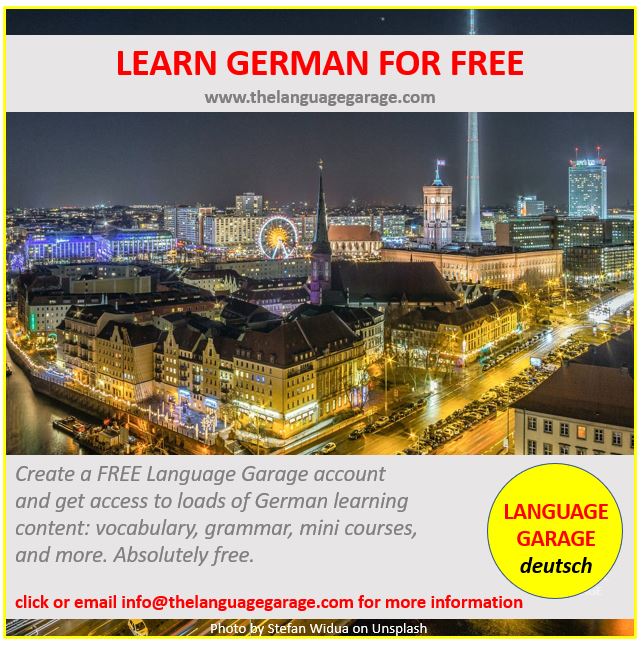
Do you want to learn German?
Check out our other posts on German language, culture, and more . And if you’re looking for convenient and affordable live German lessons with a real teacher, check out The Language Garage German . Our lessons are given online in a virtual classroom, so it doesn’t matter where you live or work. We can come to you. And we have flexible options, with a free trial so that you can decide if there’s a fit. Check us out!
Image by David Mark from Pixabay .
Please Share This Share this content
- Opens in a new window
You Might Also Like

Ich habe Angst! I’m afraid! German Vocabulary for Halloween!

Na cozinha: In the Kitchen in Portuguese

Les vêtements: Clothes in French
How to Say “Have a Safe Trip” in German: A Comprehensive Guide
Planning a trip to a German-speaking country and wondering how to wish someone a safe journey? Look no further! In this guide, we will explore different ways to express “have a safe trip” in German, covering both formal and informal variations. We will provide you with practical tips, examples, and even delve into regional variations if necessary. So, let’s get started!
Formal Ways to Say “Have a Safe Trip” in German
When it comes to communicating in a formal or polite manner, the German language offers several options to wish someone a safe trip. Here are a few common phrases:
Gute Reise!
The phrase “Gute Reise” is the most widely used way of wishing someone a safe trip in German. It’s simple, concise, and suitable for formal situations. You can use this phrase in various contexts, such as when saying goodbye to a colleague who is traveling or bidding farewell to a business partner.
Ich wünsche Ihnen eine gute Reise!
If you want to express a more personal touch, you can use this slightly longer version, “Ich wünsche Ihnen eine gute Reise!” This phrase features the formal pronoun “Ihnen” to show respect and politeness. It’s ideal for formal occasions, such as wishing a superior or professor a safe journey.
Informal Ways to Say “Have a Safe Trip” in German
Informal situations and conversations with friends or family call for a more relaxed approach. Here are a few informal ways to express “have a safe trip” in German:
Yes, you read it right! “Gute Reise” can also be used in informal settings. It’s a versatile phrase that works well regardless of the formality level. Whether you’re saying goodbye to a close friend or a family member, “Gute Reise” will always be an appropriate choice.
Pass auf dich auf!
For a more personal and caring tone, you can say “Pass auf dich auf!” which translates to “Take care of yourself!” This phrase not only expresses the wish for a safe journey but also conveys a sense of concern for the other person’s well-being. It’s perfect for bidding farewell to a loved one or a close friend.
Tips and Examples
Now that we’ve covered the formal and informal ways to wish someone a safe trip in German, let’s dive into some tips and examples to help you better understand the usage and context.
1. Timing and Context
It’s common in German culture to exchange well wishes before a trip during the farewell moment. Make sure to take the opportunity to express your wishes for a safe journey right before the person leaves. This timing ensures that your warm words stay fresh in their mind as they embark on their travels.
2. Non-Verbal Communication
Accompanying your verbal wishes with appropriate non-verbal cues can enhance the impact of your well wishes. You can offer a warm smile, a sincere handshake, or even a heartfelt hug, depending on the relationship you have with the person. Non-verbal communication can help convey your genuine concern for their safety and well-being.
3. Adding Personal Touch
Adding a personal touch can make your well wishes more memorable and meaningful. For example:
- Refer to the specific destination: “Have an amazing time exploring Berlin!”
- Mention their favorite activities: “Enjoy the skiing in the Alps!”
- Bring up memories: “Remember to visit that lovely café we discovered last time!”
Adding these personal details shows that you genuinely care about the person’s trip and creates a stronger connection.
4. Using Regional Variations
The German language has regional variations, especially when it comes to local dialects. While “Gute Reise” is understood throughout the German-speaking world, there might be slight differences in the way people express well wishes in specific regions. If you want to delve into regional variations, here are a few examples:
- In Bavaria: “Vergelt’s Gott!” (May God repay you!)
- In Austria: “Habe eine gsunde Reise!” (Have a healthy trip!)
- In Switzerland: “E gueti Reis!” (Have a good trip!)
Keep in mind that these regional variations are not mandatory and might not be commonly used, but they can add charm and authenticity depending on the person’s background or the region they are traveling to.
Expressing well wishes for a safe trip in German is an essential aspect of polite and heartfelt communication. Whether you opt for a formal or informal approach, phrases like “Gute Reise” or “Pass auf dich auf” will undoubtedly convey your concern and best wishes for the other person’s journey. Remember to consider the context, timing, and even add a personal touch to make your wishes more memorable. With this guide, you’re now equipped with the knowledge to bid farewell like a true German!
Related Posts

Guide: How to Say "Have a Safe Trip" - Formal and Informal Ways
When someone you care about is about to embark on a journey, expressing your wishes for their safety and well-being is essential. By saying "have a safe trip," you not only convey your concern but also offer them positive thoughts for their upcoming adventure. This guide will provide you with a variety of ways to express this sentiment, both formally and informally. So, whether you're bidding farewell to a close friend or a business associate, here are some tips and examples to help you convey your wishes effectively.
How to Say "Have a Safe Trip and Enjoy": A Comprehensive Guide
When someone dear to us sets off on a journey, it's only natural to wish them well. In expressing our heartfelt wishes, we often say, "Have a safe trip and enjoy". This simple phrase encapsulates our desire for their safety and enjoyment during their travels. However, depending on the occasion, relationship, and level of formality, there are various ways to convey this sentiment. In this guide, we'll explore both formal and informal ways to express this phrase, providing you with tips, examples, and even regional variations where necessary.
Guide on How to Say "Have a Safe Trip Back"
When bidding farewell to someone who is about to embark on a journey, it is customary to express well wishes and emphasize the importance of their safety. Saying "Have a safe trip back" is a common way to convey this sentiment. Depending on the situation and level of formality, there are various ways to express these wishes. This guide will provide you with both formal and informal ways to say "Have a safe trip back," along with tips, examples, and regional variations.
How to Say "Have a Safe Trip Back Home": A Guide with Tips and Examples
Saying "have a safe trip back home" is a thoughtful and caring way to bid farewell to someone who is traveling back to their residence. Whether you want to express your wishes formally or informally, this guide provides you with various phrases, tips, and examples to do so effectively. We'll explore both casual and formal expressions that can be used in different situations. So, let's dive in!
Guide: How to Say "Have a Safe Trip Home"
Giving well wishes for a safe journey is a thoughtful gesture that shows you care for someone's well-being. Regardless of whether you are bidding farewell to a friend, family member, or colleague, expressing your hope for their safe journey home is always appreciated. In this guide, we will explore various ways to convey this message, both formally and informally, while also providing tips, examples, and regional variations (if necessary). Let's dive in!
How to Say "Have a Safe Trip" in Arabic: A Comprehensive Guide
Traveling is an exciting and enriching experience, and it's essential to wish someone a safe journey before they embark on their adventure. If you are looking to express this sentiment in Arabic, you've come to the right place! In this guide, we'll explore various ways to say "have a safe trip" in Arabic, including both formal and informal expressions. While Arabic consists of numerous dialects, we will focus mainly on Modern Standard Arabic (MSA) while also mentioning regional variations when deemed necessary. Let's get started!
How to Say "Have a Safe Trip" in Armenian: A Comprehensive Guide
Armenian is a beautiful language spoken by millions of people around the world. If you're planning to wish someone a safe trip in Armenian, you've come to the right place. In this guide, we will provide you with formal and informal ways to convey this kind message. While there are no notable regional variations for this phrase, we'll focus on the standard Eastern Armenian dialect spoken in Armenia. Let's delve into the various ways to express "Have a safe trip" in Armenian with plenty of tips, examples, and linguistic insights!
How to Say "Have a Safe Trip" in Bengali: Formal and Informal Ways
If you're traveling to Bangladesh or have Bengali-speaking friends, it's always nice to be able to wish someone a safe journey in Bengali. In this guide, we'll explore different ways to say "Have a safe trip" in Bengali, providing formal and informal variations for different situations. We'll also include some regional variations, where necessary. So, let's begin!
Cancel reply
Save my name, email, and website in this browser for the next time I comment.
Arabic Cantonese Chinese Dutch English Farsi Filipino French German Greek Hawaiian Hebrew Hindi Irish Italian Japan Japanese Korean Latin Mandarin Mexican Navajo Norwegian Polish Portuguese Punjabi Romanian Russian Sanskrit Sign Language Spanish Swahili Swedish Tagalog Tamil Thai Turkish Ukrainian Urdu Vietnamese

- Privacy Policy
You are using an outdated browser. Please upgrade your browser or activate Google Chrome Frame to improve your experience.
136 Useful German Travel Phrases, Expressions and Vocabulary Words
Planning your big trip to Germany is so exciting—but you’re not done until you’ve brushed up on common German phrases for travel.
In this post, you’ll find a handy phrasebook of German travel phrases and vocabulary , conveniently organized by group.
Print it out or keep it on your phone for smooth travels and the trip of a lifetime.
German Greetings, Introductions and Goodbyes
German expressions for shopping, german travel phrases for the restaurant, german words and phrases for directions, german travel phrases for public transportation, german travel phrases for the hotel, german phrases for getting around the city, german words and expressions for emergencies, german expressions for language help, german guides for traveling, german apps for travelers, why you should learn german travel phrases, and one more thing....
Download: This blog post is available as a convenient and portable PDF that you can take anywhere. Click here to get a copy. (Download)
Please note that most of these German sentences are in the formal Sie conjugation. For your travel purposes, this form should be just fine, although native speakers may opt to use different pronoun forms with you depending on the context.

A trusty guide fits in your backpack or purse, and it serves as a way to look up unfamiliar words and phrases or brush up on vocab while traveling from one place to another. Here are some recommendations:
“Rick Steves’ German Phrase Book and Dictionary”

You can’t go wrong with Rick Steves, since the man has traveled all over Europe (numerous times), hosted his own travel show and written dozens of bestselling guides for European travel.
From meeting new people to ordering a bratwurst, this guide outlines the most common everyday phrases to further improve your travel lingo. It also comes with phonetic spellings , currency information, rail transportation guides and a cheat sheet that you can tear out and slide in your pocket.
“German Survival Guide”

This guide can give you the confidence to speak with people while traveling through Germany and Austria. It touches on cultural points and shows you how to interact with German speakers a various spots such as the Autobahn, grocery stores, ice cream parlors and more.
It includes vocabulary and basic German instruction , with travel and study tips scattered throughout the entire guide. It’s a rather helpful book for your travels if staying in Germany or Austria for quite some time.
Lonely Planet German Phrasebook and Dictionary
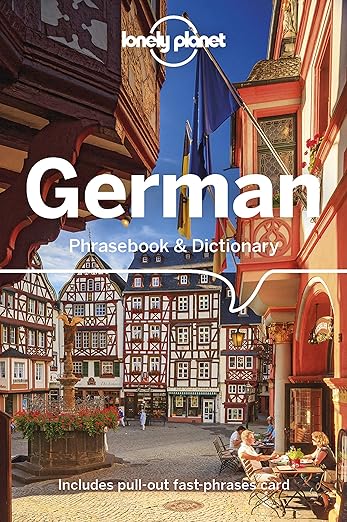
This German phrasebook has a huge section for decoding restaurant menus and ordering food properly, plus a 3,500-word two-way German-English dictionary.
The cultural manners section can prevent you from embarrassing yourself or making others feel uncomfortable and help you feel at ease while traveling.
Lonely Planet at large has tons of German phrasebook and travel guide options available on their site. Read these ahead of time to know what to expect wherever you go, then bring them on your trip to whip out at a moment’s notice.
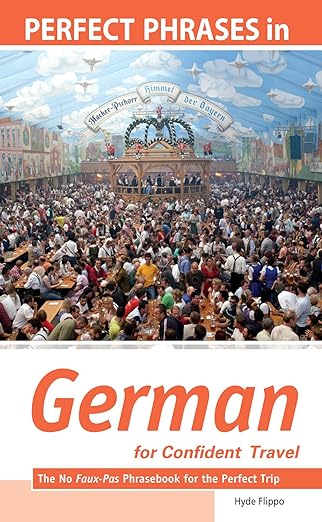
“Perfect Phrases in German for Confident Travel”
Context and manners are extremely important when going to Germany, just like they are in every country. If you insult a person’s language, why would they talk to you in return?
The “Perfect Phrases” book details the proper words and phrases to use while traveling, while also discussing faux pas and how they can hurt your conversation.
“Point it: Traveller’s Language Kit”

This guide may not help you much with your pronunciation, but it’s an essential tool to bring with you while traveling in German-speaking countries.
The “Point It” book has 1,300 images and words, so you can point at the images when your speaking abilities fail. For example, point to the picture of a chicken when ordering at a restaurant.
A good app can serve as a viable replacement for a travel and language guide that doesn’t add any weight to your pack. Plus, the apps generally offer audio to hear how to pronounce certain words and phrases. Here are some great options:
Learn German Phrases & Words: Phrases for Travel in Germany

The Learn German Phrases & Words app is designed to boost your speaking capabilities while traveling. It can be used without an internet connection, so you can always depend on it.
The visual guide has carefully categorized sections like greetings, eating, romance and health. The app has over 800 common German phrases, and the German-speaking parrot pronounces everything for you.
Learn German – Phrasebook
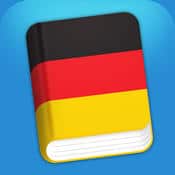
This phrasebook is free, but you can upgrade to receive all of the phrases and words for your travels. The app works as a quick reference perfect for tourists visiting Germany.
The main page shows categories like numbers, general conversation and transportation. Once you select a category and phrase, it gives you the option to hear a spoken version and slow down the audio for better understanding.
Wie Geht ‘s German

The Wie Geht ‘s app provides a few lessons with audio tracks that are useful while moving around the world. It has a travel section filled with options like directions, meeting people, weather, shopping, money and more.
Membership is required to get most of the content. The app is formatted like a class, but feel free to skip around and use the examples when you come across a moment when they are needed.
Germany Travel Guide Offline

The German Travel Guide app is not going to help you much with your German learning, but it may prevent you from getting lost.
The app works online and offline, with detailed maps for navigating cities like Berlin, Munich and Hamburg. Check out weather, time and fun suggestions while moving around the cities.
With this app, you can immerse yourself in the German language and culture before stepping foot in Germany.
FluentU takes authentic videos—like music videos, movie trailers, news and inspiring talks—and turns them into personalized language learning lessons.
You can try FluentU for free for 2 weeks. Check out the website or download the iOS app or Android app.
P.S. Click here to take advantage of our current sale! (Expires at the end of this month.)

Try FluentU for FREE!
- Even if you can’t have a fluent conversation, native German speakers always appreciate when foreigners put the effort into learning a bit of their language . It shows respect and demonstrates that you truly want to reach out and connect with people while abroad.
- You won’t be totally reliant on your German phrasebook. Yes, your German phrasebook has glossy pages and you love getting the chance to use it—but you want to be able to respond quickly when people speak to you, at a moment’s notice.
- If you can express yourself with some basic German phrases , you are less likely to be taken advantage of by taxi drivers, souvenir shops and waiters!
- The perception that all German speakers speak English is simply not true. Even in big German cities you’ll find loads of people that know very little English. You don’t want to have to track down other English speakers every time you have a question or want to make a friend.
Try practicing some of these phrases out loud to get your pronunciation right before leaving on your travels.
Before we part ways, there’s one final German travel phrase you need to know: Gute Reise! (Have a good trip!)
Want to know the key to learning German effectively?
It's using the right content and tools, like FluentU has to offer ! Browse hundreds of videos, take endless quizzes and master the German language faster than you've ever imagine!
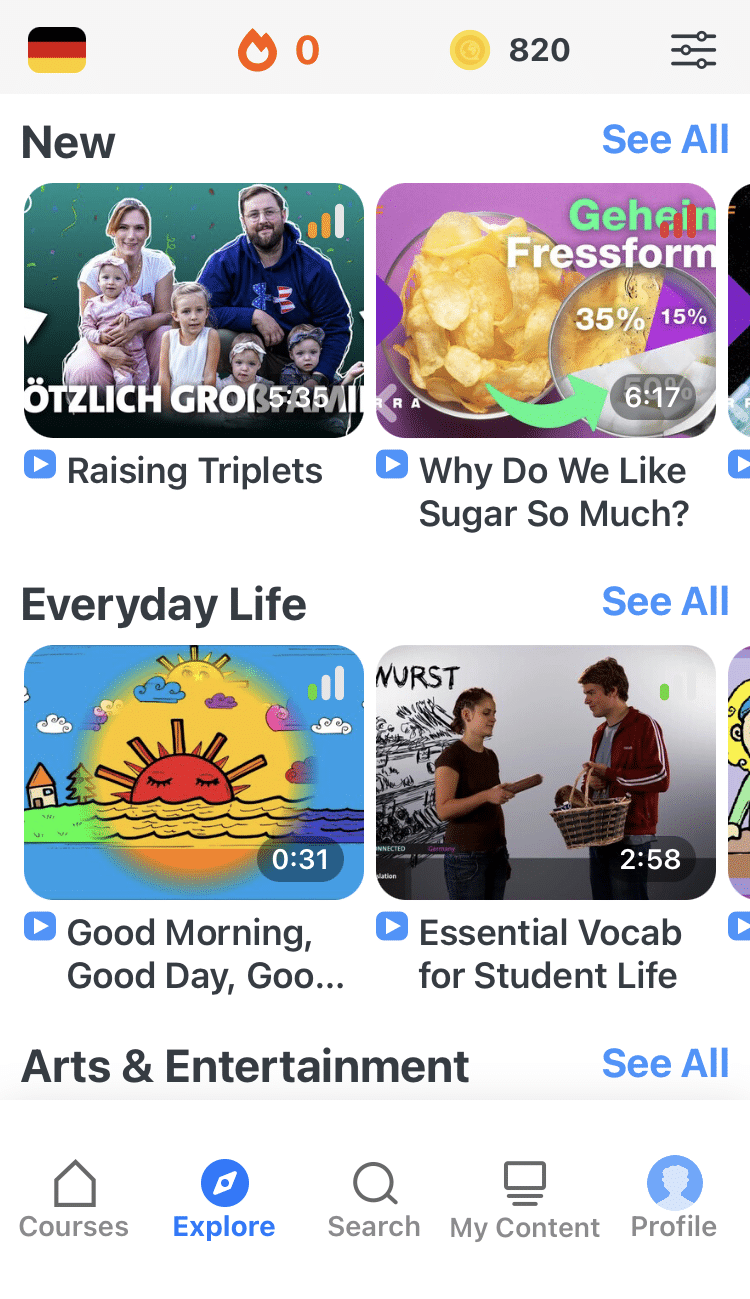
Watching a fun video, but having trouble understanding it? FluentU brings native videos within reach with interactive subtitles.
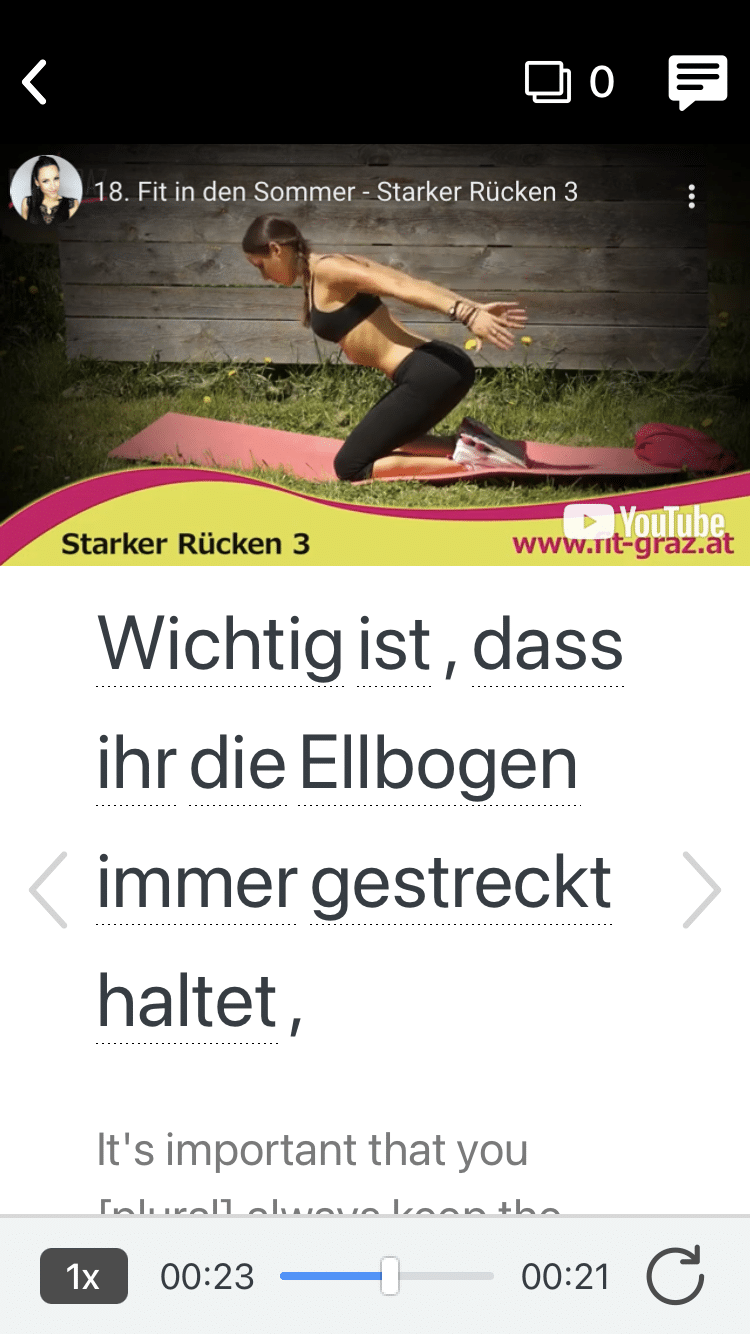
You can tap on any word to look it up instantly. Every definition has examples that have been written to help you understand how the word is used. If you see an interesting word you don't know, you can add it to a vocabulary list.
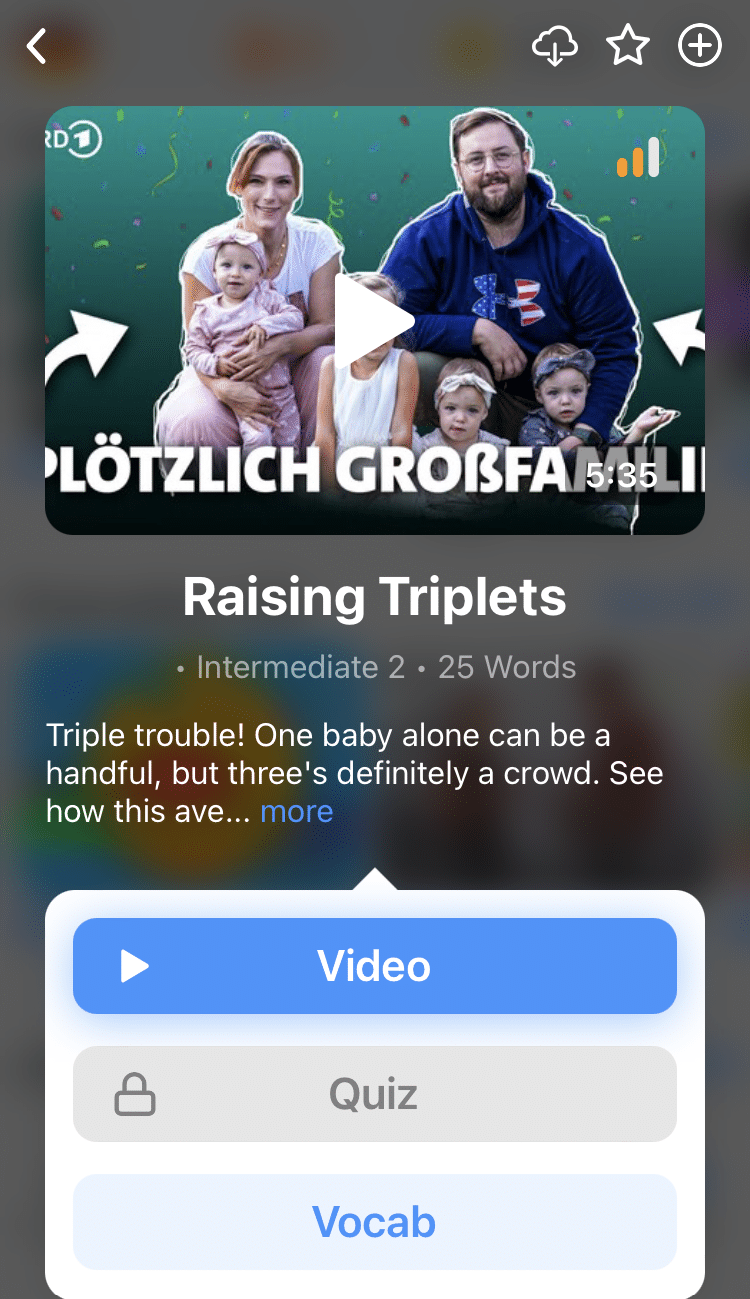
And FluentU isn't just for watching videos. It's a complete platform for learning. It's designed to effectively teach you all the vocabulary from any video. Swipe left or right to see more examples of the word you're on.
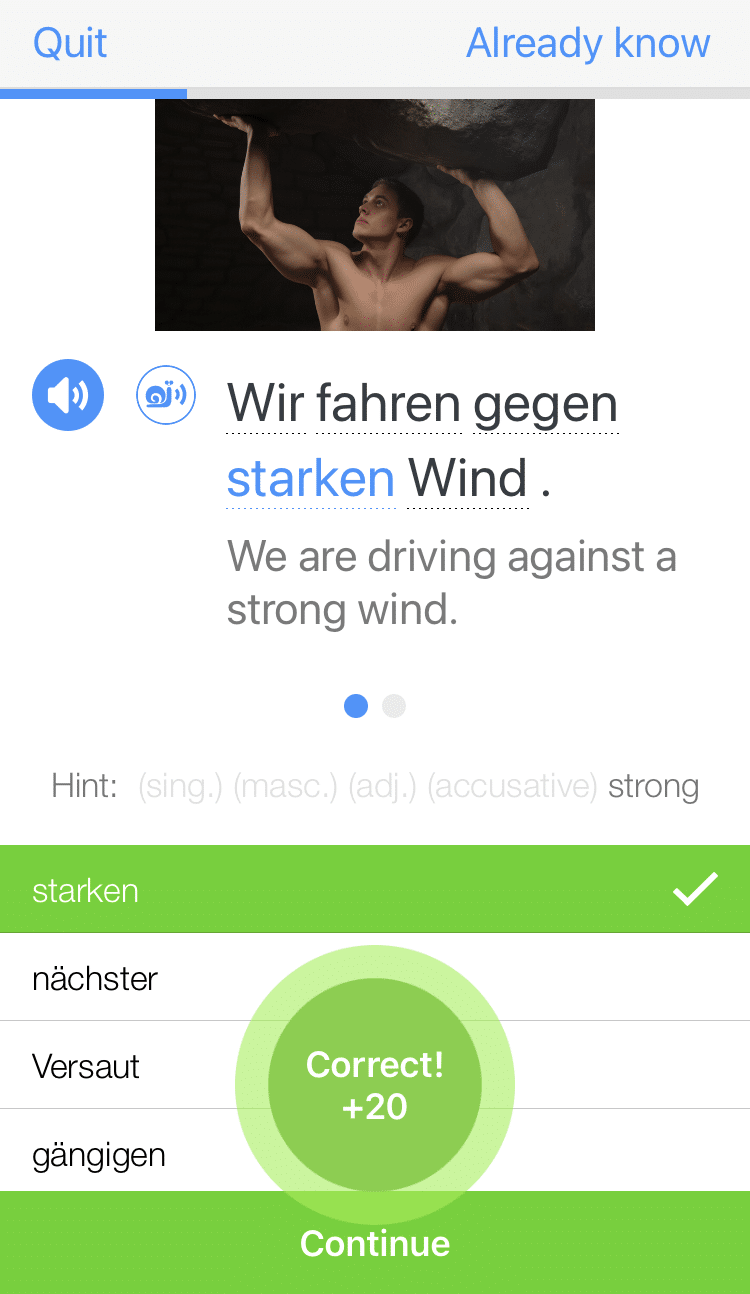
The best part is that FluentU keeps track of the vocabulary that you're learning, and gives you extra practice with difficult words. It'll even remind you when it’s time to review what you’ve learned.
Start using the FluentU website on your computer or tablet or, better yet, download the FluentU app from the iTunes or Google Play store. Click here to take advantage of our current sale! (Expires at the end of this month.)
Enter your e-mail address to get your free PDF!
We hate SPAM and promise to keep your email address safe

Top 50 German Phrases for Tourism and Travel
Discover the top 50 german phrases for tourism and travel. learn essential german expressions for your next trip. useful phrases for tourists in german., introduction.
If you're planning a trip to Germany, knowing a few basic German phrases can go a long way in enhancing your travel experience. While many Germans speak English, making an effort to communicate in their language shows respect and can lead to more meaningful interactions. In this article, we have compiled the top 50 German phrases that will help you navigate through popular tourist destinations, interact with locals, and make the most out of your trip.
Greetings and Basic Phrases
These phrases will help you in everyday interactions and create a positive impression:
- Hallo! - Hello!
- Guten Tag! - Good day!
- Guten Morgen! - Good morning!
- Guten Abend! - Good evening!
- Bitte - Please
- Danke - Thank you
- Entschuldigung - Excuse me
- Wie geht es Ihnen? - How are you?
Transportation
These phrases will assist you in navigating public transportation and getting around:
- Wo ist der Bahnhof? - Where is the train station?
- Wie komme ich zum Flughafen? - How do I get to the airport?
- Ist der Bus pünktlich? - Is the bus on time?
- Eine Fahrkarte, bitte. - One ticket, please.
- Wann fährt der Zug ab? - When does the train depart?
- Kann ich hier ein Taxi finden? - Can I find a taxi here?
- Welche Linie fährt zum Stadtzentrum? - Which line goes to the city center?
- Wie weit ist es zum nächsten Bahnhof? - How far is it to the nearest train station?
- Wie viel kostet eine Tageskarte? - How much does a day pass cost?
- Wie lange dauert die Fahrt? - How long does the journey take?
Accommodation
These phrases will come in handy when dealing with hotel reservations and accommodations:
- Haben Sie ein Zimmer frei? - Do you have any rooms available?
- Ich habe eine Reservierung auf den Namen... - I have a reservation under the name...
- Ist das Hotel in der Nähe? - Is the hotel nearby?
- Gibt es einen Aufzug? - Is there an elevator?
- Wie spät ist das Frühstück? - What time is breakfast?
- Die Rechnung, bitte. - The bill, please.
- Kann ich hier rauchen? - Can I smoke here?
- Wo ist die nächste Bank? - Where is the nearest bank?
- Gibt es eine Gepäckaufbewahrung? - Is there luggage storage?
- Wie lange bleibt das Museum geöffnet? - How long does the museum stay open?
Dining and Food
These phrases will help you navigate menus and order food:
- Guten Appetit! - Enjoy your meal!
- Ich möchte bestellen - I would like to order.
- Haben Sie eine Speisekarte? - Do you have a menu?
- Was ist die Empfehlung des Tages? - What is the recommendation of the day?
- Ist dieses Gericht vegetarisch? - Is this dish vegetarian?
- Können Sie das bitte anpassen? - Can you please customize that?
- Ich bin allergisch gegen... - I am allergic to...
- Können Sie mir etwas empfehlen? - Can you recommend something to me?
- Könnten Sie bitte nachfüllen? - Could you please refill?
- Die Rechnung, bitte - The bill, please.
Sightseeing and Shopping
These phrases will assist you during sightseeing and shopping:
- Wo kann ich eine Stadtrundfahrt machen? - Where can I take a city tour?
- Gibt es eine geführte Tour durch die Sehenswürdigkeiten? - Is there a guided tour of the attractions?
- Wie komme ich zur nächsten U-Bahn-Station? - How do I get to the nearest subway station?
- Wo ist das berühmte Denkmal? - Where is the famous monument?
- Können Sie mir den Weg zum Museum zeigen? - Can you show me the way to the museum?
- Haben Sie diese Sehenswürdigkeit auf einer Karte? - Do you have this attraction on a map?
- Wie viel kostet der Eintritt? - How much does the admission cost?
- Wo ist das Einkaufszentrum? - Where is the shopping mall?
- Gibt es hier gute Einkaufsmöglichkeiten? - Are there good shopping opportunities here?
- Wo kann ich Souvenirs kaufen? - Where can I buy souvenirs?
Equipping yourself with these top 50 German phrases will enable you to navigate Germany confidently and interact with locals in a friendly manner. Remember to practice these phrases before your trip and don't be afraid to use them. Germans will appreciate your efforts to speak their language, making your travel experience even more enjoyable and rewarding. Have a fantastic trip!

Discover a better way to learn German online.
Regular conversation practice is the key to fluency. There's no better way to build confidence, develop comprehension skills and an authentic accent. It's fun, effective and guaranteed to get you talking.
Start for free today. We've helped thousands of students learn a new language online and we can help you too.

Ayami Hamakawa
Radu Titirca

David Askill
John Barton

Sharyn Doherty
Daniel Moore
Get Started Today Bring Learning German to Life
Native teachers, great pricing, ultimate flexibility.
Sign up and take a free trial lesson with no obligation. No credit card required.
GERMAN TOPICS
Success stories, learning german.
Get a free trial lesson with a native speaking online German tutor today.
Nomadic Matt's Travel Site
Travel Better, Cheaper, Longer
Germany Travel Guide
Last Updated: April 18, 2024
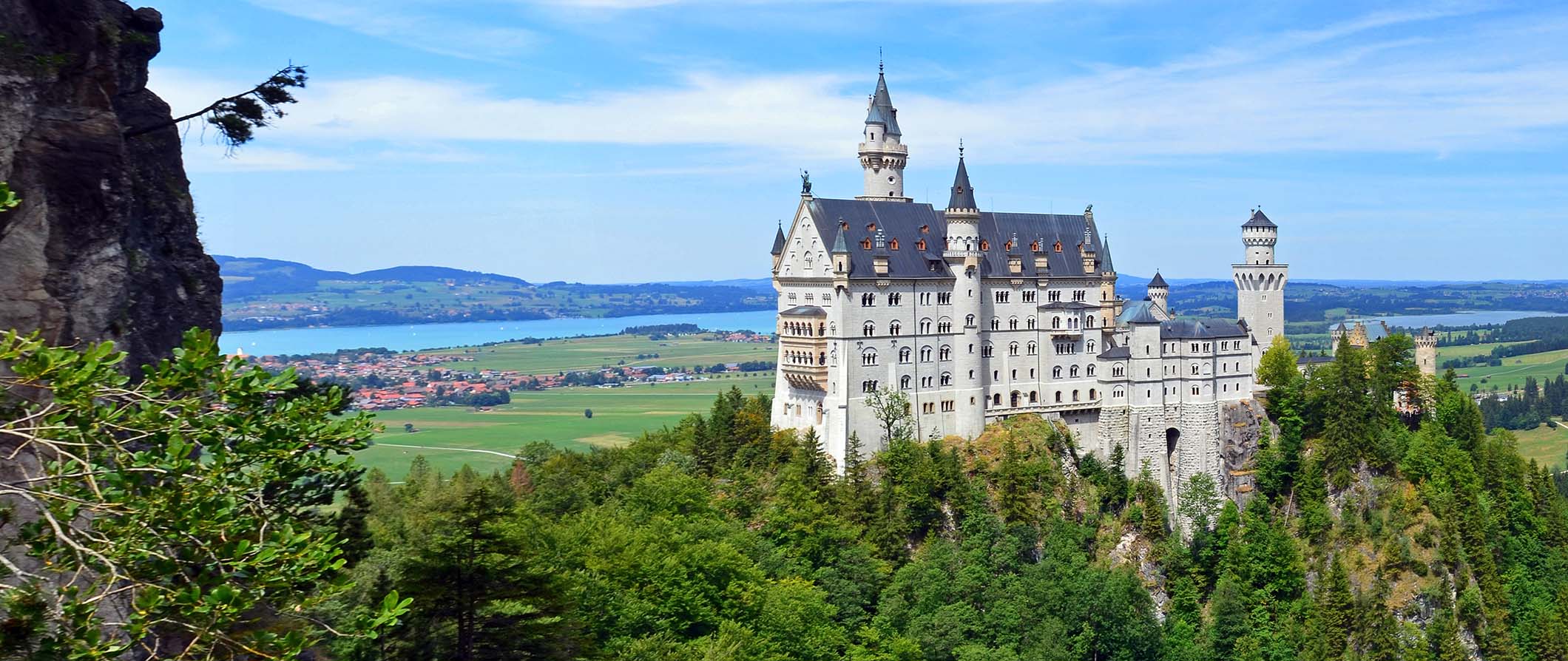
Germany. The country is synonymous with beer, sausages, incredible hiking, majestic castles, serious people, and wild techno parties. It’s huge, diverse, and utterly amazing.
There’s a vibrant art and music scene in Berlin , beautiful forests in the west, majestic cathedrals and castles throughout the country, picturesque “Sound of Music” cities in the south, and overlooked historic cities and beaches in the north.
The more I visit Germany, the more I fall in love with it. Whether you are backpacking, traveling on a mid-range budget, or looking to splash out, traveling around Germany is wonderful.
That said, Germany is a huge country so don’t rush your visit. There’s more to the country than just Berin and those cross-country train rides are longer than you think.
This travel guide to Germany will help you plan your trip, save money, and make the most of your visit!
Table of Contents
- Things to See and Do
- Typical Costs
- Suggested Budget
- Money-Saving Tips
- Where to Stay
- How to Get Around
- How to Stay Safe
- Best Places to Book Your Trip
- Related Blogs on Germany
Click Here for City Guides
Top 5 things to see and do in germany.
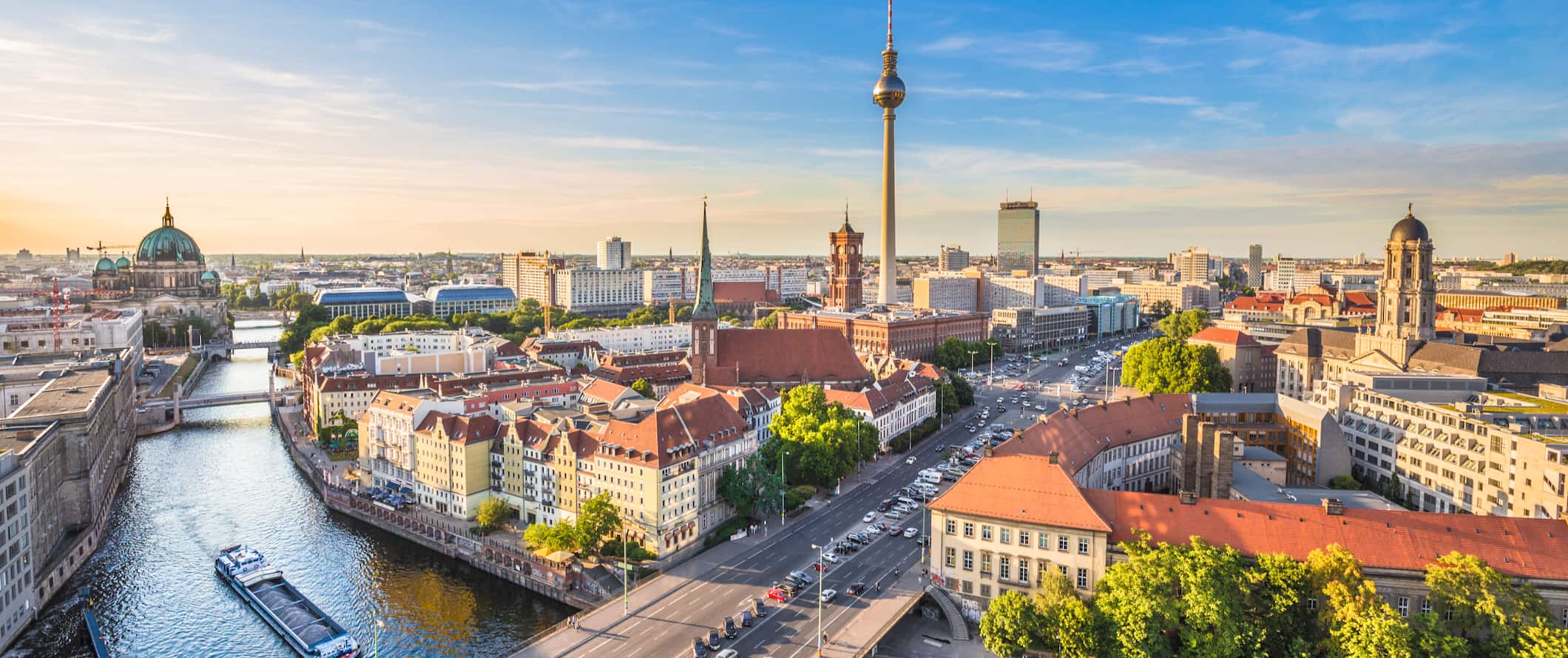
1. Get lost in Berlin
Germany’s hip capital has world-class museums, history, funky neighborhoods, and some of the best nightlife in Europe. From the museums to the art and music scene to the great bars and cheap food, Berlin is electric (and one of the cheapest European capitals). It’s a really amazing city that has grown on me with every visit.
2. See Munich
Berlin’s quiet, upscale cousin, Munich is a city steeped in history, lively beer halls, incredible food, lush parks, and a royal palace. It’s a beautiful destination and there are a lot of Bavarian towns nearby that make for scenic day trips.
3. Party at Oktoberfest
Held annually in September and October, the world’s largest beer festival is filled with huge steins and giant pretzels. I went there for 5 days and had the time of my life. Buy some lederhosen, raise a glass, and sing some German beer songs. Just make sure to plan your trip well in advance as things sell out fast!
4. Explore the Romantic Road
A string of historic cities in Bavaria, the “Romantic Road” is the name for the route through majestic Bavarian towns and their surrounding snow-capped mountains. The area can get quite touristy but it’s a beautiful area and a great choice for road trips and romantic getaways. There are a ton of tour options for the area that are worth checking out. For some of the more further afield attractions, the tours are a must as they are hard to visit without a car.
5. Hike the Black Forest
The Black Forest is so named because of the dark green pine trees that grow here. Spanning over 6,000 square kilometers (2,300 square miles), there are hundreds of miles of hiking trails worth exploring and you can spend some time stopping in towns that are famous for their cuckoo clocks and hearty German fare. If you want to go on a guided hike or adventure activity, you can find a lot here.
Other Things to See and Do in Germany
1. explore lake constance.
Lying along the country’s southwestern border with Switzerland and Austria , Lake Constance (known as Bodensee in German) is Germany’s largest freshwater lake and the third-largest in Central Europe. One of the lake’s main attractions is the island of Mainau, also known as Flower Island, which is home to many specialty gardens, a baroque palace, and one of the largest butterfly houses in Germany. Tickets to visit the island are 10.50 EUR. Be sure to visit the many picturesque medieval villages and castles nearby, enjoy water sports, and go hiking and biking along the 272-kilometer (170-mile) Lake Constance Trail.
2. Visit Hanover
This city was one of the hardest hit during World War II, leaving it with only a few historical landmarks. But what I loved about Hanover were its large green areas of forests and big parks, the River Leine winding through the city, and the Sprengel Museum. Not many people visit, but I think it is one of Germany’s most underrated destinations .
3. Hike Berchtesgaden National Park
This national park, located in the south of Germany along the Austrian border, is an alpine heaven of lush forests, steep rock faces, crystal clear lakes, sleepy villages, and rolling meadows. It’s just you, the chirping birds, and cows ringing their brass bells. Well-marked trails wind through the spectacular scenery, which brims with opportunities for hiking and cycling. While nature is the main attraction, the beautiful red-domed Church of St. Bartholomew (dating to 1697) is a worthwhile stop as well.
4. Check out Trier
Nestled in the Moselle River valley, picturesque Trier is the oldest town in the country. With a 2,000-year-old history, Trier was home to six Roman emperors and contains numerous UNESCO Roman ruins. The most outstanding example is the Black Gate, a monumental structure that was once part of the city walls. Other Roman sites worth visiting include the incredibly well-preserved basilica, the huge amphitheater, the bridge, and the baths. Trier is also home to several important Gothic and Baroque churches, a beautiful main square, and great wine due to its location in the Moselle wine region.
5. Visit Dresden
Dresden, the capital of the German state Saxony, is a vibrant city located along the majestic Elbe River near the Czech and Polish borders. During World War II, the city was subject to one of the most devastating bombings of the war. Tens of thousands of civilians died, and over 90% of the city was razed at the hands of British-American forces. After the war, the city was completely rebuilt. The famous Frauenkirche church, the Neumarkt historic district, the Zwinger Palace, the Royal Palace, and the Semper Opera House have all been restored to their former glory. Other must-see attractions include the Fürstenzug, a unique 102-meter-long (334-foot) porcelain mural dating to the 1870s; and the baroque Grosser Garten, the largest green space in the city.
6. Spend a day in Cologne
Cologne is a cool place to stop in West Germany on your way to or from the Netherlands . The cathedral is the most popular landmark in the city (and one of the most popular in the country), but there’s also a vibrant art scene, incredible international restaurants, and lots of riverside cafes and pubs. It’s an underrated stop worth exploring for a couple of days.
7. See Neuschwanstein Castle
This 19th-century Neo-Romantic palace is the model for the Disney castle and a must for any Germany itinerary. It’s one of the most popular tourist attractions in all of Europe, with over 1.5 million visitors each year. Perched on a rugged hill in Bavaria near the town of Füssen, the palace was commissioned by Ludwig II of Bavaria as a retreat and as an homage to Richard Wagner. Visitors can walk around outside and admire the stunning exterior for free, but the interior is only accessible by guided tour at specific times, which must be booked in advance. While the palace is 6,000 square meters (65,000 square feet) in size, only 14 of those rooms were ever finished. The finished rooms were fitted with very modern technology for the time, such as central heating, hot and cold running water, automatic flush toilets, and telephones. Admission is 15 EUR and guided tours are available . I think the guided tours add a lot of context and would really recommend taking one.
8. See Frankfurt
Often considered just a stopover city (there is a huge airport here), Frankfurt is home to a gigantic exhibition hall (one of the largest in the world so tons of events and conferences are held here), an excellent science museum, and a towering 14th-century cathedral. It’s less expensive compared to other cities in Germany and worth spending a day or two visiting.
9. Visit Olympia Park
Located in Munich, this massive complex was originally constructed for the 1972 Olympic Games. It is topped by the largest roof in the world, which spans over 700,000 feet. There is a really good restaurant here too. Tickets to the stadium cost 3.50 EUR while a ticket to the Olympic Tower costs 11 EUR. You can also skate in the ice arena, swim in the Olympic swimming pool, and reserve court time on the tennis courts. The BMW Museum is also nearby and worth a visit.
10. Tour to Schloss Colditz
Originally built to be a Renaissance palace, this interesting structure has a long, bizarre history. Located between Leipzig and Dresden in the region of Saxony, it’s been a hunting lodge, a poorhouse, and even a mental hospital. It is most famous for being a prisoner-of-war camp during World War II. There is a museum within the palace, with tickets costing 4 EUR. A two-hour guided tour through the castle (and escape tunnels built by prisoners) is 10 EUR. There is even a hostel within the castle (30.50 EUR per night).
11. Visit Hamburg
Located in northern Germany, Hamburg is Germany’s second-largest city. This port city, home to the second-busiest port in Europe, is famous for its parks and canals. Near its core, Inner Alster lake is dotted with boats and surrounded by cafes. The city’s central boulevard connects the Neustadt (new town) with the Altstadt (old town) and is home to landmarks like 18th-century St. Michael’s Church.
12. See Tierpark Hagenbeck
Located in Hamburg, this zoo and aquarium spans over 60 acres and is home to more than 2,500 animals including polar bears, penguins, and walruses. In addition to the classic attractions, there is a petting zoo, a miniature railway, pony rides, a playground for kids, and a serene Japanese garden. Combination tickets for the zoo and aquarium are 40 EUR.
13. Take a break in Bremen
Located in the north (near Hamburg), Bremen is a smaller city worth exploring. The charming medieval Schnoor district makes for a great stroll, and there is a beautiful cathedral and opulent city hall in the historic market square. The medieval harbor has been converted into the Schlachte, a large pedestrian promenade along the banks of the Weser River lined with countless restaurants, beer gardens, and riverboats. Bremen is also home to several fascinating museums, including the Universum Bremen, an interactive science museum in a modern whale-shaped building. The museum also offers a Dining in the Dark three-hour dinner experience, where you learn to experience food with just four out of your five senses.
14. Explore the Rhine Valley
The longest river in Germany, the Rhine holds incredible importance both historically and culturally. The most popular area to visit is the Upper Middle Rhine Valley. This 67-kilometer (41-mile) stretch is a UNESCO World Heritage Site with countless castles, ruins, villages, and vineyards. An extensive network of walking and cycling paths, as well as excellent public transportation, means you don’t even need to rent a car when visiting.
15. Step back in time in Bamberg
Located less than an hour from Nuremberg, Bamberg is one of Germany’s best-preserved medieval towns, home to Europe’s largest intact historic city wall. Founded in the 9th century, the town was important in both the 12th-century Holy Roman Empire and the 18th-century German Enlightenment. It’s an incredibly picturesque town so spend the day wandering around, seeing the old homes, visiting the 13th-century cathedral, the 17th-century palace, the 18th-century city hall, and the seven churches that sit atop each of the seven hills surrounding the village.
16. Take a river cruise
Many of Germany’s major cities lie along large rivers, making river cruises a popular way to see the country. While there are expensive multi-day cruises going from city to city, you can also take a day cruise for a more budget-friendly option . Generally, these are around 15-25 EUR for a 1-2 hour trip. They are super fun.
17. Ascend Germany’s tallest mountain
Located in the Alps along the German-Austrian border, the Zugspitze mountain measures 2,962 meters (9,718 feet) and is a popular destination for winter sports. Even if you’re not into skiing, you can still enjoy the trip up the mountain via one of three different cable cars and a 90-year-old rack railway line. At the top, you’ll be treated to panoramic views and several restaurants with traditional Alpine food. Round-trip cable car tickets cost 24-63 EUR depending on the season and which cable car you take. If you don’t want to go solo, day trips are available from Munich and are the best way to get there and around without transportation.
For more information on specific cities in Germany, check out these guides:
- Berlin Travel Guide
- Cologne Travel Guide
- Frankfurt Travel Guide
- Munich Travel Guide
Germany Travel Costs
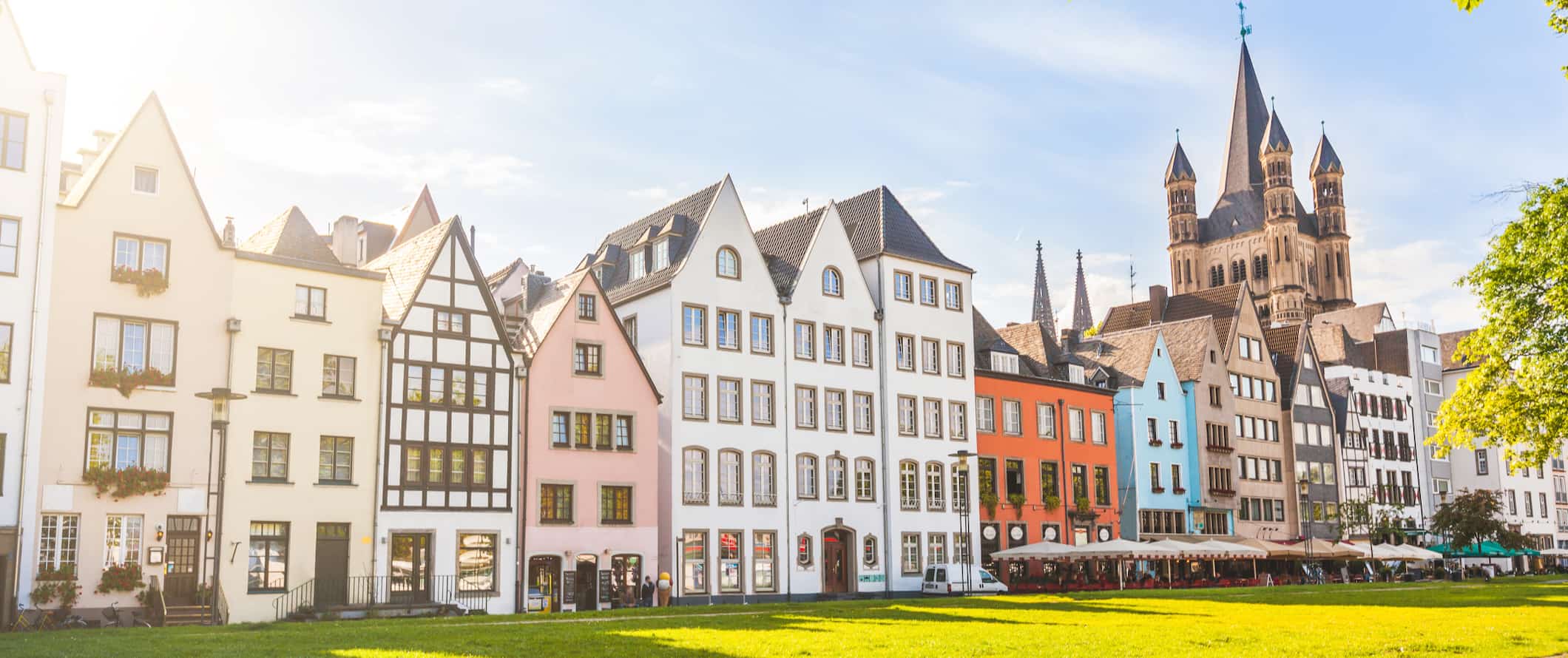
Accommodation – Accommodation in Germany is quite affordable compared to other Eurozone countries. Hostels are plentiful and range from 17-25 EUR per night for a dorm room with 6-8 beds. For a private room, expect to pay 40-60 EUR per night. Free Wi-Fi is standard and many hostels also include free breakfast.
Budget hotel prices begin around 45-65 EUR for a small double room with a private bathroom and free Wi-Fi.
Airbnb is available everywhere with private rooms going for as little as 30-45 EUR per night and entire apartments or homes starting at 50-75 EUR. Book early though or prices will double (or triple).
While wild camping is illegal, there are a ton of campsites around the country. Expect to pay 5-20 EUR per night for a basic plot for two people without electricity.
Food – Food in Germany is very cheap (and hearty). Meat is a staple of most meals, especially sausages; there are over 1,500 different kinds of sausages in Germany (sausages here are known as “wurst”). Stews are also a popular traditional choice, as are potato dumplings and sauerkraut. Breakfast is usually composed of bread, cold cuts, cheese, and boiled eggs.
You can get sausages and bratwurst from outdoor vendors for around 3-5 EUR. Meals at many of the beer halls around the country cost 9-15 EUR. Pre-made sandwiches cost around 5 EUR. Fast food (think McDonald’s) costs around 8.50 EUR for a combo meal.
If you eat in the beer halls, a traditional German meal costs around 14-18 EUR. Turkish, Middle Eastern, and Asian food can be found for as little as 5 EUR, while a nicer meal at a sit-down restaurant costs around 25 EUR.
Beer costs around 4 EUR while a latte/cappuccino is around 3 EUR. Bottled water is around 1 EUR.
If you plan on cooking for yourself, a week’s worth of groceries costs around 40-50 EUR. This gets you basic staples like rice, pasta, seasonal produce, and some meat. While they don’t always offer the most variety, the cheapest places are Aldi, Lidl, Penny, and Netto. Bring your own bag if possible.
Backpacking Germany Suggested Budgets
If you’re backpacking Germany, my suggested budget is 55 EUR per day. This is a suggested budget assuming you’re staying in a hostel dorm, cooking all your meals, limiting your drinking, using local transportation to get around, and doing mostly free activities like hiking and taking free walking tours. If you plan on drinking, add another 5-10 EUR to your daily budget.
On a mid-range budget of 135 EUR per day, you can stay in a private Airbnb room, eat a few meals out, take the occasional taxi to get around, enjoy a few drinks, take the bus between cities, and do more paid activities like visiting museums and castles.
On a “luxury” budget of 245 EUR or more per day, you can stay in a hotel, travel between cities via train, eat out at restaurants for all of your meals, drink more, take taxis to get around, and do whatever tours and activities you want. This is just the ground floor for luxury though. The sky is the limit!
You can use the chart below to get some idea of how much you need to budget daily, depending on your travel style. Keep in mind these are daily averages – some days you’ll spend more, some days you’ll spend less (you might spend less every day). We just want to give you a general idea of how to make your budget. Prices are in EUR.
Germany Travel Guide: Money-Saving Tips
Overall, Germany is not an expensive country to visit. Yes, river cruises are expensive. Yes, there’s plenty of high-end cuisine throughout the country. Visiting Frankfurt, the capital of finance, costs a pretty penny. But those are exceptions to the rule. Overall, Germany is quite affordable for a Eurozone country, with plenty of bargains throughout the country. Here are my best tips for saving money in Germany:
- Eat cheap – Throughout Germany, cheap outdoor sausage vendors offer quick eats for only a couple of euros. Additionally, some of the best and cheapest food in Germany is Turkish and Middle Eastern cuisine. You can get meals for 5-8 EUR that are delicious and filling. It’s what I mainly eat while in Germany whenever I want to eat out.
- Drink cheap – In Germany, buying beer and walking around — known as a ‘Weg bier’ — is totally acceptable. Take advantage of good weather by sitting outside in Germany’s lovely plazas and lush parks and buy your own drinks from the Späti shops, street kiosks, and supermarkets to save money. Also, find the student areas by the universities as you’ll find the discounted places.
- Take the free tours – The bigger cities in Germany have free walking tours. They’re a good way to see the city, learn about the history, and get your bearings without spending money. Just make sure to tip your guide at the end!
- Book your train early – Trains in Germany are expensive but you can get a saver ticket that is around 40-50% off the standard fare if you book at least a week in advance. These tickets have limited availability, so be flexible with your travel plans. Also, if you are more flexible with times, try Flixtrain instead, which has fewer routes between bigger cities sometimes at inconvenient times but is way cheaper than Deutsche Bahn.
- Take the bus instead of the train – While not as comfy or romantic, Flixbus or Postbus are two bus companies with super cheap prices. Download the app and you can get tickets last-minute but be aware that prices vary by time and availability so if you need to be somewhere by a certain time or day book in advance.
- Use rideshares – If you’re flexible in your schedule, use the ridesharing service BlaBlaCar and catch rides with locals between cities (or countries). You save money and get to spend time with locals. Drivers are verified and it’s perfectly safe (though sometimes rides don’t show up, which is why you need to be flexible). While the bus might be cheaper, this is usually faster (and more interesting). Just make sure to check where the pickup and drop-offs are as sometimes they are not exactly central places or main station.
- Stay with a local – While accommodation in Germany is pretty cheap, if you want to get some local insight into the country, you should Couchsurf. Not only will you save money on accommodation but you’ll meet locals who can help get you off the tourist trail and show you around! Plus, they have occasional meet-ups depending on the city so you can meet other travelers and locals
- Bring a water bottle – The tap water here is safe to drink so bring a reusable water bottle to save money and reduce your plastic use. LifeStraw is my go-to brand as their bottles have built-in filters to ensure your water is always clean and safe.
- Look out for free museum days – Most museums in Germany offer free admission on certain days or evenings. Check their website or ask the local tourism office to find out about discounts.
- Get transportation day passes – If you’re going to be using public transportation a lot in a city, get a day pass. Paying for single rides adds up quickly.
- Get city tourism cards – Most of the major cities in Germany offer city tourism cards. These include free admission to major museums and attractions, discounts on restaurants, and usually unlimited public transportation. If you plan on seeing a lot, these cards can save you money.
Where to Stay in Germany
There are lots of fun and social hostels in Germany. Here are some of my suggested places to stay:
- St. Christopher’s (Berlin)
- Circus Hostel (Berlin)
- Wombats (Munich)
- Jaeger’s Hostel (Munich)
- Five Elements Hostel (Frankfurt)
- Meininger (Hamburg)
- Generator Hostel (Hamburg)
- Station Hostel for Backpackers (Cologne)
- Black Sheep Hostel (Cologne)
- Lollis Homestay (Dresden)
- Hostel Mondpalast (Dresden)
- a&o Nürnberg Hauptbahnhof (Nuremberg)
- Five Reasons Hostel (Nuremberg)
How to Get Around Germany
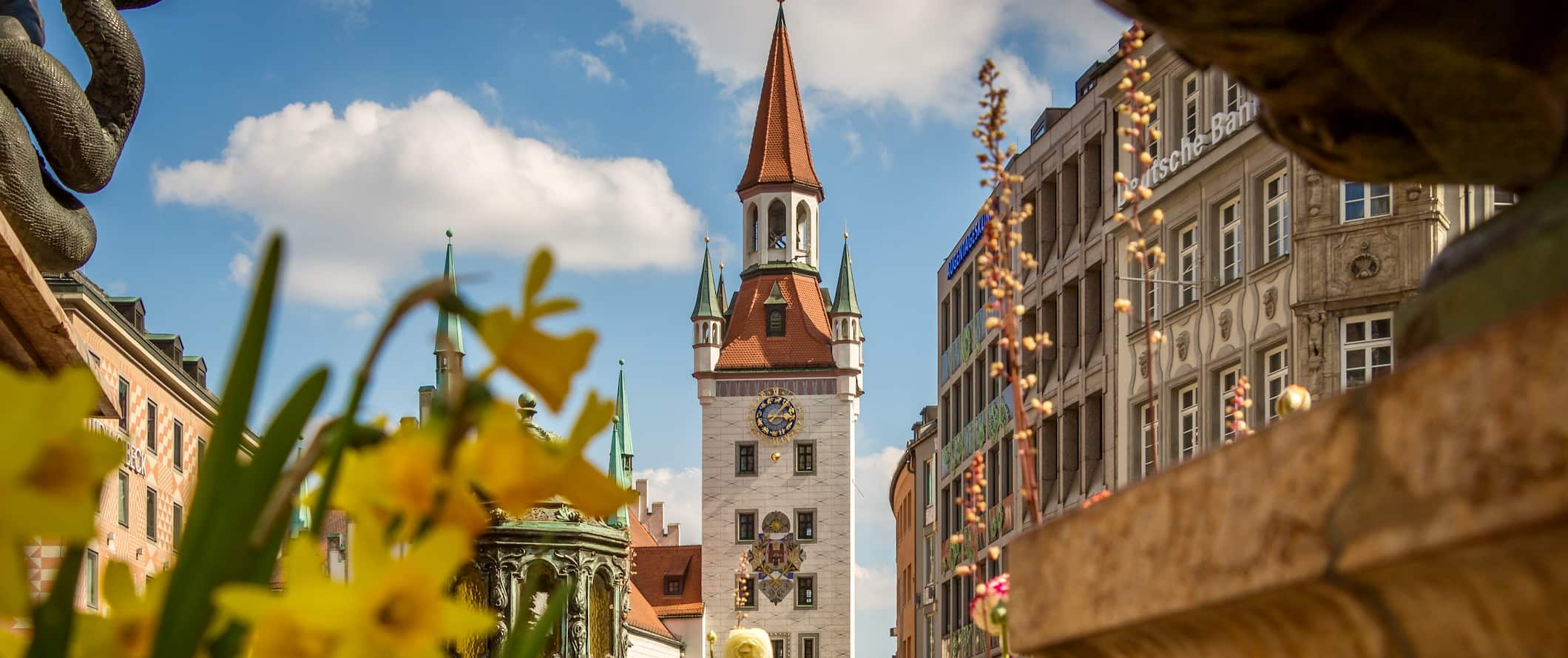
Public transportation – Germany has some of the best public transportation in the world. All the cities and larger towns have public transportation that is reliable and efficient. In cities like Berlin and Munich, all the various networks are integrated: one ticket gives you access to buses, trams, U-Bahn (subway), and S-Bahn (above ground train). Fares are determined by zone, but generally, a one-way fare starts from 2.90 EUR. A one-day unlimited pass is generally around 7-9 EUR while a three-day pass costs 17-20 EUR.
Train – Train travel is an incredibly efficient way to get around Germany, though it’s not cheap. Germany’s main rail system is Deutsche Bahn, which has both high-speed trains and regular trains. The high-speed trains are a quick way to get around but are usually much more expensive.
Take advantage of regional group tickets that start at around 22 EUR. These regional discounted tickets are available in Bavaria, Brandenburg-Berlin, Baden-Wüttermburg, Lower Saxony, North Rhine-Westfalia, Hesse, etc. For example, the Bavarian Bayern Ticket is 58 EUR for a group of 5 tickets for any train in Bavaria from 9am to 3am.
Last-minute tickets from Berlin to Hamburg can cost 50 EUR, but advance bookings start around 20 EUR. Frankfurt to Cologne is also around 20 EUR. It’s always best to book in advance when possible, otherwise, you’ll pay the price for last-minute bookings. You can track schedules and fares on the Deutsche Bahn website.
Another great site for trains around Germany (and into neighboring countries), is Trainline .
A Eurail Pass, which allows travelers to explore Europe by providing a set number of stops in a specific time period, might also be a good option if you’re doing some country hopping. Here’s a detailed breakdown of how Eurail passes work and can save you money .
Bus – Aside from hitchhiking, buses are the cheapest way to get around Germany. They are punctual but slow, with comfortable seats, air-conditioning, rest stops, and usually free Wi-Fi.
I recommend Flixbus for the cheapest rates and most comfortable buses. You can get from Berlin to Dresden for as little as 10 EUR, or from Berlin to Munich for 20 EUR. Munich to Hamburg is around 22 EUR.
Ridesharing – Ridesharing in Germany is very common. Ridesharing means you travel as a passenger with someone in exchange for payment toward fuel costs. It’s usually not as cheap as the bus but it’s often faster and you’ll meet some interesting characters! BlaBlaCar and Mitfahren are the two most popular ride-sharing websites.
Car rental – German is a great country to explore by car. Car rentals start at 30 EUR per day for a multi-day rental. Renters need to be at least 21 years old.
For the best car rental prices, use Discover Cars .
When to Go to Germany
Germany is a year-round destination. Summer is the most popular time to visit as temperatures are hot and everyone’s outdoors enjoying the weather. People flock to beer gardens and to the lakes to swim. This is also the peak season, when prices are much higher than usual. During this time, average temperatures hover around 24°C (75°F) and can soar well into the 30s°C (high 80s°F). You’ll want to book accommodation and transportation early (especially in July and August).
Temperatures warm up fast in spring, and the season is marked by the arrival of cherry blossoms. By May it’s warm enough to walk around in t-shirts and shorts. May 1 (Der Erste Mai) is Germany’s Labor Day, and the country breaks out in full celebration. If you’re lucky enough to be here during this time, take to the streets with your fellow Germans and enjoy the live music, drinking, dancing, and general mayhem.
Thanks to the famous Oktoberfest, autumn is a very popular time to visit Germany (especially Munich). From the end of September to early October, millions of people flock here from all over the world to enjoy the most epic beer-drinking festival in the world. If you’re planning on attending Oktoberfest, book your accommodations in advance. Way, way in advance.
An autumn visit to Germany is overall a great idea, especially in Bavaria when the foliage in the hills and mountains makes for some amazing photography. Temperatures can sometimes be chilly, but with light layers, you’ll be fine.
Winter in Germany can be cold, with temperatures as low as -10°C (14°F), but Germany is known for its Christmas spirit and the holiday markets all over the country are well worth your time, especially in Munich, Berlin, and Dresden. Pack some warm clothes and let the delicious glühwein (mulled wine) warm you up.
Winter in Bavaria is a skier and snowboarder’s dream only around one hour outside of Munich. While people might not think of Germany first in terms of skiing in Europe, these slopes are pristine, truly breathtaking, and way cheaper than neighboring Switzerland. Check out Garmisch-Partenkirchen, Füssen, Kranzberg, Zugspitze, and Laber.
How to Stay Safe in Germany
Germany is an incredibly safe place to travel. However, due to a few high-profile terrorist attacks in the country, I often get asked if it’s safe to travel to Germany. I wrote a whole article about how Germany (and Europe) is safe to visit if that’s a concern of yours.
Generally, you just need to watch out for scams and petty crime as you would anywhere (especially in Berlin late at night). Keep an eye on your valuables when in large crowds and on public transportation. Violent crime is rare so as long as you keep your valuables secure you shouldn’t experience any issues.
Scams are rare but if you’re worried about getting ripped off you can read about common travel scams to avoid here .
Solo female travelers should feel safe in Germany, however, the standard precautions apply (never leave your drink unattended at the bar, never walk home alone at night intoxicated, etc.).
If you experience an emergency, dial 112 for assistance.
Always trust your gut instinct. Make copies of your personal documents, including your passport and ID. Forward your itinerary along to loved ones so they’ll know where you are.
The most important piece of advice I can offer is to purchase good travel insurance. Travel insurance will protect you against illness, injury, theft, and cancellations. It’s comprehensive protection in case anything goes wrong. I never go on a trip without it as I’ve had to use it many times in the past. You can use the widget below to find the policy right for you:
Germany Travel Guide: The Best Booking Resources
These are my favorite companies to use when I travel. They consistently have the best deals, offer world-class customer service and great value, and overall, are better than their competitors. They are the companies I use the most and are always the starting point in my search for travel deals.
- Skyscanner – Skyscanner is my favorite flight search engine. They search small websites and budget airlines that larger search sites tend to miss. They are hands down the number one place to start.
- Hostelworld – This is the best hostel accommodation site out there with the largest inventory, best search interface, and widest availability.
- Booking.com – The best all around booking site that constantly provides the cheapest and lowest rates. They have the widest selection of budget accommodation. In all my tests, they’ve always had the cheapest rates out of all the booking websites.
- HostelPass – This new card gives you up to 20% off hostels throughout Europe. It’s a great way to save money. They’re constantly adding new hostels too. I’ve always wanted something like this and glad it finallt exists.
- Get Your Guide – Get Your Guide is a huge online marketplace for tours and excursions. They have tons of tour options available in cities all around the world, including everything from cooking classes, walking tours, street art lessons, and more!
- The Man in Seat 61 – This website is the ultimate guide to train travel anywhere in the world. They have the most comprehensive information on routes, times, prices, and train conditions. If you are planning a long train journey or some epic train trip, consult this site.
- Rome2Rio – This website allows you to see how to get from point A to point B the best and cheapest way possible. It will give you all the bus, train, plane, or boat routes that can get you there as well as how much they cost.
- FlixBus – Flixbus has routes between 20 European countries with prices starting as low 5 EUR! Their buses include WiFi, electrical outlets, a free checked bag.
- SafetyWing – Safety Wing offers convenient and affordable plans tailored to digital nomads and long-term travelers. They have cheap monthly plans, great customer service, and an easy-to-use claims process that makes it perfect for those on the road.
- LifeStraw – My go-to company for reusable water bottles with built-in filters so you can ensure your drinking water is always clean and safe.
- Unbound Merino – They make lightweight, durable, easy-to-clean travel clothing.
- Top Travel Credit Cards – Points are the best way to cut down travel expenses. Here’s my favorite point earning credit cards so you can get free travel!
- BlaBlaCar – BlaBlaCar is a ridesharing website that lets you share rides with vetted local drivers by pitching in for gas. You simply request a seat, they approve, and off you go! It’s a cheaper and more interesting way to travel than by bus or train!
Germany Travel Guide: Related Articles
Want more info? Check out all the articles I’ve written on backpacking/traveling Germany and continue planning your trip:
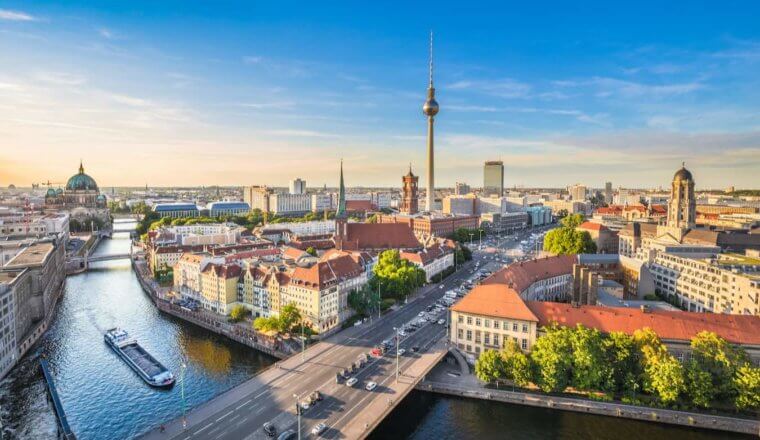
Where to Stay in Berlin: The Best Neighborhoods for Your Visit
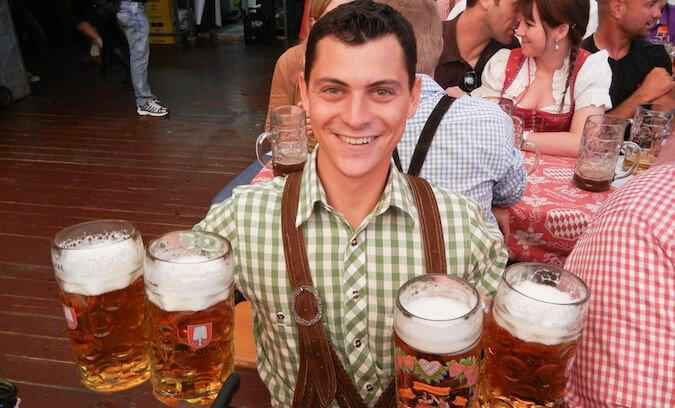
How to Survive Oktoberfest
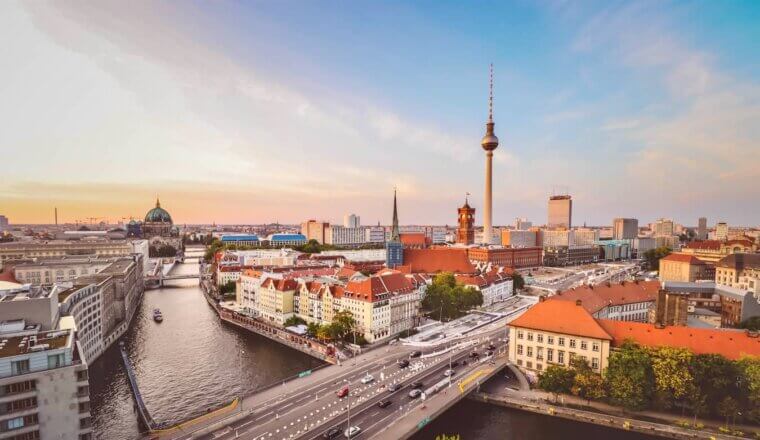
The 18 Best Things To Do in Berlin
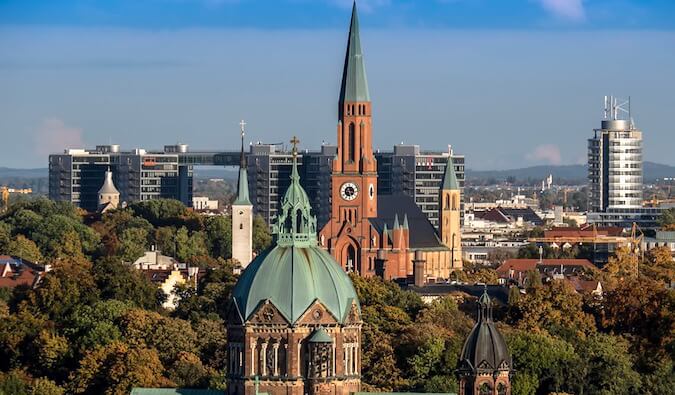
Munich is Better than Berlin
Get my best stuff sent straight to you, pin it on pinterest.
- Where To Stay
- Transportation
- Booking Resources
- Related Blogs
Essential Words And Phrases To Know Before Your Trip To Germany
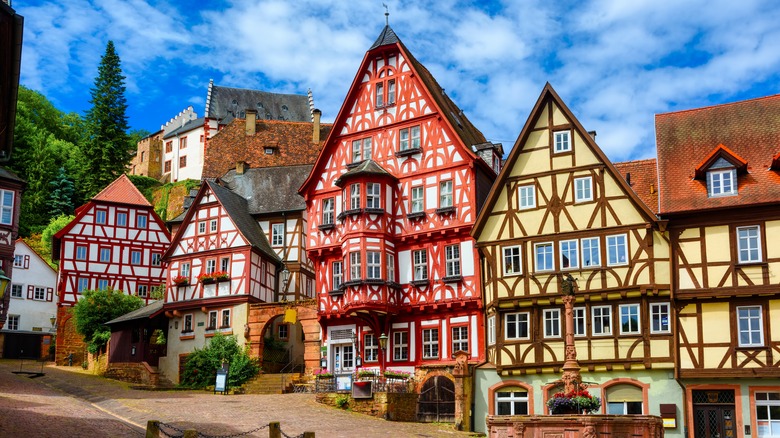
When you visit a country for the first time, it can be intimidating — especially if you don't speak the language. So getting to know a foreign language before visiting can take the pressure off of your trip and enhance your experiences. With a language like German, you're in luck because the words are generally phonetic like in Spanish. So words are generally spoken as they appear. Though that's not always true, it applies to many of the words or phrases beginner speakers will rely on during a trip to German-speaking countries .
There are some grammatical cues that might trip you up like the letter "ẞ" known as "eszett." This letter that looks like a "B" which isn't connected at the bottom is really just a double "s." So if you see a word like "Straße" think of it as reading as "strasse" (it means street). The same goes for the common umlaut or dots above a letter like "ü." It simply changes the pronunciation.
Don't be surprised if speaking or understanding German is different or difficult for you depending on what part of the country you're in. There are over 200 dialects in Germany that can really impact how you experience the language. Not to mention that many parts of Europe speak German: Germany , Austria, Belgium, Liechtenstein, Luxembourg, and Switzerland. So a language vs. dialect barrier might happen, just don't let it throw you off. Just do your best and it'll most likely be appreciated.
Greetings in German
Knowing how to greet other people in the country you're visiting should be at the top of your language learning list. You'll want to know how to say hi to folks or goodbye, even if it's all you manage to remember it's a nice start. A German "Hello" is actually a pretty easy translation for English speakers. You will say "Hallo" (/ˈhaloː/, /haˈloː/). This is the simplest greeting since it translates to just "hello."
Depending on the time of day, you could want to say some variation of "good day." Before 11 a.m. say "guten morgen" for "good morning," "guten tag" before sunset for "good day," and then "guten abend" for "good evening" after the sun goes down. These phrases are pretty common though folks tend to have different opinions on when you can start saying "guten tag" during the day. Not to worry though, you won't offend someone by saying it a bit later.
Although Americans probably know "Auf Wiedersehen" (meaning "goodbye") it's actually a fairly formal phrase. Consider not saying that to strangers and instead saying "Tschüss" for "bye" which is a neutral word. Even more casually you could say "bis bald" for "see you soon" or "Bis später" which means "see you later." Keep in mind that some variations of goodbye in German literally mean another time soon — "Bis später" literally means later that same day.
Being polite in German
Like German greetings, the simplest polite phraseology is fairly simple for phonetic language learners. Both "please" and "you're welcome" are translated as "bitte" (/BITT-uh/). Whereas "thank you" is just one word: "danke" (/DAHN-kuh/). Even being able to just use these words in everyday interactions makes an immense difference in your time in Germany. Generally German folks you will meet, especially shopkeepers, will appreciate that you've done the bare minimum of knowing the language because you're trying. You can also add these words to other phrases you learn to make the sentence more polite. Like saying "nein, danke" which means "no, thanks."
Keep in mind that part of being polite is recognizing that each culture has their own norms. In Germany, for example, small talk isn't really a thing, especially with people you don't know. So informal chatting with a server or a cashier is a little weird. Not making small talk can be uncomfortable for Americans, but just roll with it.
If you want to ask someone how they're doing you can say "wie geht es ihnen" for "how are you" or you could say the shortened "wie geht's" for "how's it going?" "Wie geht's" is a bit of a slang term though it's generally acceptable to use, though maybe use the more formal "wie geht es Ihnen" if you're not sure.
Variations of yes
The two easiest ways to give an affirmative or "yes" in German are the direct "yes" translation "ja" (/yah/) and "okay" which means "okay." Directness, especially if visiting Germany, is appreciated as the culture around conversation is a very direct one. While "ja" is acceptable when answering for "yes," you may want to kick your language skills up a notch. Even something as simple as "kein problem" for "no problem" or "klar" for "of course." "Kein problem" is not super common for non-German speakers to say, so folks might light up if you say this. It's also just fun to say.
When in certain situations, like answering a shopkeeper or restaurant server, there may be occasion for "das klingt gut" or "that sounds good." Or the more informal "also gut" to say "ok, good." But the second one should be saved for appropriate, less formal situations.
If you want an easy translation to remember, try to keep "natürlich" or "naturally" in the back of your mind. Clearly it's not the right "yes" for every situation, but "natürlich" is a fun word to sprinkle into your new German conversations.
Variations of no
Anyone who watched "Kim Possible" as a kid might already know how to say "no" in German thanks to Ron Stoppable asking Heinrich if he had any daughters he could take to a dance. To which Heinrich replied "nein" but Ron thought he meant "nine" and Heinrich had to explain that "nein means no!" If that phrase means nothing to you, saying "no" in German is as simple as "nein" (/nine/). You can make the "no" more polite by adding "thank you" to it and say "nein danke" (/nine DAHN-kuh/) for "no, thank you."
Should you need a more firm "no," you could try saying "ich glaube nicht" or "I don't think so" or the firmer "absolut nicht" for "absolutely not." Otherwise perhaps a more gentle let down using "leider" for "unfortunately, no" is appropriate. Both of these phrases can get the point across that you are final in your stance and that the situation is "kaputt" ("broken"). Generally you shouldn't have a problem with shopkeepers. Especially in a country like Germany saying "no" will complete your conversational transaction. It's actually a relief to not have to deal with pushy salespeople like in the United States.
German restaurant lingo
Especially in larger cities like Berlin, there's a good chance you'll have access to an English menu or restaurant staff who speak a little English. But being able to order or ask for something in German is never a bad thing. Starting with the three meals of the day, you can say "breakfast" with "frühstück" (/FRUU-shtuuk/), "lunch" is "mittagessen" (/mit-TAHK-ess-en/) and "dinner" with "abendessen" or "abendbrot" (/AH-bent-ess-en/ or /AH-bent-broht/). More literally "abendessen" means "dinner" while "abendbrot" actually means a "light supper."
For folks with dietary restrictions or needs, there are some phrases you'll want to have on hand for restaurants too. For example: "I am a vegetarian" is "ich bin Vegetarier" (/ikh bin vay-gay-TAH-ree-er/) or "I only eat Kosher food" is "ich esse nur koscher" (/ikh ESS-uh noor KOH-sher/). If you cannot remember how to say you can't eat something, you could try saying "nein" and point to the food item you cannot eat. However, your best bet is to bring a little translation card with your restriction on it so you're covered.
If you haven't received a menu but you want one, you can ask the server to bring one to you by saying "ich hätte gerne die Speisekarte" or "can I look at the menu, please?" You can also ask if there is a house specialty by asking "gibt es eine Spezialität des Hauses?" or if there are local specialties by asking "gibt es eine Spezialität aus dieser Gegend?"
German shopping terms
While many of us don't necessarily need help when shopping, especially those introverts out there, but you'll never know when these phrases will come in handy. For instance, being able to say "I'd like" with "Ich möchte". (/eech MURG-ta/) followed by whatever it is you're looking for. You could be looking for a "shirt" or "ein Kleid" (/eye-n KLITE/) or even a "postcard" or "eine Postkarte" (/eye-na POST-KAR-ta/) to send home. Luckily, in some circumstances, you can show the person what you're looking for in the shop and come up with a way to cross the language gap with some creative phrasing.
Clearance shoppers will want to look for some words to give a clue that the prices have been lowered. So keep an eye out for "ausverkauf" for "sale," "sonderangebot" for "special offer" or "reduziert" which means "reduced." Usually, the universal color for reduced prices is red so watch out for red signs that say any of the reduced priced signs in red.
Some of the shop titles you'll see frequently are worth remembering too so you don't wander to far looking for something. For example "e Bäckerei" means "bakery" which may or may not have the kinds of sweet treats you'd want from a "pastry shop" or "e Konditorei." Most likely a bakery will have breads or pretzels but not necessarily a lot of sweets. Also, "e Apotheke" stands for "apothecary/pharmacy" whereas "e Drogerie" or "drugstore" is a non-drug convenience store.
Travel words in German
Sometimes you just need to know the word for certain things when you're traveling. From "the airport" or "der Flughafen" (/dare FLOOG-hafen/) to "the train station" or "der Bahnhof" (/dare BAHN-hof/) you may need to know these words when getting around. Knowing words like this will also help you read signs as you're traversing whatever German-speaking countries you're visiting. You'll be glad you know the word for "train station" when you're wandering around and can read the signage. Luckily some signs have little icons on them to give you a hint if you aren't sure. Though you shouldn't assume they'll have that.
If you're looking to make reservations in person you may also need to know the words "Haben Sie?" (/HAH-ben zee/) which means "do you have" which will then be followed by what you're looking for. For example, "ein Mietwagen" (/eye-n MEET-vahgen/) for "rental car" or "ein Zimmer" (/eye-n TSIM-air/) for "a room." As always, making reservations ahead of time is usually your best bet to get the best value. However, if you're in a bind, being able to ask for what you need in German will only help you.
Asking for directions in German
Especially since phones can get us lost as quickly as they can help us find where we're going, it's always good to know how to ask for directions. When you want to ask "how do I get to a place " you can say "wie komme ich zum/zur" (/vee KOM-muh ikh tsoom/tsoor/). But if you're trying to ask how to get to a city you'd say "wie komme ich nach" (/vee KOM-muh ikh nahkh/). Hopefully, you won't need to ask a stranger how to get to a city, but you never know!
Like many countries, the "toilet" or in German "die Toilette" is directly used. Don't ask for a bathroom or a restroom, just ask for the toilet. You may also see signs that say WC for "water closet" or "das Klosett" which is another word for "lavatory" or "toilet area."
If you want to ask someone for recommendations you could ask "where are there a lot of?" to get pointed in the direction of a popular area. Try asking "wo gibt es viele" (/VOU gipt ess FEE-luh/) followed by words like "Kneipen" for "pubs" or "Sehenswürdigkeiten" for "sights to see." Oftentimes locals will have gems you'd never discover without asking them what to check out.
German food words
One of the best things to do in German-speaking countries is to eat all of the delicious food. There are several words or phrases that are easy to remember like "wasser" (/vasser/) for "water" or "wein" (/vine/) for "wine." Other words like "apfelstrudel" (/apfelstrudel/) which means "apple strudel" is pretty straightforward for English speakers who already know how delicious strudel is.
Some words you may want to remember for breakfast include: "der Kaffee" ("coffee"), "der Joghurt" ("yogurt"), "der Keks" ("biscuit"), and "der Orangensaft" ("orange juice"). Though you shouldn't be afraid to try traditional breakfasts either. In Germany that might mean a Farmer's Omelet or "Bauernomelett" while in Austria it might be "Quark Käse" (soft Austrian cheese) with "Apfelradln" (apple rings).
Keep in mind too that a lot of countries love sparkling water. It's possible if you don't specify that you want "Leitungswasser" or "tap water" you'll get "der Sprudel" or "sparkling water." Honestly, the sparkling water often tastes so much better than the tap water. Even if you aren't big on seltzers, you may want to give it a try at least once while abroad. Especially flavored waters you can get at a store. Gerolsteiner is just so good.
How to explain your language skills
When you're a new language speaker, knowing how to ask someone if they can speak English might come in handy. If you're stuck, try saying "sprechen sie Englisch?" (/shpr-ek-en zee eng-lish/) to maybe bridge the language gap. If you feel uncomfortable asking, it's okay to also say "excuse me" before asking by saying "entschuldigung" (/ent-shool-dee-goong/). While it literally means "excuse me," it is also a way of saying "I'm sorry." Otherwise "tut mir leid" which is a shorter "sorry."
If you want to try out your language skills but need your German-speaking conversation partner to repeat themselves, it's ok to say so. Feel free to say "Können Sie das bitte wiederholen" or "could you say that again please?" You could also say "Was bedeutet das" or "what does that mean?" to spur your speaking partner to rephrase what they've said more simply.
When you get to a place when you can't converse in German, which is understandable you're a new language speaker, just admit your limit of language skills. Say "Ich spreche nicht gut Deutsch" for "I do not speak German very well." Seriously, being able to say your language skills are limited in the language of the place you're visiting is so much better than immediately asking if the other person speaks your language.
German words you already know
Believe it or not, there are several German words (even if you don't use them frequently) that you already know. While this might not help you during your travels, it's fun to see how words cross over languages and cultures. For example, "angst" is a word we're all familiar with and it translates to "fear." Or "doppelgänger" which literally translates to "double walker" but means a person who seems or looks exactly like someone else, almost like a ghost.
Even a term like "sauerkraut" hasn't changed from its original spelling or meaning from its German context to English. The same is true for "poltergeist," "zeitgeist," "kindergarten," "Volkswagon," or even "strudel." You absolutely have to get strudel at whatever German-speaking country you visit. It'll be unforgettable.
Some of the words you're already familiar with, especially "über," could really come in handy during your travels. You may find yourself coming up with ways to include these words you know into your conversations though we're not sure how many poltergeists you plan on seeing on your vacation.
How to learn German for travel: Is 4 weeks enough?
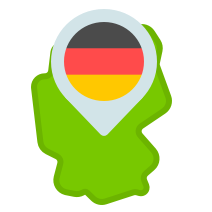
Earlier this year, I planned a trip to Italy and studied Italian for 4 months to prepare. It was great! I had lots of meaningful conversations, confidently navigated cities and towns in the countryside, and successfully ordered what I intended, every single time. 💯
But this time was different: I made plans to go to Germany for work, which was exciting except… I didn’t know any German! I've never studied it, everything I know comes from "99 Luftballons," and when I went to Germany in 2008 (pre-Duolingo days), I learned the word for "once" and mistakenly used it in coffee shops across Berlin ( einmal croissant, einmal coffee, "once croissant, once coffee"). Ack. 🎈
This time, I used Duolingo to prepare—and I only have 4 weeks! Here's how I prepared for my trip and how it went. Maybe it'll give you ideas of how to prepare for your own trip, especially if you only have a few weeks!
Learning German for travel:
Setting goals for myself.
- 4-week study guide
How I studied
What i learned in 4 weeks.
- Unpacking: Was 4 weeks enough?
Setting clear goals was important for staying motivated and keeping my learning on track, and it helped me be realistic about what I could accomplish in just 4 weeks. After a month, I was still going to be a beginner—definitely at the A1 level in the international language proficiency scale we use at Duolingo ( the CEFR )—so here were my specific, personal language-learning goals for German:
- Be able to greet and be pleasant to German speakers. I wanted to feel comfortable saying hello, good morning, thanks, you're welcome, see you later, asking basic questions, etc. I hoped to avoid the stereotype of the typical American who travels abroad and doesn't know a single word of the language!
- Be able to recognize information, especially on menus and schedules. I pictured having a quiet breakfast and coffee alone, and also wanted to visit a museum or two, so I wanted to understand what I'm ordering when friends and colleagues weren’t around to help, order it successfully, and buy the appropriate tickets for tours or at museums.
- ⚠️ STRETCH GOAL ⚠️ Have one small conversation in German. My reach goal was to have a short exchange in German—whether it was explaining where I'm from and why I'm in Germany, or a rave review of a meal (I was very excited about German bread!!), or being able to tell hotel staff about something I need. This was a wildcard! But wouldn't one real conversation be cool?
I could see that Unit 1 ("Order in a cafe, describe your family") is shorter than the others, and I know that Duolingo scaffolds lessons , so they'll gradually build on each other. I planned to work on regular lessons, the Stories that are mixed into the path, Legendary Levels , and the Practice Hub . I also resolved to mix up my practice with new side quests —these are lessons that you complete to earn stars under the Duolingo characters playing on either side of the path. They're timed, so they are a fun challenge, and they review material from the regular lessons.
I only had four weeks, so I focused on only what I needed to accomplish my goals. I consulted the titles and guidebooks at the top of each Unit to see what would be covered, so my goal was to get through Unit 7.
My 4-week study guide
I followed the same rhythm for the whole four weeks: each day, I completed about two circles of the path (does that make them pebbles ?), plus a little extra (like Legendary Levels or side quests), so that I completed about two Units a week. Here's a detailed look at my Week 1, followed by my 4-week plan:
4 week study plan
Since I didn't have much time before my trip, I was pretty serious about my study routine. It helped that many other parts of my day were focused on Germany, too, like my tasks at work and figuring out what to pack (for me: long underwear).
Here's how I studied:
- I focused on my lessons. When I was studying, I wasn't doing anything else, like listening to music or watching TV. (Two exceptions: once I did lessons quickly on the subway platform to not lose my streak, and on Thanksgiving I did my lessons while watching the oven!) This meant I was really thinking about German and was focused on everything I was seeing in my lessons.
- I spoke—a lot. Since my goals were mostly about speaking, I made sure to speak in all my lessons. I never turned off speaking exercises (...except on the subway platform), I repeated everything out loud, and I used the microphone to speak answers even when I could have typed them.
- I took notes by hand. During the first week, I started keeping track of what I was learning—and what I wanted to remember—in a notebook. I made lists of words from memory, and I categorized them by grammatical gender . I wrote important question phrases (like "Where is ___ ?" and "How are you?") and made little groups of words (like "always," "never," "sometimes," and "often"). I wrote mini dialogues and imagined telling someone about myself. It didn't matter that no one was checking my work or grammar, because there was no way my German was going to be perfect in time for my trip anyway! Plus, making myself remember everything "from scratch" was just what I'd be doing in Germany.
- I saved important words and phrases in screenshots. Whenever I came across an important word (especially if it felt hard to me) or a useful phrase, I took a screenshot so I could easily flip back to it to practice. I used my screenshots when I wanted to add things to my notes, and also as an easy way to remind myself of vocabulary throughout the day. They were also a sneaky reminder whenever I opened my photos app!
- I used German every chance I could. Now, I didn't have tons of chances to practice using my German before I left for my trip… but I used every one of them! 😂 I said Guten Morgen! (Good morning!) to my English-speaking colleagues, I muttered greetings and my breakfast order under my breath while I walked to brunch, and I thanked hotel staff in German when I emailed them with questions.
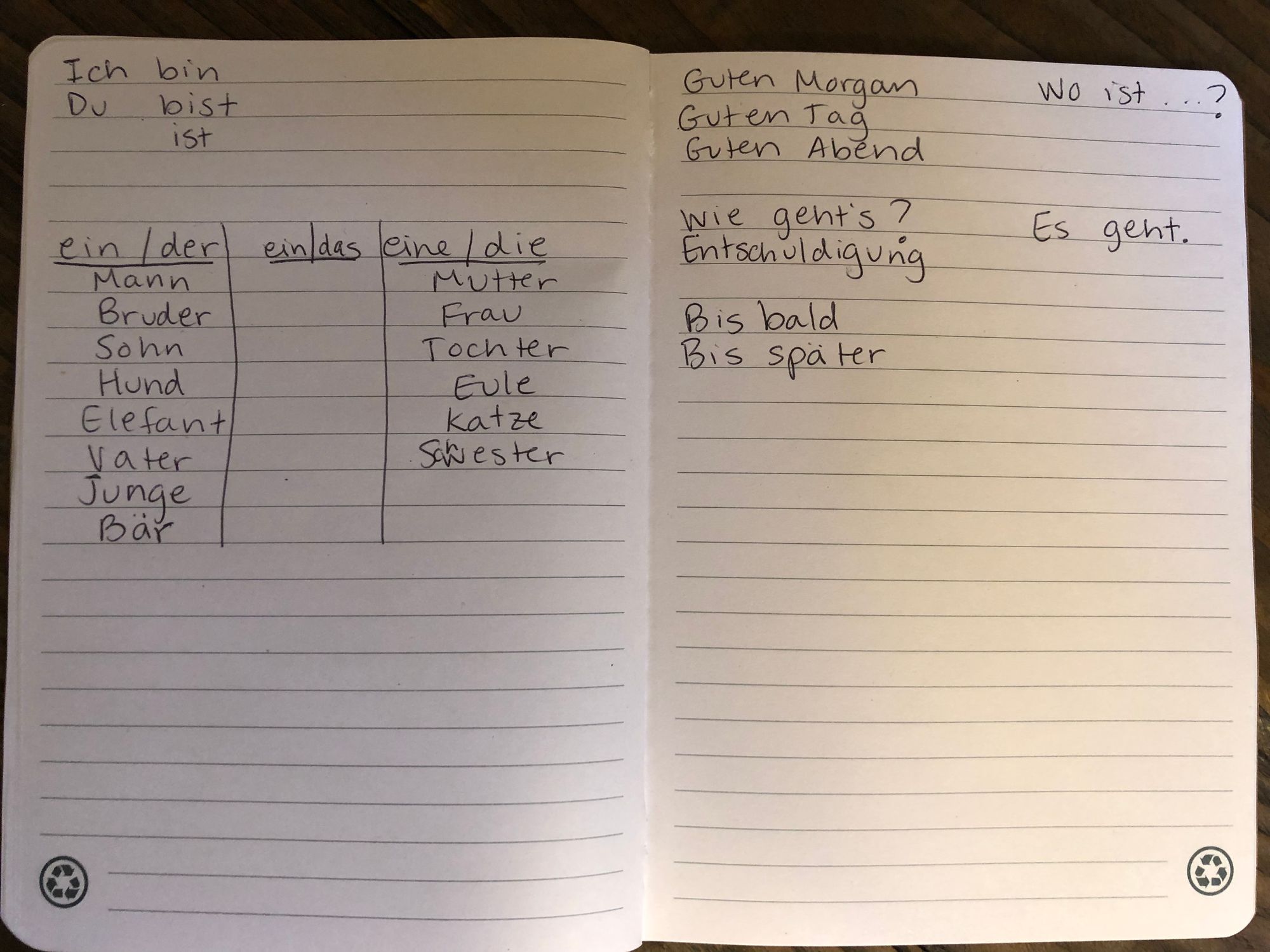
In just the first week—completing the first three units of the course—I had already learned a lot of the key expressions and building blocks that I used in Germany:
- Vocabulary about food and drinks, like Kaffee (coffee), Brot (bread), and Wasser (water)
- Some words for people and animals, including Schwester (sister), Mann (man, husband), and Katze (cat)
- The most important question for travelers: Wo ist ___? (Where is ___?)
- Combining words like und (and) and oder (or), which were especially helpful for my food orders (always mit Käse, bitte "with cheese, please")
- Grammatical gender categories and basic word order
- A lot of words that will help me interact in conversations, including ja (yes), nein (no), bitte (please), and tschüss (bye)
By the end of Week 1, I could also introduce myself, make simple sentences ( Die Katze ist sehr gut! "The cat is very good"—which wasn't even in my lessons, I don't think!), and be polite (I knew I'd need Entschuldigung (excuse me) a lot!).
Here's some of what I learned to do in Units 4-7:
- Talk about where people are from ( Ich komme aus Amerika und Frau Heidi Klum kommt aus Deutschland, "I am from the U.S., and Ms. Heidi Klum is from Germany")
- Use formal titles and speak formally to others (I'd need this if I met Frau Klum or Frau Angela Merkel, according to my lessons)
- Discuss some activities and hobbies, conjugate verbs about them (!!), and say how often they happen—which means I can make longer sentences to say it all!
- Describe all kinds of buildings and businesses and where they are located (and I heard those direction words a lot, for where bathrooms were, which train doors would open, and more)
- Count up to 10, which was basically all I needed for a quick trip, since large numbers like prices were usually printed on receipts or displayed on cash registers
So, was 4 weeks enough to learn German?
I wouldn't say I learned the entire German language, but I had a great time with the German I learned! I kept track of what I was able to do in German in a Twitter thread . This was a really fun way to celebrate using the language during my trip, and I love having it as a souvenir to remember not just what I did in Germany, but all the ways I was able to use German!
I also accomplished all my goals: I was able to greet and be pleasant to German speakers, I recognized information all around me (including on menus and train schedules)—and I achieved my stretch goal of having a small conversation! Or, sort of 😅 The conversations I had were very tiny, but my big accomplishment was ordering my breakfast at a German café, in a convincing enough way that staff responded to me in German—far more German than I could understand! 🏆
For my traveling style, I'm much more comfortable having a few months of language study under my belt, like I had for Italy , so I can express myself better, understand people's responses, and put more words togethers. I felt comfortable and confident using what I learned in under a month, and I wonder how my German will be after eight months, next summer! 😉 🇩🇪
- Free Resources
- 1-800-567-9619
- Subscribe to the blog Thank you! Please check your inbox for your confirmation email. You must click the link in the email to verify your request.
- Explore Archive
- Explore Language & Culture Blogs
Talking about vacation in German, part 2 Posted by Sandra Rösner on Jul 19, 2012 in Grammar , Holidays , Language
In my yesterday’s post I already discussed how to talk about vacation or vacation plans. Now, I’d like to continue with this topic. Further expressions around the topic “vacation” are:
1. Urlaub machen – to take a vacation
So, when you would like to know when someone is about to take a vacation you can ask these questions:
When are you taking a vacation this year?
Wann machst du dieses Jahr Urlaub? (2 nd person, singular, informal)
Wann macht ihr dieses Jahr Urlaub? (2 nd person, plural, informal)
Wann machen Sie dieses Jahr Urlaub? (2 nd person, singular and plural, formal)
Wann machen wir dieses Jahr Urlaub? – When are we taking a vacation this year?
Wann macht Michael dieses Jahr Urlaub? – When is Michael taking a vacation this year?
Wann macht Katharina dieses Jahr Urlaub? – When is Katharina taking a vacation this year?
Wann machen Sebastian und Steffen dieses Jahr Urlaub? – When are Sebastian and Steffen taking a vacation this year?
Possible answers:
Ich mache dieses Jahr im Frühling/Sommer/Herbst/Winter Urlaub. – I’m taking vacation in spring/summer/fall/winter this year.
Wir machen dieses Jahr im August Urlaub. – We are taking vacation in August this year.
Melanie und Steve haben dieses Jahr im Mai Urlaub gemacht. – Melanie and Steve took vacation in May this year.
2. Urlaub haben – to be away on holiday
It could also be that someone is already away on holiday but since you are not really sure about that you might ask a question to confirm your assumption.
Are you already away on holiday?
Hast du schon Urlaub? (2 nd person, singular, informal)
Habt ihr schon Urlaub? (2 nd person, plural, informal)
Haben Sie schon Urlaub? (2 nd person, singular and plural, formal)
Hat Claudia schon Urlaub? – Is Claudia already away on vacation?
Hat Sven schon Urlaub? – Is Sven already away on vacation?
Haben Silvia und David schon Urlaub? – Are Silvia and David already away on vacation?
Ja, ich habe schon Urlaub. – Yes, I’m already away on holiday.
Nein, ich habe noch keinen Urlaub. – No, I’m not away on holiday yet.
Ja, wir haben schon Urlaub. – Yes, we are already away on holiday.
Nein, wir haben noch keinen Urlaub. – No, we are not away on holiday yet.
Ja, er/sie hat schon Urlaub. – Yes, he/she is already away on holiday.
Ja, sie haben schon Urlaub. – Yes, they are already away on holiday.

Build vocabulary, practice pronunciation, and more with Transparent Language Online. Available anytime, anywhere, on any device.

About the Author: Sandra Rösner
Hello everybody! I studied English and American Studies, Communication Science, and Political Science at the University of Greifswald. Since I have been learning English as a second language myself for almost 20 years now I know how difficult it is to learn a language other than your native one. Thus, I am always willing to keep my explanations about German grammar comprehensible and short. Further, I am inclined to encourage you to speak German in every situation. Regards, Sandra
gonzalez alexis:
great this is so cool. and helped me in something about german that i did’nt understand yet. (= !!! ich bin einen Deutschen Studient (=

Get our Rail Planner app
Plan your trip, get extra discounts, and show your Pass as you go.

Our favorite spring routes
Celebrate spring with these 7 off-the-beaten-path train routes

All about seat reservations
Everything you need to know about booking your seats

Alternatives to Busy Routes
Travel between popular European cities without seat reservations

Through our Chatbot in the bottom right corner.

Ask the Community
Browse questions from fellow Eurail travellers, or ask your own!
- Plan your trip
- Suggested Itineraries
1 week in Germany
- Order overview
- Reservations overview
- My Trips & Travelers
- {{translatedTraveler}} {{#promotional}} {{currencySign}} {{standardPrice}} {{/promotional}} {{quantity}}x {{currencySign}} {{finalPrice}}
- Child {{childPasses}}x FREE
- {{translatedPassType}}
- {{translatedValidityPeriodDescription}}
- {{translatedClass}}
- Remove Pass(es)
- {{variant.localizedTravelPackDescription}} {{quantity}}x Free
- {{variant.localizedPassUpgradeDescription}} {{quantity}}x {{currency}} {{price}}
- Your order will arrive by {{expectedDeliveryDate}} 1 x {{currency}} {{price}}
Your cart is empty
Thanks to a stellar rail network, 1 week in Germany will give you enough time to explore some beautiful regions and fascinating cities throughout the country. Here’s one way to spend your time if you only have 7 days in Germany.
Itinerary highlights
Beer, castles, and Bavarian culture in Munich; castles and the Rhine Valley Scenic Line; the famous Cologne cathedral; fascinating culture and maritime history in Hamburg; somber history, trendy food, and vibrant nightlife in Berlin.
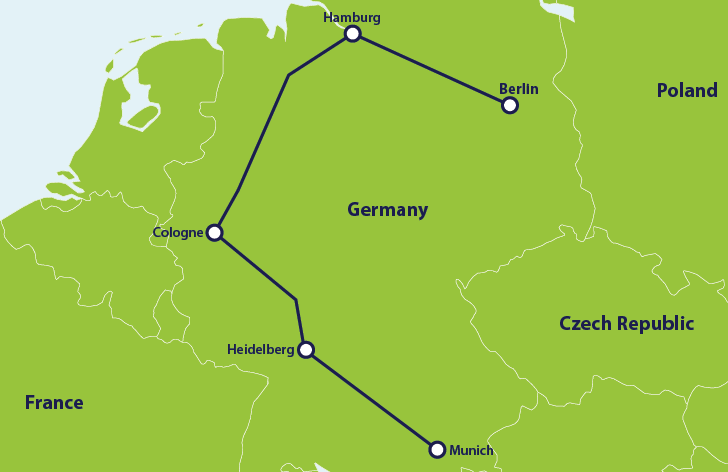
Day 1: Munich

Take a walking tour of Munich Old Town , then drink beer and eat eisbein (pork knuckle) in a traditional beer garden.
Track down the still surfing wave and relax in the Englischer Garten . The park is even bigger than Central Park in NYC!
Got more time? Take a day trip to Füssen to see the famous Neuschwanstein castle , which inspired Disney's Sleeping Beauty castle.
Day 2: Heidelberg
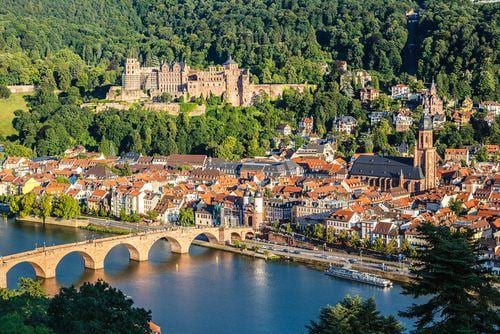
Walk and window shop the vibrant old town . The main street, Hauptstrasse, will take you past many interesting places.
Explore the ruins of the Heidelberg Castle on the hill, one of the most important Renaissance structures in the area.
Relax with the swans on the riverfront, or take a boat cruise along the Neckar River .
Day 3: Cologne
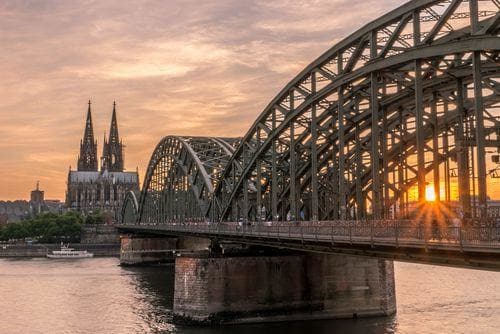
Take in the sight of the Cologne Cathedral . At 157.25 meters high, it’s the second largest in Germany.
Satisfy your sweet tooth at the Imhoff-Schokoladenmuseum - a massive chocolate museum in the heart of Cologne.
Relax in nature at the Cologne Zoological Garden . The zoo has over 7000 animals, as well as an aquarium.
Days 4 - 5: Hamburg
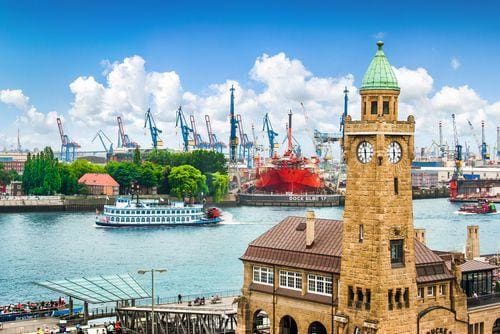
Walk the Port of Hamburg and Warehouse district to experience the city’s maritime history.
Check out Miniatur Wunderland , an entire museum dedicated to a phenomenal model railway.
Discover Hamburg’s entertainment district, the Reeperbahn . It's where the Beatles cut their teeth.
Days 6 - 7: Berlin
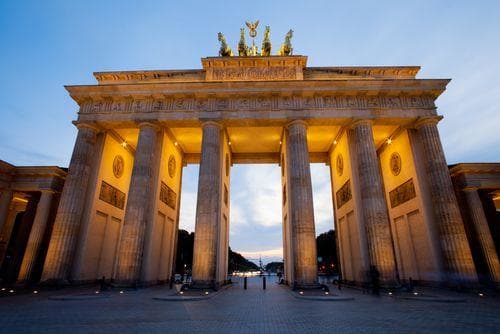
Visit the East Side Gallery , an open-air gallery on the largest remaining stretch of the Berlin Wall.
Take a walking tour from Brandenburg Gate to historically significant sights, then venture to the top of the Reichstag for views over Berlin.
Drink a coffee in a third wave café, have a burger and a craft beer in Kreuzberg , and party till dawn at one of Berlin’s famous nightclubs.
Is 1 week in Germany enough for me?
If you’re looking to get a broad overview of some of Germany’s famous cities, then 1 week in Germany by rail should have you covered. The dense railway network and rapid trains that often don’t require reservations mean you’ll still get amazing value if you only have seven days to spare.
Our German Rail Pass offers you full access to the rail network in Germany. Of course you can also travel the whole of Europe, including Germany, with a Eurail Global Pass (up to 33 European countries).
Change of currency
You cannot change the currency once you have a Pass in your cart. Remove the Pass, and then change the currency on the website header.
How to Say Take a trip in German
- take a shower
- take a step
- take a test
- take a trip
- take a walk
- take action
- take advantage of
- Arctic Ocean
- Do you have a swimming pool?
- dream vacation
- Have a safe journey home
- hotel lobby
- One ticket to Washington, please
- railway line

Home » Destinations » Europe » Germany » 5-14 Day Germany Itinerary: A Guide For Planning Your Perfect Germany Trip
5-14 Day Germany Itinerary: A Guide For Planning Your Perfect Germany Trip
Links in this article may earn us a little money if you book/ order stuff. More here .
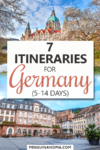
Plan Your Perfect Germany Itinerary with These Detailed Templates!
If you’re looking to plan the perfect trip around Germany, you are in luck! We’re passionate about exploring Germany because it’s a great country – and because Lisa is German!
Jokes aside, we’ve been lucky enough (and have made it a point) to see lots of different parts of the country – from the sea in the north to the mountains in the south. That said, Germany can be a tough country to plan a route or road trip through because there is just so much to see and do!
So, whether you’re looking for the best week in Germany or a Germany itinerary that covers 5 days or 14 days – here’s our master guide with 7 detailed Germany itineraries by train and/or by car! We’ve got cities, attractions, hotels and accommodations, directions, and distances to help you plan the best Germany travel route for you!
We’ve got other great posts to help you plan a visit to Germany:
- Must-Knows + Tips for Travelling to Germany for the First Time
- Helpful German Phrases to Get You By
- Discover 30 Beautiful Places in Germany
- Our Top Hostels in Germany (Stayed at all of them)
Table of Contents
Things to Consider When Travelling in Germany
Before you plan your trip to Germany, there are some things that you should know and keep in mind to make planning easier and to have a successful trip. While you probably know that the currency used in Germany is the Euro, here are some other topics that you should consider as well.
Best Time of Year to Visit Germany
Germany is actually a destination that you can visit year round – but it is important to plan accordingly and go in with the right expectations. If you’re planning a trip during the spring – let’s say from March to May – you could absolutely have beautiful weather… but it may also just rain a lot.
Unfortunately, the weather can be quite difficult to predict. However, as long as you prepare for different possibilities, you can have a great time no matter the weather! Generally you can say that Germany has a moderate climate with cool and rainy winters (more snowy the farther south you get) and warm – but not overly hot – summers.
July and August are usually the warmest months with an average temperature around 20°C. However, there can be days where you have 30°C. Of course, this can vary depending on the exact location you’re travelling to. Often, it is colder by the north coast than it is farther south.
We would honestly recommend that you avoid visiting the country in July if you dislike crowds since this is when the majority of kids are on their summer break from school. As a result, some cities can get quite busy.
Typically, we would recommend travelling in May or June and then from the end of August until the end of September (or even the middle of October). However, there is also a great reason to plan a Germany trip during the winter because of the many beautiful Christmas markets that you could visit at that time of year!
Public Transportation in Germany
Public transportation in Germany is quite good, especially when compared to North America. Yes, sometimes us Germans like to complain about the “Deutsche Bahn” – the German train company – but at the same time we are also super glad that it exists and works well.
If you’re wondering: Yes, all the itineraries mentioned below can absolutely be done if you want to take the train (minus the odd day trip to a castle here and there). If you want to check a train connection and/or buy tickets in advance you can do so on the DB Website . Alternatively, you can also download the DB app to your phone. We both have it and use it regularly.
As an alternative to the train, you can sometimes also use the bus to get from one city/town to another. Since 2013 (before this date it wasn’t allowed), long distance buses have established their presence in more and more cities and are now a popular way to get around for people who are more conscious of their money.
Unfortunately long distance train tickets can sometimes get quite expensive if you don’t book in advance – so the bus can be a good alternative in some cases.
The most popular long distance bus company in Germany is probably Flixbus. We have also used them multiple times to get between cities. If you want to look at the schedule and/or book a ticket, you can do so on their website .
In addition to the trains and long distance buses, the public transport within the cities is also usually pretty good – especially in bigger centres. Many of the cities – or transport associations – have their own transport apps. So, if you know where you are going and plan on using the local buses, trams, metros, etc. then downloading the local transport app would be a great idea!
Car Rental in Germany
If you want to rent a car and plan a Germany road trip, then that is certainly an option as well. Driving in Germany is generally pretty safe and people are not usually as reckless as in some countries in the south of Europe. However, it can get a little crazy in bigger cities like Berlin or Munich – especially if you are not used to driving in bigger centres.
In Germany, you drive on the right side as it is done in the United States, Canada, and many other countries as well. You have probably heard of the “Autobahn” – that’s simply the German name for our highway system. If you follow any of these itineraries, you’ll drive on many different highways.
While it is true that there is no speed limit in some parts of the Autobahn, there are lots of sections where there are actually speed limits in place. You can usually find limits imposed at/around construction zones along the way – so don’t think you can just speed all the time.
And PLEASE don’t drive on the Autobahn like you would on a highway in the United States or Canada – pass on the left and then get back over . If you’re going slower than other cars, there’s no need for you to be in the left (or even in the middle) lane. You can probably tell that this is something that Lisa complains about in Canada frequently, haha.
Since Germany is such a popular destination, there are lots of different rental car agencies to choose from. You can compare prices from different agencies for the duration of your trip with this handy rental car comparison tool . Please make sure to read the fine print so you know whether you need extra insurance, etc.
Also please be aware that many people in Germany drive cars with a stick shift. Rental cars with automatic transmissions exist, but the numbers available are usually lower and these cars might be slightly more expensive.
We’d also recommend that you reserve an automatic car well in advance if you need one – just so you can make sure that one is available for you. It probably wouldn’t be fun learning how to drive a stick shift while on a road trip in a foreign country.
Travel Insurance for Germany
If you’re planning a trip to Germany and you’re not from another EU country, then you should make sure to get travel insurance for the duration of your trip!
While you’ll probably be fine, accidents do happen and it could get really expensive if you’re not covered. That’s why we always travel with insurance.
If you live in another EU country and have health insurance there, you can get the blue health insurance card with which you are covered in other EU countries in emergency cases, as well.
If you don’t have that option – or are from outside of Europe – we recommend that you get private travel insurance.
Germany Itinerary 5 Days
If you only have a few days to travel through Germany, then have a look below at the two 5-day itineraries we have created. For these itineraries, we have assumed that you are not already in the country so they all start and end in bigger cities.
This should help make it easier for you to fly in/out of an airport with good connections if you are coming from overseas.
Depending on your preferences, you can choose between a trip through the northern part of Germany or a trip through the south of the country (mainly Bavaria). If you are interested in bigger cities and/or harbours, then we’d recommend the northern route.
In case you prefer half-timbered houses and beautiful old towns, then you should have a look at the southern route instead. Of course, you can always modify any itinerary to better suit your interests!
Germany Itinerary 5 Days – North
This 5-day Germany itinerary through the northern part of the country can certainly be considered a “sampler-type” of itinerary since you get to see the two biggest cities in the country – but not much more than that.
That’s completely fine though – you can only see so much in five days anyway. If you are interested in bigger cities and don’t have more than a few days, then this itinerary would be great for you!
The total driving time for this itinerary would be about 5 hours 30 minutes with a total distance of approx. 520 km. Of course, this can change depending on the route you are taking and the time of day you are travelling. Commuter traffic could add quite a bit of travel time to your journey.
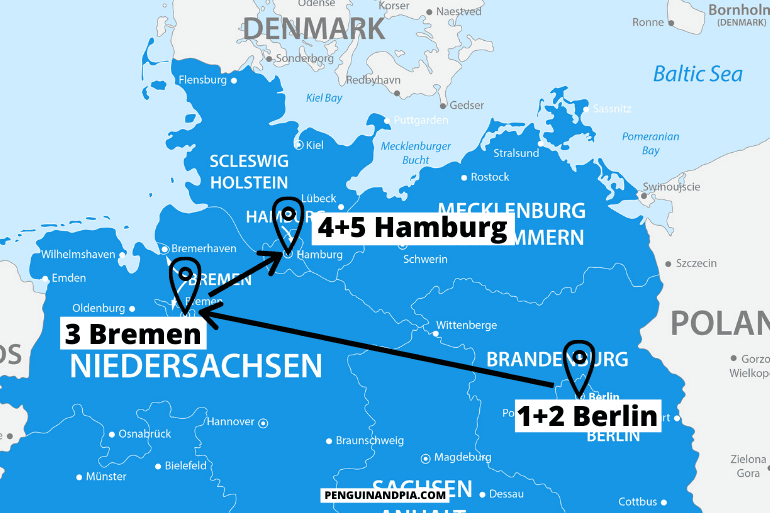
Day 1+2: Berlin Day 3: Bremen Day 4+5: Hamburg
Day 1+2: Berlin
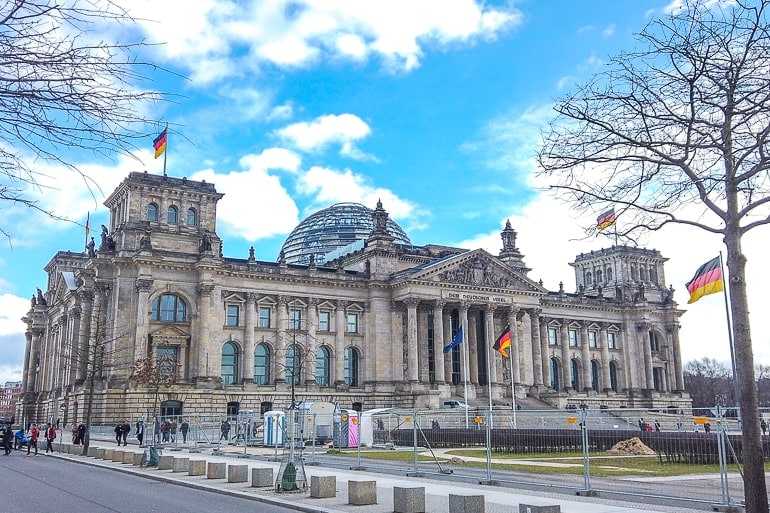
Berlin is a great place to start your adventure since it is the German capital, has multiple airports close by, and has really good train connections.
Since Berlin is such a popular tourist and business city, the car rental industry is well established and there are many different rental agencies to choose from.
— Compare prices from rental car companies in Berlin here
However, since you are only visiting bigger cities on this relatively short itinerary, we believe that a rental car is probably not necessary. Instead, for this trip, it might make more sense to take the train.
Since Berlin is such a big city with lots of things to do, it is worth it to spend (at least) two days in the city. So, remember to book your accommodation in Berlin for two nights .
Accommodation in Berlin : Berlin is a massive sprawling city with loads of different areas to stay and different accommodation options. You can check here for accommodations and hotels in Berlin .
If you are travelling to Berlin with a car, you’ll need a place to park. Check out Park Plaza Wallstreet Berlin Mitte for a stay right in the middle of the city close to Museum Island and other top attractions. It also has a tasty breakfast. Park Plaza has free parking on the street near the hotel (if available) or else it’s for a fee (but a reasonable price considering you’re in the middle).
If you are arriving into Berlin by train, you can check out NH Collection Berlin Mitte am Checkpoint Charlie . Located in the city centre right near the top sight “Checkpoint Charlie”, this popular hotel is in the heart of the action/attractions and is easy to get to via modes of public transit (metro – called the “U” for U-bahn).
If you are searching for a hostel/hotel, check out PLUS Berlin . Located over near the East Side Gallery (the piece of the Berlin wall with the artwork on it), Eric stayed here and really liked it! It’s also very easy to get to using public transit and is close to other areas to go out, etc.
Must-see Attractions in Berlin:
- Brandenburg Gate
- East Side Gallery (Berlin Wall)
We have also written a whole article about classic tourist attractions in Berlin in case you’d like some more inspiration. If you’re looking for some tips on how you could spend a day in Berlin, have a look at our One Day in Berlin Guide .
Day 3: Bremen
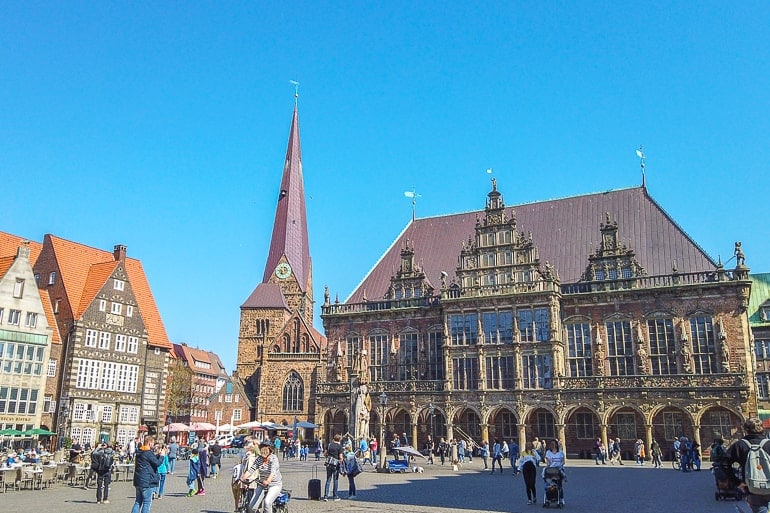
On the third day of your 5 days in Germany, you’ll head for Bremen. We’d recommend that you do the drive/train ride in the morning so you have enough time to explore the city once you get there.
Bremen is a hanseatic city with a nice old town – the market square with the town hall and the cathedral is especially popular. In German-speaking countries, the city is also known for a tale called the “Town Musicians of Bremen” by the Brothers Grimm. You’ll come across the animals of the tale (donkey, dog, cat, and rooster) many times as you stroll through the city.
The drive from Berlin to Bremen will take you approximately 4 hrs 10 min by car , but only around 3 hrs by train . If you take the train, try to book in advance if you can as this will usually save you some money.
Accommodation in Bremen: Bremen is a popular city to explore and it’s also on the larger side so you’ll find plenty of accommodations to suit your needs. There are hotels in the city centre/old town which put you within walking distance of the river and top attractions. You can check here for accommodations and hotels in Bremen .
For a popular choice in the historic middle, you should check out the very popular Radisson Blu Hotel Bremen . Funny story – we know there’s underground parking because we parked there when we visited Bremen by car.
If you want to stay closer to the train station just outside the historic centre (but still very central), check out the Dorint City-Hotel Bremen . This lovely and also very popular hotel is close to the pretty Windmill and flower gardens and has water views just outside the old city walls.
Must-see Attractions in Bremen:
- Marktplatz with Town Hall and Cathedral
- Böttcherstraße
- Schnoorviertel
If you want some more tips for Bremen, have a look at our detailed Things to do in Bremen Guide .
Day 4+5: Hamburg
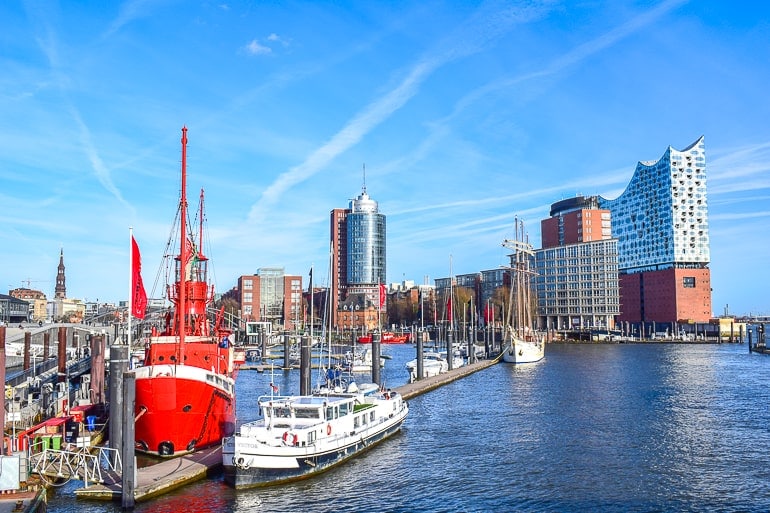
Hamburg is the second-biggest German city and the last stop on this short itinerary. We have been to Hamburg numerous times now and it is actually one of our favourite bigger German cities. You’ll find that the atmosphere of the city is very different than in Berlin. Not necessarily better or worse – just different.
Interesting (and slightly irrelevant) fact: The cities you visit on this itinerary are the three city states that exist in Germany in addition to the 13 area states such as Bavaria, Nordrhine-Westphalia etc.
The drive from Bremen to Hamburg is actually pretty simple and should only take around 1 hour 30 minutes by car and just around 1 hour if you take an ICE (fast train) . The train connection between these two cities is great with trains running pretty frequently. That should make it quite easy to find a train connection that works for your schedule.
Accommodation in Hamburg : Hamburg is popular city with loads of different accommodations and areas to stay in. You can check here for accommodations and hotels in Hamburg .
If you are travelling to Hamburg with a car, you might want to check out the Mövenpick Hotel Hamburg . Located in an old water tower, this unique hotel has a number of cool features with stunning views and parking onsite. It’s very popular – and also close to public transit for getting around!
If you are travelling to Hamburg by train, ARCOTEL Rubin Hamburg is a great hotel option for you to check out. Located in the cool area of St. Georg, you can easily walk to the hotel from the train station. It’s also walkable to other parts of the city centre and other attractions.
If you are looking for a hostel in Hamburg, you might want to check out Generator Hamburg as a reliable and popular hostel stay close to central station and the heart of the city.
If you want more details about accommodations in the city, we have a more detailed guide on where to stay in Hamburg .
Must-see Attractions in Hamburg:
- Speicherstadt
- Elbphilharmonie
- St. Pauli Piers
As one of our first ever articles on Penguin and Pia, we actually wrote a short Hamburg Guide . Have a look if you want some more Hamburg inspiration. Unfortunately it’s not nearly as detailed as our newer article – looks like it’s time for an update!
Germany Itinerary 5 Days – South
If you would like to explore the southern part of Germany instead of the north, then we would recommend the following 5 days Southern Germany itinerary. Compared to the northern itinerary, this trip includes stops in some smaller towns and cities. So, if you are interested in seeing some places of various sizes, beautiful old towns, and maybe a castle, then this might be a good itinerary for you.
The driving distance of this trip is just around 680 kilometres with a total driving time of approx. 7 hours . Depending on your mode of transportation, this can – of course – vary slightly.
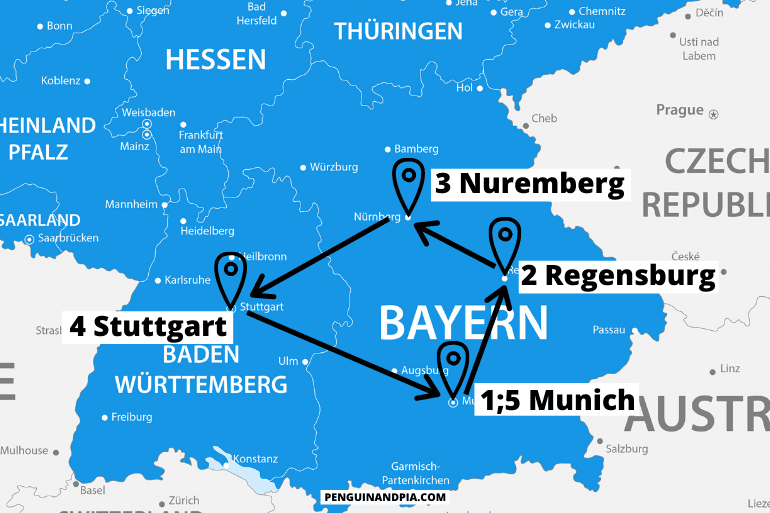
Day 1: Munich Day 2: Regensburg Day 3: Nuremberg Day 4: Stuttgart Day 5: Munich
Day 1: Munich

We are starting (and ending) this itinerary in Munich since it is an easy airport to fly in and out of from other parts of the world. If you are coming from another part of Europe by train, the connections to Munich are also usually pretty good.
Munich is the third-biggest German city and a very popular tourist destination. International travellers often mainly know the city because of the Oktoberfest which happens every year from the middle of September until October.
However, there is so much more to do and see in Munich than just the “Wiesn” (as the Oktoberfest is sometimes called as well). We are always happy to return to Munich because there is just so much to explore.
If you are thinking about renting a car for this itinerary, then you’ll be happy to know that it is quite easy to get a rental car in Munich. You can either pick it up directly at the airport after you land (if you arrive by plane) or in the city centre before you head to the next stop on this journey.
— Compare prices from rental car companies in Munich here
Accommodation in Munich: Munich is very large and popular city so finding a place to stay is no problem. The issue becomes that there are too many places to choose from! That said, you can check here for accommodations and hotels in Munich .
Specifically, we stayed at the very popular H2 Hotel München Olympiapark and we would highly recommend it for the value for money. The hotel has nice, cozy rooms, a super great breakfast buffet, and has a metro station steps from the front entrance to take you to the city centre.
There’s also onsite parking which makes this hotel perfect if you are travelling to Munich by car. The famous Olympic Park and BMW Museum are close by, too!
If you want to stay a little more in the city centre, then check out the Platzl Hotel Superior . This trendy hotel is in the heart of the Old Town just steps from top attractions like Marienplatz and the famous Hofbräuhaus. It’s also easy to get to the central train station either walking or on the metro.
If you are looking for more details on accommodations in this massive city, we wrote a detailed guide on where to stay in Munich .
Must-see Attractions in Munich:
- Marienplatz with New Town Hall
- Olympic Park
- Victuals Market
- English Garden
We also have a great little guide on how to spend one day in Munich if you want more details.
Day 2: Regensburg
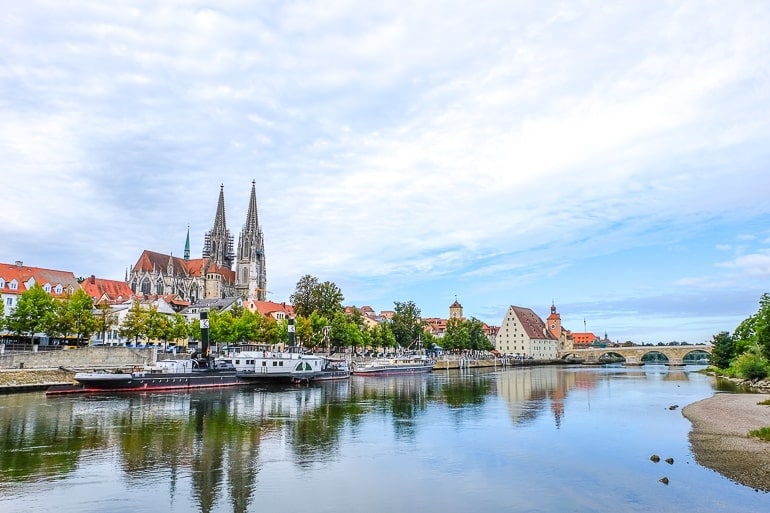
On day two of your trip you’ll be on your way to Regensburg, a small city in Bavaria on the Danube river. Due to its location by the river, Regensburg is a popular stop for people on a river cruise. So don’t be surprised if you see many different tour groups in the Old Town.
We recently spent a couple of days in Regensburg to get to know the city better and enjoyed our time there. One of the highlights is the Old Stone Bridge in the city centre which was built in the 12th century. We actually filmed a small YouTube video in Regensburg – which you can watch here if you are curious about what the city looks like.
The journey from Munich to Regensburg takes approximately 1 hr 20 minutes by car and around 1 hr 30 minutes by train . If you decide to travel by train – and especially if you are travelling with other people – we would recommend that travel with a “Bayernticket” (Bavaria Ticket). This ticket for train travel within the state of Bavaria usually allows you to save some money compared to regular prices.
Accommodation in Regensburg: If you are staying a night in Regensburg, you’ll have a number of great accommodations to choose from. To get started, you can check here for accommodations and hotels in Regensburg .
When we visited the city, we stayed at the Holiday Inn Express – Regensburg and really liked it. It’s a newer hotel and it really shows. The breakfast was excellent and there is even an onsite parking garage if you are travelling with a car. It’s not in the Old Town or near the river – but we did walk there one day and it only took about 15 minutes.
If you are travelling by train and you are on-foot, then check out the Altstadthotel Am Pach . This simple hotel is located right in the heart of the old town so you’re close to everything there is to see and do in Regensburg – including the beautiful Danube River. They also have breakfast included.
Must-see Attractions in Regensburg:
- Old Stone Bridge
- St Peter Cathedral
We are currently still working on our Regensburg Guide – but we’ll link it here once it is published.
Day 3: Nuremberg
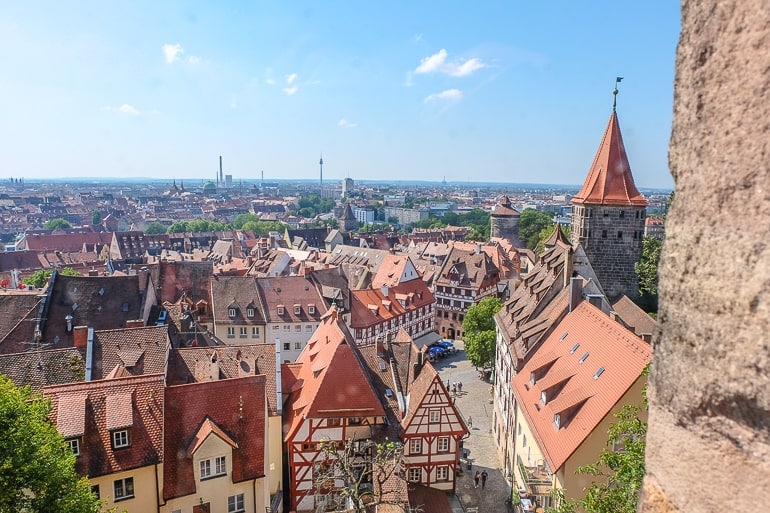
On the third day of this 5 day Southern Germany itinerary you’ll drive – or take the train – from Regensburg to Nuremberg. Nuremberg is a medium sized city in a part of Bavaria called Franconia. If you pay attention, you might notice that the dialect spoken here is quite different from that spoken in Munich and other places farther south.
Lisa actually grew up in this part of Germany so she has been to Nuremberg many, many times. Last year we also went to explore the city together and had a great time. Travellers from abroad mainly know the city for the Nuremberg Trials which took place there after World War II. You can certainly learn alot of history in this German city!
Since Nuremberg is quite close to Regensburg the drive won’t be long – giving you slightly more time to explore the city.
The journey takes approximately 1 hour 10 minutes by car and between 1-2 hours by train depending on which train you take (some stop more often than others). Once again, a regional ticket – such as the Bavaria Ticket – will probably save you some money if you travel with more people.
Accommodation in Nuremberg : Since Nuremberg is a very popular city to visit in Germany, there are many, many places to stay scattered throughout the city centre and around it. You can check here for accommodations and hotels in Nuremberg .
When we visited, we stayed at Five Reasons Hotel and Hostel and we really liked it. Located just inside the medieval city walls, we were really close to the train station and yet also steps from top attractions like the Germanisches Nationalmuseum. The place was bright and great value for the price which we liked a lot.
Close to Five Reasons, we had friends stay at the Sheraton Carlton Nuremberg and they loved it. We actually saw it with our own eyes – it had a pool with views of the city among other perks. There’s also a parking lot right across from the hotel if you’re coming to Nuremberg by car. It’s walking distance to the old centre and the central train station so best of all worlds!
Must-see Attractions in Nuremberg:
- Imperial Castle of Nuremberg (Kaiserburg)
- Documentation Center + Nazi Party Rally Grounds
- Albrecht Dürer’s House
As is the case with Regensburg, we are also still working on our article for Nuremberg. Once it’s live, we’ll link it here.
Day 4: Stuttgart
Stuttgart is the capital of the German state called Baden-Württemberg and the only place on this itinerary that is not located in Bavaria. The city is mainly known for being a “car hub” since both Mercedes-Benz and Porsche have their headquarters there. There are also museums dedicated to both car brands.
Stuttgart is a bit smaller than Munich but there is still a lot to see. In fact, one day won’t be enough to see the whole city – but it’ll allow you to get a good first impression. Next to the car museums, you could visit some of the many green spaces and/or old buildings that the city has to offer.
Driving from Nuremberg to Stuttgart by car will take you approximately 2 hours 15 minutes. If you have the time, you could even take a small detour and stop in Rothenburg ob der Tauber, known for its picturesque Old Town.
By train , the journey from Nuremberg to Stuttgart will take between 2 hrs 10 minutes and 2 hrs 30 minutes – depending on the type of train you are taking. Try to book your ticket in advance if possible as this can save you some money.
Accommodation in Stuttgart: There are many places to stay in Stuttgart – especially in the city centre. You can check here for accommodations and hotels in Stuttgart .
If you’re travelling to Stuttgart with a car, check out the Abalon Hotel ideal . Located very much in the city centre, this popular hotel has an underground parking garage and offers a good breakfast selection.
If you’re travelling to Stuttgart by train, you can check out the Pension am Heusteig . This guesthouse-style accommodation doesn’t have parking but offers a great breakfast and is a doable walk or metro ride from the train station. Funny enough, these two accommodations are very close to one another!
Must-see Attractions in Stuttgart:
- Schlossplatz
- Mercedes-Benz Museum
- Staatsgalerie Stuttgart
Day 5: Munich
On the last day of your trip you’ll make your way back to Munich since it is usually easier to leave Germany through the Munich airport than smaller airports in the surrounding area.
However, if you don’t have to get to an airport – and/or are taking the train home – you could also stay an extra night in Stuttgart if you wanted. Both cities are worth spending an extra few hours in – so you really just have to see what works best for you.
If you decide to get back to Munich, then the journey from Stuttgart to Munich will take approximately 2 hours 20 minutes by car and just slightly less (2 hrs 15 minutes) by train .
Accommodation in Munich : We already went over accommodations in Munich in Day 1 of this itinerary. So, you can head back up for the full details – but we would highly, highly recommend the H2 Hotel München Olympiapark as great value for money with great breakfast, parking, and a metro stop outside the front door.
Don’t forget we also have our detailed guide on where to stay in Munich if you want to have a deeper look at accommodations in the city.
We also have a post on spending one day in Munich if you want more details about the city!
Germany Itinerary 7 Days
If you have slightly more time to explore Germany, we have also created two 7 day Germany itineraries for you. Similar to the 5 day itineraries, we made two different itineraries since it’s pretty much impossible to see the whole country in just a week.
Instead of a northern and southern itinerary, this time we have focused on the western and eastern parts of the country. But please don’t read too much into that description – we use the terms quite loosely. As always, you’re welcome to modify any part of the itinerary to make it better fit your schedule/interests.
Germany Travel Itinerary 7 Days – West
For this itinerary, the total driving time would be around 14 – 15 hours and the distance would be slightly over 1100 km . For these calculations, we included the day trip to Monschau (and back to Cologne) as well as the day trip to Freiburg im Breisgau (and back to Stuttgart), which would be a longer day trip anyway.
So, depending on which day trips you decide to add on to (or remove from) this itinerary, your driving time and distance could be noticeably different than the estimates given above!
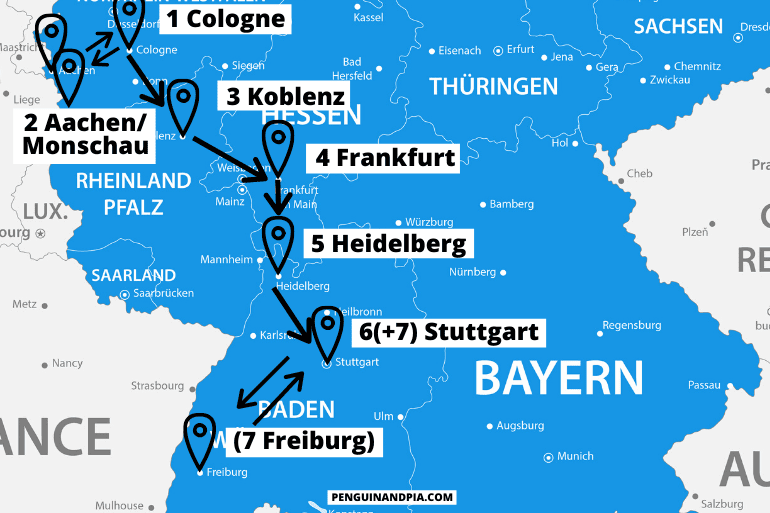
Day 1: Cologne Day 2: Day Trip to Monschau/Aachen Day 3: Koblenz Day 4: Frankfurt Day 5: Heidelberg Day 6: Stuttgart Day 7: Stuttgart / Day Trip to Freiburg im Breisgau
Day 1: Cologne
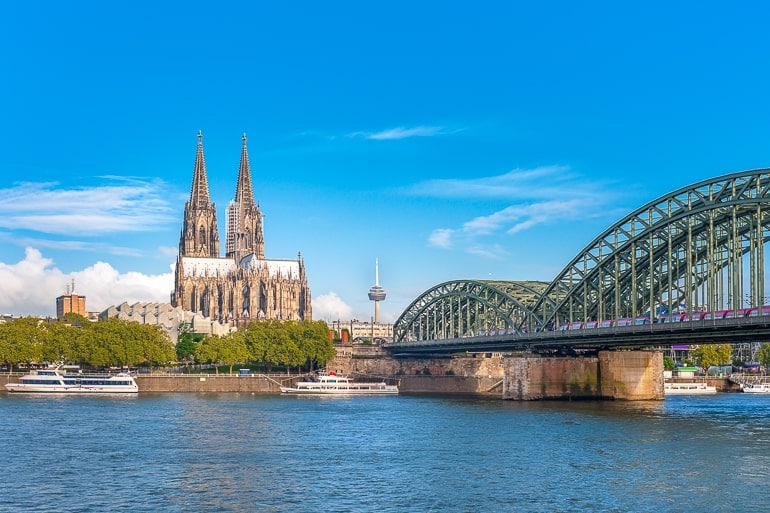
As we have already explained above, we like to start these itineraries in bigger cities to make it easier for people from overseas to get to Germany and start their adventure without hassle. Cologne is Germany’s fourth-biggest city (by population) and has two pretty good airports (Airport “Köln Bonn” and Airport “Düsseldorf”) close by for those coming from far away.
If you want to rent a car for this itinerary, it should be pretty easy to get one in Cologne since it’s quite an international city with lots of visitors.
— Compare prices from rental car companies in Cologne here
Cologne is a pretty spread-out city so you won’t be able to see the whole city in a day or two. However, the highlight of the city is certainly the Cologne Cathedral which is located right next to the central station and the Rhine River.
Make sure to plan some time to visit this impressive building – we always spend much longer in there than we originally plan. It’s free to enter so it can get very crowded depending on the day and time you’re visiting.
Accommodation in Cologne : Cologne is a very big city with multiple areas to stay in. As such, there are lots of accommodation options across the city. Wherever you book, remember to book your accommodation for two nights since you will go on a day trip and then return to Cologne on the second day. You can check here for accommodations and hotels in Cologne .
We have stayed in the Lindner Hotel City Plaza and loved it. The floors all have themes (we got Cologne Zoo with animals), the breakfast buffet is absolutely fantastic, and it’s a short walk to the Cathedral along one main street. There’s also parking available at/near the hotel for those with a car.
If you want to stay more in the heart of the city centre, check out something like the CityClass Hotel Residence am Dom . It’s popular, centrally located with shops and restaurants around, and only a short walk to the train station.
If you are looking for a hostel in Cologne, Eric once stayed at Cologne Downtown Hostel and it was honestly excellent. There’s a grocery store right below it and it’s located in the city centre. It also has a large balcony to enjoy the sunshine from!
Must-see Attractions in Cologne:
- Cologne Cathedral
- Cologne Chocolate Museum
Day 2: Day Trip to Monschau/Aachen
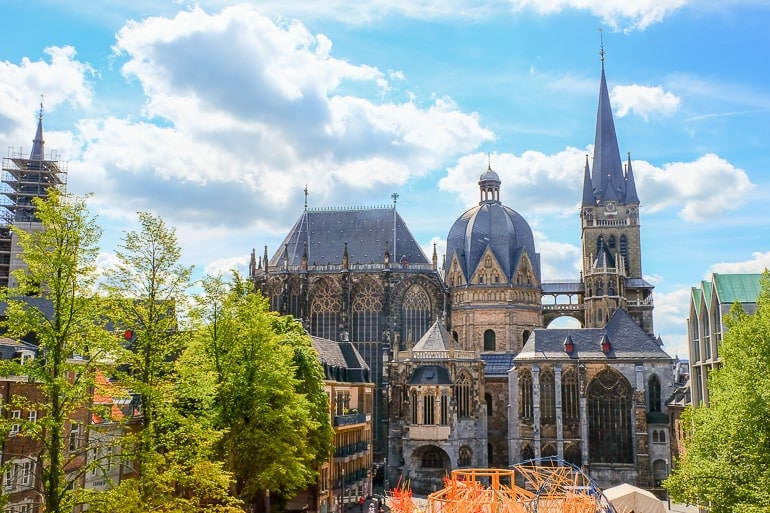
On the second day of this Germany itinerary, you have a few different option: you can either spend another day in Cologne if you feel like you haven’t seen enough of the city yet or take a day trip to Monschau or Aachen. Both of these are two places not too far from Cologne.
Monschau is a popular day trip in the area mainly because of its picturesque buildings in the old town. In fact, you probably have already seen photos of it on social media. To get to Monschau from Cologne, you can either drive or take a combination of trains and buses.
Getting to Monschau takes around 1 hr 40 minutes by car and approx. 2 hours by public transport . To visit Monschau by public transport, you can take the regional train from Cologne to Aachen-Rothe Erde and then take Bus #66 from there to Monschau.
Must-see Attractions in Monschau:
- Monschau Castle
If you want to go on a day trip but don’t want to venture that far, then Aachen would be another great option. This city is actually Germany’s most western city very close to the borders of The Netherlands and Belgium.
We’ve lived close to Aachen for a while and have written a whole guide full of things to do in Aachen that you should read if you want more information. In our opinion, one day is the perfect amount of time to explore the city since it doesn’t have that many attractions and the old town in the city centre is quite compact (but still very pretty).
Getting from Cologne to Aachen is also very easy. It takes approx. 1 hr 20 minutes by car and just around 50 minutes by regional train . You should look into getting a “Schönes Tag Ticket NRW” for the day if you’re travelling with more people as this can save you some money.
Must-see Attractions in Aachen:
- Aachen Cathedral
- Elisenbrunnen
Day 3: Koblenz
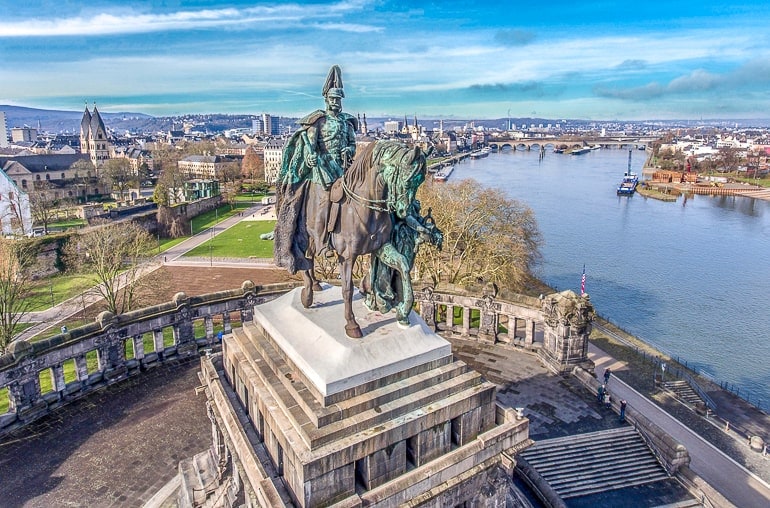
From Cologne, your journey continues to Koblenz – another city on the Rhine River. Koblenz is a smaller German city with a population of slightly over 110,000 inhabitants.
There are quite a few castles and nice hikes in the area which are easy to reach from Koblenz – just in case you decide that you don’t want to spend the day in the city. Depending on the time of year, you could also look into booking a boat tour on the Rhine river. This way, you get a unique perspective of the beautiful region.
Getting from Cologne to Koblenz is pretty easy and will take approximately 1 hour 30 minutes by car and between 50 minutes and 1 hr 10 minutes by train . We really like this train journey since the tracks follow the river for a majority of the trip. As a result, you get some really nice views – and might even spot some of the beautiful castles in the area!
Accommodation in Koblenz: Koblenz is certainly not a huge city – but you’ll still find a good number of places to stay for a night or two. You can check here for accommodations and hotels in Koblenz .
For a hotel right in the city centre, check out the Sander Hotel . This lovely hotel is super popular and close to shops and the rivers. If you are arriving to Koblenz by car, there is onsite parking at the hotel. However, since the city is smaller you can also easily reach the hotel by walking from the central train station.
Must-see Attractions in Koblenz:
- Deutsches Eck
- Ehrenbreitstein Fortress
- Koblenz Cable Car
Day 4: Frankfurt
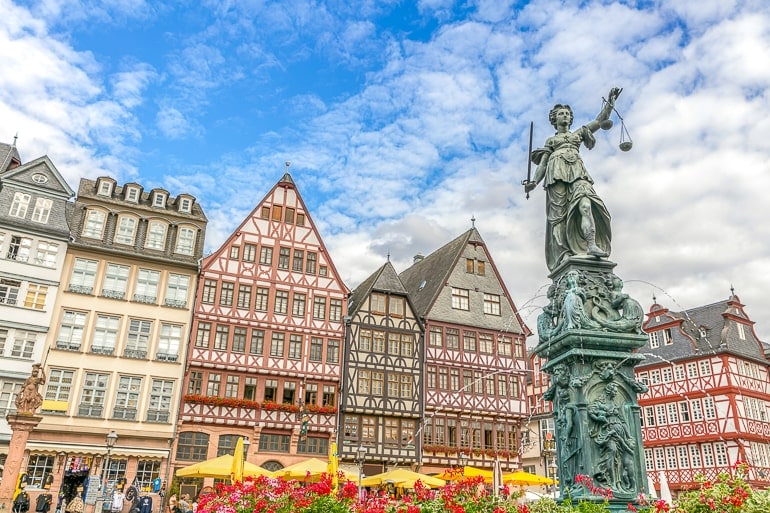
The next stop on your itinerary is Frankfurt, arguably one of the country’s most popular transport hubs due to the busy Frankfurt airport. Frankfurt is an interesting city that divided people: some people really enjoy it while other people don’t like it at all. To be fair, we haven’t spent enough time in the city to really solidify our opinion.
Either way, we do believe that Frankfurt is a stop that you shouldn’t miss if you are trying to get to know different areas of Germany. Known as the financial hub of Germany, this city with its many skyscrapers can feel quite a bit more modern than other German cities. However, the city also has a beautiful, historical market square that you should visit.
The journey from Koblenz to Frankfurt is another easy one – and if you are taking the train (we would recommend that!), you’ll once again follow the Rhine River for big parts of the journey and be rewarded with some great views.
The train ride will probably be between 1 hr 25 minutes and 2 hrs 12 minutes long – depending on the connection you choose. By car , the trip will take around 1 hr 30 minutes . Of course, this can vary depending on traffic.
Accommodation in Frankfurt : There are loads of places to stay in Frankfurt given its popularity and size. You can check here for accommodations and hotels in Frankfurt .
A great option in Frankfurt is the Motel One Frankfurt-Römer . Located very much in the heart of the city centre close to the old town and river, this cool hotel has underground parking if you are arriving to Frankfurt by/with a car. It also serves up a great breakfast!
If you are arriving by train to Frankfurt, you should check out Fleming’s Express Hotel Frankfurt . Located literally right beside the central station (which is in the city centre), this upscale hotel is very popular because it’s very affordable and also has a great breakfast.
Must-see Attractions in Frankfurt:
- Palmengarten
Day 5: Heidelberg
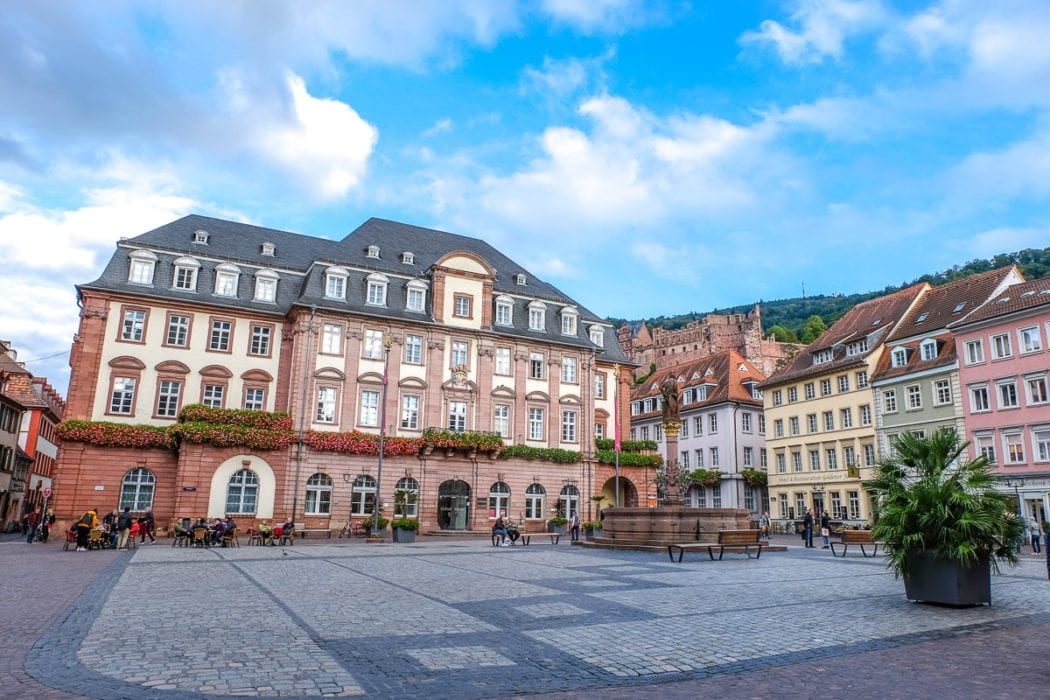
After your day in Frankfurt, you’re heading to Heidelberg which is actually one of our favourite German cities. The highlight of the city is certainly the castle on top of the hill which is visible from many different parts of the city.
Heidelberg is smaller than Frankfurt so you can see quite a bit in just 24 hours. The Old Town is beautiful and lots of attractions are located there. Our highlight was probably the tower climb of the Church of the Holy Spirit. From up there, you get a beautiful view of the Old Town. A very close second was the cable car ride up to the Königstuhl which was lots of fun – even in the rain.
Getting from Frankfurt to Heidelberg won’t take too long. The journey will be approximately one hour by car and between 45 minutes and 1 hr 30 minutes by train – depending on which type of train you are taking.
Accommodation in Heidelberg: If you’re heading for Heidelberg (good choice), there are lots of great places to stay. You can check here for hotels and accommodations in Heidelberg .
We stayed a little outside the old town – but close to the train station – at NinetyNine Heidelberg City . This hotel was really, really great. The beds were comfy and the decor has animals everywhere – you have to see it to understand!
There’s onsite parking (paid) and street parking (free, but not guaranteed) if you are travelling with a car. There’s also a tram stop right outside the hotel to get directly into the city centre in minutes.
If you are looking to stay in the historic old town, then check out colourful hotels like Hotel Holländer Hof which overlooks the river or Hotel Zum Ritter St.Georg which is literally overlooking the main Marktplatz.
Must-see Attractions in Heidelberg:
- Heidelberg Palace
- Church of the Holy Spirit (mainly tower climb)
If you want to learn some more about Heidelberg and what there is to do, you can read our detailed Heidelberg Guide here .
Day 6: Stuttgart
The next day you will drive to Stuttgart, a city that we’ve already mentioned in one of our Germany itineraries for 5 days. As we have already mentioned, you’ll probably really enjoy Stuttgart if you are interested in cars.
Even if you aren’t, there is still lots for you to explore. Did you know that wine also plays a huge role in Stuttgart and the surrounding region? If this is something that interests you and you’re there in the summer (specifically around the end of August), then you should stop by the “Stuttgarter Weindorf” (“wine village”) – but obviously, please don’t drink and drive.
As for getting from Heidelberg to Stuttgart, the journey will take you approximately 1 hr 20 minutes by car and between 40 minutes and 1 hr 30 minutes by train . As mentioned before, the time differs depending on the type of train you are choosing.
Accommodation in Stuttgart: Stuttgart has many places to stay so you can check here for accommodations and hotels in Stuttgart .
Be sure to see the Abalon Hotel ideal if you have a car. This hotel has underground parking available and a tasty breakfast. It’s also in the city centre which makes sightseeing easy.
Those coming to Stuttgart by train should look at the Pension am Heusteig . It’s a guesthouse that is located not too far from the first hotel here and it’s a doable walk or metro ride from the central station.
Day 7: Stuttgart / Day Trip to Freiburg im Breisgau
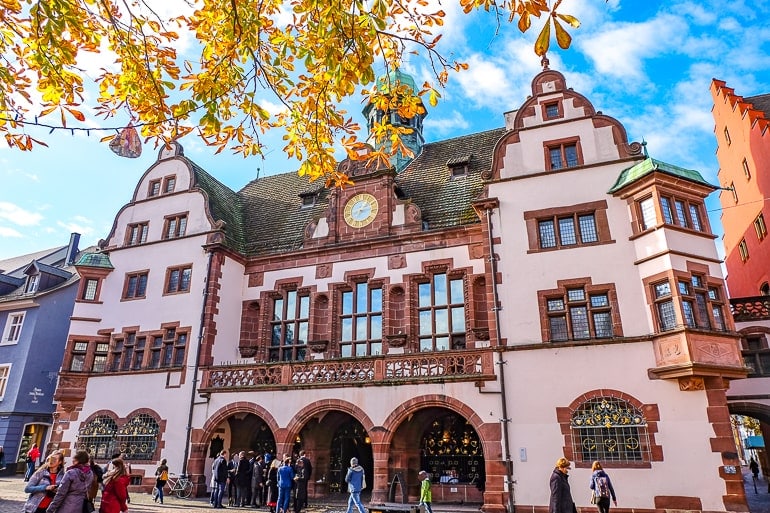
For this itinerary, you can decide how you would like to spend your last day. You could either spend another day to explore more of Stuttgart (and maybe relax for a bit) or you could head farther south and spend a day in Freiburg im Breisgau. We really enjoyed spending time in this small city in the south of Germany during our visit.
We are currently still in the process of writing our Freiburg guide, but we’ll link it here once it’s done. However, a good way to start your exploration of the city is by wandering the old town.
In Freiburg, you’ll find that many of the cobblestoney streets have small water-filled runnels – called Bächle – running alongside it. Sometimes they even have small yellow ducks in them!
The journey from Stuttgart to Freiburg im Breisgau is slightly longer than most other parts of this itinerary. It takes approximately 2 hrs 30 minutes by car and around 2 hours by train . Since this train journey will probably include at least one ICE (the fast train), we’d recommend that you book your train tickets early if you can to save some money.
Must-see Attractions in Freiburg:
- Freiburger Münster (Cathedral)
- Schlossberg + Tower
- New + Old Town Hall
Germany Travel Itinerary 7 Days – East
If the other week-long Germany itinerary doesn’t interest you and/or you really want to visit the German capital Berlin, then you might prefer this eastern route instead.
The driving time would be just slightly over 10 hours and would be approximately 900 km driving distance – including the day trip to Potsdam (which would honestly be easier with public transport, though)!
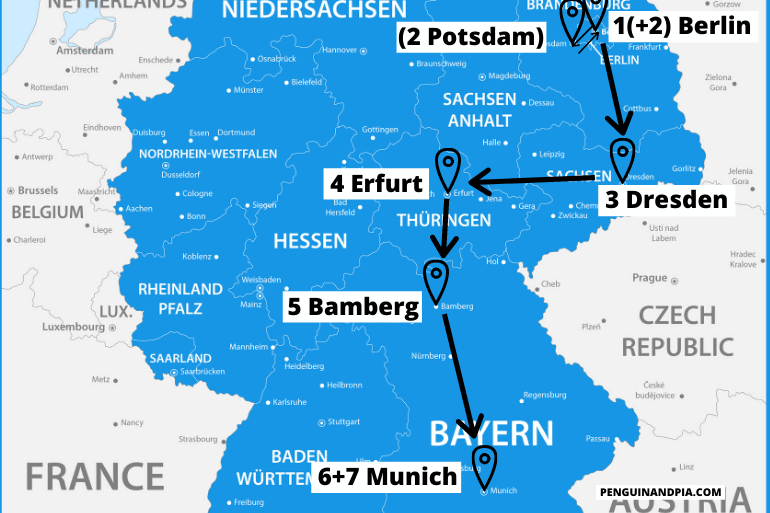
Day 1: Berlin Day 2: Berlin / Day Trip to Potsdam Day 3: Dresden Day 4: Erfurt Day 5: Bamberg Day 6+7: Munich
Day 1: Berlin
Once again, this itinerary begins in Berlin since it is one of the big cities that is easier to get to for people coming from overseas. Similar to the five day itinerary that started in Berlin, you’ll stay two nights in the German capital. There is just too much to see to spend only one day – and even in two days you wouldn’t be able to explore everything.
In case you’ve already been to Berlin on a different trip and/or aren’t a huge fan of big cities, we also give you the option of a day trip to Potsdam (a city close by) on the second day. More on that below.
Accommodation in Berlin : Finding a place to stay in Berlin can be tough because there are just so many options. You can check here for accommodations and hotels in Berlin .
If you have a car, check out Park Plaza Wallstreet Berlin Mitte . Located right in the middle of the city close to Museum Island, this hotel has a great breakfast and free parking on the street behind the hotel. Otherwise, parking is paid but for a decent price for the city centre.
Those without a car travelling by train should see the NH Collection Berlin Mitte am Checkpoint Charlie . If you want a hotel close to a top attraction that is easy to get to with public transport, this is definitely one of them!
Across the city, PLUS Berlin is a really good hostel/hotel that Eric stayed at a few years ago. It’s a big place but it was a great stay over by the East Side Gallery (part of the Berlin Wall with the graffiti on it).
As already mentioned above, if you want to read some more about Berlin, check out our articles on Things to do in Berlin and How to spend one day in Berlin .
Day 2: Berlin / Day Trip to Potsdam
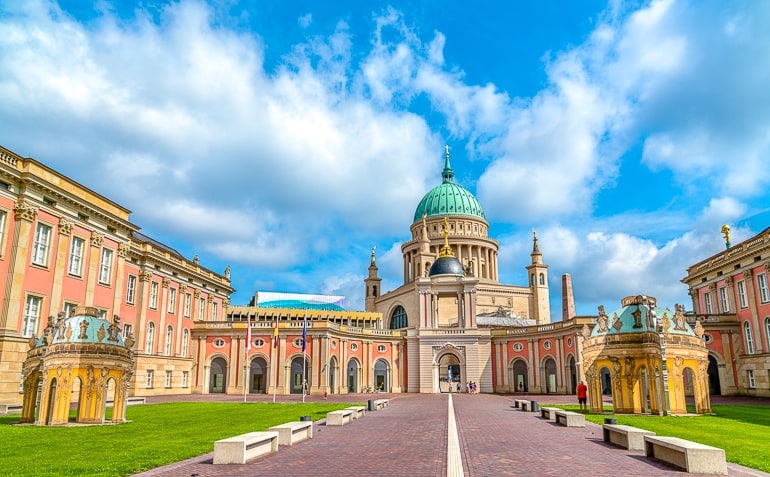
On your second day, you can choose between spending another day in Berlin to see more of the German capital or going on a day trip to Potsdam – which is a smaller city not far from Berlin.
Potsdam is actually the capital city of the German state called Brandenburg. It’s most popular attraction is probably Sanssouci Palace with the beautiful Sanssouci Park surrounding it.
During our visit, we also enjoyed walking through the Dutch Quarter with its small shops and cafes. Since the city isn’t too big, one day gives you a chance to get a good impression and check out some of the more popular sights.
It is also very easy to get to Potsdam from Berlin. If you decide to drive , it’ll take you approx. 40 minutes , but it could be longer – traffic depending. We would honestly recommend that you do this day trip by taking public transport. This way, you don’t have to worry about traffic and/or finding a parking spot.
For trains, you can take the S-Train #7 (S7) from Berlin Central Station (as well as other train stations) straight to Potsdam Central Station. The journey will take around 35 minutes with trains running very frequently throughout the day.
Must-see Attractions in Potsdam:
- Sanssouci Palace
- Dutch Quarter
- Cecilienhof
Day 3: Dresden
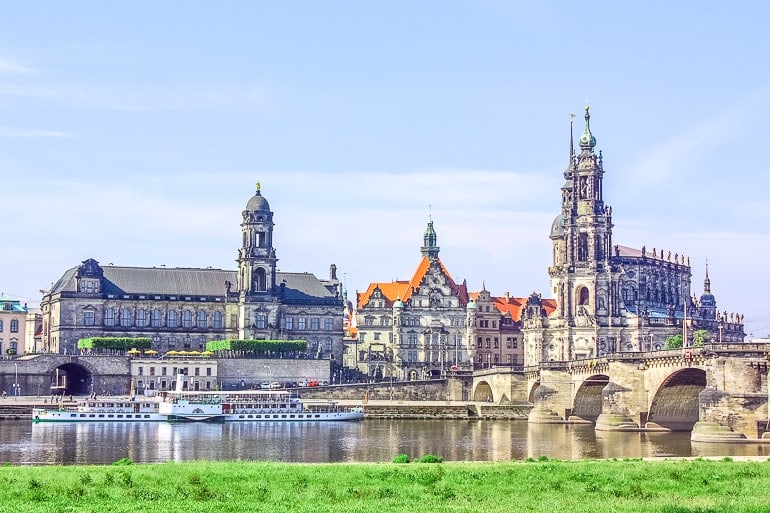
The third day of this Germany itinerary will take you from Berlin to Dresden which is a German city close to the Czech border. To be honest, we haven’t spend that much time in Dresden yet – and it’s certainly on our list of places to visit this year.
One of the city’s main attractions – the Zwinger – is known across the country and a sight that you shouldn’t miss during your visit. It’s a beautiful palace built in a baroque style.
Fun fact: When Lisa was a kid, she didn’t actually know that the “Zwinger” was a palace. Since that word can also mean “dog kennel” in German, she was always confused as to why people would want to visit it during their time in Dresden!
As for getting from Berlin to Dresden, the drive will take you around 2 hrs 10 minutes by car and around 2 – 3 hours by train. Once again, this depends on which connection you choose.
Accommodation in Dresden: There are a number of accommodations in the compact “Innere Altstadt” close to the River Elbe for you to choose from. You can check here for accommodations and hotels in Dresden .
For a great hotel option right in the old town, look no further than the Star Inn Hotel Premium Dresden im Haus Altmarkt . You’re a short walk to the train station, the river, and all the best old sights in Dresden if you stay here and arrive by train. If you come to Dresden by car, the hotel has discounted underground parking available.
Another option right in the old town (and even closer to the river) is Aparthotel am Schloss . Since this is an apartment-style hotel, it’s a great option if you are looking for more of a base to relax in a “home away from home”. It’s a very popular choice, too – and also has onsite parking.
Must-see Attractions in Dresden:
- Frauenkirche
Day 4: Erfurt
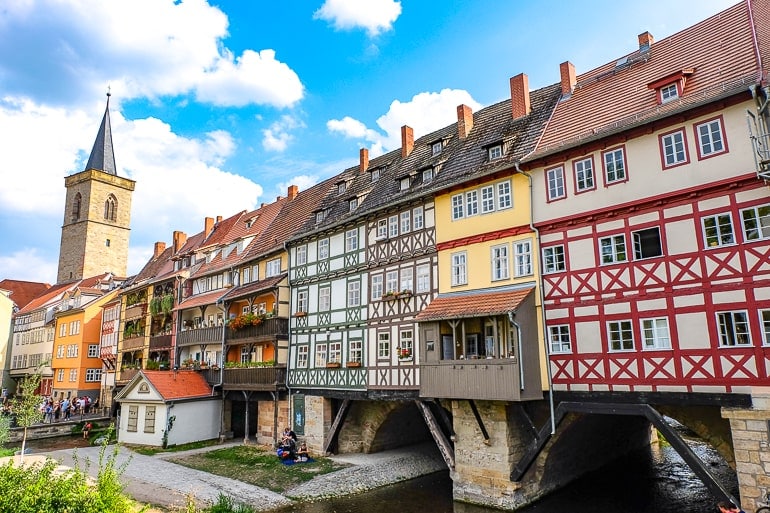
Erfurt is a popular city to visit in the middle of Germany – and it’s also the capital city of the German state Thuringia. We’ve spent some time in Erfurt a few months ago and instantly fell in love with the city. Its size is perfect (in our opinion) – giving you enough things to do without feeling overwhelming.
Maybe you’ve seen photos of one of the city’s most popular attractions, the Krämerbrücke. This bridge is not only pretty to look at and photograph, it’s also unique in the sense that there are buildings on the bridge and when you’re walking on it, you can’t actually see the water running below.
Visiting the bridge and climbing the tower of the Ägidienkirche, a church at one end of the bridge, is something we’d certainly recommend during your time in the city. We actually filmed a short video of our time exploring Erfurt. If you are interested in seeing what parts of the city look like, then you can find our video here .
Getting to Erfurt from Dresden won’t take you too long. It will take approx. 2 hours 20 minutes by car and between 2 and slightly over 3 hours by train .
Accommodation in Erfurt: Since Erfurt isn’t a huge city, there aren’t a ton of accommodations – but certainly more than enough to find one that works for your style and budget. You can check here for hotels and accommodations in Erfurt .
We stayed at Gästehaus in der Gotthardtstraße and really liked our stay. It’s located in a quiet neighbourhood just north of the city centre – a short walk to the Krämerbrücke. The host was lovely, the room was cozy, and there was secure onsite parking for those driving to Erfurt.
If you want to stay RIGHT in the city centre then you should check out Hotel Krämerbrücke Erfurt which is right beside the famous bridge. This might be a good place to stay if you are travelling to Erfurt by train and you’re on-foot.
Must-see Attractions in Erfurt:
- Krämerbrücke
- Erfurt Cathedral
- Citadel Petersberg
For more details, have a look at our Things to do in Erfurt article .
Day 5: Bamberg

Bamberg is a small city – or larger town – in the German state called Bavaria. It’s actually located in a region called Franconia, which is noticeably different from the Bavaria that you might know in the area surrounding Munich, etc.
We’ve been to Bamberg multiple times over the years (it’s also close to the part of Germany where Lisa grew up) and are always happy to come back. Bamberg is known for its cute, historic old town which is actually a declared UNESCO World Heritage Site.
One of the most popular buildings the city has to offer is the Old Town Hall (shown above) which is built on an artificial island. The story behind it is quite interesting.
The drive from Erfurt to Bamberg is doable and will take approx. 2 hrs by car and around 3 hrs by train . On the way, you’ll drive through quite a few tunnels since you’ll drive through an area known as “Thuringian Forest”.
Accommodation in Bamberg: Bamberg is a small place to visit so there aren’t a ton of options but still enough to find what you’re looking for. You can check here for accommodations and hotels in Bamberg .
Anywhere you stay is basically in or close to the old town/city centre. For a place to stay with parking (for those arriving by car), check out Welcome Hotel Residenzschloss Bamberg . It’s located right on the river.
You might also want to see Palais Schrottenberg to stay right in the middle of the Old Town! For reference, the train station is a short walk to the north of the river – not far from these places in the centre.
Must-see Attractions in Bamberg:
- Bamberg Cathedral
- Old Town Hall
- Alte Hofhaltung
If you want some more information about Bamberg, please read our detailed Bamberg, Germany Guide .
Day 6+7: Munich
From Bamberg, your journey will continue to Munich which will be the last stop on this 7 day eastern itinerary. Not only is this the third biggest city of the country, it is also one of the most internationally known destinations in Germany.
Whenever we come back to Munich, we always enjoy our time there. For some reason, the atmosphere always feels more laid back than in other big German cities and the people are usually quite friendly. We might also be a little bit biased, though, since Lisa grew up in this part of the country and is more used to the mentality, dialect etc. than in other parts of Germany.
For this itinerary, you’ll spend two days in Munich since there is quite a lot to see. Next to the obvious attractions like the Marienplatz with the New Town Hall and the Frauenkirche close by, there are also lots of museums and other things that you can explore.
If you’ve already been to Munich before and/or decide that one day in the city is enough for you, you could also opt for a day trip on one of these days. We’ve just recently written a whole Day Trips from Munich Guide , which you can browse through to get some inspiration!
Driving from Bamberg to Munich will take about 2 hrs 20 minutes by car and between 2 and 3 hrs by train . If you decide to only take regional trains instead of the ICE (fast train), you should look into getting the Bayernticket. This can save you some money, especially when you’re travelling with more people.
Accommodation in Munich: Since Munich is so large and popular to visit, there is definitely no shortage of places to stay! You can check here for accommodations and hotels in Munich .
That said, we loved our stay at H2 Hotel München Olympiapark . Located up by the famous Olympic Park, we’d highly recommend it since it was amazing value for money. The breakfast was huge and delicious and there’s a metro station outside the lobby door that takes you into the heart of the old town in minutes. There’s also parking if you are arriving by car.
For a hotel that is a little more central, you should see the Platzl Hotel Superior this hotel is really popular – and for good reason. It’s located around the corner from attractions like Marienplatz and the famous beer hall, Hofbräuhaus.
For more help looking into accommodations and neighbourhoods in Munich, check out our where to stay in Munich guide .
(Check out our guide to one day in Munich if you want more details on things to do and see.)
Germany Itinerary 10 Days
Although we have tried to create short itineraries that allow you to see more than just the standard cities, it is no doubt easier to see more of Germany if you are able to travel for longer than one week. To give you a couple different options that you could look at (and then potentially modify), we have created two 10-day Germany itineraries.
Once again, we believe that ten days would not be enough time to see the whole country – and even if you managed to do that it would be too stressful (in our opinion). Both of the following itineraries give you a good mix of bigger and smaller cities as well as a few interesting day trips. So, have a look and see which one you like better!
Germany Itinerary 10 Days – North
If you’re interested in seeing more of the northern part of Germany and experiencing the mentality and way of life of people in the flatter part of the country, closer to the sea, then have a look at the following 10-day itinerary!
The total driving time would be slightly less than 17 hours with a distance of approx. 1470 kilometres. For these calculations, we have included the day trips to Schloss Drachenburg, Lübeck, and Flensburg. So, if you decide to skip any of these, your driving time and distance would obviously be slightly lower.
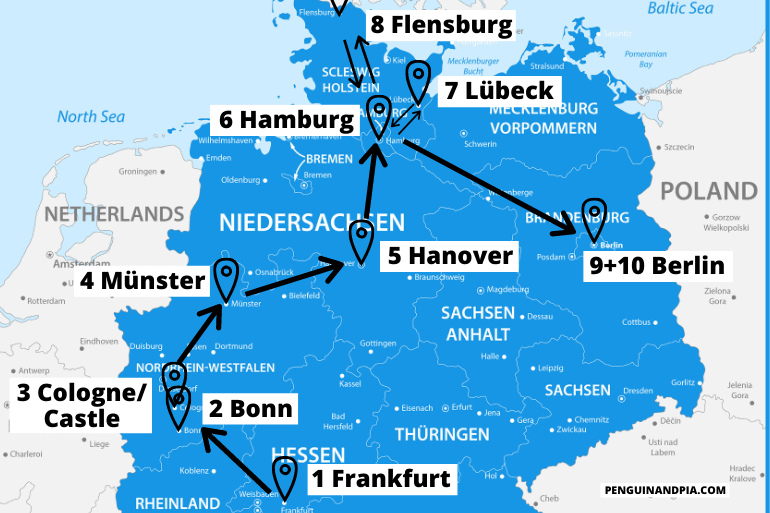
Day 1: Frankfurt Day 2: Bonn Day 3: Day Trip to Schloss Drachenburg / Cologne Day 4: Münster Day 5: Hanover Day 6: Hamburg Day 7: Day Trip to Lübeck Day 8: Day Trip to Flensburg Day 9+10: Berlin
Day 1: Frankfurt
Similar to some of the other itineraries mentioned in this article, we start this 10-day itinerary in Frankfurt. By now you should probably already know why – Frankfurt has the biggest airport of the country which should make it easier for people coming from overseas to get to Germany and start their adventure.
Furthermore, Frankfurt is quite centrally located so it is easy to get to many different cities from here. So even if you decide against following our itineraries step-by-step, Frankfurt would be a good starting point!
— Compare prices from rental car companies in Frankfurt here
Accommodation in Frankfurt : You’ll find plenty of places to stay in Frankfurt. You can check here for accommodations and hotels in Frankfurt .
One really popular hotel in Frankfurt is the Motel One Frankfurt-Römer . This Motel One is near the river and walking distance to lots of things in the city centre. If you are coming to Frankfurt with a car, Motel One has underground parking which can make life easy! They also have a nice breakfast.
A hotel option closer to the train station is Fleming’s Express Hotel Frankfurt . This hotel is just to the north of the main station which makes it a great option if you are arriving by train and have no car. It’s popular because it has a great breakfast and is good value for money.
Day 2: Bonn
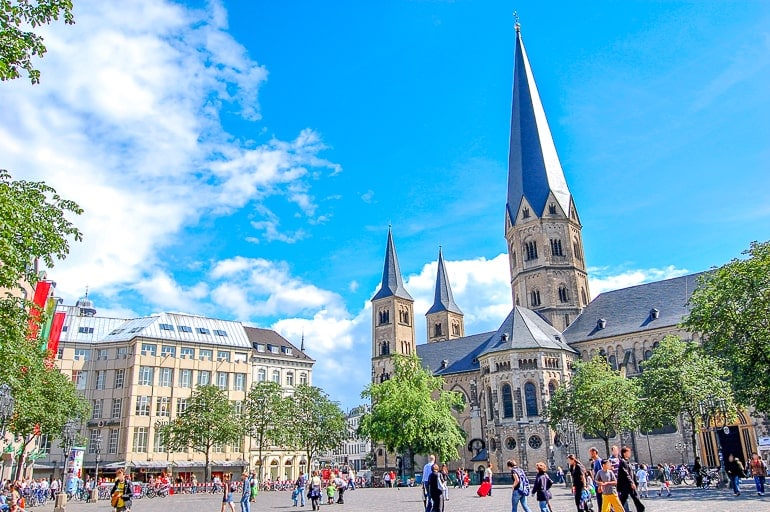
On the second day, you’ll head from Frankfurt to Bonn. As you might know, Bonn used to be the capital of the Federal Republic of Germany during the time that Germany was split into two countries. Later, the capital was relocated from Bonn to Berlin.
If you are interested in learning more about the history of Germany during your time in the country, then Bonn would be a good city to do that in. For example, you could visit the so-called “Haus der Geschichte” which is a museum about the history of the Federal Republic of Germany.
It won’t be difficult to get from Frankfurt to Bonn since the two cities are not too far apart. The journey will take approximately 1 hr 50 minutes by car and between 1 hr 20 minutes and 2 hrs if you take the train . Once again, we’d recommend that you book your train ticket in advance if possible.
Accommodation in Bonn: There are a number of accommodation options in Bonn which you can choose from – many are right in the city centre/old town. You can check here for accommodations and hotels in Bonn .
Keep in mind to book your accommodation for two nights for this itinerary. (You could also spend the following night in Cologne if you day tripped to there, though).
For a great hotel in the heart of the old town, check out BrauHotel Bonn . You can easily walk here from the central train station but they also have a and parking garage close by if you arrive by car. There’s also a craft beer bar on the ground floor!
Another option is the Hilton Bonn . This hotel offers you amazing views of the Rhine River. It’s a bit north of the city centre but still very much close to it. There is parking but it can be expensive so keep that in mind when you book.
Must-see Attractions in Bonn:
- Bonn Minster
- House of the History of the Federal Republic of Germany (Haus der Geschichte)
Day 3: Day Trip to Schloss Drachenburg / Cologne
On day three of this itinerary, you can choose to stay in Bonn, or go on one of two day trips: to Schloss Drachenburg (a castle not far from Bonn) or to Cologne which is also close by.
Schloss Drachenburg is actually a private villa/mansion that was built to look like a castle in the 19th century. Today, it is a popular attraction in the area.
From Bonn, you can either drive to Königswinter by car (and then leave your car at the car park) or take public transport to the Königswinter/Clemens-August-Straße station. You can find more information about that and opening hours etc. on the offical website .
If you are not a huge fan of castles, then you might opt for a day trip to Cologne instead. In this case, you might even decide to change your base and spend the night in Cologne instead of returning to Bonn at the end of the day. That is definitely an option that you can choose since there are lots of accommodation options in Cologne as well.
Getting to Cologne from Bonn will take you around 40 minutes by car (this can obviously depend on traffic) and only approx. 25 minutes by train . Just a quick warning: Trains can get very full if you are travelling during rush hour traffic – so try to avoid that if you don’t like being surrounded by lots of people in a small space.
Day 4: Münster
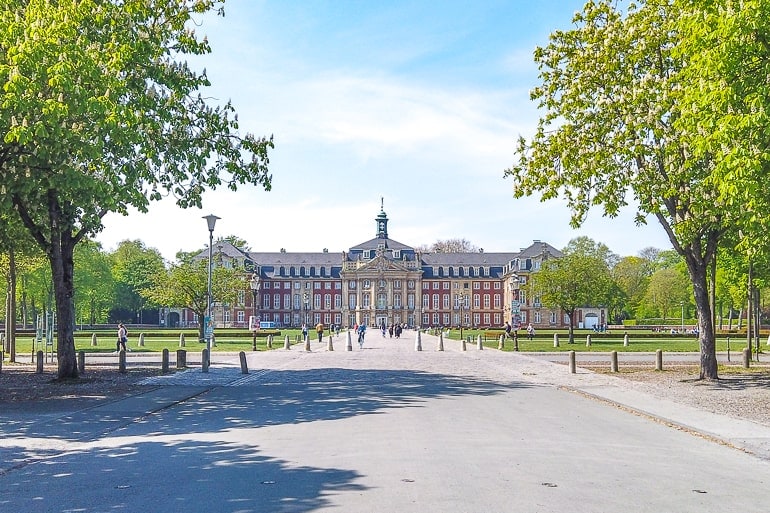
The next day you’ll head from Bonn – or Cologne – to Münster. Since Bonn and Cologne are so close, the journey wouldn’t really differ much from either city.
Münster is a smaller German city that we really enjoy. To be honest, it sometimes reminds Lisa of Copenhagen – mainly because of the many bikes that you can see all around the city. The University of Münster plays a big role in the city and the vibe – depending on which part of the city you are in – is noticeably younger.
One of the highlights of the city – for locals and visitors alike – is the lake Aasee which is located quite centrally. When the weather is nice, there are always people sitting on the grass enjoying the sun and maybe even out on the water (depending on the time of year). You can rent a small paddle boat to explore the lake from a unique perspective.
The journey from Bonn to Münster should take you slightly less than 2 hrs by car and between 2 hrs and slightly more than 3 hrs by train . If you want to save some money and are travelling with other people, then you should look into getting an “NRW Schönes Tag Ticket”. With this ticket, you wouldn’t be allowed to travel on ICE’s (the fast train), but the connections using only regional trains wouldn’t be much longer.
Accommodation in Münster: Münster might feel small but it’s actually pretty spread out and offers accommodations for all styles and budgets. You can check here for accommodations and hotels in Münster .
If you want a popular hotel option right in the centre, the H4 Hotel Münster is a short walk to the heart of the historic centre. It also has onsite parking for those travelling to Münster by car – but you can easily walk there from the train station in the south of the city centre.
Must-see Attractions in Münster:
- Münster Prinzipalmarkt
- Historic Town Hall
- Münster Cathedral
For a more detailed guide, have a look at our Things to do in Münster, Germany article .
Day 5: Hanover
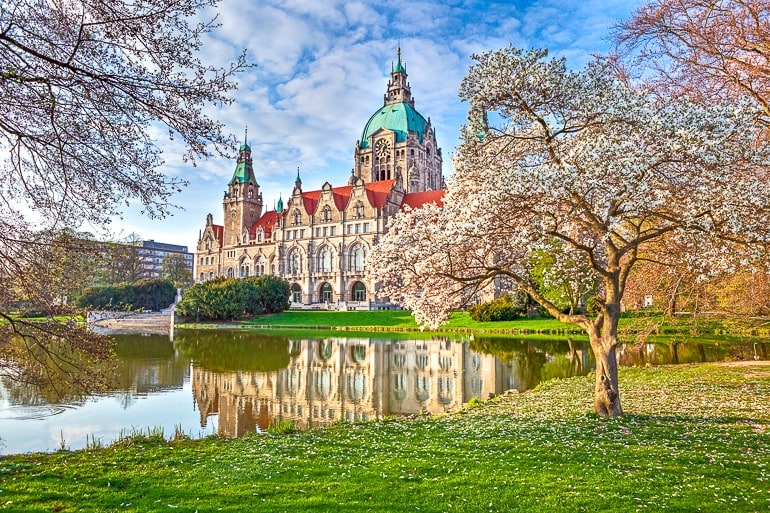
The following day you are travelling from Münster to Hanover. In German “Hannover” is actually written with two “n”, so don’t be surprised if you see it being written slightly differently.
Hanover is the biggest city and the capital of the German state called Lower Saxony. Compared to some other cities on this itinerary it is a less popular tourist destination. To be fair, even we haven’t spent that much time in Hanover yet. Hopefully we’ll be able to change that soon. However, that’s not to say that Hanover is not worth a visit.
Not only can you explore some beautiful gardens and interesting museums in the city, but it is also located pretty much halfway between Münster and Hamburg. That makes it a great stop to break up the journey and spent another day in a city that allows you to explore without too many other (international) tourists around.
By car , the journey from Münster to Hanover will take you around 2 hrs . If you choose to travel by train instead, it will take you approximately the same amount of time .
Accommodation in Hanover: Hanover is a larger city but the accommodation are still relatively packed together in and around the historic city centre. You can check here for accommodations and hotels in Hanover .
For a stay right in the city centre, check out the Hotel Loccumer Hof . This popular hotel is a very short walk from the central station which is perfect if you are arriving to Hanover by train. That said, they also have parking onsite so this hotel works well if you arrive by car!
For another hotel option, check out the Arthotel ANA Prestige am neuen Rathaus . This boutique hotel is directly across from the beautiful New Town Hall in the south end of the city centre by the greenspace and water! They also have a really nice breakfast and parking available.
Must-see Attractions in Hanover:
- New Town Hall
- Marktkirche
- Herrenhausen Gardens
Day 6: Hamburg
On day six of this 10-day itinerary you’re on your way to Hamburg. If you’ve read the details of any of the shorter itineraries in this article, you’ll know that we really like Hamburg.
The city offers modern areas, such as “HafenCity”, mixed with historic (e.g. “Speicherstadt”) and alternative areas (“Sternschanze”) . This makes exploring the city all the more interesting – there is truly something for everyone. During your time in the city, we’d also recommend that you climb the tower of the St. Michael’s Church. From up there, you get a beautiful view of most parts of the city.
The journey from Hanover to Hamburg won’t be long. Depending on the route you are taking (Highway A7 or A1), it’ll take between 1 hr 30 minutes and 2 hrs by car . If you opt for the train , you can expect the journey to take between 1 hr 15 minutes and 1 hr 30 minutes . This depends on the connection you choose.
Accommodation in Hamburg : Hamburg has many, many places to stay. You can check here for accommodations and hotels in Hamburg .
The Mövenpick Hotel Hamburg might be a good option if you have a car while you travel around Germany. This cool hotel is inside an old water tower which gives guests stunning views of the city around. There’s also parking onsite and it’s close to a transit stop for getting around the city.
Located not too far from the central train station, ARCOTEL Rubin Hamburg makes for a good hotel option if you don’t have a car. It’s located in St. Georg which is a lively area within walking distance of the city centre.
Those that need hostel for their stay in Hamburg might be happy with Generator Hamburg . It’s a popular hostel in the city and is close to the train station for easy getting around. If you’re unsure about where to stay, you can always check out our detailed guide on where to stay in Hamburg .
Once again, if you’d like to read our (very) short Hamburg guide, you can find our Things to do in Hamburg article here .
Day 7: Day Trip to Lübeck
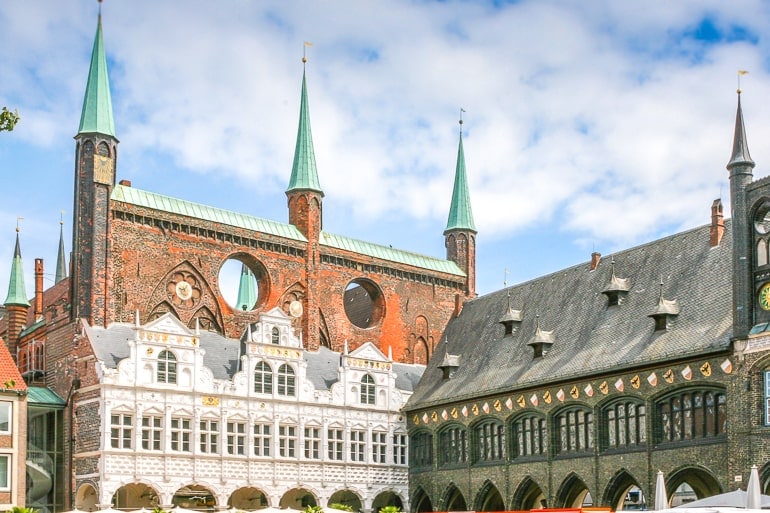
For the next couple of days, we decided to include some day trips from Hamburg. This allows you to stay in one accommodation for longer than just one night and gives you the option to see some more of Hamburg as well. If you don’t want to visit any other cities and want to spend more time in Hamburg instead, then feel free to skip one or both of the day trips mentioned.
Lübeck is the closer one of the two day trips mentioned from Hamburg. Within Germany the city is mainly known for its delicious “Lübecker Marzipan” (Lübeck Marzipan) – but of course there is much more to the city than just that. One of the highlights is the Holsentor, a red-brick city gate dating back to the 15th century.
The journey from Hamburg to Lübeck will take you slightly over 1 hr by car and just around 45 minutes by train . In our opinion, that’s great for a day trip since it gives you lots of time to actually see the city instead of spending a lot of time in the car/on the train.
Must-see Attractions in Lübeck:
- Marienkirche
- Heilig-Geist-Hospital
Day 8: Day Trip to Flensburg
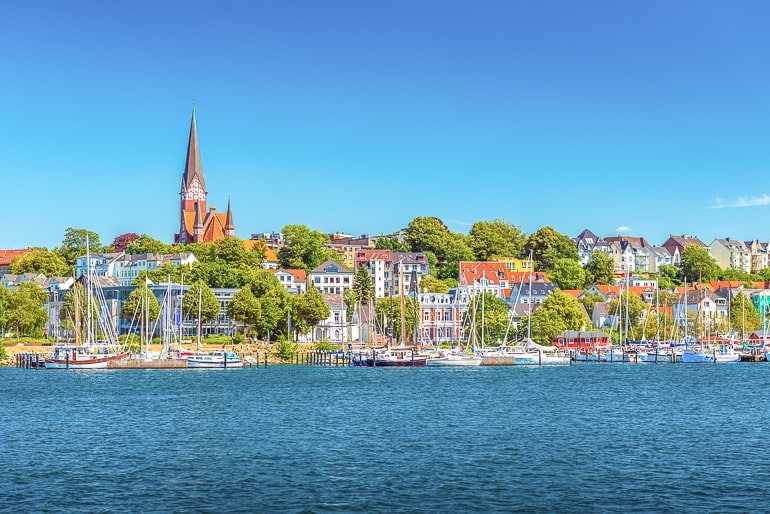
For the following day, we have another day trip option for you. The journey to Flensburg is slightly longer than to Lübeck – but it would be worth it. Flensburg is a smaller German city in the north of Germany, very close to the Danish border.
Since it is located close to the water, shipping plays an important role in the city to this day. If you’re interested in learning more about that, then the Maritime Museum would be a good place for you to visit.
Another thing we would recommend is a walk along the Rote Straße. Here you’ll find different “Hinterhöfe” (similar to backyards) with cute cafes and small shops.
Getting to Flensburg from Hamburg should take slightly less than 2 hrs by car and the same amount of time by train . As already mentioned, it would be a longer journey than to Lübeck, but if you want to experience a smaller, maritime city, the trip would be worth it!
Must-see Attractions in Flensburg:
- Historischer Hafen (Historic Harbour)
- Flensburger Schifffahrtmuseum (Maritime museum)
- Museumsberg Flensburg
Day 9+10: Berlin
On the second to last day of this itinerary, you’ll head from Hamburg to Berlin where your journey ends. This allows you to spend two days in the German capital. Since there is so much to do in Berlin, we’d recommend that you do some research beforehand to narrow down which attractions you’d like to visit.
If you’ve never been to Berlin before classics like the Brandeburg Gate and the Reichstag would be a good place to start. We’ve written a few different articles about Berlin – one about classic attractions (link below). Maybe these will be a good starting point to gather some more information!
The drive from Hamburg to Berlin will be one of the longest mentioned as part of this itinerary – so you should keep that in mind. It’ll take approximately 3 hrs 20 minutes by car (with traffic it could be longer), but just 1 hr 50 minutes by train .
It’s a popular train route since it connects the two biggest German cities so trains run frequently throughout the day. Once again, we’d recommend to book your train ticket in advance to get one of the discount tickets and save some money.
Accommodation in Berlin : As the capital city, there are lots of accommodation options for Berlin. You can check here for accommodations and hotels in Berlin .
Those travelling to Berlin with a car should look into the Park Plaza Wallstreet Berlin Mitte for a hotel in the city centre with free street parking available. There’s always paid parking for a reasonable fee if those are full and you’ll be close to top attractions.
The NH Collection Berlin Mitte am Checkpoint Charlie is a popular hotel option for those coming to Berlin by train since it’s close to attractions in the city centre and you can get there very easily with the metro.
Finally, if you need a hostel/hotel, check out PLUS Berlin . This is where Eric stayed a few years back and really enjoyed it. You’ll be close to the East Side Gallery – the part of the Berlin wall with the artwork on it. It’s also easy to get in and out of the city centre from here.
Also feel free to have a look at our guide on Berlin Attractions and tips for a day in Berlin .
Germany Itinerary 10 Days – South
This 10 day Germany itinerary begins and ends in Frankfurt – so it’s pretty much a small loop through the southern part of the country. If you want to be closer to the mountains (for part of the trip at least) instead of the sea, then this itinerary might be better suited for you than the other 10 day version.
For this itinerary, the total driving time would be slightly over 17 hours with a total distance of approx. 1330 kilometres. This includes the day trips to Neuschwanstein Castle, Garmisch-Partenkirchen, and Tübingen. So depending on if/how you modify the itinerary, these estimates could differ.
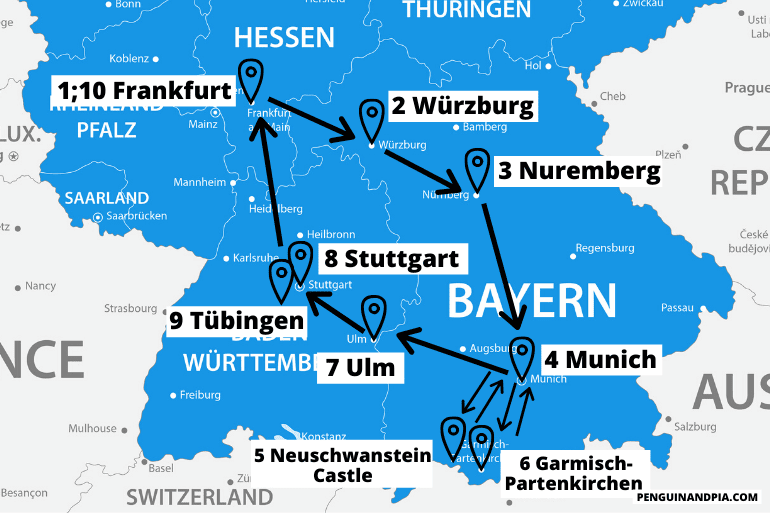
Day 1: Frankfurt Day 2: Würzburg Day 3: Nuremberg Day 4: Munich Day 5: Day Trip to Neuschwanstein Castle Day 6: Day Trip to Garmisch-Partenkirchen Day 7: Ulm Day 8: Stuttgart Day 9: Day Trip to Tübingen Day 10: Frankfurt
Similar to the northern version of this itinerary for 10 days, you begin your adventure in Frankfurt. During your day in the city, you shouldn’t forget to visit the Römerberg with the beautiful half-timbered houses. If you want to get a nice few of the city from above, then you should look into visiting the Main Tower as well.
Frankfurt is also a great place to pick up your rental car – if you decide to complete this itinerary by car instead of using public transport. You can either pick up a car at the airport or at different spots in the city centre. This obviously also depends on the rental company you choose.
Accommodation in Frankfurt: Frankfurt is full of accommodation options – from the city centre to the airport. You can check here for accommodations and hotels in Frankfurt .
For a hotel in the heart of the city, check out the Motel One Frankfurt-Römer . Complete with underground parking, good breakfast, and a top location in the centre and close to the river, this hotel is a decent option if you are travelling around with a car.
For those not travelling with a car (and taking the trains around Germany), check out Fleming’s Express Hotel Frankfurt . This nice looking hotel is really popular for its breakfast, price, and the fact that it’s steps from the central train station.
Day 2: Würzburg
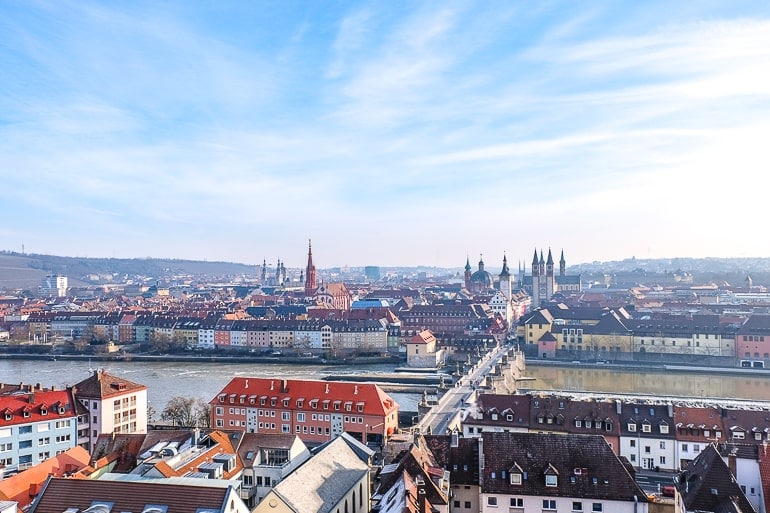
On day two of this itinerary, you’ll be on your way to Würzburg, a small German city that we’re always happy to return to. Similar to Stuttgart, Würzburg is located in a region that is known for its wine.
As such, it comes as no surprise that a highlight in Würzburg is to drink a glass of (white) wine on the Old Bridge across the Main river. We’ve done that multiple times and would especially recommend it during the evening when it gets dark.
Another thing you shouldn’t miss in Würzburg is the short walk up the hill to Marienberg Fortress. Up there you can not only explore the old fortress, but you also get a beautiful view of the old town and other parts of the city.
We actually wrote a whole guide about Würzburg (link below) where we not only talk about things to do but also mention some great cafes and restaurants!
The drive from Frankfurt to Würzburg will be a short one. It should only take you around 1 h 20 minutes by car and between 1 h 07 minutes and 1 hr 50 minutes by train depending on the type of train you’re taking (ICE vs. regional train).
Accommodation in Würzburg: Würzburg isn’t a huge city so you’ll find a number of places to stay packed together in the city centre and a number of other hotels and guesthouses around. You can check here for accommodations and hotels in Würzburg .
On a recent trip, we stayed at the Best Western Hotel Würzburg-Süd . It’s a little south of the city centre but the tram stop is right outside the hotel so you’re into the historic city centre in minutes. There is also an onsite parking lot if you’re arriving to Würzburg by car. We booked this one last minute but we would stay again.
If you want to stay a little more central, then you can check out Hotel Strauss . With a location close to the river, the train station, and the city centre – it’s a great option fo those arriving by train.
We also once stayed at Hostel Babelfish for a budget accommodation and it was honestly not too bad, either. It’s right across from the train station for easy access in and out of the city.
Must-see Attractions in Würzburg:
- Marienberg Fortress
- Würzburg Residence
If you want more tips for visiting Würzburg, have a look at our detailed Things to do in Würzburg Guide (+ insider tips) .
The next day you’ll be on your way to Nuremberg, which is another city in Bavaria that we really like. In German, Nuremberg is actually written/called “Nürnberg” – just an FYI, so you’re not confused when you see this written somewhere.
As we have already mentioned in the description of one of the shorter itineraries, there is a lot of history to be found in the city. Not only can you explore an old castle in the middle of the city, you can also learn a lot about Germany’s dark history if you’re interested.
Getting from Würzburg to Nuremberg will take approx. 1 hr 20 minutes by car and between 53 minutes (ICE) and 1 hr 13 minutes (regional) by train . If you’re travelling with more people and decide to just take a regional train, look into getting a “Bayernticket” as that could save you some money.
Accommodation in Nuremberg : Nuremberg is a larger and well-travelled city in Germany so you will have no problem finding a place to stay! You can check here for accommodations and hotels in Nuremberg .
We ended up staying in the very popular Five Reasons Hotel and Hostel and we enjoyed our stay. The room was bright with new furnishings. It’s also located just inside the old city walls so we were close to the metro, a short walk to central train station, and also close to the heart of the old town!
Very nearby was the Sheraton Carlton Nuremberg – we had friends stay there. They really liked this hotel which had a swimming pool with city views and other great perks. If you are arriving to Nuremberg by car, there’s a parking lot across the street from the hotel as well as street parking around. The train station is very close as well so it’s a great location overall.
- Documentation Center Nazi Party Rally Grounds
Day 4: Munich
On day four of this Germany trip, you’ll be on your way to Munich. As you might know Munich is the capital of the German state called Bavaria and there are lots of things to do in this city.
That’s why you’ll spend three nights in Munich. This way you can explore the city in more detail if you want or go on a couple of day trips from Munich to see other popular attractions as well. It’s really up to you.
The journey from Nuremberg to Munich won’t be overly long and it’s a route Lisa has driven many times. It’ll take you around 2 hrs by car (of course traffic depending) and between 1-3 hrs by train.
Since this is a popular train route, there are lots of different connections of varying length – some are quick and others are slower trains with more stops. Since that’s the case, we’d recommend that you plan in advance and try to catch a better connection to avoid an unnecessarily long train ride!
Accommodation in Munich: Since Munich is such a popular and large city, there are plenty of accommodation options for you to choose from. You can check here for accommodations and hotels in Munich . Just remember to book your accommodation for three nights if you are following this itinerary!
We stayed at the H2 Hotel München Olympiapark which is a very popular hotel because of the price and the value. It was a prefect stay. The breakfast was amazing, they had parking, and the location was great – only a quick metro to the heart of the city centre. You also have the Olympic Park and BMW Museum as top attractions nearby!
If you’re itching to stay right in the heart of the action in Munich, check out the Platzl Hotel Superior . This is a hotel around the corner from Marienplatz in the old town with the famous beer hall Hofbräuhaus just steps away. The central train station is also walkable from here.
Of course, you can learn all about the best areas to stay in more detail with our Munich accommodation and neighbourhood guide .
Learn more about Munich with our one day in Munich post!
Day 5: Day Trip to Neuschwanstein Castle
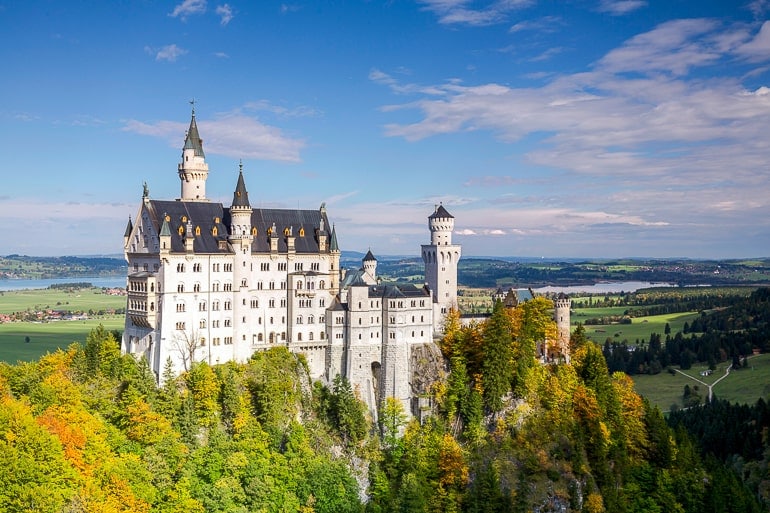
Neuschwanstein Castle probably doesn’t need a lot of introduction – it is arguably one of the most popular day trips from Munich. If you want to see this fairy-tale castle with your own eyes, then this day trip might be for you.
However, it is such a popular attraction that depending on the time of year it can get incredibly crowded. So if you are planning this itinerary for the middle of summer, we’d honestly recommend that you think twice about whether you really want to do this day trip. A second day in Munich wouldn’t be so bad either, would it?
If you are set on visiting Neuschwanstein Castle, then have a look at our Day Trips from Munich Guide . In that article – under the Neuschwanstein Castle section – we talk about all the different ways you can get to the castle.
In case you don’t want to stress too much about logistics and are not travelling with a rental car, you could always look into a day tour that brings you to Neuschwanstein Castle and then back to Munich. Here are some examples:
- Neuschwanstein and Linderhof Palace – A very popular tour to check out two castles in one day!
- Just Neuschwanstein Castle – Grab your live guide and check out the classic castle you came to see!
- Neuschwanstein Castle and Füssen – Explore the surrounding area on this day trip + see that great castle!
Day 6: Day Trip to Garmisch-Partenkirchen
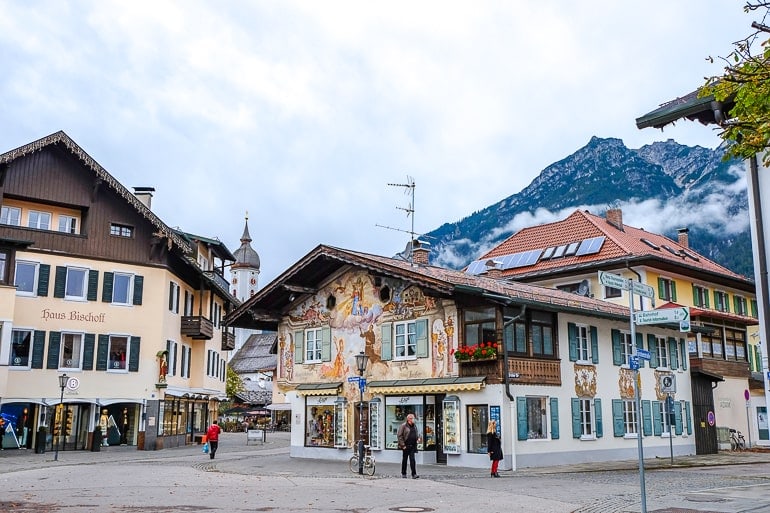
Another popular day trip from Munich – and the one we would recommend for Day 6 of this itinerary – is a trip to Garmisch-Partenkirchen in the south of Bavaria, close to the Austrian border.
We have been to Garmisch-Partenkirchen recently and really enjoyed our day there. However, that was during the shoulder season, so we can’t really say much about how busy it gets in the summer or during the ski-season.
There are a few good reasons for visiting Garmisch-Partenkirchen. The obvious one is that the town is super close to the mountains and it is very easy to reach the “Zugspitze” (Germany’s highest mountain) from here.
Of course, you don’t have to go that high up – there are also lots of other mountains and great hiking trails in the area if you’re looking for a day in nature.
Other reasons why people come to Garmisch-Partenkirchen is to visit the Partnach Gorge which is quite beautiful and/or the old town where you can admire the decorative paintings found on many houses.
It’s actually quite easy to get from Munich to Garmisch-Partenkirchen. By car , it should take you around 1 hr 10 minutes and by train the journey would be approx. 1 hr 22 minutes . It’s actually a nice drive/train ride since you’ll get some great views of the mountains as you get closer to your destination.
Must-see Attractions in/close to Garmisch-Partenkirchen:
- Partnach Gorge
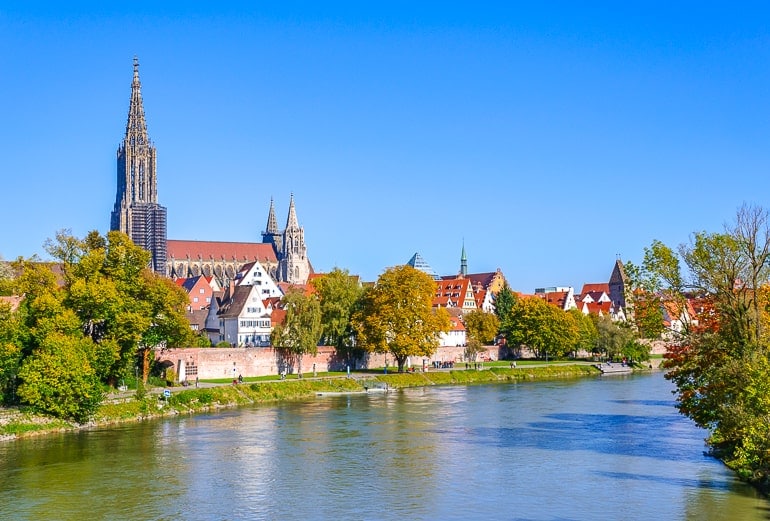
The following day you’ll travel from Munich to Ulm, a small city in the German state of Baden-Württemberg. It is actually located right by the border with Bavaria – “Neu Ulm” in fact is a city on the Bavarian side. When you’re there, it sometimes feels like it is just one bigger city. For you as a visitor, this doesn’t really matter – just an interesting side note.
Ulm is mainly known for having the church with the tallest steeple in the world – so that is something you shouldn’t miss during your visit. Other than that, we’d also recommend that you check out the Fishermen’s Quarter where you can find some beautiful, half-timbered houses.
Getting from Munich to Ulm won’t take you long. The journey will take approx. 1 hr 40 minutes by car and between 1 hr 19 minutes and 2 hrs by train. Once again, this depends on which type of train connection you choose (ICE vs. regional trains).
Accommodation in Ulm: It’s best to stay in the centre of Ulm since it’s not huge and the attractions can mostly be found there. You can check here for accommodations and hotels in Ulm .
For a boutique hotel option right in the city centre, check out Boutique 005 Ulm City . This hotel is super walkable to the train station if you are arriving by train but also offers an option for parking. It’s location makes it really close to all the top attractions in the city.
For a stay closer to the river, you can check out the Hotel am Rathaus – Hotel Reblaus . With onsite parking available and a really good breakfast, this more “authentic” hotel is an experience not to be missed in Ulm.
Must-see Attractions in Ulm:
- Ulmer Münster
- Fishermen’s Quarter
Day 8: Stuttgart
From Ulm, you’ll head to Stuttgart on the next day. Stuttgart is a city that we have mentioned a few times in this article already. If you’ve read some of the other itineraries, you’ll know that Stuttgart is known for both cars and wine.
Of course, there’s more to see in the city than that. If you’re interested in architecture, you might enjoy visiting the New Palace at the “Schlossplatz” and if you’re into art, the Staatsgalerie (an art museum) might be for you.
Getting to Stuttgart from Ulm will only take slightly over 1 hr by car and approx. the same amount of time by train . There are slower trains – called RB instead of RE which stands for “Regional Express” – that take longer than that. However, if you plan ahead, you shouldn’t have a problem catching an RE or ICE Train since they run frequently throughout the day.
Accommodation in Stuttgart: Since there are a number of places to stay in, you can check here for accommodations and hotels in Stuttgart .
Those with a car can check out the Abalon Hotel ideal because it has an underground parking garage while those travelling to Stuttgart by train can check out the Pension am Heusteig since it’s easy to get to walking or with the metro.
Day 9: Day Trip to Tübingen
On day 9 of this itinerary, you have the choice between either spending a second day in Stuttgart or taking a day trip to Tübingen, a university town not far away.
Tübingen is a popular day trip from Stuttgart and is mainly known across the country for its old university. In fact, some of Lisa’s friends have studied there. When in town, you shouldn’t forget to visit the market square with its 15th century town hall. Another popular attractions is the Hohentübingen Castle on the hill which nowadays is home to a museum.
It won’t take you long at all to get to Tübingen from Stuttgart. That makes it great for a (half-)day trip. The journey should only take around 42 minutes by car and between 43 minutes and 1 hr 30 minutes by public transport – depending on the connection you choose.
Must-see Attractions in Tübingen:
- Hohentübingen Castle
- Market Square with Town Hall
- Hölderlinturm
Day 10: Frankfurt
On the last day, you’ll make your way back to Frankfurt. This is where your itinerary ends since it will hopefully be easy for you to get back home from here.
The journey from Stuttgart back to Frankfurt will probably be the longest one for this trip – but it’s still easily doable. It should take you approx. 2 hrs 25 minutes by car and between 1 hr 17 minutes and 3 hrs 30 minutes by train. Once again, this is dependent on the connection you choose (ICE vs. regional trains).
Accommodation in Frankfurt: Since you’re back in Frankfurt, we already went over accommodations in Day 1 of this same itinerary. That said, you can check here for accommodations and hotels in Frankfurt and specifically check out the Motel One Frankfurt-Römer for a central hotel with parking.
Germany Itinerary 14 Days
This Germany itinerary is the longest one that we have for you – for now. If anyone is interested in a 21 day version, please let us know!
The distance you’d cover with this 14 day itinerary would be around 1960 kilometres . The driving time would be approx. 22.5 hours – but of course, this varies depending on traffic and the exact route you decide to take.
As you’ll see below, sometimes the driving time between two cities is longer than 3 hours. So, while this itinerary is totally doable in two weeks – if you wanted to slow down the pace a bit, you could just as easily spend more time in some of the cities and complete the itinerary in more days.
Since you have probably already read about most of these places in some of the itineraries above, we’ll try to keep the descriptions short and not get too repetitive.
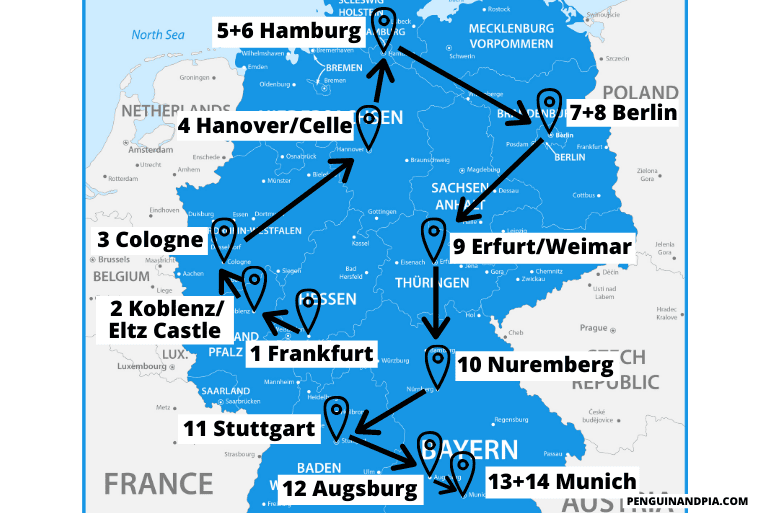
Our version here is written as an “incomplete route” from Frankfurt to Munich. However, as with most of our itineraries, you are welcome to reverse the direction if that works better for you and/or start and end in the same city. So, to see a big part of the country, your 14 day Germany itinerary could look something like this:
Day 1: Frankfurt Day 2: Koblenz / Eltz Castle Day 3: Cologne Day 4: Hanover or Celle Day 5+6: Hamburg Day 7+8: Berlin Day 9: Erfurt or Weimar Day 10: Nuremberg Day 11: Stuttgart Day 12: Augsburg Day 13+14: Munich
Once again we begin this itinerary in Frankfurt since it is an easy city to get to. As we have mentioned before, there are a few things to see in the city so you can start exploring on day one!
Frankfurt is also a great city to pick up a rental car. Since many international (business) travellers fly into Frankfurt, there should be many cars available with automatic transmissions. In smaller German towns you’ll find that this is not always the case.
Accommodation in Frankfurt: If you are making a stop in Frankfurt, you can check here for accommodations and hotels in Frankfurt .
As for accommodation options, the Motel One Frankfurt-Römer has parking available and is located in the city centre close to the Main River. That’s important if you have a car with you but it’s also walkable to the train station, so you know.
Another great hotel option that is even closer to the train station is Fleming’s Express Hotel Frankfurt . This hotel is known for its prime location to the north of the station, its tasty breakfast, nice decor, and fair price. This is definitely a popular place you should at least look into if you are travelling by train around Germany.

Day 2: Koblenz / Eltz Castle
On day two of this itinerary, you’ll be on your way to Koblenz, a small German city on the Rhine river. You can either explore the city or use it as a base to visit one of the many castles close by.
Our suggestion would be a visit to Eltz Castle which is a beautiful medieval castle surrounded by a forest. Please keep in mind that the castle is not open year round. You can check opening hours here .
You could also visit Eltz Castle as a day trip from Frankfurt but then you’d have to return to Frankfurt at the end of the day. This wouldn’t make much sense unless you want to spend some more time in Frankfurt anyway, as Cologne (your next destination) is closer to Koblenz and Eltz Castle than Frankfurt.
The drive from Frankfurt to Koblenz should take around 1 hr 30 minutes by car . If you want to take the train , the journey would take between 1 hr 30 minutes and 2 hrs 15 minutes . From Koblenz, it is only about a 30 minute drive to Eltz Castle.
Accommodation in Koblenz: Since Koblenz isn’t that large, you should have no problem finding and choosing an accommodation that works for you. You can check here for accommodations and hotels in Koblenz .
If you want a popular option right in the heart of the city centre, you should see the Sander Hotel . This hotel is located within walking distance to the rivers as well as restaurants and shops in the centre. If you travel by car to Koblenz, they have onsite parking which is handy. That said, you can also easily walk from the hotel to the train station in minutes.
Day 3: Cologne
The next stop on your 14 day Germany itinerary is Cologne, a city we have mentioned already in some of the previous itineraries. As you might know, the highlight of the city is the Cologne cathedral which is quite an impressive sight. As the city is located on the Rhine river, a boat tour might also be a great activity depending on the time of year you are visiting.
Getting to Cologne from Koblenz takes around 1 hr 15 minutes by car and between 50 minutes and 1 hr 15 minutes by train . The train tracks follow the Rhine river for part of the journey which allows for some beautiful views!
Accommodation in Cologne : There are lots of great places to stay in Cologne. You can check here for accommodations and hotels in Cologne .
We recently stayed at the Lindner Hotel City Plaza which was great value for money. The breakfast buffet is incredible and it’s an easy, short walk into the city centre near the Cathedral. It also has parking available for those with a car.
If you want to stay a little closer to the river and the Old Town, check out the CityClass Hotel Residence am Dom . With many things around to keep you busy – like attractions, food, and/or drinks – you’re just a short walk to the central train station if you stay here.
For those looking for a hostel, Cologne Downtown Hostel was a great stay for Eric a number of years ago. It’s really popular, in a great location, and has a nice rooftop balcony to enjoy.
Day 4: Hanover or Celle
Day 4 of this itinerary will take you to either Hanover or Celle depending on your preference. Celle is a noticeably smaller city/town than Hanover and the two places are only a few minutes apart.
Getting from Cologne to Hanover will take approximately 3 hrs 10 minutes by car and between 2 hrs 40 minutes and 3 hrs 5 minutes by train .
Accommodation in Hanover: Since Hanover is a well-travelled city for people moving around Germany, there are a number of accommodation options in and around the city centre. You can check here for accommodations and hotels in Hanover .
To stay very close to the central train station in the city centre, you should see the Hotel Loccumer Hof . The location makes it great if you are travelling by train and on foot. They also have onsite parking if you are arriving to Hanover with a car!
To the south of this hotel, the Arthotel ANA Prestige am neuen Rathaus is an option right across from the New Town Hall. This hotel has a beautiful, light style and is also close to the water/parks. Complete with breakfast and onsite parking, you can’t go wrong here!
If you want to spend a night in a smaller German city instead, then Celle is a good option as it is not far from Hanover. That will make it easy to reach the next stop on your itinerary without too much of a detour. The journey from Cologne to Celle would be slightly longer and take around 3 hrs 30 minutes by car and 3 hrs 19 minutes by train .
Accommodation in Celle: Celle isn’t that big at all – so there are only a handful of places to stay. That said, there are still some great options. You can check here for accommodations and hotels in Celle .
Of note, check out Hotel Borchers . This hotel – one of only a handful located in the heart of “city centre” is a top pick with a tasty breakfast and an underground car park. You can also walk there from the Celle train station which is located not too far across town.
Must-see Attractions in Celle:
- Celle Castle
- Bomann Museum
- French Garden
Day 5+6: Hamburg
An itinerary across a large part of the country wouldn’t really feel complete without including Hamburg. Since there is quite a bit to see in this hanseatic city, you’ll spend two nights in the city to give you more time to explore.
Getting from Hanover to Hamburg will take you approx. 1 hr 45 minutes by car and between 1 hr 15 minutes and 2 hrs 30 minutes by train . As mentioned before, this varies depending on the type of train connection you choose.
The journey from Celle to Hamburg will be approximately 15 minutes shorter at 1 hr 30 minutes by car . If you opt for the train, you can expect travel times between 1 hr 10 minutes and 2 hrs .
Accommodation in Hamburg : Since Hamburg is a well-travelled city, it makes sense that there are loads of places and areas to stay in. You can check here for accommodations and hotels in Hamburg .
The Mövenpick Hotel Hamburg might work for those with a car since they have onsite parking. This old water tower is a different hotel than you might be used to but it’s a great experience overall.
Something closer to the central station to get to on foot would be the ARCOTEL Rubin Hamburg which is located in St. Georg. This is an area with shops and restaurants and is very much part of the city centre.
Those looking for a budget accommodation can check out Generator Hamburg which is a popular hostel close to the train station. If you’re ever unsure or want more advice, we have a detailed guide on where to stay in Hamburg .
Day 7+8: Berlin
Of course, we couldn’t forget to include a stop in the capital of the country when planning a longer trip through Germany. Since there is so much to do and see in Berlin you will spend two nights there.
This will also give you some more time to recover from all the driving you have done so far on this journey. Getting from Hamburg to Berlin takes approximately 3 hrs 20 minutes by car (obviously traffic depending) and just about 1 hr 50 minutes by train .
Accommodation in Berlin : There are lots of hotel options in Berlin. You can check here for accommodations and hotels in Berlin .
The Park Plaza Wallstreet Berlin Mitte is a good option in the city centre for those coming to Berlin with a car while the NH Collection Berlin Mitte am Checkpoint Charlie is located right at the attraction “Checkpoint Charlie” in the city centre.
A great option for a hostel/hotel where Eric stayed a few years back is PLUS Berlin . You can find it near the famous East Side Gallery which is a very popular attraction to check out.
As mentioned a few times now, we also have more articles on t hings to see in Berlin and a one day Berlin itinerary .
Day 9: Erfurt or Weimar
For the following day you have the choice between Erfurt or Weimar as your next destination. Both are small cities in the state of Thuringia with Weimar being smaller than Erfurt. If you know anything about Martin Luther, an important figure in the Protestant reformation, then you might have heard of one or both of these places before.
If you’re looking for a place with a beautiful old town and some nice churches as well as buildings for you to explore, then we’d really recommend Erfurt. We had a great time during the days we spent there. The city also has some really nice, cozy cafes if that is something that you care about.
Getting to Erfurt from Berlin will take a while – but it is a great stop on the way to the south of Germany. You can expect the journey to take approx. 3 hrs 40 minutes by car and just around 1 hr 50 minutes by ICE (fast train) .
Accommodation in Erfurt: With Erfurt being a smaller city with a smaller central area to explore, finding a place to stay isn’t too difficult. You can check here for hotels and accommodations in Erfurt .
When we visited Erfurt, we booked the Gästehaus in der Gotthardtstraße . This was a simple guesthouse with a nice host and cozy rooms located just a short walk north of the Krämerbrücke. There’s also a small parking lot onsite if you’re coming to Erfurt with a car.
For a stay that is more central, check out Hotel Krämerbrücke Erfurt . It’s located basically right beside the Krämerbrücke making it a great option if you are travelling by train and you’re on foot.
Once again, if you want to learn some more about Erfurt before you visit the city, check out our detailed Erfurt Guide here .
If you instead preferred to learn some more about the well-known German writers Goethe and Schiller – or about Germany’s dark past – then you should plan to visit Weimar instead.
Two of the highlights there are Goethe’s and Schiller’s House – now turned into museums. Close to Weimar there’s also the Buchenwald Memorial which was a former Nazi concentration camp. This was the first KZ-Memorial Lisa ever visited. It was a somber experience, but also an important one in regards to understanding more about Germany’s past.
The journey from Berlin to Weimar will be slightly shorter than to Erfurt – at least by car. It’ll take approx. 3 hrs 15 minutes by car and around 2 hrs 20 minutes by train .
Accommodation in Weimar : There are a handful of places to stay in Weimar since it’s a smaller city – but you still have good options. You can check here for accommodations in Weimar .
In particular, check out Amalienhof Hotel und Apartment . This classic and very popular hotel is just south of the heart of the city centre. It features parking onsite and an excellent breakfast. It’s also not too far to walk to the train station if you are arriving on foot.
Must-see Attractions in/close to Weimar:
- Buchenwald Memorial
- Goethe’s House
- Schiller’s House
Day 10: Nuremberg
On day 10 of your itinerary, you’ll drive – or take the train – from Erfurt/Weimar to Nuremberg. This Franconian city has also been mentioned in some of the shorter itineraries.
The journey from Erfurt to Nuremberg will take approx. 2 hrs 40 minutes by car in a southern direction. The drive from Weimar to Nuremberg will just be a couple minutes longer.
If you decide to take the train, the journey would take between 1.5 hrs and 2 hrs from Weimar and between 1 hr 10 minutes and 1 hr 30 minutes from Erfurt .
Accommodation in Nuremberg : Nuremberg is a city with loads of history and attractions so it’s very popular. As such, you will find hotels and accommodations all over the city – from the old town to the surrounding areas. You can check here for accommodations and hotels in Nuremberg .
We booked a stay at Five Reasons Hotel and Hostel and we would recommend it. You can find the place inside the massive old city walls so the location was great – walkable to the central train station and also to go find top attractions.
On the same trip, friends of our stayed at the Sheraton Carlton Nuremberg . It was close to where we stayed and they really enjoyed it. There’s this great pool on an upper floor with city views as well as a parking lot across the street if you travel to Nuremberg by car. The train station is close as is the old town by walking so it’s great option overall, too.
Day 11: Stuttgart
The following day you will be on your way from Nuremberg to Stuttgart – once again, a city we have mentioned multiple times now during this article. From Nuremberg, it’ll take you around 2 hrs 15 minutes by car and between 2 hrs 10 minutes and 2 hrs 30 minutes by train to get to Stuttgart.
As we’ve mentioned before, if you are driving and have the time, you could take a small detour and stop in Rothenburg ob der Tauber for a stroll through its beautiful old town. We’ll leave that up to you!
Accommodation in Stuttgart: You can check here for accommodations and hotels in Stuttgart .
The Abalon Hotel ideal has parking for those with a car while the Pension am Heusteig is a guesthouse close by but is easy to get to by the metro system if you arrive by train to central station and you are walking.
Day 12: Augsburg
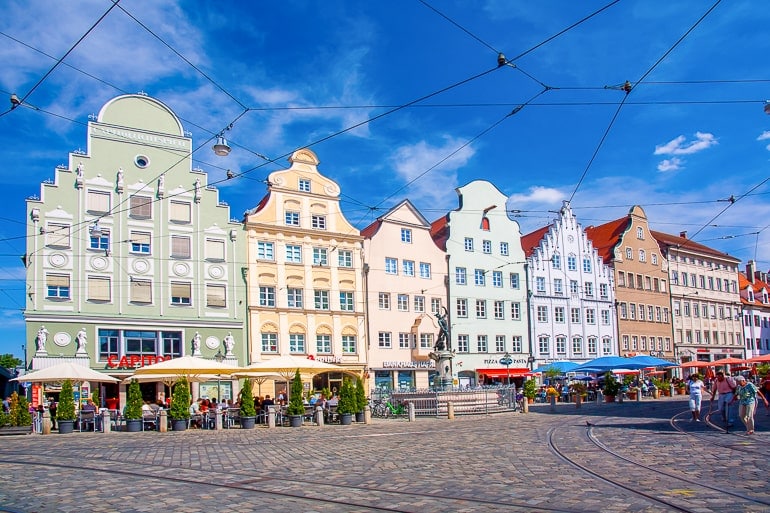
On day 12 you’ll be on your way from Stuttgart to Augsburg, a small city in Bavaria and one of Germany’s oldest cities. Around Germany, most people have heard of Augsburg because of its “Fuggerei” – a historic social housing complex where rent has increased very slowly over the centuries. It’s certainly worth a visit!
It’ll take you around 2 hrs by car to get from Stuttgart to Augsburg. If you opt for the train , then you can expect the journey to take approx. 1 hr 40 minutes .
Accommodation in Augsburg: In Augsburg, you will find a number of places to stay around the city centre. You can check here for accommodations and hotels in Augsburg .
For a reliable stay, check out Hotel Augusta . This popular hotel – located right in the city centre – features breakfast and has parking available if you are travelling to Augsburg by car.
The nice thing about Augsburg is that because it’s a smaller city, you can easily walk to the hotel from the train station if you are arriving by train.
You might also check out City Hotel Ost am Kö which is another hotel in the heart of the centre walkable to the station. It also has breakfast and parking garage right nearby.
Must-see Attractions in Augsburg:
- Augsburg Cathedral
- Perlach Tower
Day 13+14: Munich
On your second to last day of this itinerary you will drive from Augsburg to Munich. That’s the last stop on your two week Germany adventure. In Munich, there is more than enough to see to spend two days in the city.
Munich also has an airport with good international connections in case you’re coming from overseas and need to take a plane to get back home. If that’s not the case, we’d encourage you to see whether the train would be an alternative to get you back home as well.
The journey from Augsburg to Munich should take just less than 1 hr by car and between 30 and 48 minutes by train. So it’s certainly one of the shortest transitions mentioned in this article.
Accommodation in Munich: If you’re exploring Munich while in Germany, there is no shortage of places to stay and areas to check out. You can check here for accommodations and hotels in Munich . For this itinerary, remember to book your Munich accommodation for two nights.
We really liked our stay at the H2 Hotel München Olympiapark . From the really good breakfast, nice rooms, and excellent location with metro access nearby – you cannot beat the price for Munich. There’s also parking available if you’re travelling with a car to Munich.
For a spot right in the heart of Munich’s charming old town, check out the Platzl Hotel Superior . This is a trendy hotel that puts you super close to all the action at busy Marienplatz and is steps from Hofbräuhaus, the beer hall made famous decades ago. You can also catch the metro or walk to the central train station from here.
If you are looking for more details on accommodations in this city, we wrote a detailed guide on where to stay in Munich .
To learn more about the city – as we have mentioned before – check out our post on Munich in a day if you want more details about the city!
And there you have it – one massive Germany guide with more than one Germany itinerary to suit your travel needs! Whether you’re looking for a short 5 day or a wild 14 day itinerary – we’re sure you’ll have a great time exploring Germany. We’re actually really happy to have created this post – Lisa especially. It’s always fun to help others explore your home country!
As always, Happy Germany Itinerary Waddlin’, – L&E
- Compare flights on Skyscanner
- Check for Hotel Deals or Book A Hostel
- Get A Rental Car (depending on the destination)
- Research plug types and possibly get a travel adapter
- Go over our packing list
Pin it for later!
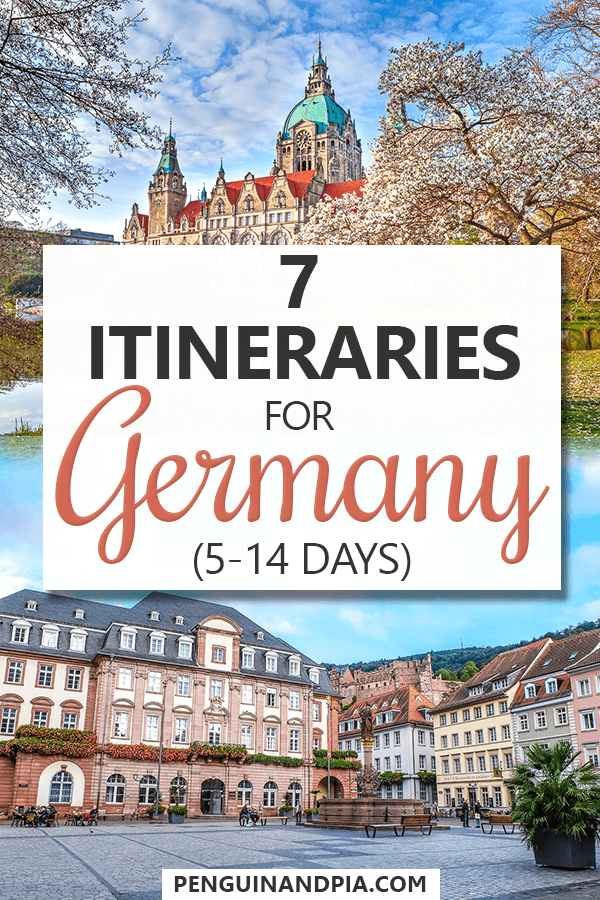
As an Amazon Associate we earn from qualifying purchases.
Destinations
Privacy policy
Disclaimer & Affiliate Disclosure
Terms of use
© 2024 Creativlier Media Inc.
Destinations | EUROPE
7 day road trip in germany visiting cities, castles & more.
17 Aug 2021 | Destinations , Europe , Germany
Looking for an epic road trip in Germany? You will love our suggestions. Living in Belgium I have so many German attractions that I want to visit, and what better way to explore than a road trip.
Keep reading as I take you to many small towns, cities, and castles in this Germany road trip itinerary that will take your breath away!
** Disclaimer: This post contains affiliated links which means that purchases made through these links reward Bey of Travel a small commission without any additional charge for the purchaser.**
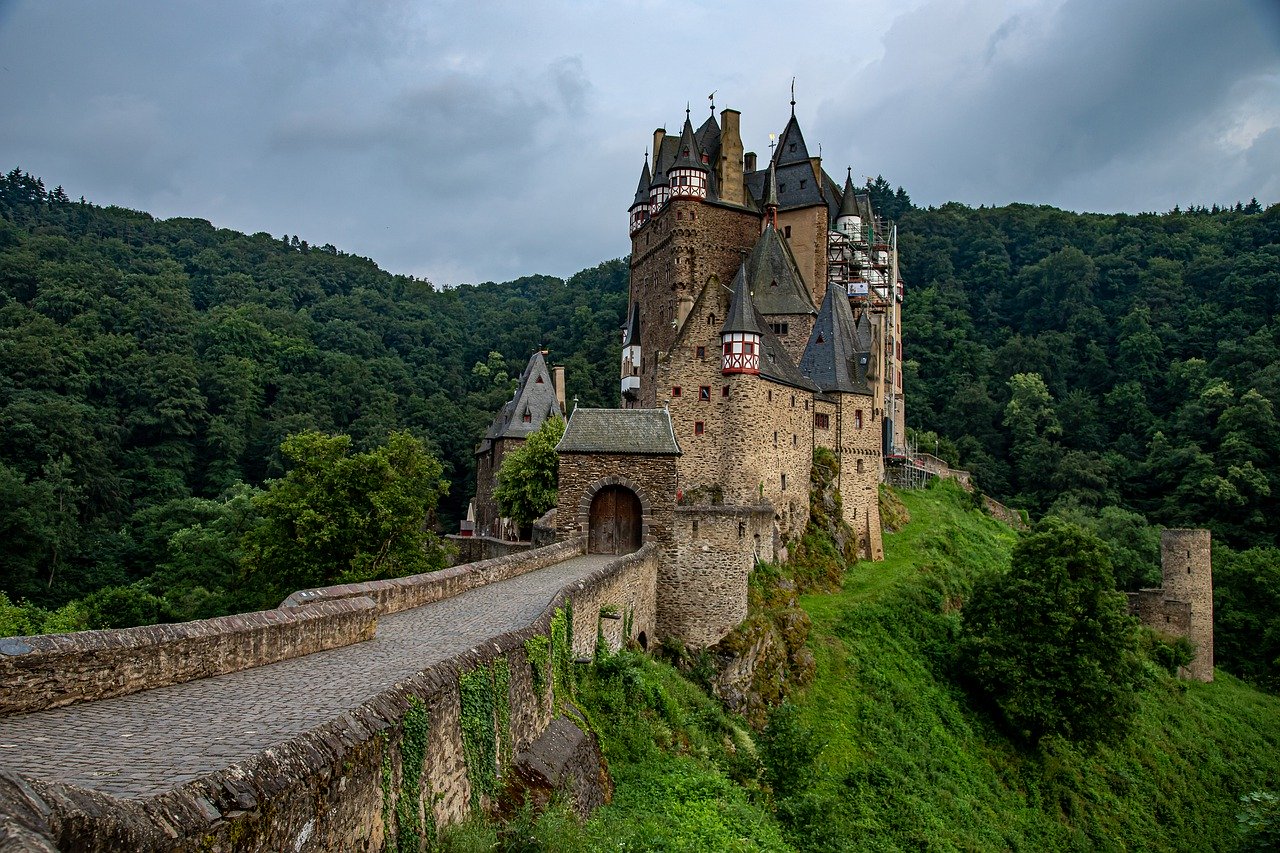
Day 3 of Germany road trip: Romantic road and Neuschwanstein Castle
Driving Time: Munich to Neuschwanstein Castle is 1.50 hours, one way.
On day 3, start for the iconic Neuschwanstein Castle in Fussen via the Romantic Road in Bavaria.
The scenic Romantic Road takes you through some of the picturesque valleys in Germany, and it is filled with star-studded castles, small towns, and beautiful landscapes. The road passes through medieval towns like Rothenburg ob der Tauber, Dinkelsbühl, Nördlingen, and Füssen, and with stops it can easily take 2-3 days.
For a day’s road trip, focus on the castle built by the “mad” King Ludwig II, known as Neuschwanstein. The castle is incomplete but is a beautiful attraction near Munich. Spend some time at the complex, enjoy short hikes, and admire the views from the hilltop.
The complex area is a busy tourist spot, so plan to arrive early. Do check out Mary’s bridge, and the yellow-colored (smaller) castle of Hohenschwangau, which was Ludwig II’s childhood summer home.
There are entry fees for Neuschwanstein Castle, and you can only tour the interiors with a guide.
Tips for visiting the castle
Getting there: You can also visit Neuschwanstein Castle via a tour and public transportation. When driving to the castle grounds, note that parking at the castle is not allowed.
You can park at the village of Hohenschwangau (parking spots P1 to P4). Enter the ‘Alpseestrasse’ and follow the signs for the parking lot.
Address: Neuschwansteinstraße 20, 87645 Schwangau, Germany
Entry fee and opening info: 13 euro.
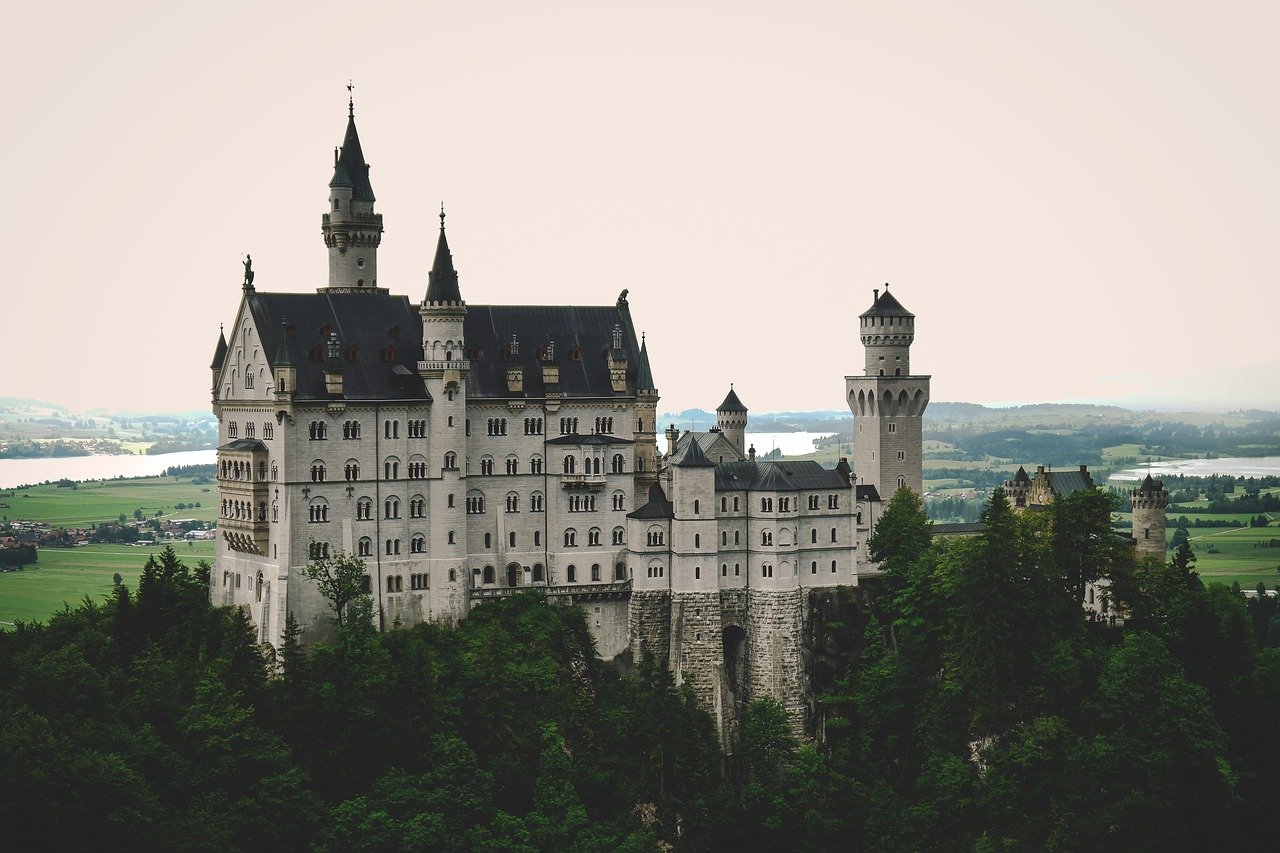
Read next | Berlin travel guide
Day 4 of road trip in germany: exploring the castle of burg eltz .
Driving Time: Munich to Burg Eltz Castle is 5.50 hours, one way.
The next day get ready for another castle – Burg Eltz. This is one of the most beautiful places to visit in the whole country.
Burg Eltz is a beautiful German castle that lies merely 3.5 hours away from my hometown of Antwerp, and it’s been on my to-do list for years. When traveling from Munich, it will take you about 5+ hours.
It is one of the best castles in Germany to visit – and it’s probably one of the most beautiful castles in Europe.
This castle is one of the most Instagram-able places in Germany, and it can be crowded with ‘grammars’ all day around.
Did you also know that the castle is still inhabited to this day? It is owned by the Eltz family, and the current owner of the castle is Dr. Karl Graf von und zu Eltz-Kempenich .
Getting there : Burg Eltz lies in the Eltzerbos and can be easily reached by car. You can park at the Ausweich-Parkplatz Burg Eltz for €2.
From here, the castle is a ten-minute walk down asphalt roads. You can also hike through the beautiful scenery in the Eltze Bos, which takes a little longer but is a stunning alternative.
There are a variety of beautiful long hikes that lead to the fairytale castle – more info can be found here.
Address: Kastellanei Burg Eltz, Burg Eltz 1, 56294 Wierschem, Deutschland
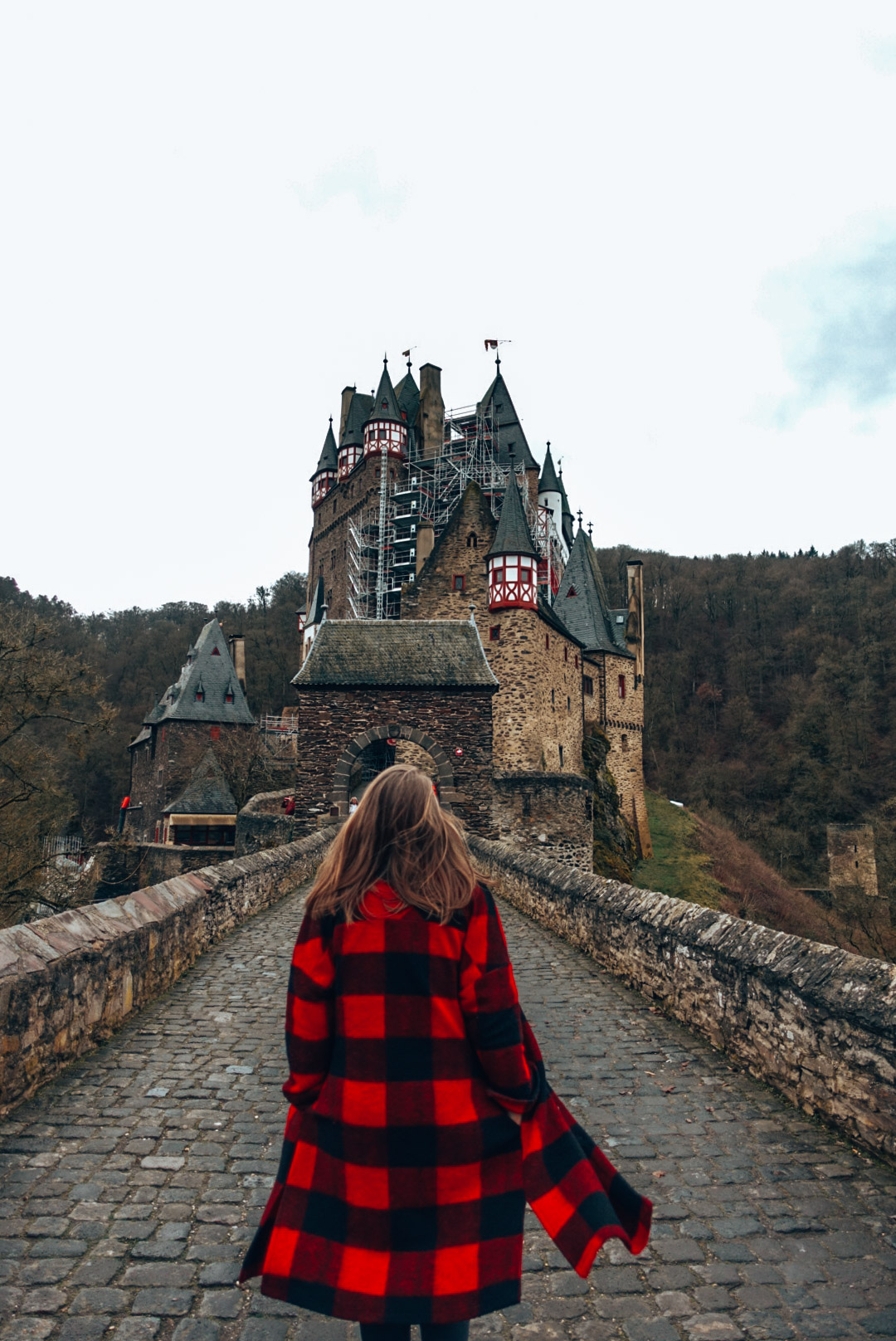
Day 7 of Germany road trip itinerary: Visit Schloss Dragenburg in Königswinter and then fly out
We decided to end our Germany road trip with a visit to another fairytale castle. And this time head to the dragon castle, Schloss Dragenburg, in Königswinter.
Schloss Drachenburg or Drachenburg Castle is a private villa, constructed by Stehan Sarter who built the castle in 1882 but never lived in it himself. His nephew Jakob Biesenbach then bought the castle years later from the state.
It is positioned in a beautiful natural setting where you can enjoy a nice walk.
Schloss Drachenburg is the closest of the castles around Cologne Germany, and from here you can head back to Belgium, or fly out from Cologne.
Tips and practical information
Address : Drachenfelsstraße 118, 53639 Königswinter, Germany. There is paid parking available near the castle.
Entry fee and opening info : You can find the opening hours online . The entrance fee is 7 euros for an adult and tickets can be purchased online or on the spot.
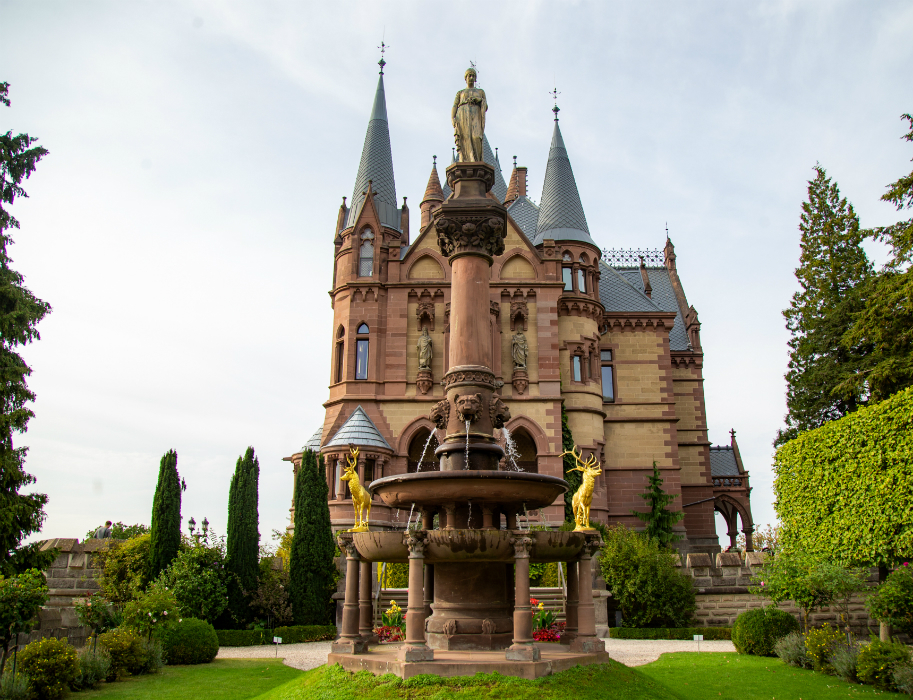
Other places to add to your Germany road trip itinerary
I have listed some of the other road trips Germany stops that you can swap or add to this itinerary
Munich to Wurzburg : If you do not wish to visit many castles on this road trip then swap one day, and assign that to Wurzburg (Munich to Wurzburg is 4 hours away). It is a pretty town with the UNESCO World Heritage-listed Wurzburg Residence which is worth a visit, along with the Old Main Bridge.
Munich to the Black Forest: The Black Forest is a mountainous region in southwest Germany. You can visit the Black Forest from Munich, and it will take you about 4 hours one way. Spend time hiking, and then relax at the spa or whilst wandering through the vineyards.
German Alpine Road: If the Romantic Road doesn’t excite you then opt for the German Alpine Road aka Deutsche Alpenstrasse. This route takes you through stunning views of valleys and mountain peaks. You can just focus on this route as a single road trip itinerary of 3-4 days.
German Fairy Tale Road: Prefer the German Fairy Tale Road or Deutsche Märchenstraße, then embark on this popular trip that runs from Hanau (central) to Bremen in the north, you will admire the fairytale towns along the route.
So there you have it – you can use this itinerary to plan anywhere from a weekend to 10+ days in the country. I hope you enjoyed this German road trip planner, and are ready to book yours!
Pin: German fairy tale scenic road trips!
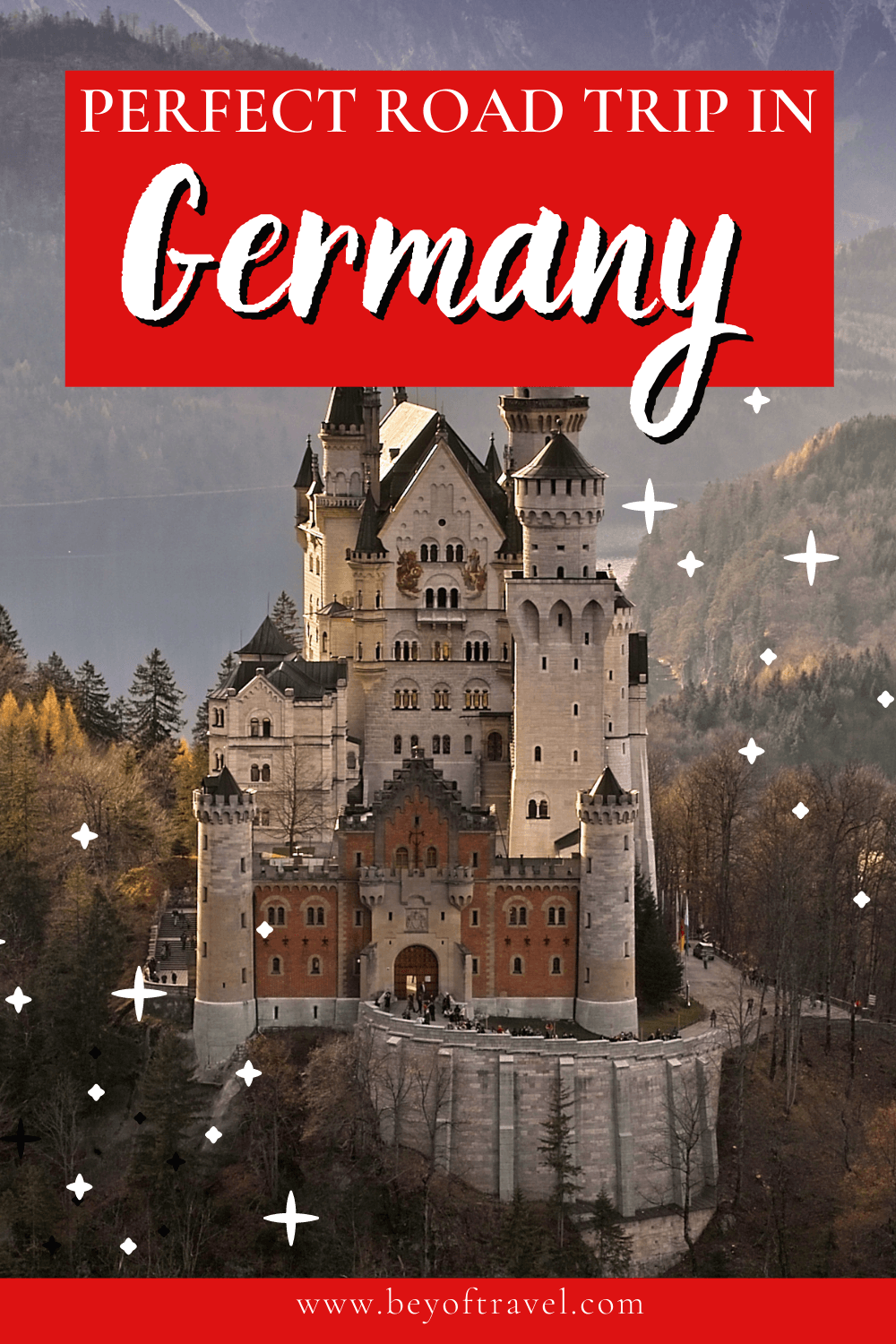
related posts
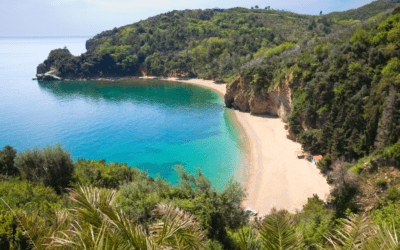
11 Best beaches in Kotor and beyond
Apr 21, 2024 | Destinations , Europe , Montenegro

Best Hotels in Kotor to Stay In: From luxury to affordable
Apr 20, 2024 | Destinations , Europe , Montenegro
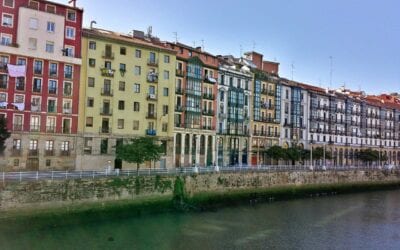
How to spend a weekend in Bilbao – 2 days in Bilbao itinerary
Mar 29, 2024 | Destinations , Europe , Spain
Best Beaches in Kotor Montenegro
The hidden treasures of the Adriatic are poised for exploration, offering unforgettable seaside moments. From the easily accessible Kotor Beach, lying at the base of ancient fortifications, to the secluded allure of Bajova Kula, each spot offers its own piece of paradise.
- Kotor Beach
- Bajova Kula Beach
- Plavi Horizonti Beach
- Verige Beach
- Morinj Beach
- Zanjice Beach
- Risan Beach
- Kotor Natural Beach
- Oblatno Beach
- Pirate Beach
Whether planning a solo escape, a romantic excursion, or a family holiday, Kotor’s beaches cater to all occasions, ensuring lasting memories.
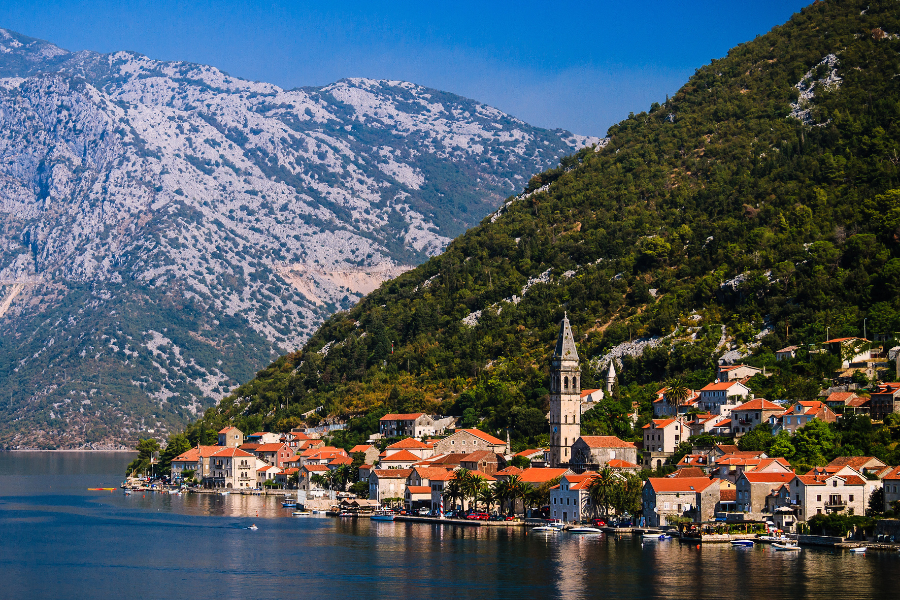
1. Kotor Beach
A stone’s throw from the Old Town, Kotor Beach is a convenient and lively stretch perfect for those who love to be in the heart of the action. It is convenient for visitors who want to combine historical tours with seaside relaxation.
While not the largest of beaches, its proximity to the city centre makes it particularly accessible.
The beach is quite pebbly, and because of its size it tends to be very crowded by noon. I recommend getting there early (between 8 to 10 am), grab a sun lounger (paid) and enjoy a full day there.
If you are sightseeing in the Old Town, and then heading there in the late afternoon or evening I recommend just taking a walk and enjoying the scenery as finding a place to sit down will be a little difficult.
There are not a lot of food options on the beach (but a 5 minute walk from the beach will welcome you to many options).
Highlights:
- Accessibility : Just minutes from the city centre.
- Amenities : A mix of free and paid amenities are available, including sunbeds and umbrellas.
- Vibe : Busy and vibrant, surrounded by bars and restaurants.
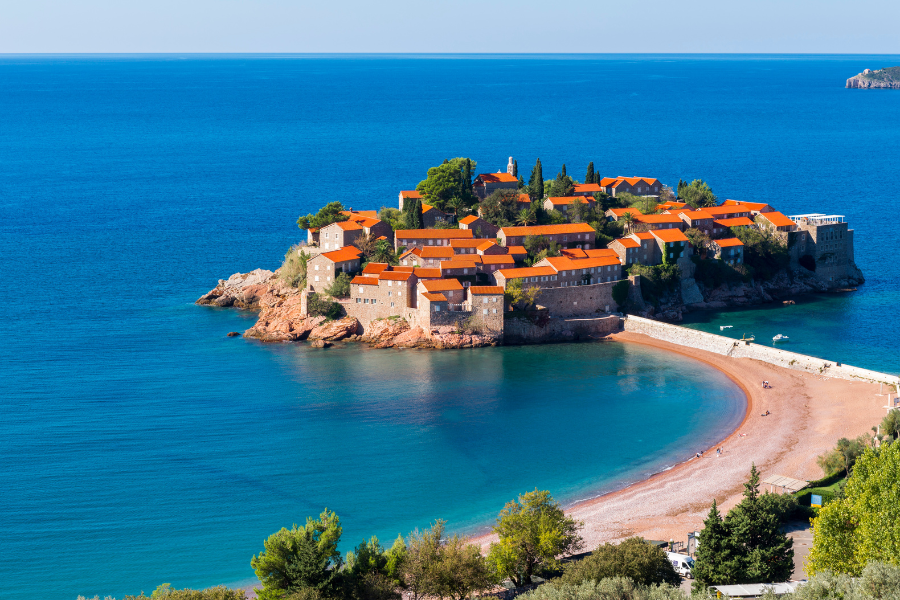
2. Bajova Kula Beach
Named after the legendary hero Bajo Pivljanin, Bajova Kula Beach prides itself on its clear waters and small, secluded bay. It’s ideal for those seeking tranquillity away from the centre.
To get to the beach, you have to drive for 20 minutes as public transport is infrequent. Plus getting there early will be a bonus as you can enjoy the peaceful view of the bay, and soak in the sun.
If you are not driving, consider taking a cab, this will also be convenient as sometimes parking can be an issue when visiting during the peak hours of the day.
You can swim at the Bajova Kula Beach, and there is also a beach bar on-site. You can pay for sun beds.
Be careful when you stroll on the beach as it is quite pebbly and glass pieces are often seen on the shore.
All in all I recommend visiting the beach for its epic views of the Kotor Bay, and its vibe.
- Distance : Roughly 20 minutes’ drive from Kotor.
- Amenities : Enjoy the luxury of a private beach feel with rentable cabanas (morning hours).
- Ambiance : Calm and peaceful, perfect for pure relaxation (morning hours).
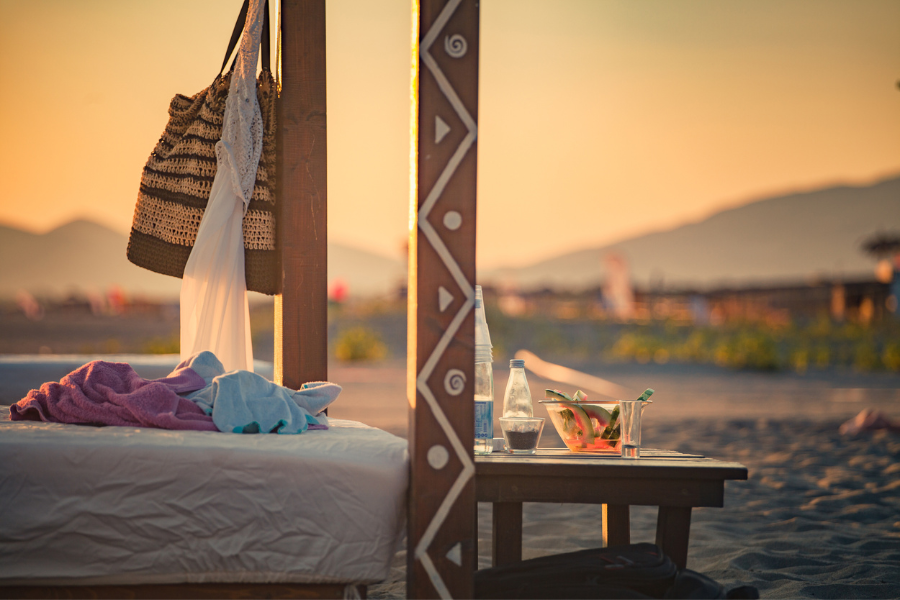
3. Plavi Horizonti Beach
Or as the locals call it, ‘Blue Horizons’ is a beach experience not to be missed.
The fine sandy beach gradually slopes into shallow waters, making it ideal for families with their playful toddlers. It’s one of the most sublime places to witness the horizons, as the name suggests, and lose yourself in the magnificent sunsets.
You can swim, or rent sun loungers. To keep everyone busy and entertained you will find a variety of activities from beach volleyball, tennis, and basketball to building sand castles and hanging out in their restaurant.
The beach is best visited in June and September. And it holds the coveted Blue Flag recognition for excellence in environmental management and water quality.
- Distance : Roughly 20 minutes’ drive from Kotor Old town (near Tivat Airport)
- Amenities : Beautiful and smooth, perfect for children and families. Good restaurant and parking available on site.
- Ambiance : Coastal charmer with cliffs and trees and endless sea views.
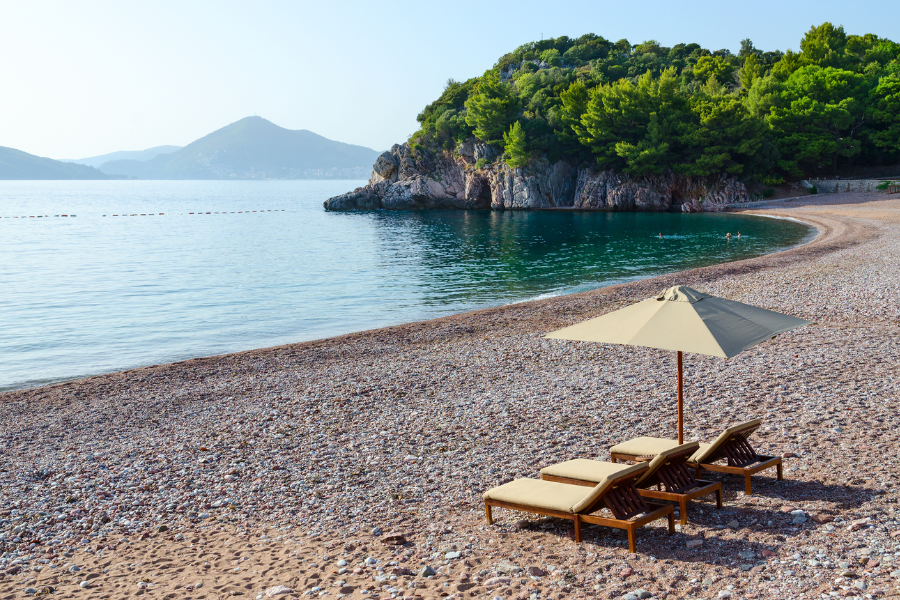
4. Verige Beach
Verige Beach is a hidden gem located about 25 minutes drive from Kotor. Tucked away in the narrowest part of the Bay of Kotor, this enchanting wild beach is easily accessible via the Kotor Bay Ferry.
The beach has fine pebbles, and its crystal-clear waters are breathtaking. Enhancing its beauty, the quaint Church of Our Lady of Angels stands nearby, offering breathtaking views over the bay, Perast, and Our Lady of the Rocks.
The sight of the church, with the scenic backdrop, is utterly captivating!
I like Verige Beach more for sightseeing, including capturing the sights of the boats docking or going up and down the waters.
The waters are also frequented by mega yachts and elegant sailing boats, adding to the beach’s allure.
If you wish to hang out and soak in the sun, you can rent sun loungers nearby or sit down to eat at the restaurant onsite.
- Distance : About 25 minutes’ drive away from Kotor town.
- Aim : Ideal for those looking to escape the busyness for a day.
- Convenience : Limited amenities, but sun loungers are available for rent.
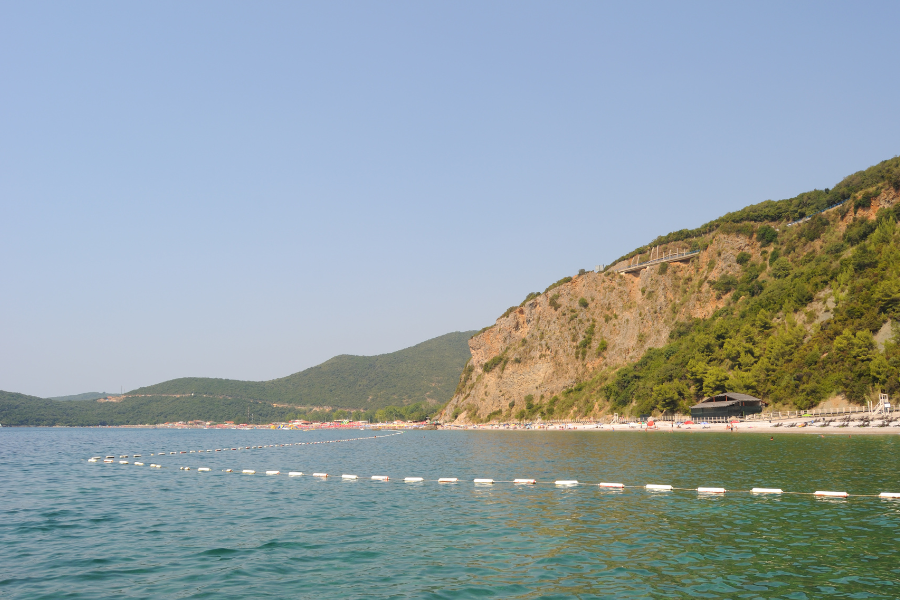
5. Morinj Beach
Situated a mere 30-minute drive from Kotor, it may require a bit more travel, but its appeal is undeniable.
Unlike the typically smaller beaches of Kotor, Morinj Beach stands out with its expansive sandy shores, a rare find in the bay area.
It offers a gentle entry into the water, without the abrupt deepening found at many other local beaches, making it an ideal choice for families.
However, keep in mind that the waters of the Morinj Beach are a little bit cooler which is perfect for hot summer days as the waters can provide a refreshing respite on sweltering days.
Access to Morinj Beach is straightforward and free. You can rent a car and drive there. For convenience, there is a large parking lot located across the street, available for a nominal fee of €2.
- Distance : About 30 minutes’ drive north from Kotor.
- Amenities : Mostly free beach with some paid options for extra comfort.
- Features : Great for children and families.
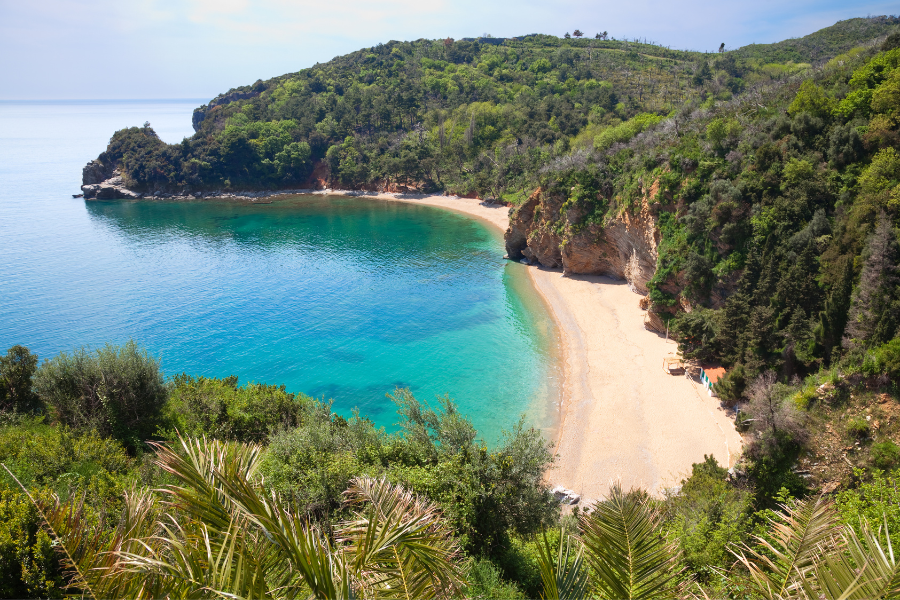
6. Zanjice Beach
Tucked on the Lustica Peninsula, Zanjice Beach lures visitors with pebbly shores and clear blue waters. It’s a bit further out but worth the trek for its serene atmosphere.
The beach is only accessible during the peak season, and you can also book tours to get there from Kotor, or Budva.
The beach is great for views, and the Blue Cave.
Free entry to the beach, and in terms of amenities you can rent sunbeds, umbrellas, and access toilets and showers.
- Distance : Approximately 30 minutes’ drive from Kotor. Or you can come by boat (20 minutes)
- Amenities : Paid sunbeds, with some free areas to lay your towel.
- Surroundings : A quieter choice surrounded by nature.

7. Risan Beach
Want to escape the crowds? Then make your way to Risan Bay. Here, you can enjoy the offbeat shores of Bolnička Plaža, characterised by the authentic stones and rocks of Kotor Bay.
The beach lacks the amenities that you would expect from a well-developed beach area, but it’s untamed, rugged beauty is its charm.
Beyond its picturesque scenery, Risan Beach is steeped in history, standing as one of the bay’s most ancient settlements.
Just a short stroll from the shore, visitors can discover Roman mosaics, adding a layer of cultural enrichment to the beach’s natural allure.
The view of the 7th-century Banja Monastery, framed by towering cypress trees, is undeniably charming.
- Proximity : Approximately a 20-minute drive from Kotor.
- Cultural significance : Offers a touch of history with nearby ancient ruins.
- Amenities : Basic amenities are available, with a focus on the natural environment.
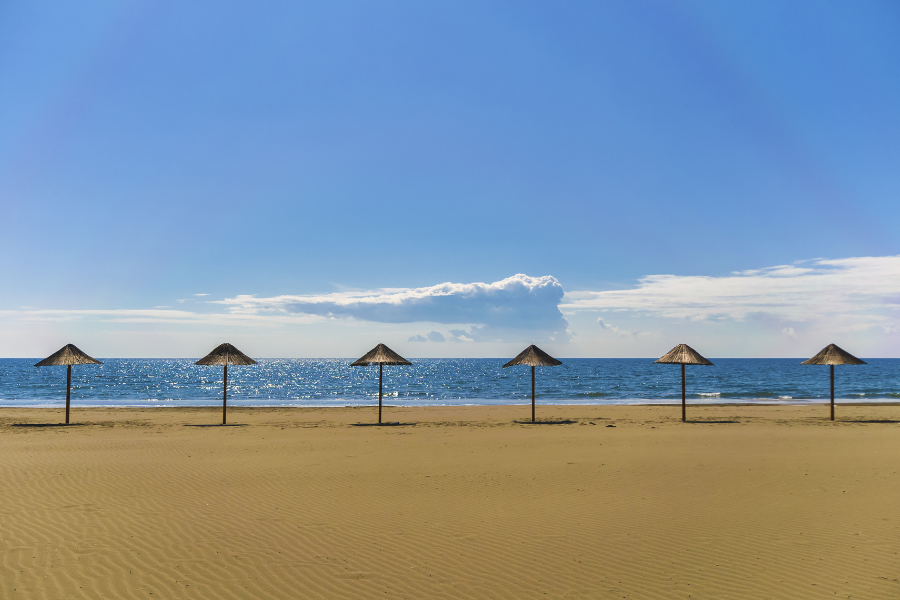
8. Kotor Natural Beach
Kotor Natural Beach is an undiscovered treasure for those in search of a completely free seaside retreat.
Nestled on the side opposite Kotor Beach, it presents a more untouched and rugged seaside experience compared to its counterpart. Here, you won’t find the sun loungers and manicured shores common to other Kotor vicinity beaches.
Given the pebbly and rocky terrain of this wild beach, I recommend bringing aqua shoes.
Swimming is allowed and is okay here.
Near the beach, you will find the ruins of the Fjord Hotel, and there are two small cafes.
- Distance : a short walk from the Old Town to the beach. Parking is available nearby
- Activities : Sunbathing, swimming
- Facilities : Cafes near/on the beach
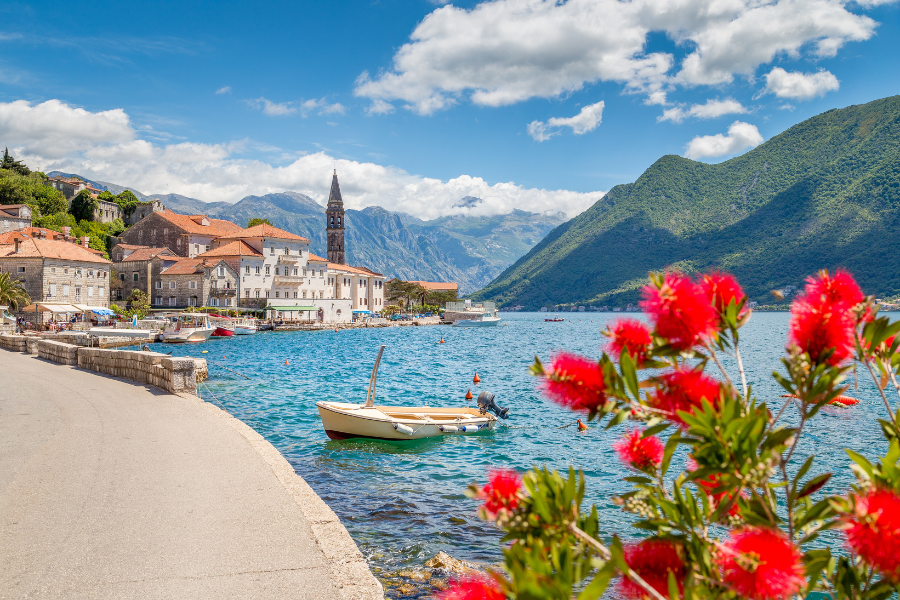
9. Jaz Beach
One of the longest beaches in the Bay of Kotor, Jaz Beach is famous not only for its beauty but also as a venue for top-notch music festivals. Its vivacious atmosphere, coupled with excellent facilities, makes it a hit for those who enjoy the livelier side of seaside leisure.
You can rent sun loungers, and umbrellas and when driving there you will be delighted to know that there is a large parking space (and it is FREE!).
- Distance : Located approximately 20 minutes from the city centre (Budva municipality).
- Activities : Water sports, and live music events are just some of the activities on offer.
- Facilities : Sunbeds, cafes, and umbrellas are available.
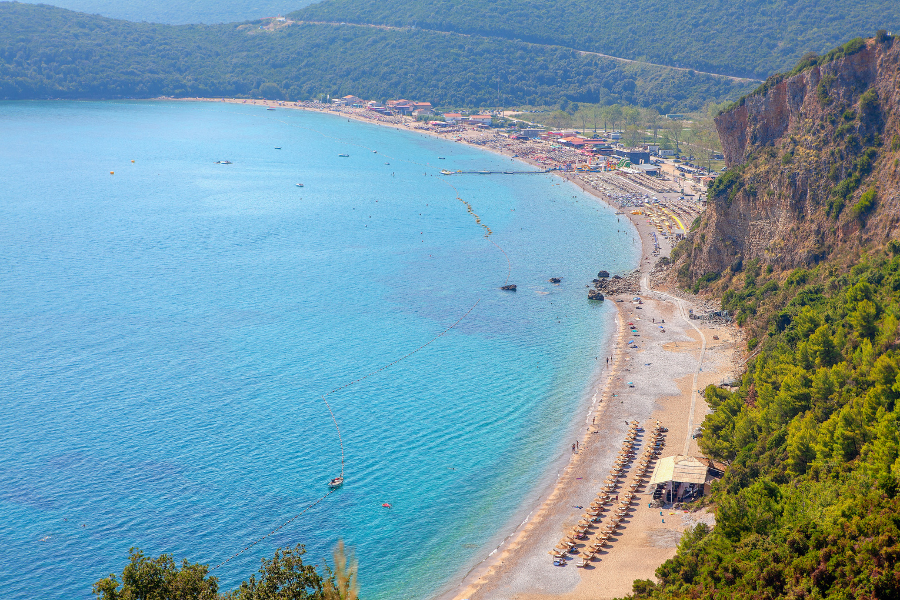
10. Oblatno Beach
Oblatno Beach, located just a 20-minute drive from Kotor, is the epitome of a chic beach getaway.
For an epic day out at a cool beach club, Oblatno is amazing – it is similar to Plavi Horizonti Beach, where the waters are sandy and fine.
The beach is great for families where you can enjoy beachside games.
The beach is free to access, but there is an area under the Almara Beach Club – where you will have to pay to access. This is where you will also find sun loungers for rent.
Other than the beach amenities you can also enjoy cocktails and light snacks all whilst soaking the views of the Adriatic Sea.
A note about the Almara Beach Club – this is a full service restaurant serving fresh and delicious seafood (including paella).
- Distance : A 20-minute drive from Kotor
- Amenities : Sun loungers, umbrellas, changing rooms, showers, and restaurant/bar services.
- Vibe : A trendy and upscale beach club atmosphere with live music events during peak season.

11. Pirate Beach
Pirate Beach offers a blend of fun and relaxation where children can play to their heart’s content, making it a favourite among visiting families. This beach is located in Perast and is about a 20 minute drive.
Pirate Beach boasts a contemporary ambiance, and is perfect for a day out of Kotor. The beach features imported gravel, and for relaxation, you can rent a pair of sun loungers, complete with an umbrella, at €20, providing the perfect setup to enjoy cocktails with a view.
What’s more the stunning backdrop of Perast with the Our Lady of the Rocks, and Sveti Đorđe, is hard to beat, and a must see in Montenegro.
- Distance : A 20-minute drive from Kotor.
- Amenities : Sun loungers, umbrellas, Kid-friendly with shallow areas and play zones.
- Vibe : Amazing views, and the sun and sea!
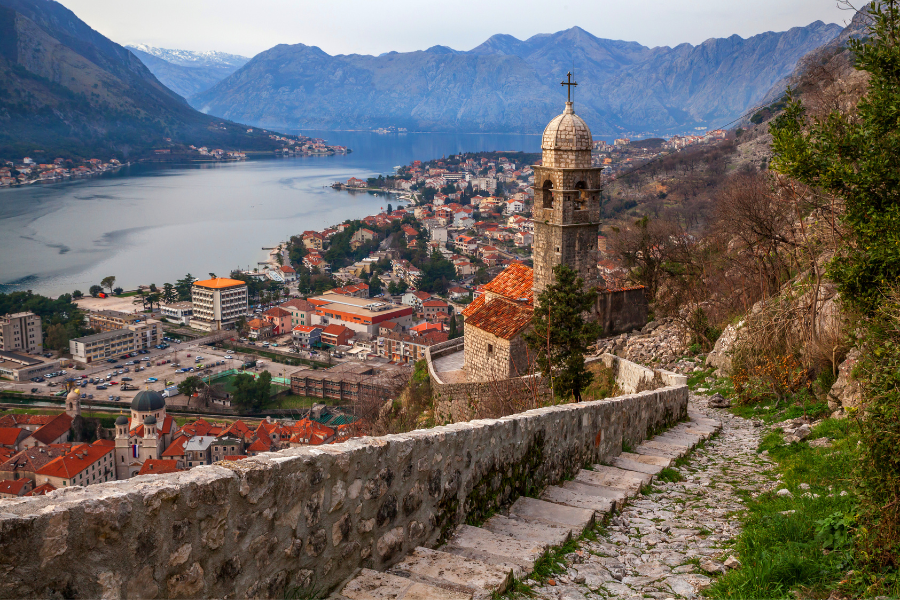
Kotor’s Beach Experience
In Kotor, you will find amazing beaches. There are private and public beach areas and it caters to every luxury level (you can explore and sunbathe for free, or spend a little extra for a luxury experience).
The pebbly shores and crystal-clear waters are a common feature, inviting both locals and visitors to bask in the natural beauty of Montenegro’s coastline.
Public Beaches
Public beaches in Kotor are where the vibrant pulse of the city meets tranquil turquoise waters. These stretches are open to everyone, often characterised by stones or pebbles, and provide a serene setting for swimming and sunbathing.
Best of all, there’s no entrance fee to enjoy the simple pleasure of a day at the beach here.
Private Beach Sections
Dotting the shoreline are chic private beach sections – often affiliated with hotels or beach clubs – where you can rent a sunbed, enjoy waiter service, and sometimes even experience live music or DJ sets.
These areas typically require a small entry fee or sunbed rental but offer amenities like showers, changing rooms, and often a nearby bar or restaurant for that extra touch of luxury.
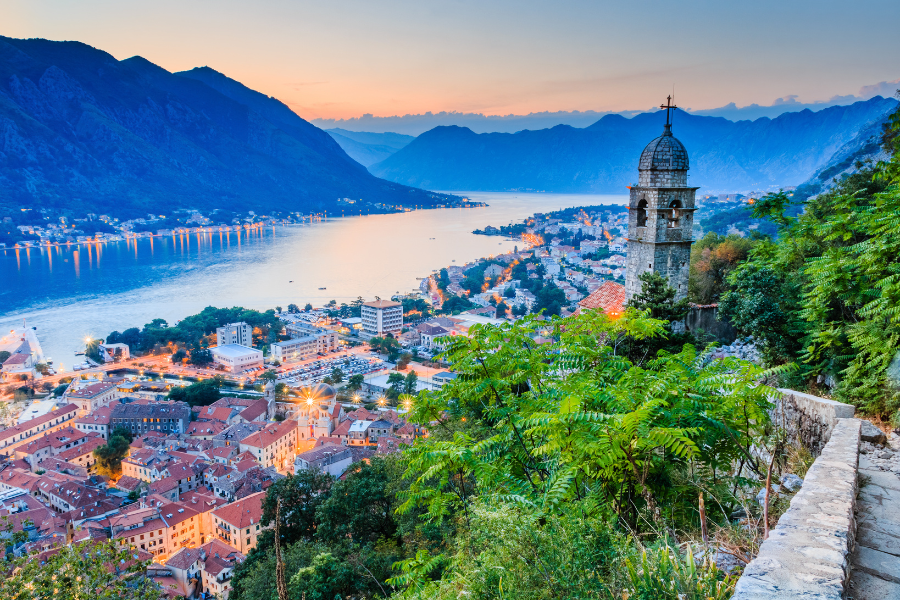
Highlights of Kotor’s Beaches
- Public Sections : Enjoy the liberating feeling of unfettered access and the charm of local beach life. Pack a picnic or grab snacks from nearby vendors, and bask in the sun’s warm glow against the dramatic backdrop of Kotor’s mountains.
- Private Sections : Revel in the cosseted comfort of a private spot, where facilities and creature comforts are at your fingertips. These are perfect for those who fancy a bit more pampering during their beach day.
In summary, Kotor’s beaches offer a diverse range of coastal experiences, from laid-back public spots to the more curated atmosphere of private sections.
With easy access from the historic town and enthralling views all around, your time on the shores of Kotor will be nothing but unforgettable.
Whether you choose the simplicity of a public beach or the enhanced experience of a private beach section in Kotor, each offers its own slice of Montenegro’s coastal paradise.
Enjoy the delightful mix of tradition and relaxation on the shores of the Bay of Kotor and beyond.

Best Time to Visit Kotor’s Beaches
Summer season (peak season).
The optimal time to enjoy Kotor’s waters is during the summer months. From June to August, you’ll find warm, balmy weather perfect for sunbathing, swimming, and a variety of water sports.
The skies are usually clear during these months, offering uninterrupted enjoyment of the sun and sea.
- June – The start of the summer marks the beginning of the beach season with a pleasant climate and fewer crowds.
- July – July is ideal for those who love the heat, as it gets warmer and the beach life is in full swing.
- August – The waters are warmest in August, but expect more visitors as it’s the peak of tourist season.
Shoulder Season – Spring and Autumn
For those looking to avoid the summer crowds, the shoulder seasons of late spring (May) and early autumn (September) are good alternatives. The weather is milder during these months, but it’s still warm enough to enjoy the coastal activities without the summer throngs.
However, keep in mind that beaches in winter may not be as fun as temperatures dip and many services won’t be open or available.
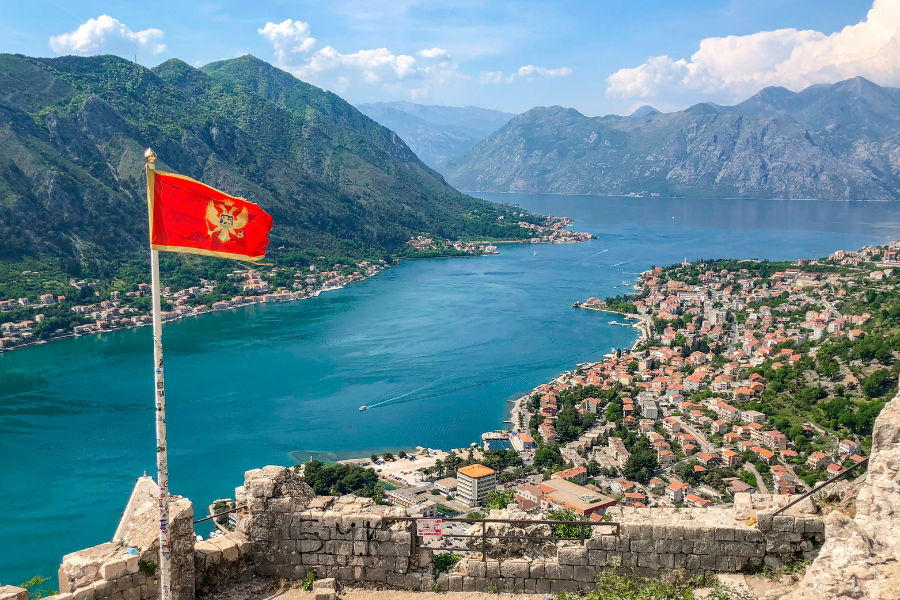
How to Enjoy Kotor’s Beaches
Finding your perfect spot.
Kotor’s coast is lined with both vibrant and secluded beaches. Whether you prefer a lively atmosphere with beach bars and music or a quiet cove for relaxation, there is a spot for every preference.
- For Lively Beach Vibes: Visit the main beaches with amenities such as sunbeds, umbrellas, and nearby restaurants.
- For Secluded Relaxation: Seek out smaller coves that are a bit off the beaten path. They offer tranquillity and are perfect for a serene day by the sea.
Transport & Accessibility
The coastal region of Kotor is accessible from your hotel by various modes of transport.
- Car: Renting a car offers the most flexibility for exploring different beaches along the coast at your own pace.
- Public Transport: There are buses that run along the coast, connecting Kotor to various beaches.
- Bike or Foot: For the more adventurous and active, biking or walking to nearby beaches provides an opportunity to take in the stunning scenery.
Safety and Amenities
Be mindful of safety when swimming and ensure that you are visiting beaches that have lifeguards on duty during the summer months.
Most popular beaches will have amenities like changing facilities, showers, and restrooms. It’s always good practice to check beforehand, especially if venturing to more secluded spots.
Local Regulations and Environment
Remember to adhere to any local regulations and respect the natural environment. Keep the beaches clean by disposing of your waste responsibly.
Kotor’s beaches offer a mix of serenity and summer fun, set against some of the most dramatic coastal landscapes in Europe.
By choosing the right time to visit and considering your preferred beach style, your Kotor beach getaway can be an unforgettable adventure filled with crystal-clear waters and picture-perfect views.
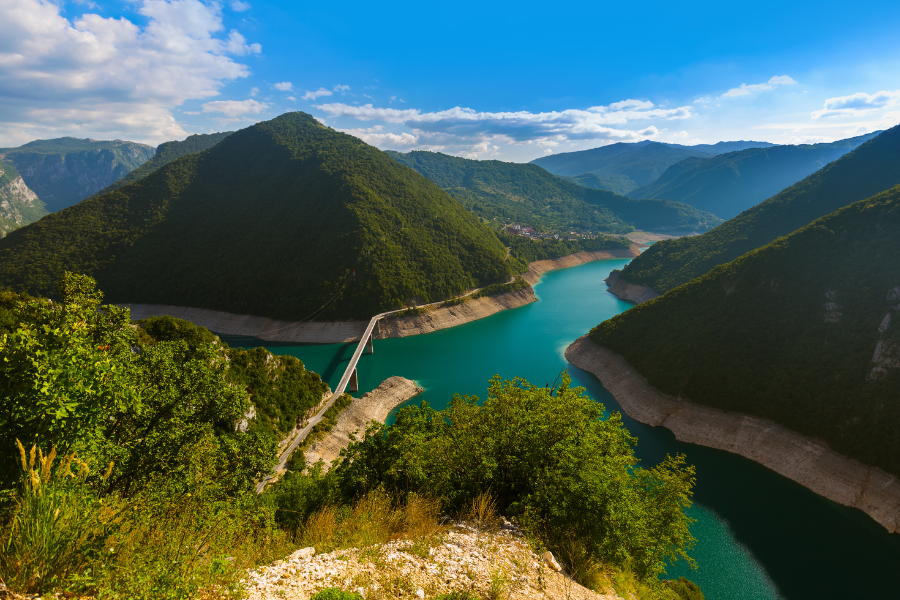
Tips for a Perfect Beach Day in Kotor
Here are some of the tips for having a perfect day out in Kotor,
- Arrive Early : Especially during the summer, beaches can get crowded quickly.
- Mind Your Belongings : While beach theft isn’t common, it’s always wise to keep an eye on your personal items.
- Sun Protection : The Mediterranean sun can be strong; sunscreen, a hat, and plenty of water will be your best friends.
- Stay Hydrated : The Adriatic sun can be intense; make sure to drink plenty of water.
- Respect the Environment : Keep the beaches as beautiful as you found them by disposing of your trash properly.
- Explore Beyond the Main Beaches : Some of the most magical spots are those less travelled.
Frequently Asked Questions
What is the closest beach to Kotor?
Kotor Beach is one of the beaches closest to the Old Town, and is perfect for sightseeing and also sunbathing.
Does Kotor have good beaches?
Kotor has amazing beaches. You can hit the beaches close to the city, or venture beyond to Herceg Novi Riviera and others.
Can you swim in Kotor Beach?
Yes, you can swim in Kotor Beach.
Whether you long for the secluded, natural havens, crave the energy of a crowd, or simply wish to bask in the Mediterranean charm, Kotor’s beaches offer something for every preference.
Each grain of sand and pebble tells a tale of ancient civilizations, maritime adventures, and timeless beauty that awaits your discovery. Don’t just travel—experience Kotor in all its coastal glory. Happy sunbathing!
Pin: Best Beaches in Kotor Montenegro
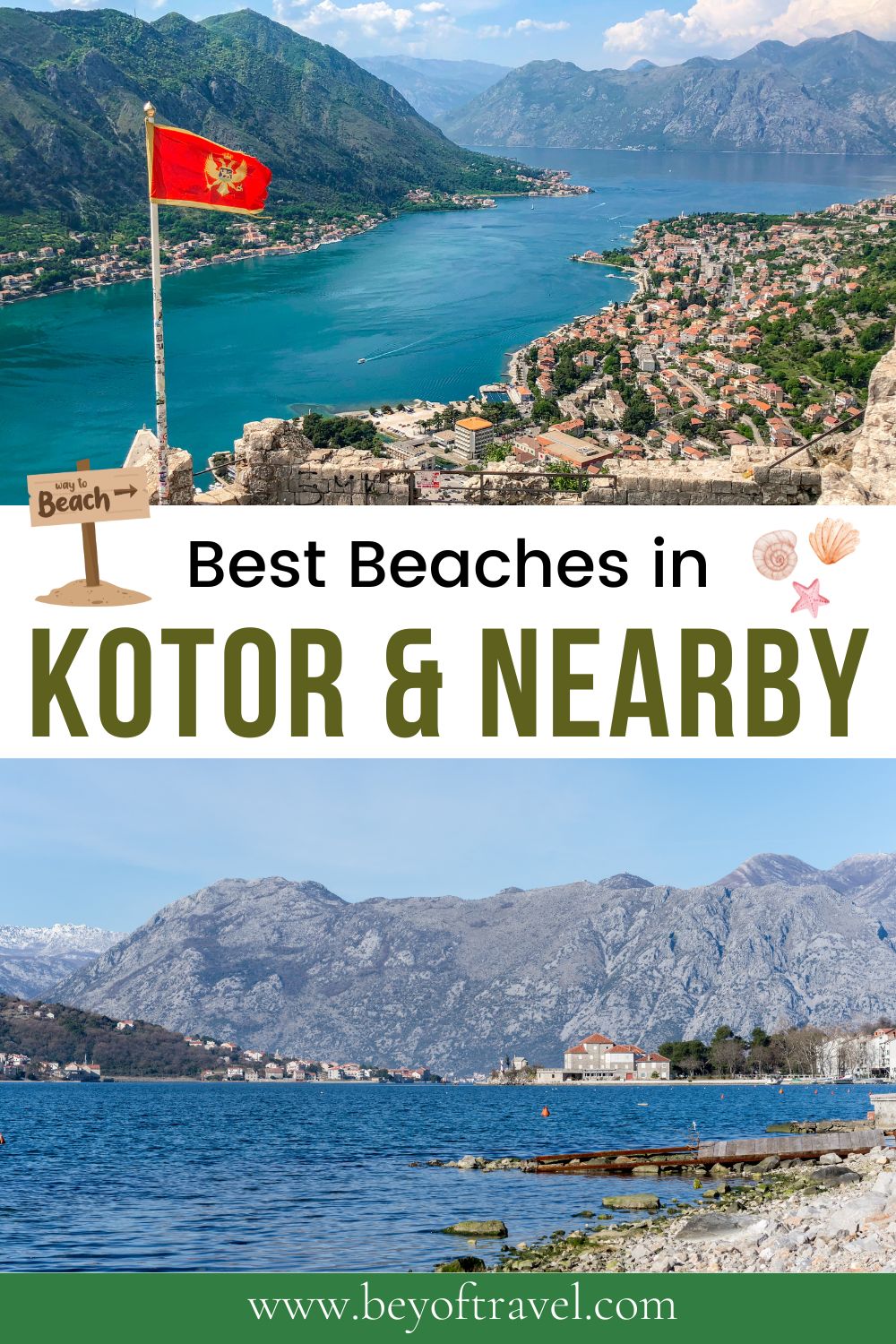
10 Comments
Chique !!! Proficiat !!! Een aanrader me dunkt..
I loved your post as with it, I too went down into my memory lane for road trip in Germany.
Thank you so much for reading!
Leuk gedaan !! Die brug in Morsdorf is inderdaad super leuk en de moeite !
Dank je Inge, super leuk dat je even de tijd neemt om een berichtje achter te laten, doet me plezier!
I love the idea of a cultural trip always! I was thinking to pin your article to my road trip collection, but then I realize it’s such a good one for who’s loving history and culture!!! BTW, the dragon castle is so magic, like from the movies, definitely love to visit.
I love combining a good road trip and some culture! Thank you so much for reading…
This looks like a great road trip. Love your recommendations. Definitely adding for later.
Submit a Comment Cancel reply
Your email address will not be published. Required fields are marked *
Save my name, email, and website in this browser for the next time I comment.
Submit Comment
Pin It on Pinterest

How to Take the Train in Germany: A Step by Step Guide!
Last Updated: March 21, 2024
*FYI - this post may contain affiliate links, which means we earn a commission at no extra cost to you if you purchase from them. Also, as an Amazon Associate I earn from qualifying purchases. Check out our Privacy Policy and Disclosure. for more info.
When it comes to the German rail system, I think one thing you could definitely say is… I have a LOT of feelings about it.
Train travel in Germany is a truly funny and misunderstood thing, shrouded in a romantic cloud of efficiency, speed and scenic bliss.
But while German trains are leaps and bounds better than train travel in many countries, it is far from the flawless and simple utopia many of us imagine in our heads.
From awkward seat shuffling and breathless running to impatient inspectors and stunningly muffled announcement quality, German train travel is a piece of work that, like a marriage, requires years of learning, understanding and patience.
Don’t worry though – I’ve endured the marital strife so you don’t have to. I lived in Germany for over five years, exploring the country (mostly) by train, and today I’m going to walk you through the process, from start to finish.
I hope you find it helpful!

Save this guide on how to travel Germany by train for later!
You’ll be very glad you did.
A Brief Introduction to the German Rail System
Let’s start with some basics on taking the train in Germany, which involves the largest rail network in Europe and over 33,000km of track!
Rail Providers in Germany
Operating over 40,000 trains a day, Deutsche Bahn is the national rail provider in Germany responsible for the vast majority of trains in the country.
When it works, it works great. However, when there are delays, travelling with them can be a bit of a nightmare, which is why the brand has become the butt of countless jokes regarding delays and high prices.
But bear in mind these jokes are often made by Germans who don’t realize how bad train systems can be in other countries.
Honestly, compared to many countries like Canada where I’m from, the German train system is fantastic, and still my go-to mode of transport around Germany.
It’s far from flawless but it’s still pretty great, especially when boarding at hubs like my former home of Munich, since there’s far fewer delays at the start of a journey!
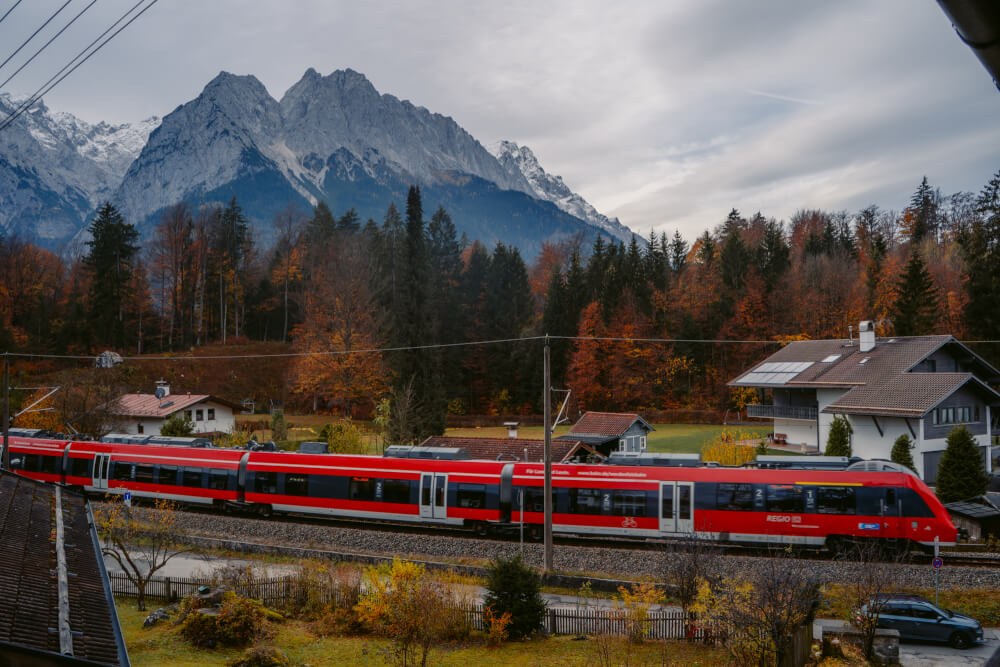
Another train operator you can consider in Germany is FlixTrain.
I’ve personally never taken them because in the time I lived in Germany, they were operating really limited routes and I still haven’t had a chance to try them. That said, their value proposition is super cheap fares starting at only 4.99 euro so definitely worth looking into if budget is a priority.
Flixtrain is fairly no frills – they only have one standard class and the buying process is straightforward so the rest of this post will focus on Deutsche Bahn trains and tickets.
NOTE: If you do book with Flixtrain though, be sure to double check that you are in fact booking a train, because this company also owns Flixbus, one of the biggest bus companies in Europe, and they’ll often show you buses alongside trains.
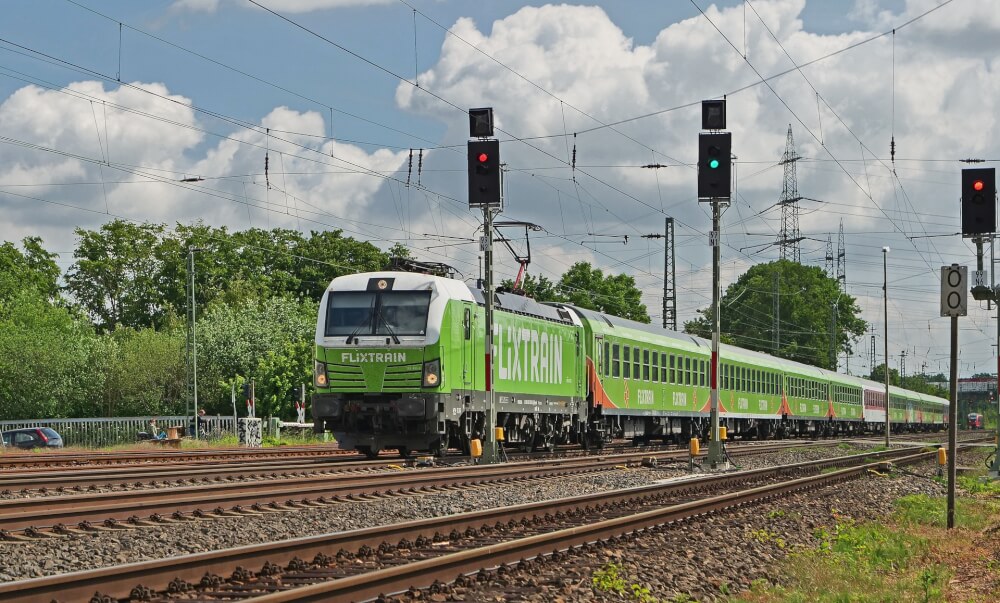
Now, let’s discuss…
Types of Trains
Broadly speaking, we can divide German trains into two three categories: long distance, regional, and local, such as S-Bahn or U-Bahn trains.
Understanding the difference between these is important, as they make a huge difference in journey time and cost, so I’m going to run through the most common ones, along with their abbreviations that typically show up in the train numbers and booking portals.
Long distance trains in Germany are used to connect larger cities and are therefore usually quicker, but typically require booking in advance, with reservations being a good idea in busy periods.
Under the German long distance train umbrella, we have…
- ICE: InterCityExpress trains, which are the fancy, high speed trains that get you between major cities, and can go up to 300km an hour. Especially quick are the ICE Sprinter trains which make even fewer stops than normal.
- IC: Intercity trains, which also travel between cities in Germany but are sometimes a bit slower than the ICE ones (maxing out at about 200km an hour) and often not as new or nice.
- EC: Eurocity trains, which travel between cities in Germany and elsewhere in Europe. These can look different than usual Deutsche Bahn trains because depending on the route, they may be operated by another country’s rail provider.
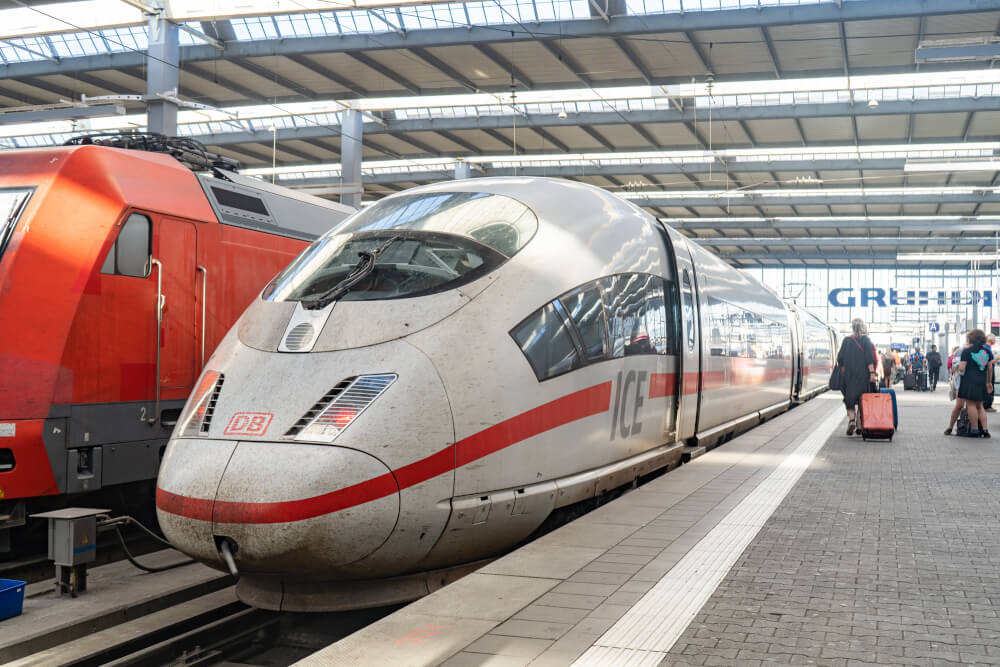
In contrast, regional trains cover shorter distances, typically within one state or region.
Reservations and assigned seats are not possible for these trains, their prices are fixed so buying in advance isn’t necessary, and they’re covered by a range of special deals which I’ll go over later.
Under this regional train umbrella, we have…
- IRE: Interregio-Express trains, which travel longer distances between regions but usually at much slower pace than the long-distance trains (and are therefore classified as a regional train as far as special deals are concerned)
- RE: Regional Express trains, which connect destinations in one region, but don’t stop at every stop on the route which can be faster than the…
- RB: Regional Bahn trains, which connect destinations in one region and do stop at every stop along a particular route
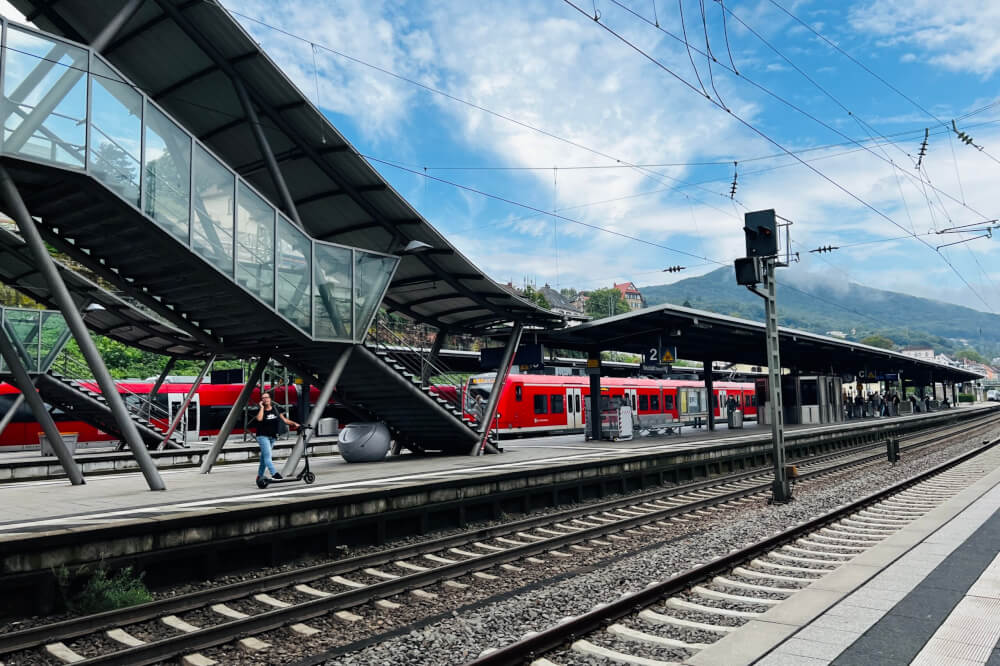
Lastly, on the local train front, we have options like…
- S-Bahn, which are trains that connect stops within cities and out to nearby suburbs, as well as…
- U-Bahn (in some cities) which are underground trains that connect stops within the city itself like the Subway or Metro
These are also typically covered by the special deals we’ll be discussing below.
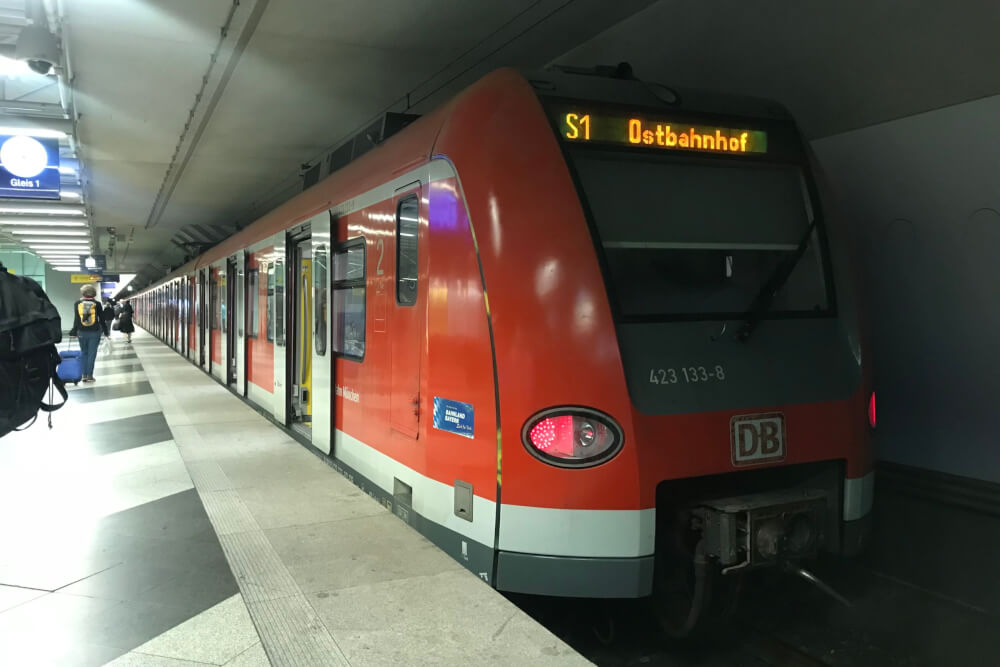
Now, with the basics covered, let’s go through step by step how to plan a train trip in Germany.
Step One: Decide if Train Travel in Germany is Right for You
First – let’s talk alternatives to train travel in Germany.
I’m a huge fan of German train travel, but there are other options for getting around that may be better suited to your specific trip and priorities.
Overall, I think taking the train in Germany is great if you’re looking for convenience, comfort and scenery.
The downside is however it can be quite expensive, especially if you don’t book in advance. It’s also not super convenient if you’re travelling with a lot of luggage (more than one big suitcase per person).
A more budget-friendly alternative may be taking buses, booking a ride share on services like BlaBlaCar or sometimes even flights if you’re booking with budget airlines like Ryanair , easyJet and Wizz Air .
Or, if your priority is freedom and getting off the beaten path, it may be worthwhile to rent a car.
Overall, if you’re torn and want to compare all your options at a glance, Omio is a great app that shows you planes, trains, and buses from Point A to Point B. From there, you can gauge whether train travel suits your needs.
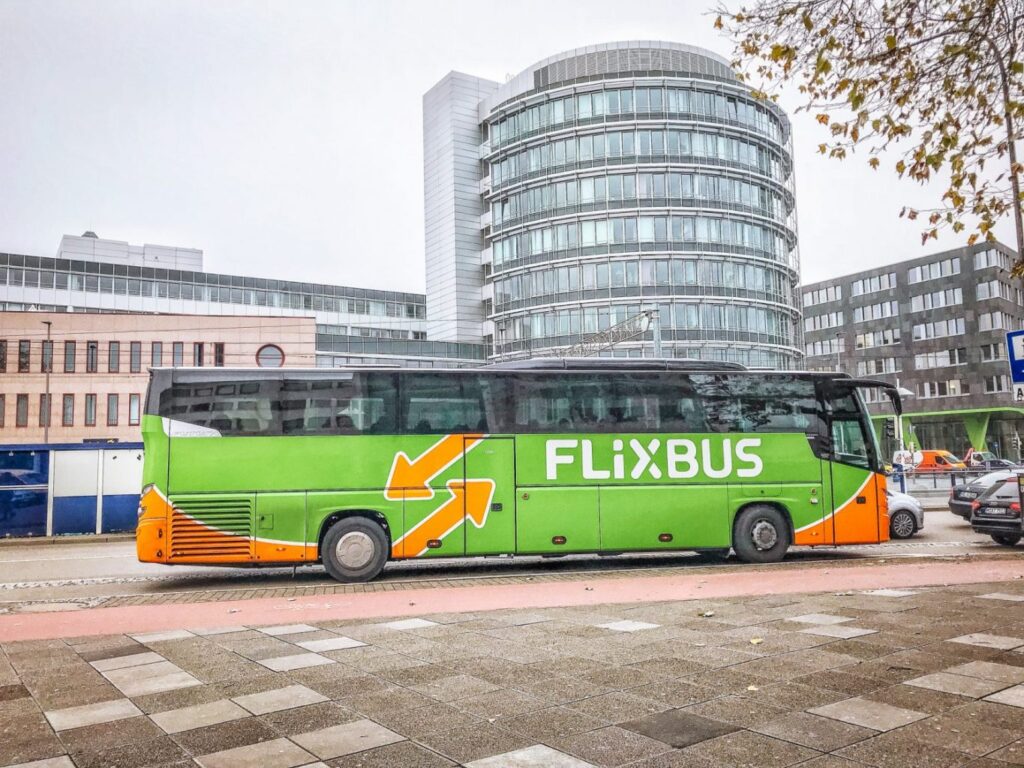
If/when you’ve decided you do indeed want to take the train, then we move onto…
Step Two: Buy Your Germany Train Tickets
The pricing of trains in Germany is dynamic, meaning the cost changes depending on when you buy it and what demand is like.
It is totally bananas to me that a ticket, when booked early, can be 20 euros but if you wait until the day before/day of it can go up to 180 euros.
But alas, I do not make the rules. If I did, everyone would get a free on-board puppy.
In any case, I’d advise booking tickets in advance online, because buying them on board isn’t usually possible, and buying in person from the information desk at the station does incur an extra service fee.
You can also buy tickets on machines at the station but I feel like this adds an extra element of stress, so be sure to book in advance whenever possible.
Now, there are a lot of considerations to be made when you go to buy train tickets in Germany. I’ll outline them all now.
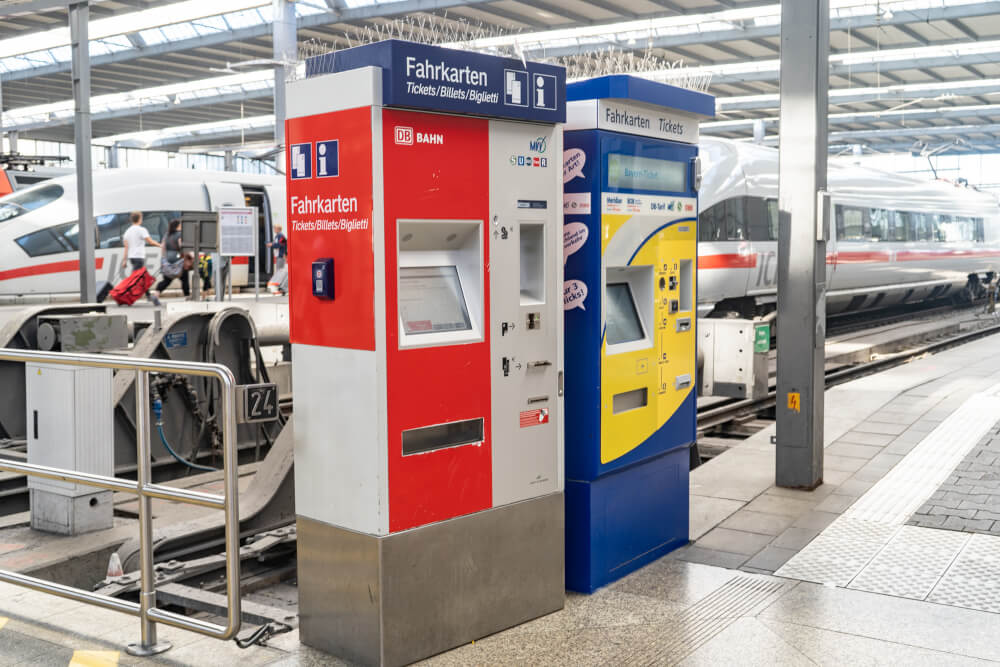
First off…
BahnCard vs No BahnCard
If you plan to stay a while and take a lot of trains in Germany, it may be worthwhile to purchase something known as a BahnCard.
These are cards that you purchase for a set fee that then give you discounts on most train journeys, either 25% or 50% depending on which one you buy.
While these cards are definitely more geared towards locals than tourists, sometimes the discounts can be so significant that you can make the cost up in just a few journeys, so it’s worth crunching the numbers.
Especially interesting for short term visitors are the Probe Bahncards, or Trial cards which allow you to buy a cheaper membership that’s essentially a trial for 3 months, rather than for a whole year.
These start at just 17.90 for the three months, an amount you can easily make up if you’re buying an expensive long-distance or last minute ticket. Just don’t forget to cancel your subscription 6 weeks before the expiry date, or it auto-converts to an annual one that of course costs more.
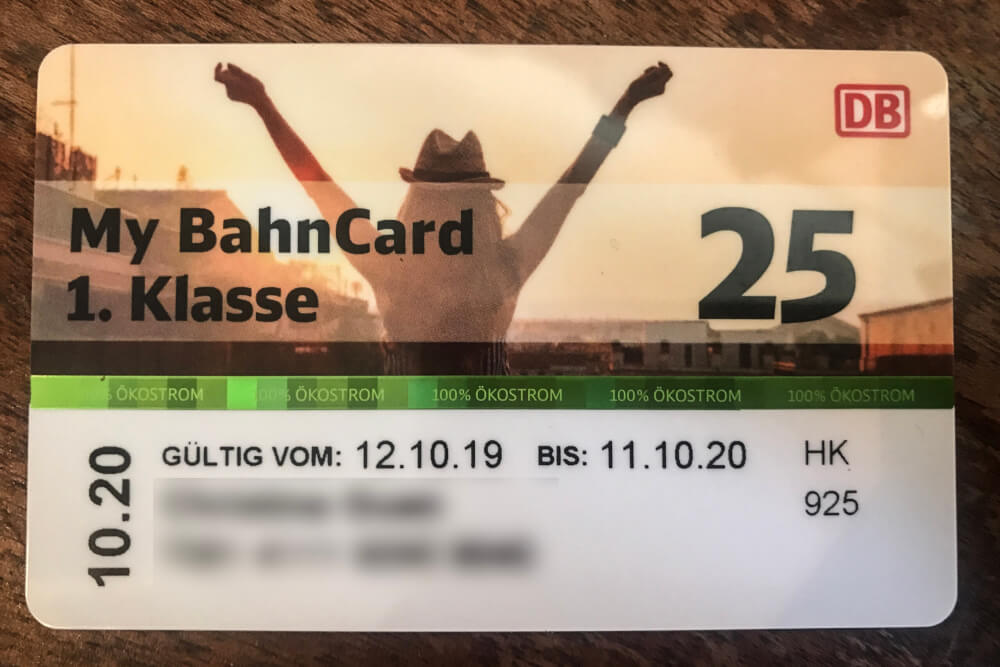
Honestly though, for most tourists visiting for a short time, there are better ways to save money on German train tickets.
So let’s move onto our next consideration which is…
Standard Tickets vs. Special Tickets or Rail Passes
If you are only booking a few train journeys during your time in Germany, the best option is most likely to just buy tickets for the journeys you’re taking, meaning hopping on the Deutsche Bahn app or website, entering Point A to Point B and buying tickets for each trip you plan to take.
Sometimes though this won’t be the way to get the best deal. So, I’m going to outline some options that may save you money depending on your circumstances.
First off – do know that there are age based discounts on Deutsche Bahn for the following groups:
- (FREE!) Children 6 & under
- (FREE with parents or grandparents) Children aged 6-14
- Youth (aged 15-26)
- Senior (age 65+)
So, to activate these discounts, be sure to specify your age and the age of those travelling with you when you go to search routes.
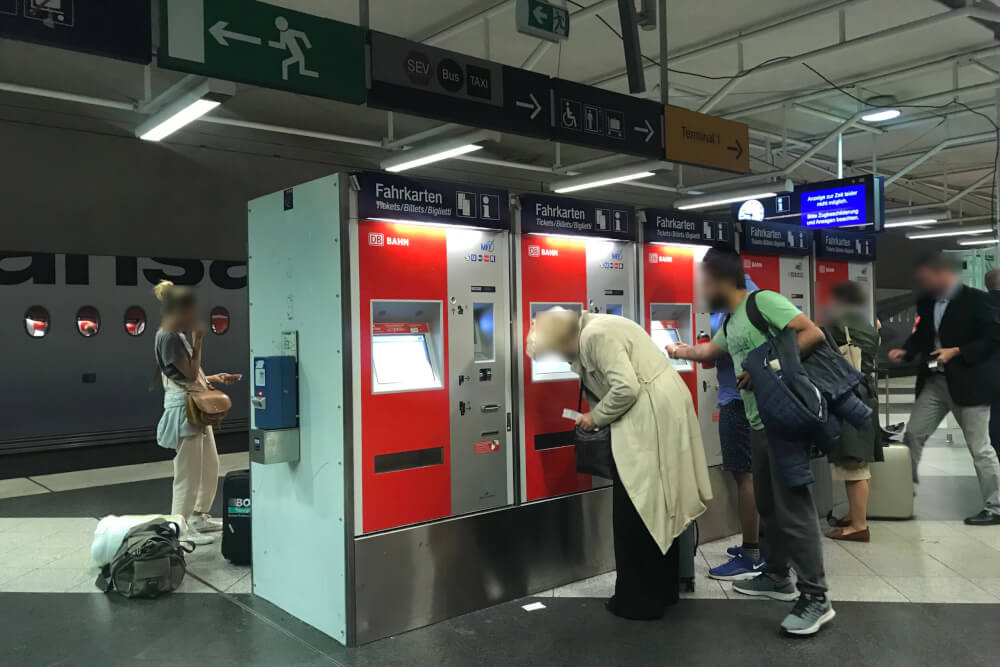
Now, if you are looking to save money on regional and local trains in Germany, there are few excellent options that are almost guaranteed to save you money, especially for day trips.
With one of these, you can genuinely save hundreds of euros over buying individual tickets the day-of.
If your travels are restricted to one German state, then look into buying a regional day ticket (known in German as Länder-Tickets ). These give you unlimited travel on regional trains for one day, with options up to five adults on one ticket.
The savings with these are also better the more people you bring, with a base fee, then a small additional fee for every extra person, so definitely worth considering if you’re travelling in a group.
Here are the different regional tickets you can buy:
- Baden-Württemberg-Ticket
- Bayern-Ticket
- Brandenburg-Berlin-Ticket
- Hessen-Ticket
- Mecklenburg-Vorpommern-Ticket
- Niedersachsen-Ticket
- Rheinland-Pfalz-Ticket
- Saarland-Ticket
- Sachsen-Anhalt-Ticket
- Schleswig-Holstein-Ticket
- SchönerTagTicket NRW
- Thüringen-Ticket
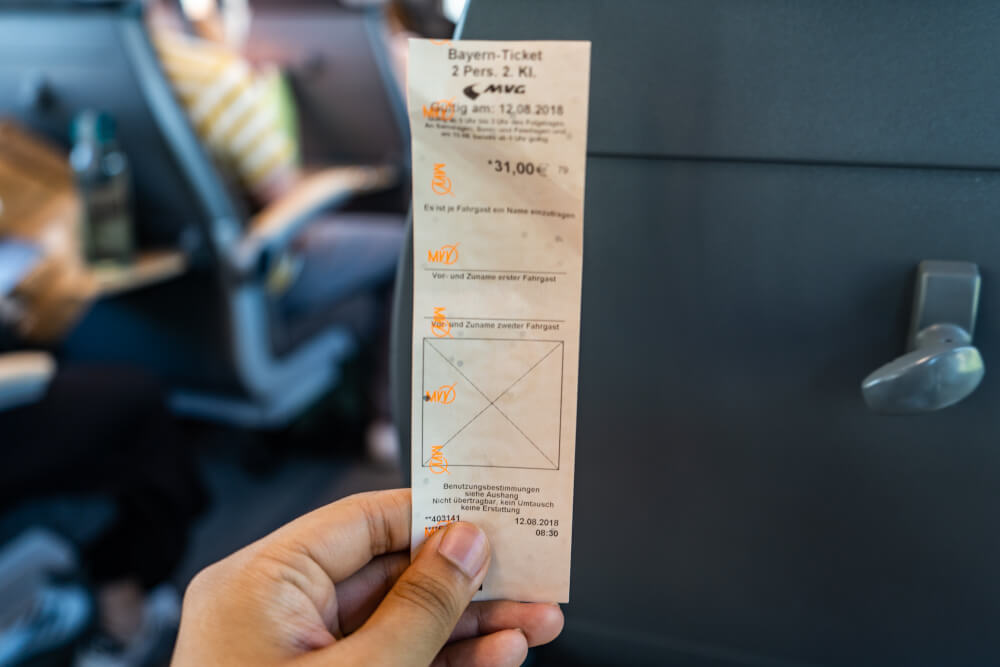
They also have a Germany-wide version of this ticket if you plan to travel across states, known as the Quer-durchs-Land-Ticket.
BUT, an even better deal if you plan to use regional trains exclusively across Germany is a relatively new offering known as the Deutschland ticket.
This golden ticket is only 49 euro a month and gets you unlimited travel on regional trains for that whole month. Considering a one-day Quer-durchs-Land Ticket is already 44 euro, getting the Deutschland Ticket is pretty much a no-brainer if you’ll be taking regional trains for more than one day.
BUT the catch is, this ticket is more geared towards locals, and therefore is offered on a subscription basis. So long as you cancel your subscription in time though, then you can easily just use it for one month or as you need.
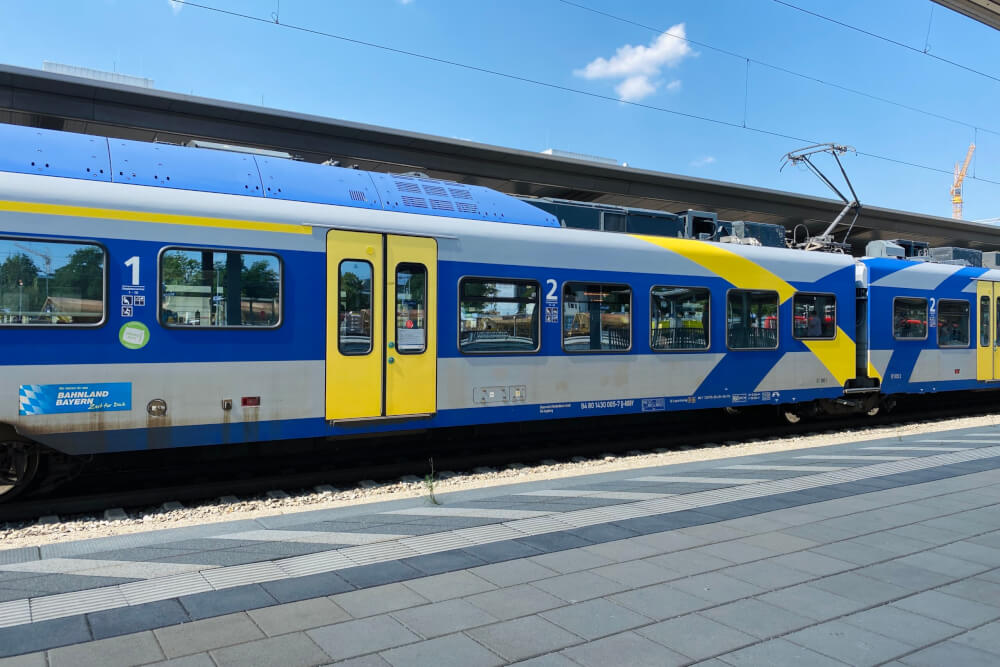
Unfortunately, saving money on long distance trains is less simple. Generally, your best bet is just booking early. The earlier you book, the cheaper it’ll be.
If you can’t book in advance though, a potential cost saver could be a rail pass.
If you are just travelling within Germany, there is a German rail pass you can buy for unlimited journeys either on a flex basis, meaning for a few days within a set period or on a consecutive basis, meaning a set number of days in a row.
If you are travelling to other countries in Europe, it may be worth getting a Eurail pass , also known as an Interrail Pass when you’re a resident of Europe.
Used properly, these passes can save you a lot of money, but only in certain situations so for more information on that, be sure to read my full Eurail review.
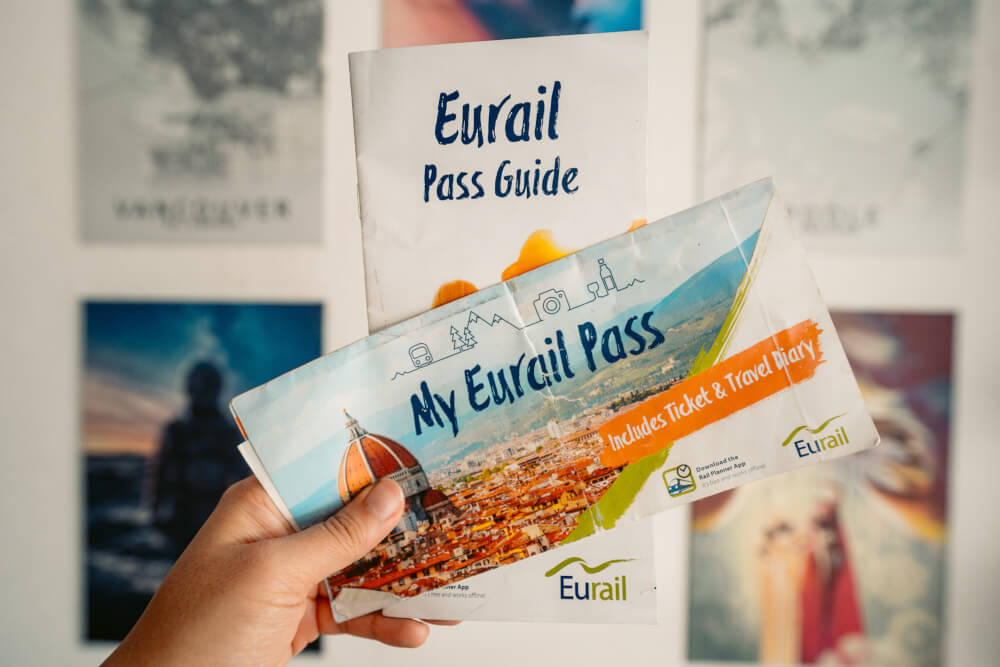
Now, when you go to buy tickets, you can either do so in person or online.
Online, you can either buy tickets directly through Deutsche Bahn (website or DB Navigator app) or through a third party website.
Booking direct with Deutsche Bahn will pretty much always be the cheapest option, but if you’re planning a big trip with lots of trains or buses in other countries, then a 3rd party like Omio or Trainline might be worth it just to keep all your tickets in one place.
NOTE: When choosing your journey, always prioritize direct connections or routes that make fewer stops. These will usually cost more, but trust me, it’s worth every penny! Transfers are simple enough when trains run on time, but as soon as you’re hit with a delay, that can disrupt your entire journey and make things 100x more stressful.
Whether you buy from Deutsche Bahn or from a third party though, there are several considerations to make, so I’ll run through them now.
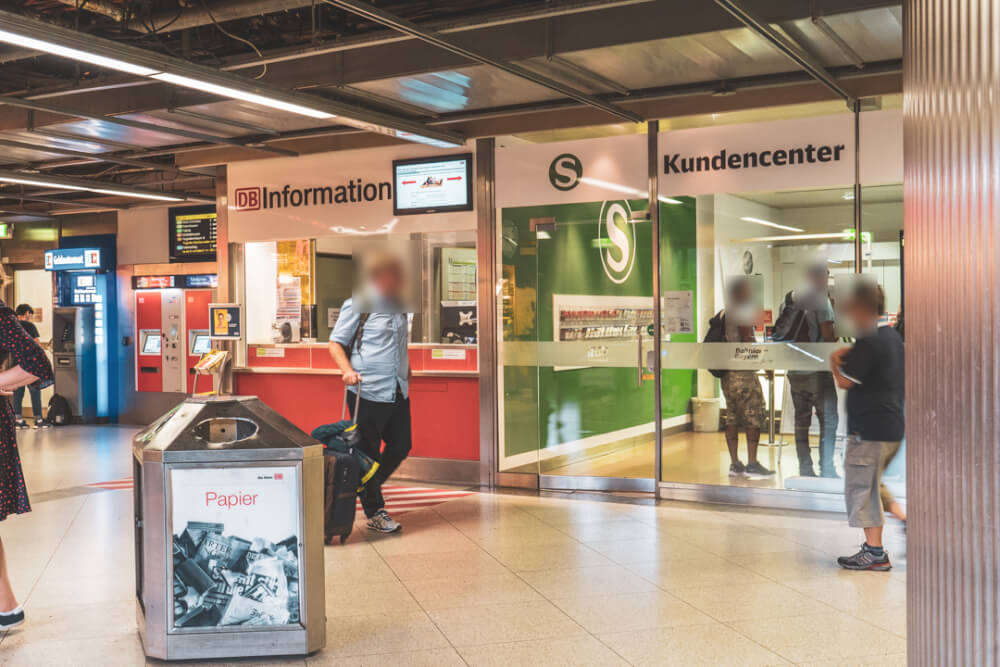
1st vs 2nd class on German Trains
The first time I got to sit on a 1st class German train, I had extremely high expectations.
Part of my brain flashed to a sepia-toned flashback of glamour train travel in the 60s, with fizzy champagne flowing and a steak dinner served right to my seat. I knew this wasn’t going to happen, so I dialled it down. I once took a first class train in Italy and they gave us coffee and snacks. I therefore looked forward to said coffee and snack.
German trains? You get pretty much nothing. So no, the difference isn’t stark, but there are some instances where I think splurging on first class is worth it.
On regional trains, there isn’t a dramatic difference between first and second class seats.
The main perk is it’s generally quieter and sometimes the seats are slightly comfier. So, I would go for first class in regional trains if a) the price difference isn’t much/doesn’t matter, b) you want extra privacy or c) it’s a busy time and you want to secure your chances at having a seat (and space for your stuff).

On long distance trains however, there’s definitely a bigger difference between first and second class, especially on ICE trains.
In first class, the seats are more comfortable, a reservation is included, you can get food/drinks ordered to your seat, and for introverts like me, there are even single seats you can reserve so you don’t have to sit next to anyone.
If any of these perks sound appealing to you, then I’d say it’s worth the extra cost (which is sometimes minimal if you book early enough).
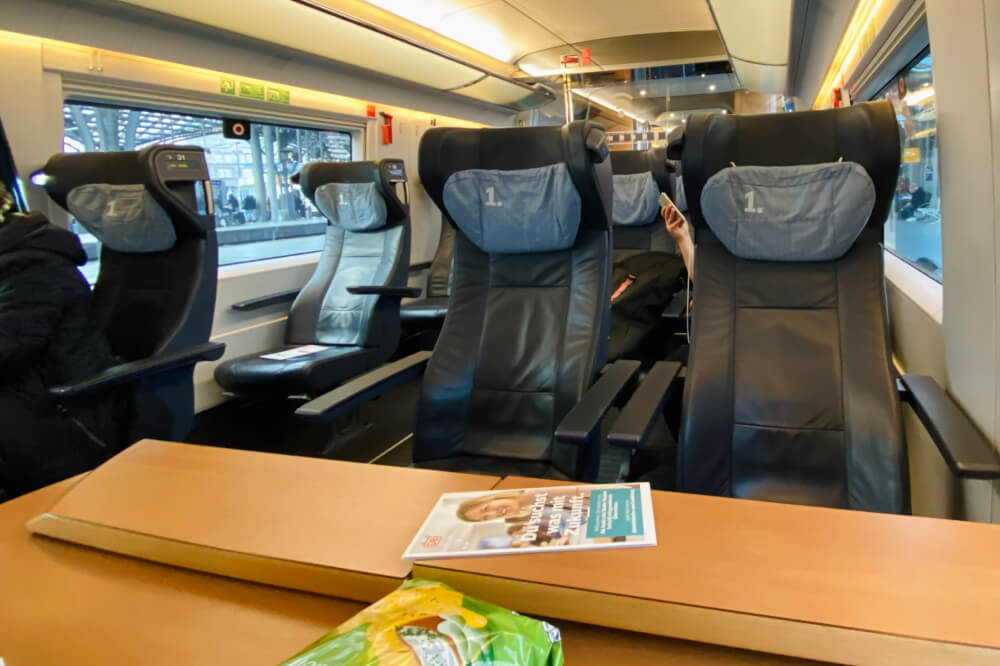
The next consideration is…
Reserved vs. Unreserved seats
Reservations are pretty much never mandatory on German long distance trains, and aren’t even possible on regional trains, S-Bahn or U-Bahn.
That said, I would highly advise making a reservation if you’re at all an anxious traveller, or if you’ll be travelling during a busy period.
The cost is only about 5 euro and having that peace of mind for me is more than worth it.
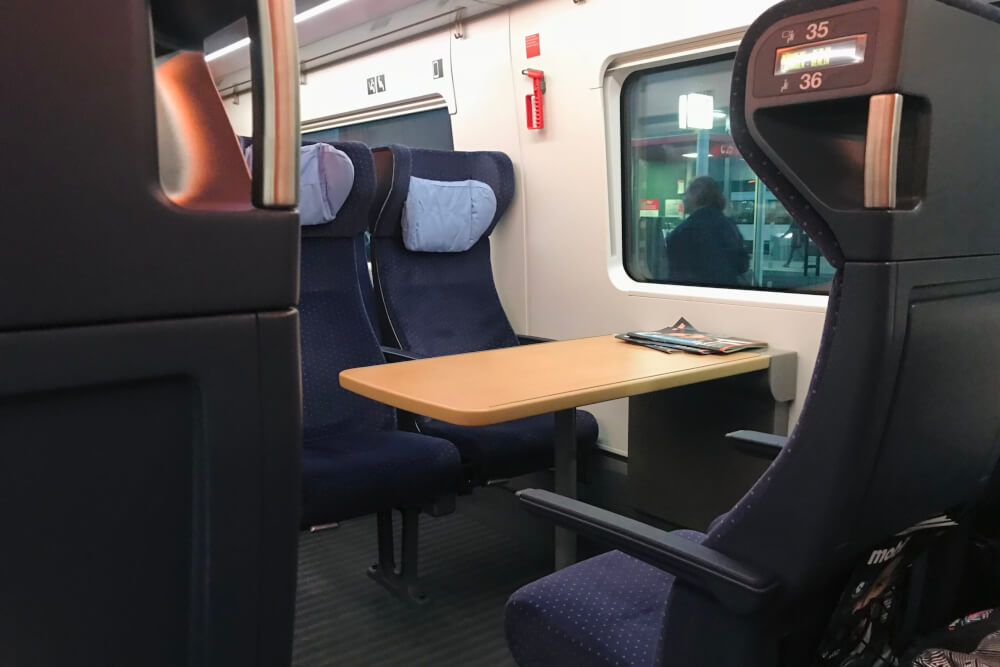
If you do end up reserving a seat, another consideration is…
Carriage and Seat Types
Some trains in Germany have different carriages intended for different purposes, such as…
- Silent/quiet carriages
- Cellphone carriages (where you can freely make calls)
- Family areas
- Bike zones (with additional space)
- Accessible zones
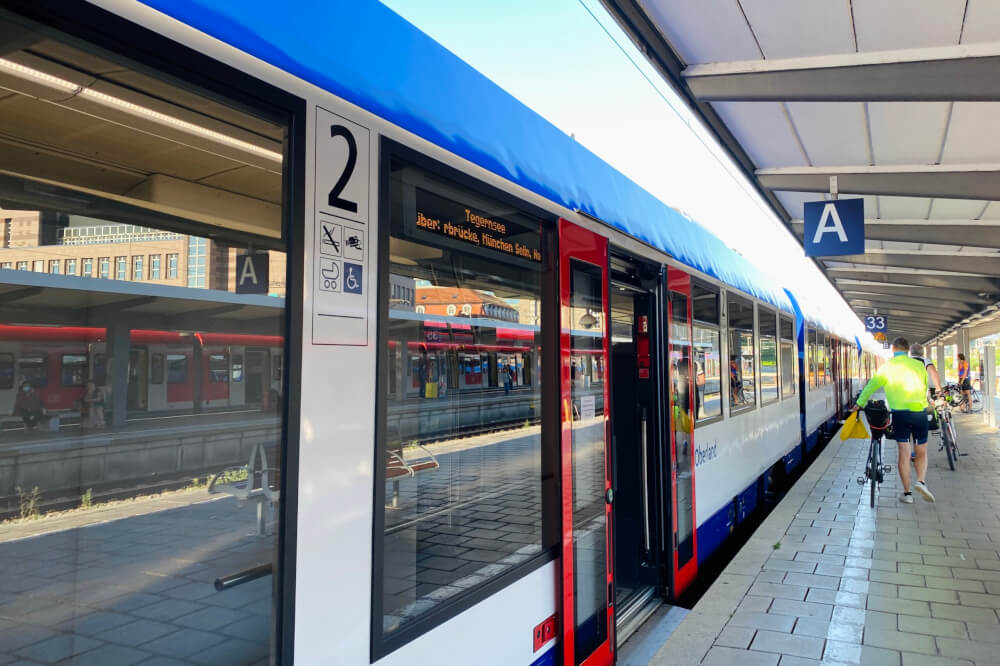
There are also different seating configurations for many long distance trains, with the two main choices being:
- Open saloon seating, which is your standard train set-up with seats in a carriage, sometimes with a table around which 4 people can sit facing each other OR
- Compartment seating, which are more old school closed compartments with seats facing each other. These are fun if you get them to yourself, or with your own group but can be a bit intimate if you’re sharing with strangers
You’re usually given an interactive map when you book a reservation, so you can also make other considerations like window vs aisle or how close you are to amenities like the bathroom, luggage racks or the on board restaurant.
Be sure to take some time to consider which seat you might want to reserve – not all seats are made equal!! With seats at the end of cars for instance, people will be coming in and out constantly to go to the bathroom, which isn’t ideal if you’re looking for a peaceful journey.
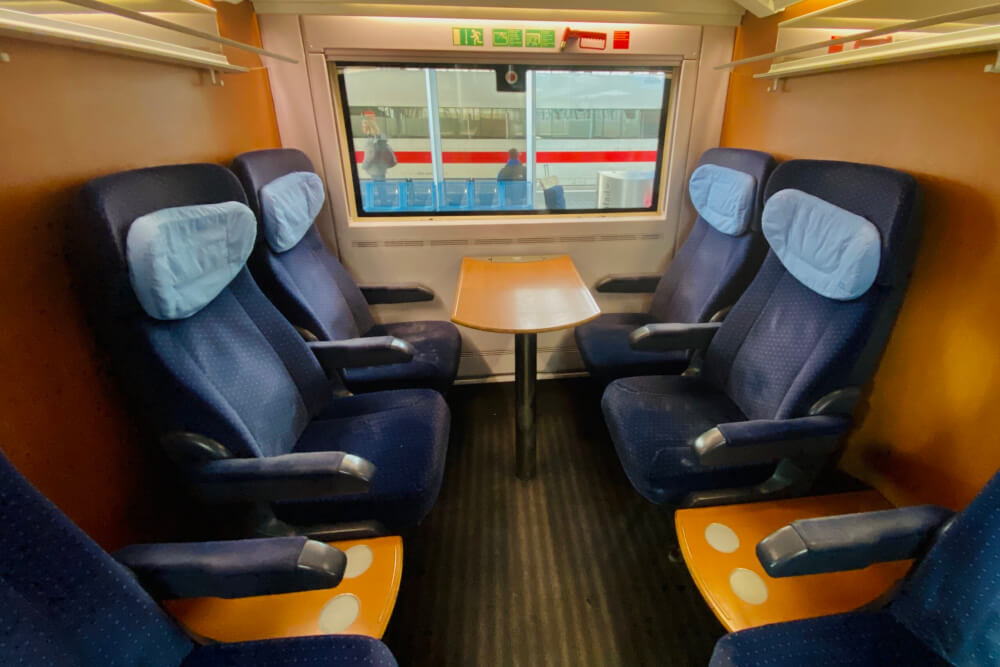
Another choice you’re given when buying tickets is…
Flexpreis vs Sparpreis
Essentially these are different versions of the same ticket, and make no impact on the destination/route, but do impact how flexible the terms of your ticket are.
The Sparpreis is essentially a ticket that is only valid for that one train and time you’re booking. In exchange for this lack of flexibility, the fare is much cheaper, especially with the Super Sparpreis (which is most limited in flexibility).
In contrast, the Flexpreis ticket gives you a lot more flexibility, usually allowing you to travel on any train that day for your chosen route, or with the Flexpreis Plus, even trains the day before or two days after.
Overall, I feel like the price difference is rarely justified for these Flexpreis tickets (sometimes it’s more than 5x!), but do what’s right for your own trip and priorities.

Lastly, there’s…
Bike/Pet Add-Ons
If you are travelling on German trains with a bike or with a pet, know that you’ll typically need to buy an additional ticket for them.
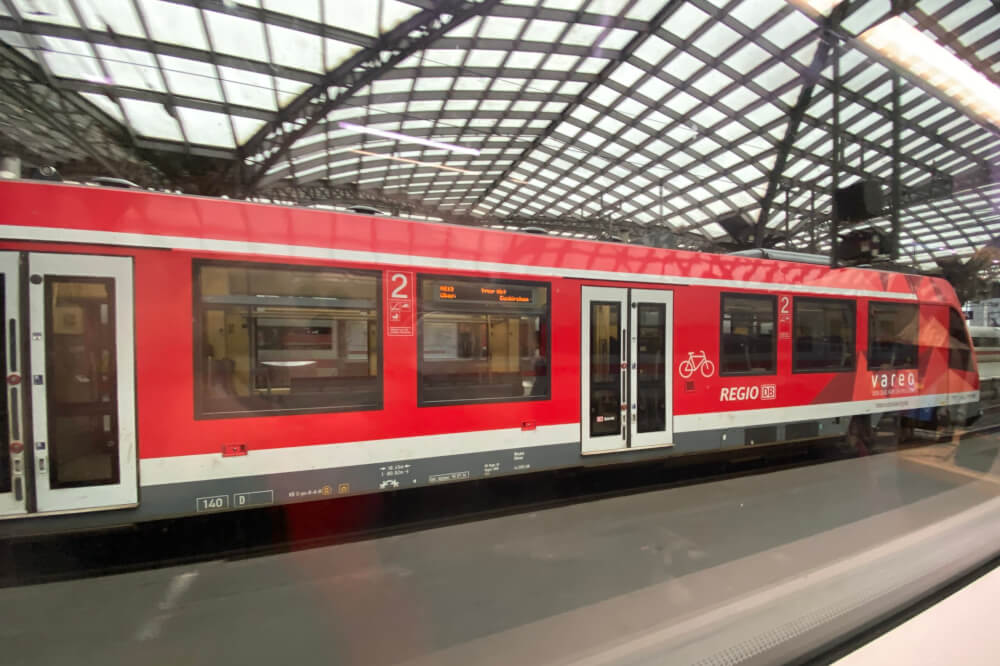
Alright with your tickets booked it’s time to move onto the day of your journey, with…
Step Three: Get Snacks
On the day of your journey, I highly recommend you get some food and drink to bring with you on the train (especially for longer trips). This is completely allowed on German trains!
While there are usually some food options on board with long distance trains, they tend to be fairly limited and pricey, so getting your own gives you more control. On regional/local trains, there is no food or drink sold on board at all.
So, at the very least, I’d get some water or something to drink. There’s often great options even at the train station itself.
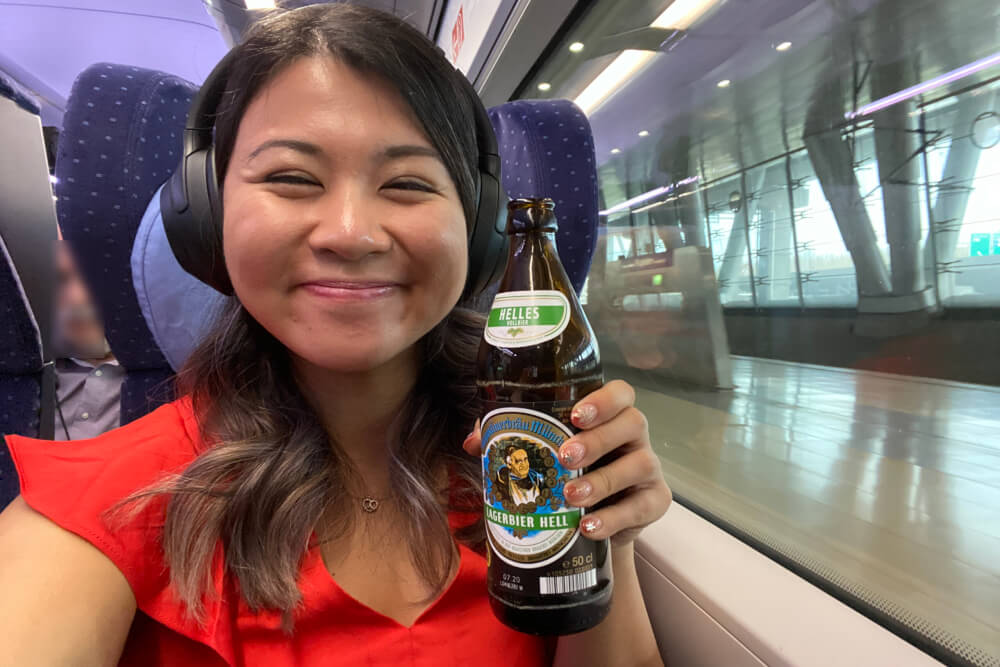
Now let’s move onto…
Step Four: Arrive at the Station
First off, before leaving, double check that you are headed to the right station. Many major cities will have multiple stations like Munich, which has its Hauptbahnhof (Main Station) as well as Ostbahnhof (East Station) and other smaller ones.
If it’s your first time at this station, and if you’re in a big city, I recommend you arrive thirty minutes or more in advance of your departure time, because main stations in cities like Berlin, Munich & Hamburg can be very overwhelming, with multiple levels, shops and 20+ platforms.

Now, if you are taking public transport and arriving at the train station in a big city, you might find it tough to find where the trains actually are, because often these stations are multi level transport hubs servicing U-Bahn, trams and buses as well.
In any case, all you need to do is look for train symbols on signs like this which will point you in the direction of the platforms:
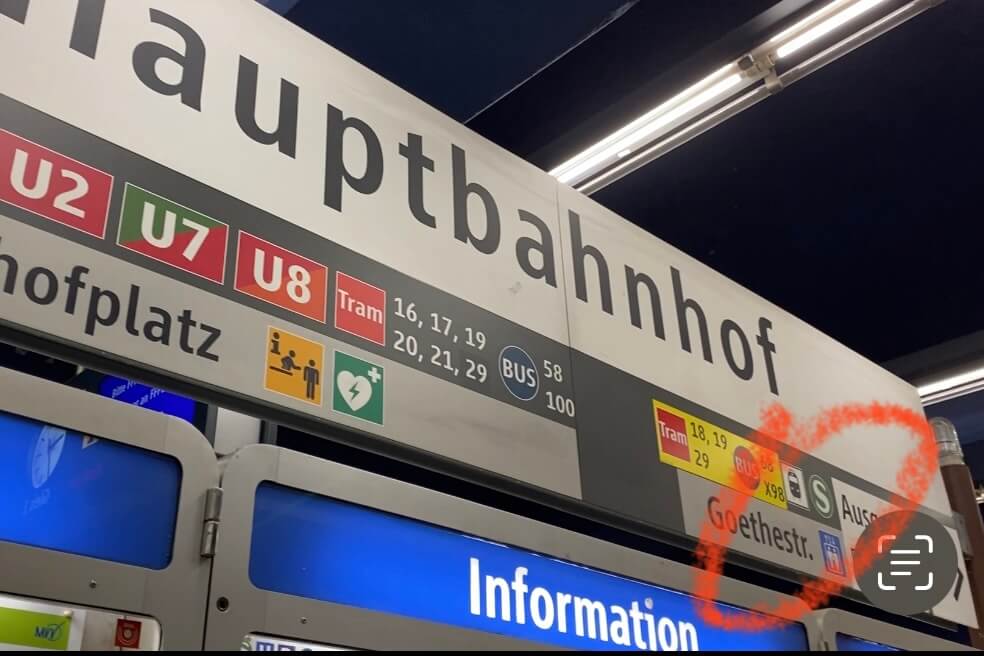
Now when you get to the station’s main concourse, your priority is finding out which platform your train is on. The Deutsche Bahn app will usually tell you in advance but I like to double check on the board just in case.
When looking at the board, remember that trains will not necessarily say your destination, but rather the final destination of the train, so if you don’t see the name of where YOU’RE travelling to, don’t panic.
Look for the time and train number, and (when available) the list of stops to see if your destination is listed, then figure it out from there. Beware that some cities like Munich and Cologne have a different name in German (München & Köln) and that’s likely the name that will show.
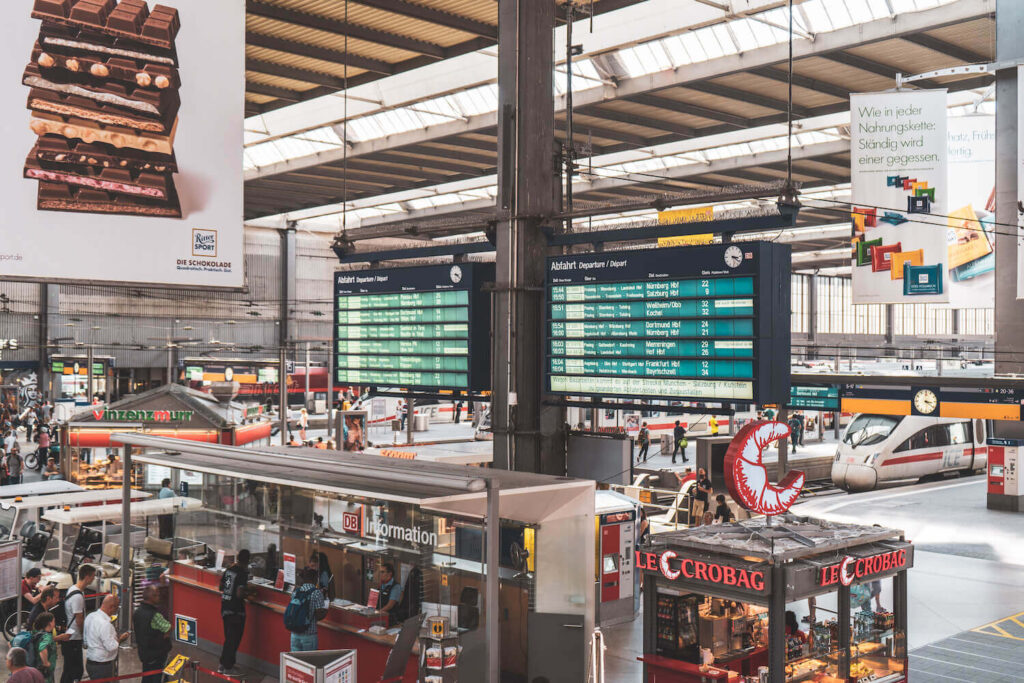
Next, it’s time to…
Step Five: Get to the Platform
Platform numbers will generally be very well marked so just look up for signs before making your way.
You will not need to have your ticket for this part, because there are no fare gates for German trains, and tickets are usually just checked on the train itself.
When you get onto your platform, double check it’s correct by confirming either on a platform screen or on the side of the train that you’re in the right place before proceeding to find your carriage.
NOTE: Some regional trains in Germany are divided trains that split at one point in the journey, which means only certain cars end up going to certain destinations. So, before you board, double check that the destination on your train carriage is actually where you want to go. In cases where the train splits, the sign will usually tell you which cars or which part of the platform to go to for your destination, so keep an eye out for that.
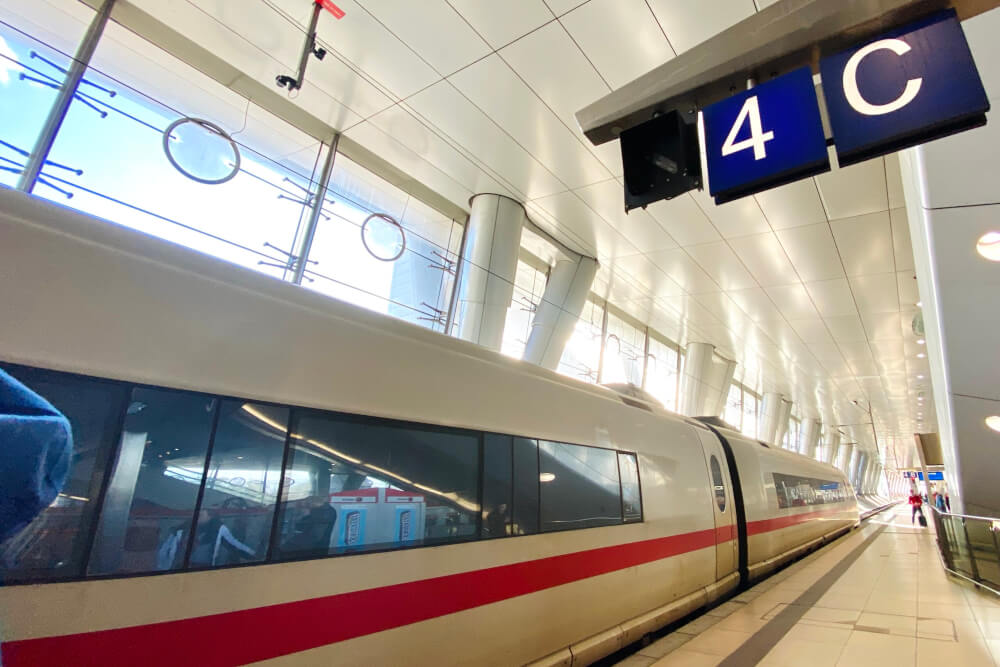
Next up, it’s time to…
Step Six: Find Your Carriage
If you have a reserved seat, then you’ll need to take some extra steps to make sure you get to the correct carriage once the train arrives.
German trains can be very long, so if you have a seat reservation, make sure you’re standing in the right part of the platform to get onto your carriage, otherwise you’ll have to awkwardly dodge and shuffle your way all throughout the length of the train.
With reserved seats, a handy thing to look out for are these charts that show you which part of the platform to stand on (marked by number/letter) depending on your carriage number.

If you do not have an assigned seat, then you simply need to board a carriage in the right class, then pick a free seat.
In these cases, look up at the platform sign and there should be a little diagram that explains which letter part of the platform to stand on for 1st class, 2nd class, and the meal car (depicted by a tiny knife and fork).
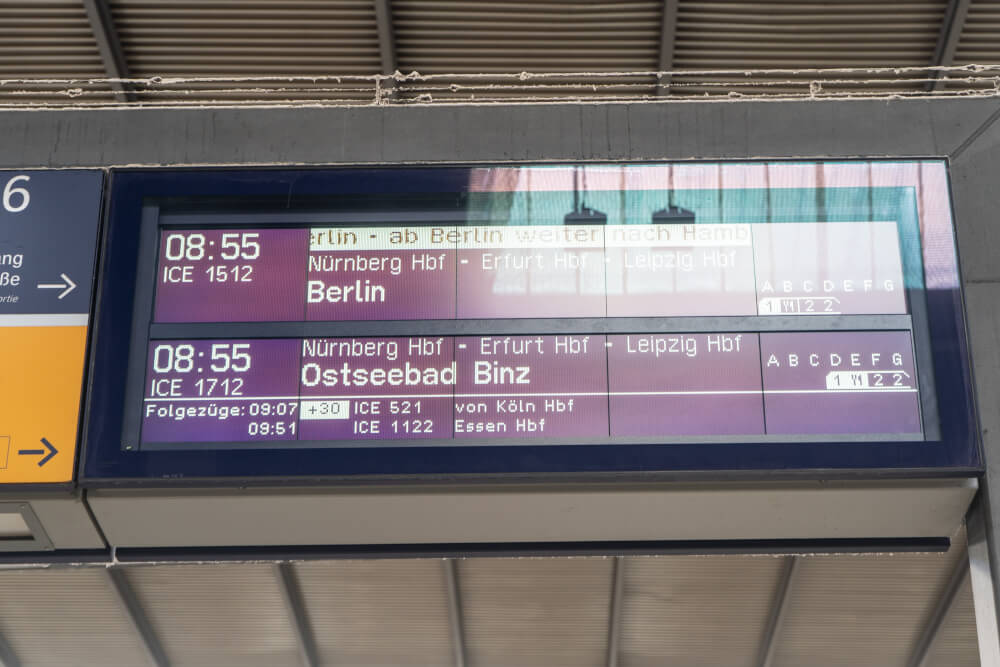
When picking a carriage to board, pay special attention to…
- The class number of the carriage (you may only board the class you’ve booked for)
- Whether they are special carriages meant for a certain purpose e.g quiet zone, bicycle zone
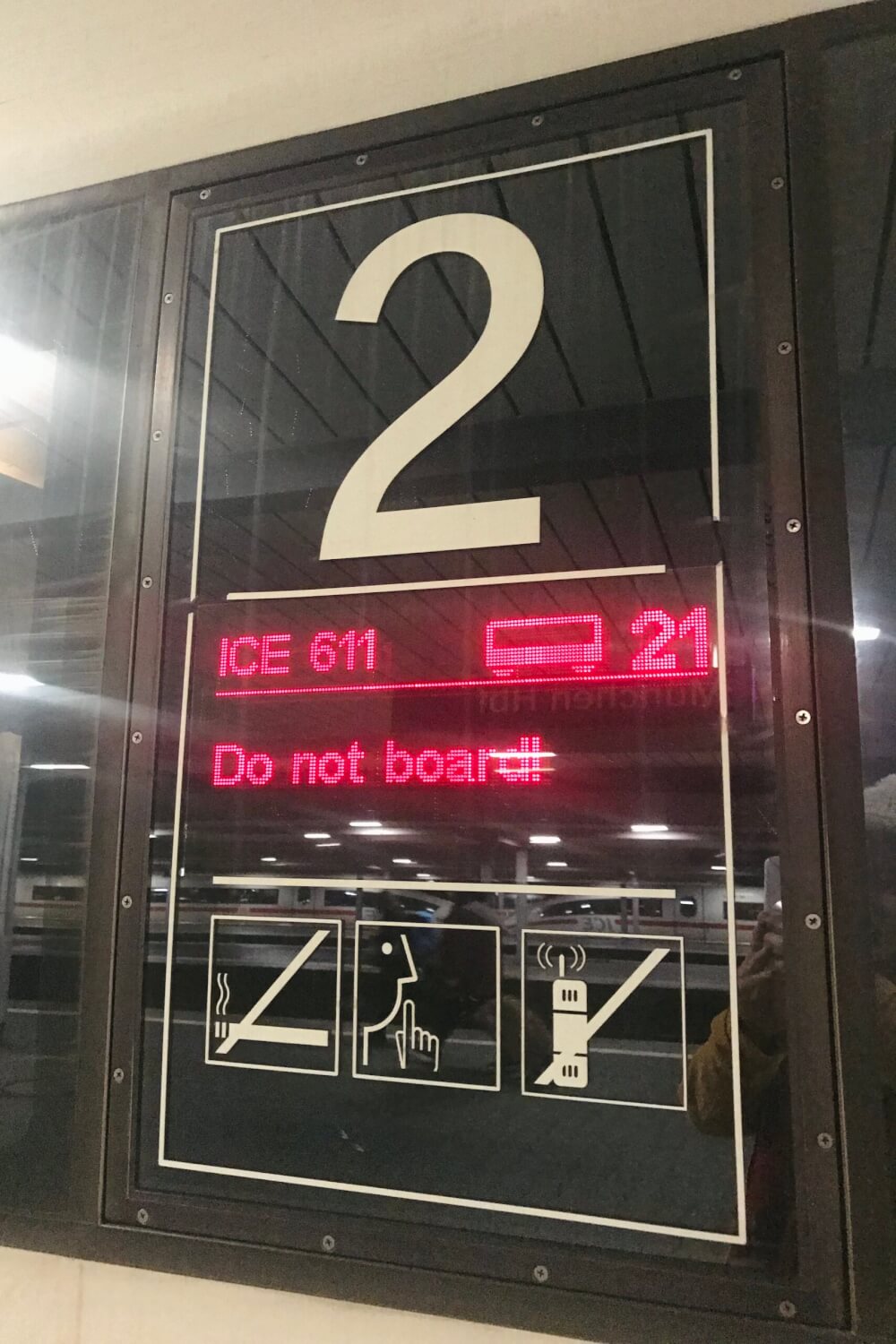
If you don’t have a reserved seat, then usually I find the farther you walk, the emptier the carriages will be.
Once you find or choose your carriage, then it’s time to hop on board.
If the door isn’t opening then look for a button like this <> and press it. This goes for the train doors as well as carriage doors.
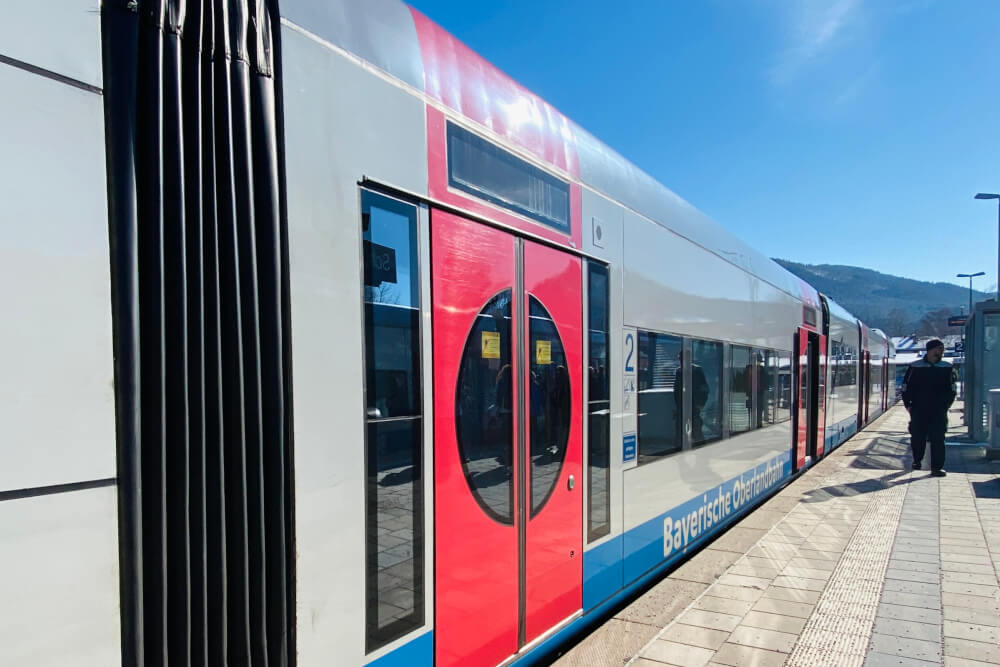
Now it’s time for…
Step Seven: Find Your Seat
First off, if your seat is assigned, try to make sure you go in through the correct door closest to your seat.
Long distance trains will usually write the seat numbers on the corresponding door, like so:
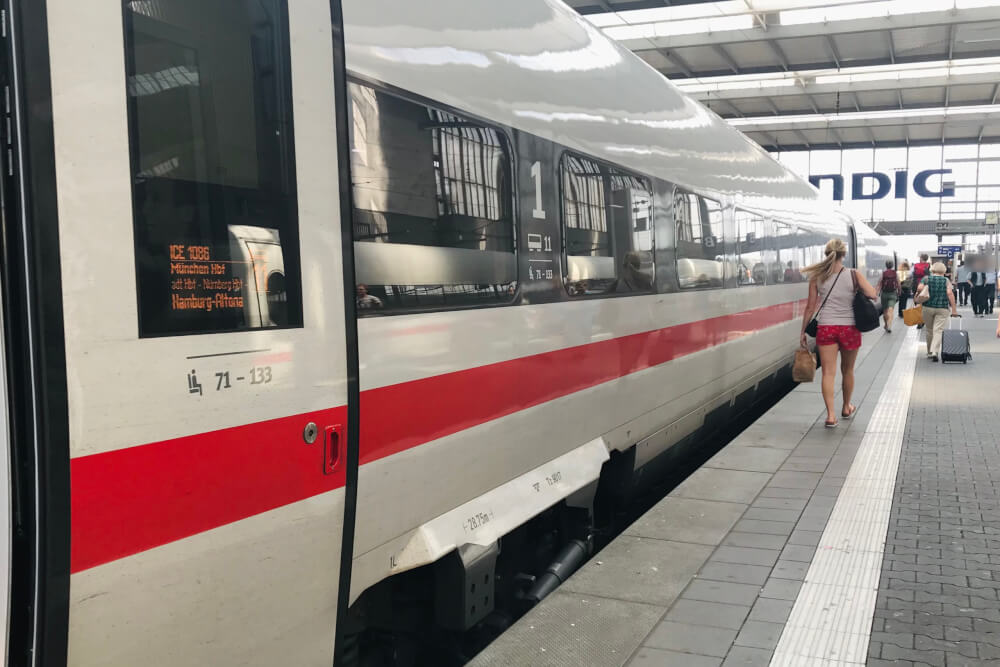
If you have large bags, keep an eye out for large luggage racks when you enter. These will usually be found on the ends of the carriages.
With smaller bags/suitcases, there is usually space above your seat for it, or sometimes under and between seats, as marked.
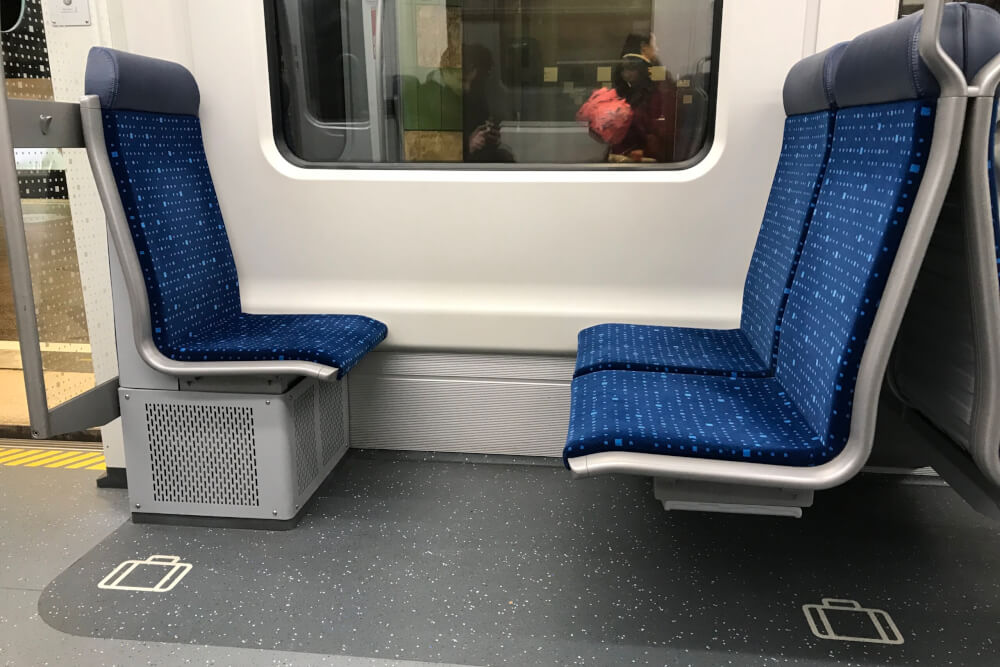
If you don’t have a reservation, before sitting down, make sure your seat isn’t reserved and make sure you’re not taking up a priority space if the train is looking full.
Seats that are reserved on long-distance trains will usually be marked on an electronic screen that shows you which part of the journey the seat is reserved for.
So let’s imagine you’re going from Munich to Berlin. The screen may show the seat is reserved for the whole journey, or for just a portion. If your journey doesn’t overlap with the reservation, then that sat is technically free.
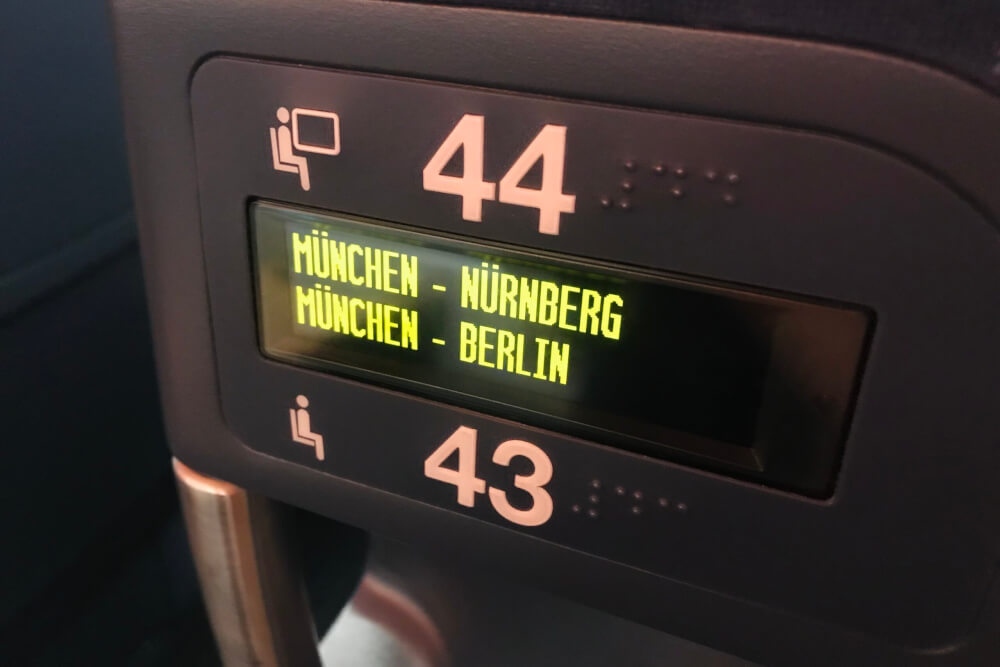
But do note however that the screen may sometimes say something else like..
- ggf. reserviert (possibly reserved)
- ggf. freigeben (possibly to release)
Both of these annoyingly mean that the seat might be reserved, or it might not, but either way you have to vacate it if the person with a reservation comes, so you kind of just have to sit there and hope for the best.
It is honestly the silliest system. To avoid this Russian Roulette of seating charts, be sure to just reserve yourself a seat. It’s worth it.
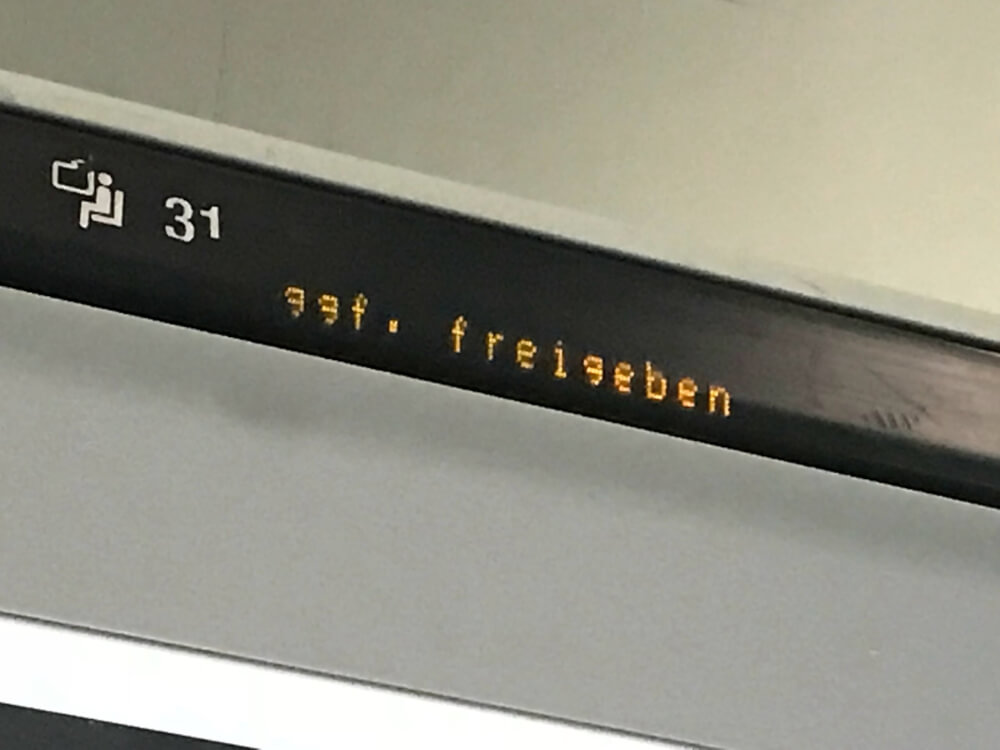
There are also some seats that are reserved for Bahn Comfort customers, i.e. VIP frequent travellers, so avoid those when you see them or an especially fancy-looking person might come kick you out of it.
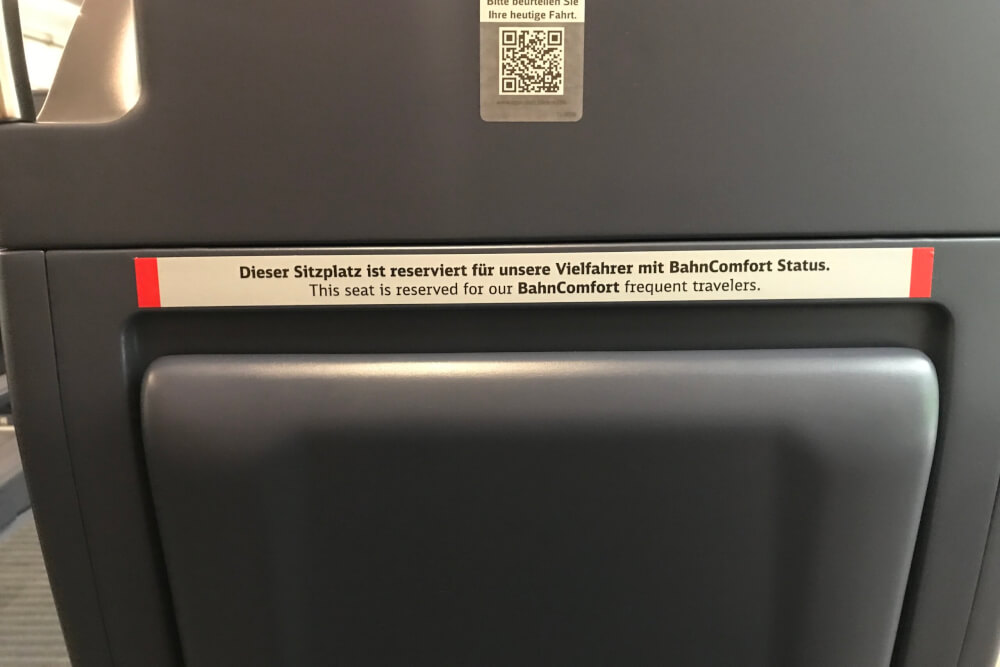
Now finally, onto…
Step Eight: Get Comfortable and Enjoy the Journey!
Once you’re all settled, you’re now in a good place to enjoy some of the hidden features and amenities of your train.
Okay, I say “hidden”, but what I mean is they’re easy to miss, especially if it’s your first time on board a German train.
So, be on the look out for…
Coat hooks: These can be found on the wall next to your seat – sometimes they may need to be pulled out. You can leave coats, scarves, etc. on those
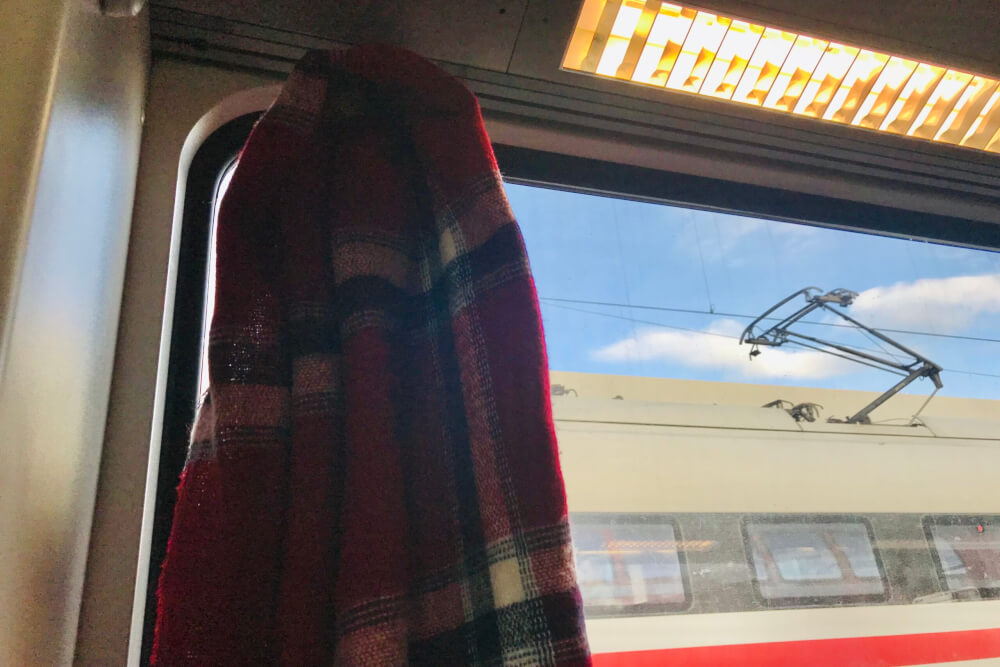
Plugs: Most trains will have an area to charge electronics. On ICE trains, usually the charging ports are in the middle part between two seats. On regional trains, the charging ports can often be found between seats or on the wall.
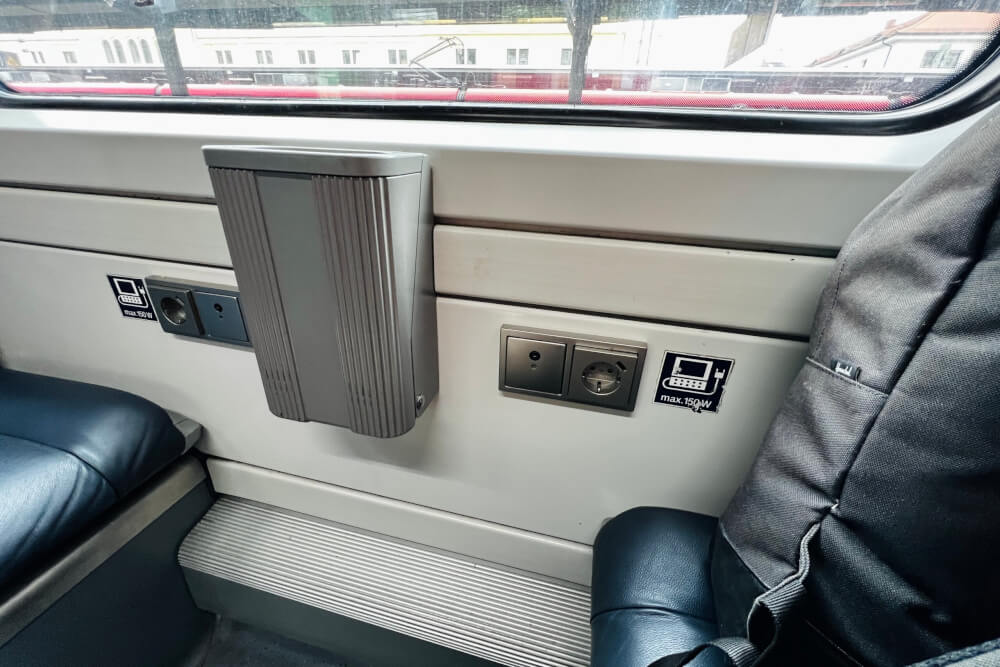
WiFi: Most long distance trains will say they have this but the quality is questionable depending on where you are. Many S-Bahn routes are starting to get WiFi too. Like with modern dating apps, be sure to try connecting, but don’t get your hopes up.

On-board restaurant or bistro: You’ll find these on long distance trains, and if you sit in first class, there’s often even table service straight to your seat.
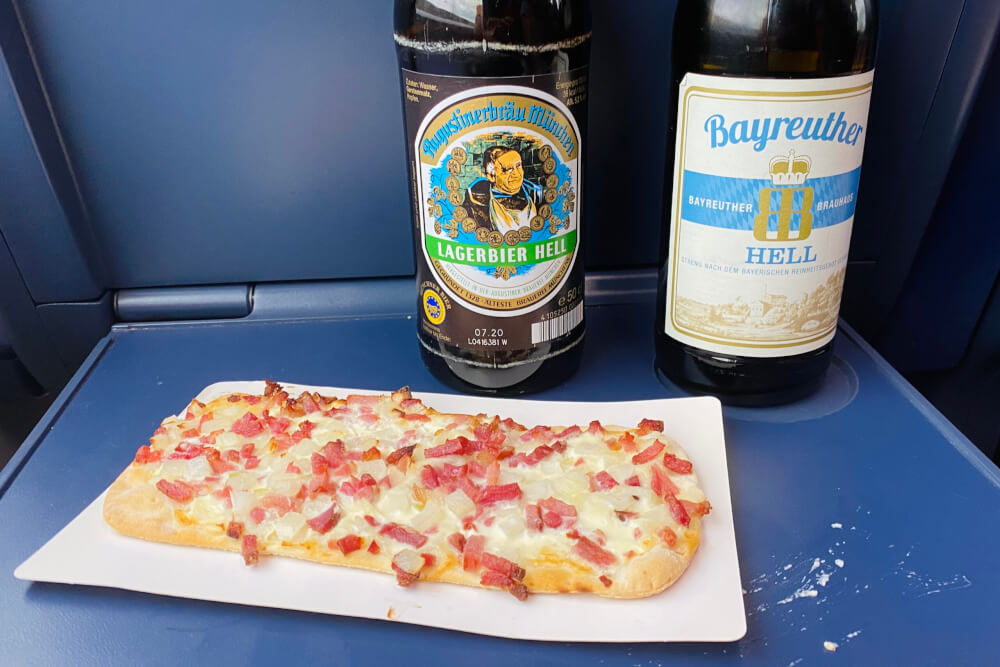
Bathrooms: And of course, don’t forget to look for the on-board bathrooms (which are free). They’re typically marked by signs saying “WC”.
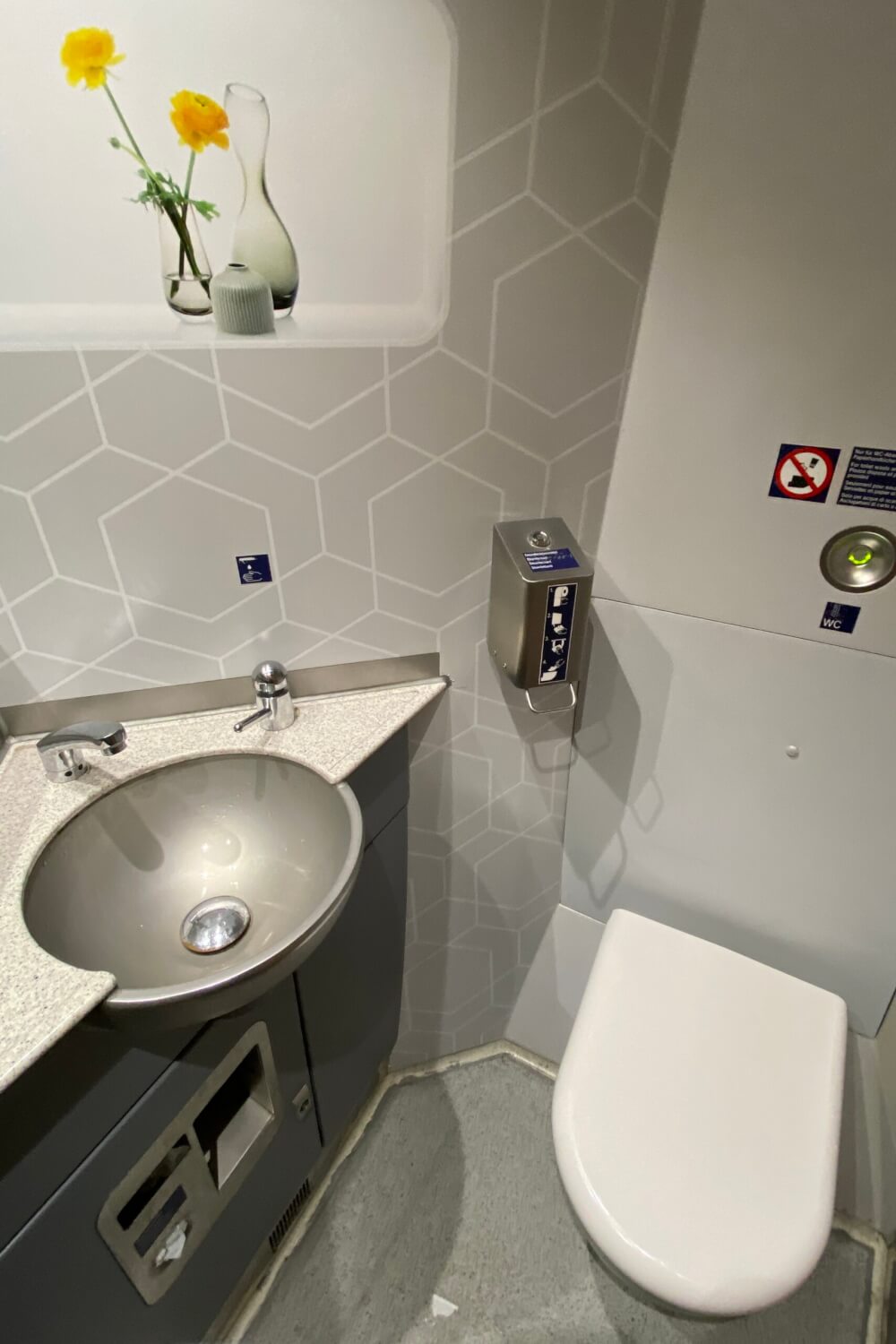
Now, as you get comfy, keep your ticket and ID handy in case controllers come on board. With long distance trains, you’re often able to check yourself in on the app so you don’t have to worry.
Otherwise, you just wait for a controller to come, at which point you show your ticket.
Getting your tickets checked by a controller tends to happen more often in high speed or long distance trains than the regional ones, but regardless just make sure you have your ticket and also some ID (preferably your passport) on you.
Sometimes they will want to verify your name if it’s a reserved ticket, and your age/residency as well depending on whether or not you’ve purchased a discounted fare.
I’ve had it before where they didn’t accept foreign IDs like driver’s licenses – only passports, so that’s why I’d recommend having that.
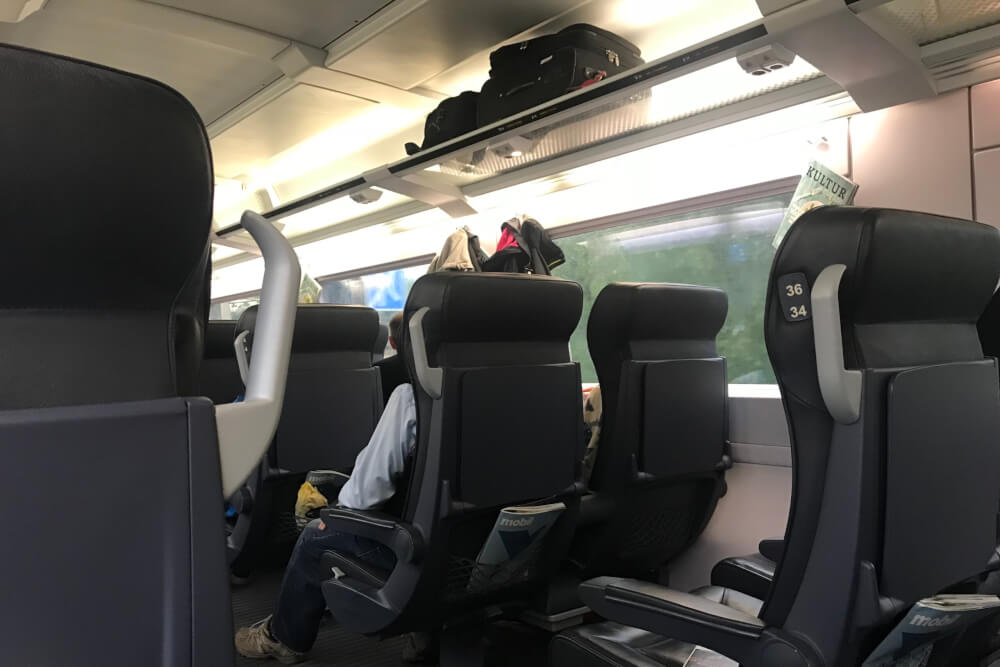
Now after your journey is complete, it’s onto…
Step Nine: Disembark
If you are not getting off at the end destination, then start prepping for disembarkation about 10 min before your arrival time. This gives you plenty of time to gather your belongings and bags in a rational, non-crazed manner.
To keep track of what time you’ll be arriving, keep an eye out for screens that show the scheduled arrival time/estimated arrival time.
Make sure you memorize the name of the stop you’re meant to get off at because most major German cities have multiple train stations and it gets a little confusing once you’re in the city. Like in Munich, you could accidentally get off at the East station instead of the Central Station, just because the names start the same.
And if you’re transferring onto another train, keep an eye out on signs/listen for announcements just before your arrive at your station because they will usually tell you which platforms to transfer on, and if there are any delays/disruptions for transfers.
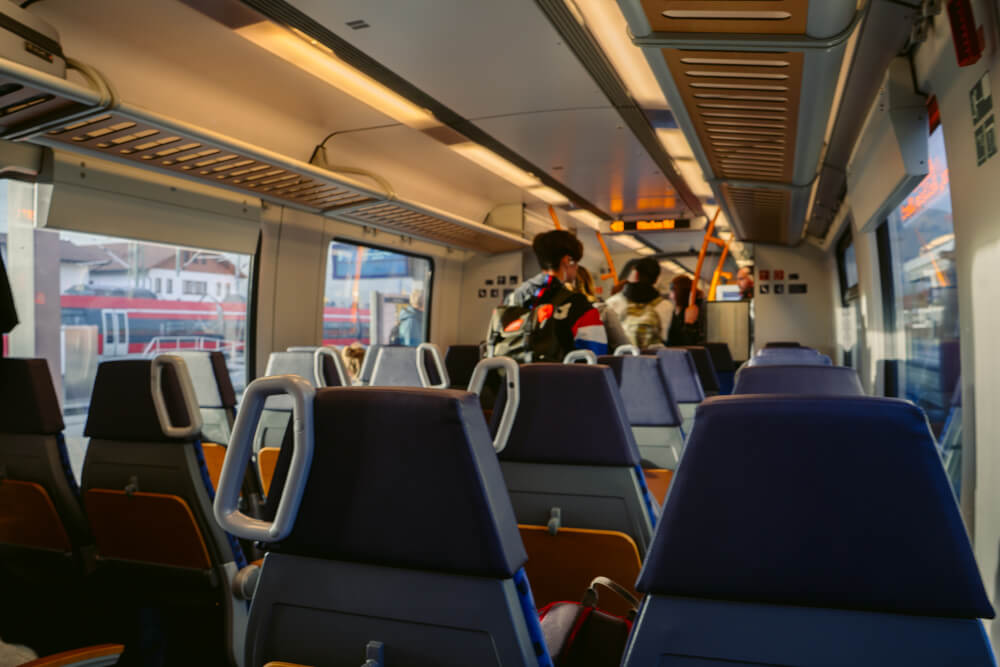
Upon arrival, if the door isn’t opening then again look for a button with the <> open symbol.
Once the doors are open, be careful getting off the train as there’s often a gap/step.
To navigate your way off the platform and onwards to wherever you need to go, keep an eye out for signs that will point you in the right direction.
If you are transferring onto another train, look around for big signs pointing to different platform numbers. If it’s a tight connection (10 min or less) you may want to speed walk or run, depending on how big the station is.
NOTE: Remember, you’re on a train platform, so to reach other platforms you need to either go via a tunnel underground or sometimes a bridge above ground. Keep an eye out for stairs/an elevator so you’re not panicking to find ways to reach your next platform.
If this is your final destination but you need a place to drop off your bags while you explore, most major train stations will have a paid left luggage area with lockers, which is great if you’re too early to check in to your accommodation, or just dropping in for the day.
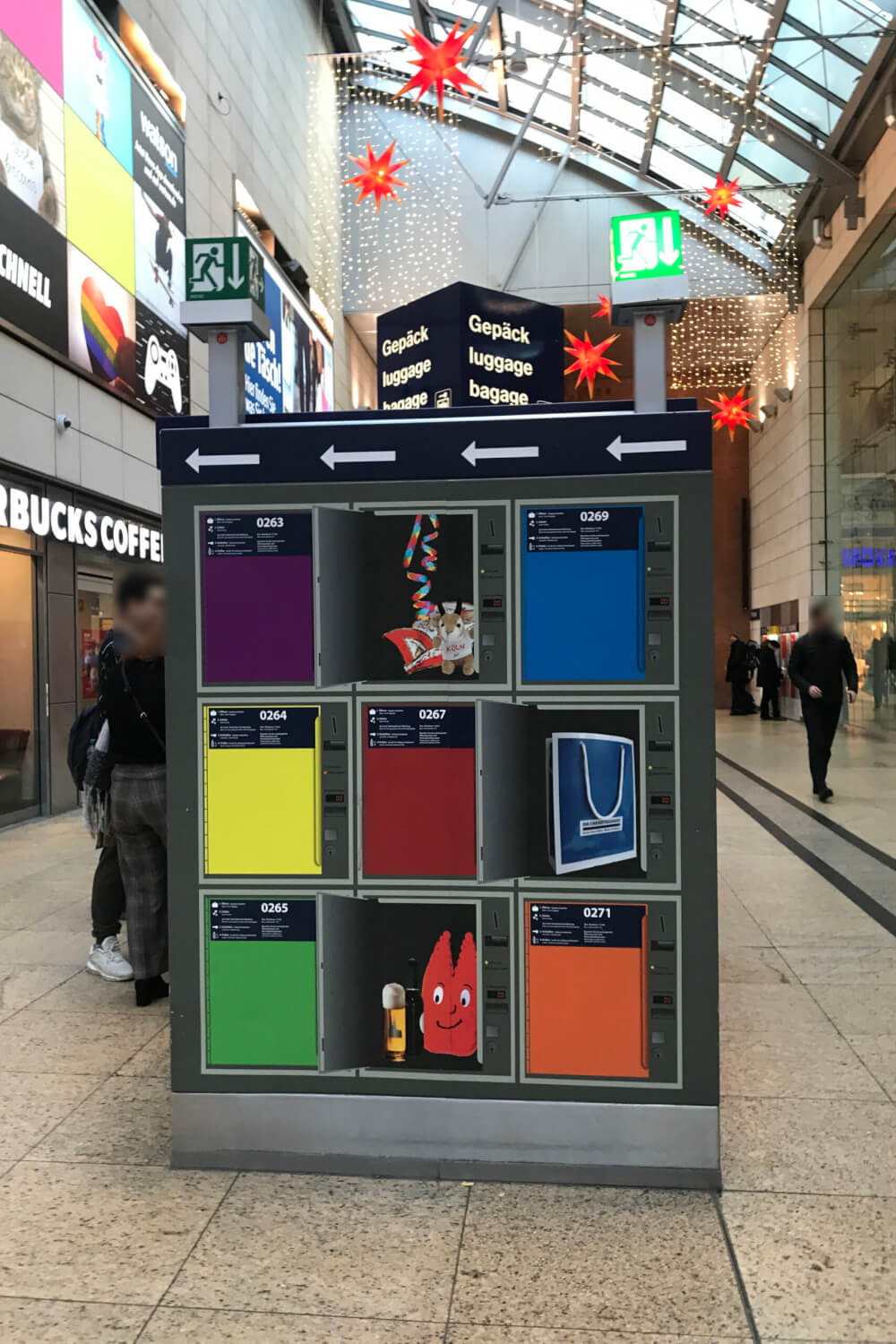
Remember that your train ticket is usually only valid for that specific train you boarded, so you won’t be able to use it for onward travel on the metro or bus unless you bought a special regional ticket or a City Ticket add-on.
Lastly, take note that in Germany, if the train is more than an hour delayed, you are entitled to compensation. Just make sure you get some proof of the delay, whether through an employee or through photos of signs showing the delay. You can then fill out a form or claim compensation through your DB app.

Final Tips for Taking the Train in Germany
Alright, we’ve gone through ALL the basics so now I’m going to simply leave you with some extra bonus tips on how to make the most of the German rail system!
Learn basic train-related vocabulary
The German rail system is very English-friendly for the most part, with many trains making announcements in English and most train attendants speaking at least some English as well.
That said, when you’re in a panicked state dealing with travel stress, sometimes it IS helpful to know some basic words, so here are a few to keep in mind that may be useful:
- Bahnhof: Train Station
- Hauptbahnhof (HBF): Central Train Station
- Gleis: Platform
- Abfaht: Departure
- Ziel: Destination
- Einsteigen : To board
- Aussteigen : To disembark
- Umsteigen : To change/transfer
- Zurückbleiben – To stand/stay back
- Endstation: Final stop
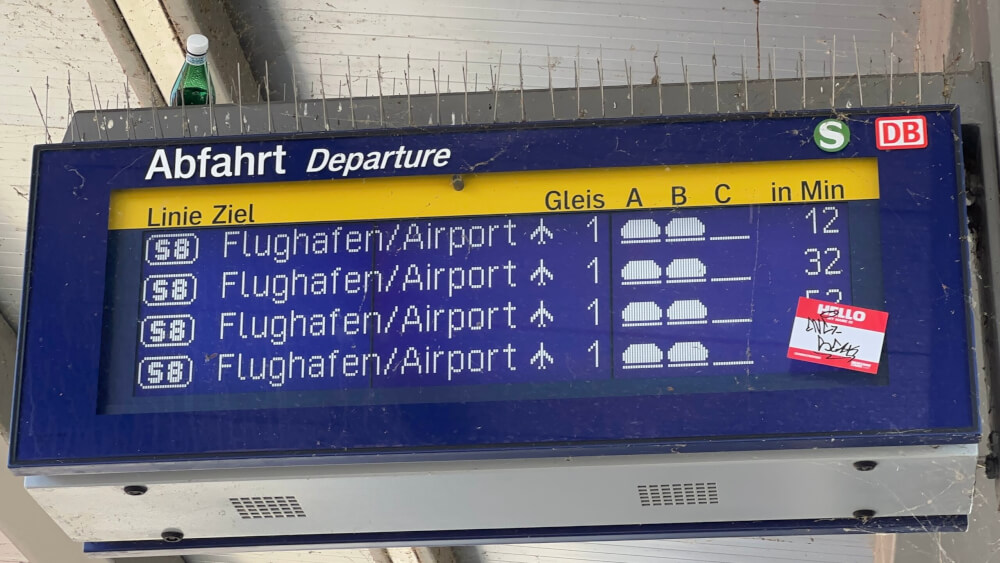
Download the DB Navigator App
I’ve said it so many times already, but the DB Navigator App is an amazing tool, and well worth downloading even if you’re only taking a few trips.
Google Maps does sync train info but it’s sometimes inaccurate or incomplete. The DB Navigator app is free and simple to use, plus it unlocks a bunch of bonus perks like self check-in. Highly recommend!
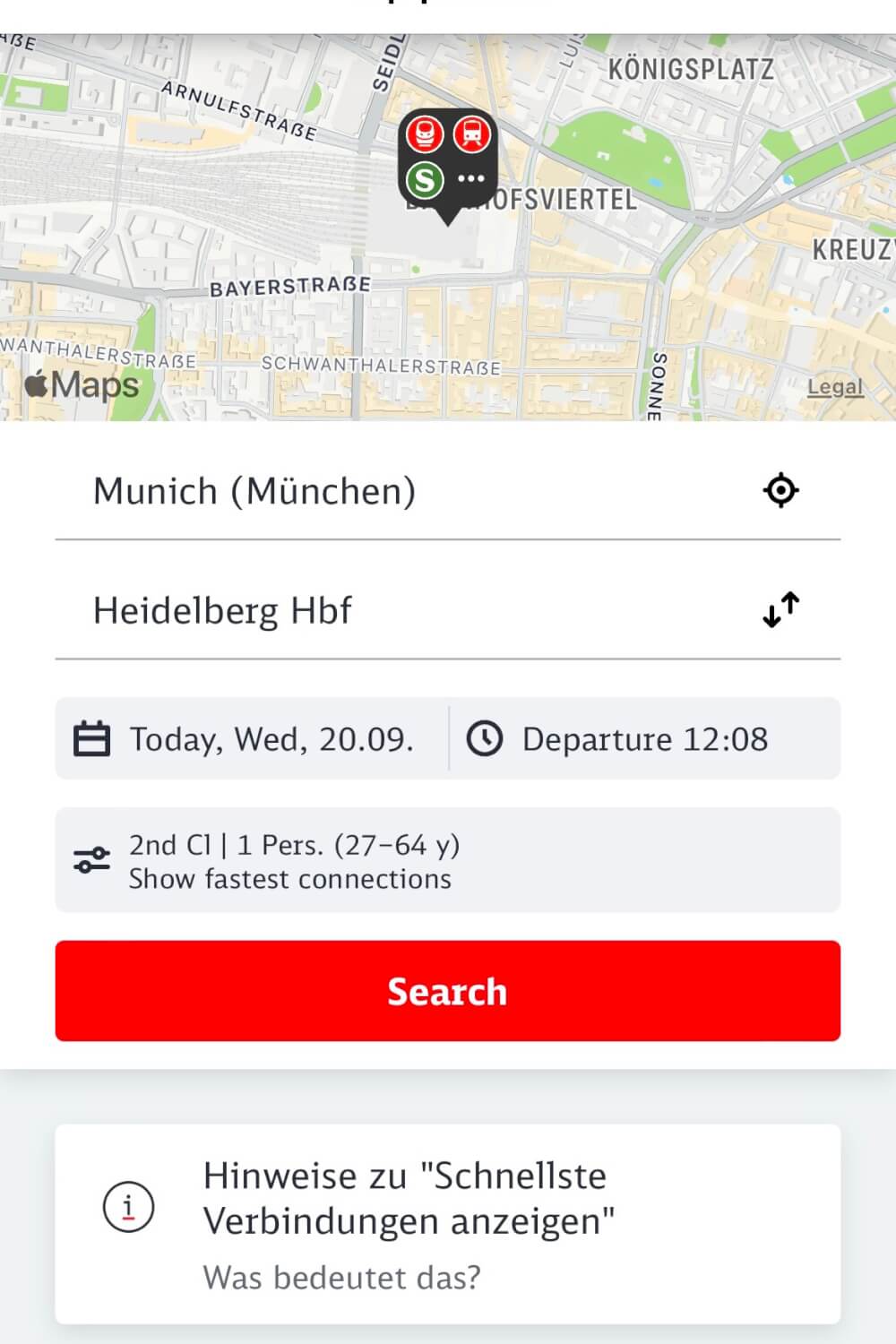
Make use of helpful search filters to find the right train
If you’re struggling to choose which trains to get, then the good news is there are many helpful tools built into the DB website/app.
If you’re travelling exclusively with a Regional Ticket or Deutschland-Ticket for instance, it may be helpful to click on “Mode of Transport” and then set it to “Local Transport Only” which will then filter out high speed trains and show you only the trains you can take with one of those tickets.
You can also ask them to only show the fastest connections, direct services only, trains with a minimum transfer time, or even specify what stopovers you want.
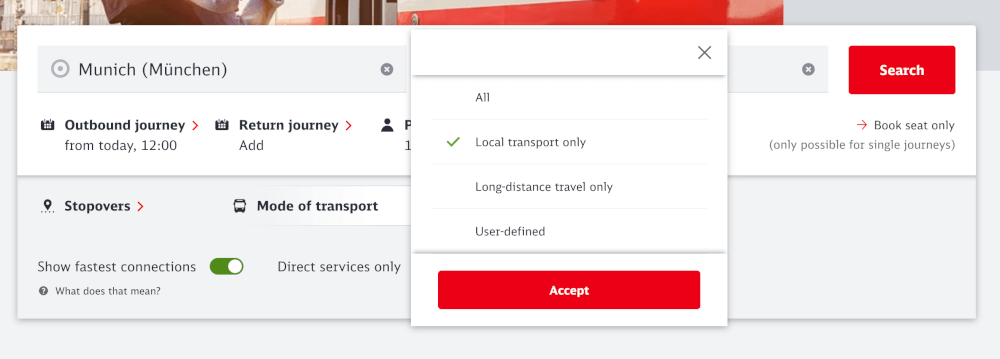
Avoid peak times
As a tourist, you have the luxury of flexibility, so try to plan your train trips around when other people aren’t travelling.
This will ensure the least stressful experience, and make sure you have room for you and your bags.
Some times to avoid include:
- Early morning (to avoid business travellers)
- 3-4pm during school days
- Early evenings just after work (again, to avoid business travellers)
- Weekends (Friday & Sunday evenings, plus Saturday & Sunday mornings especially)
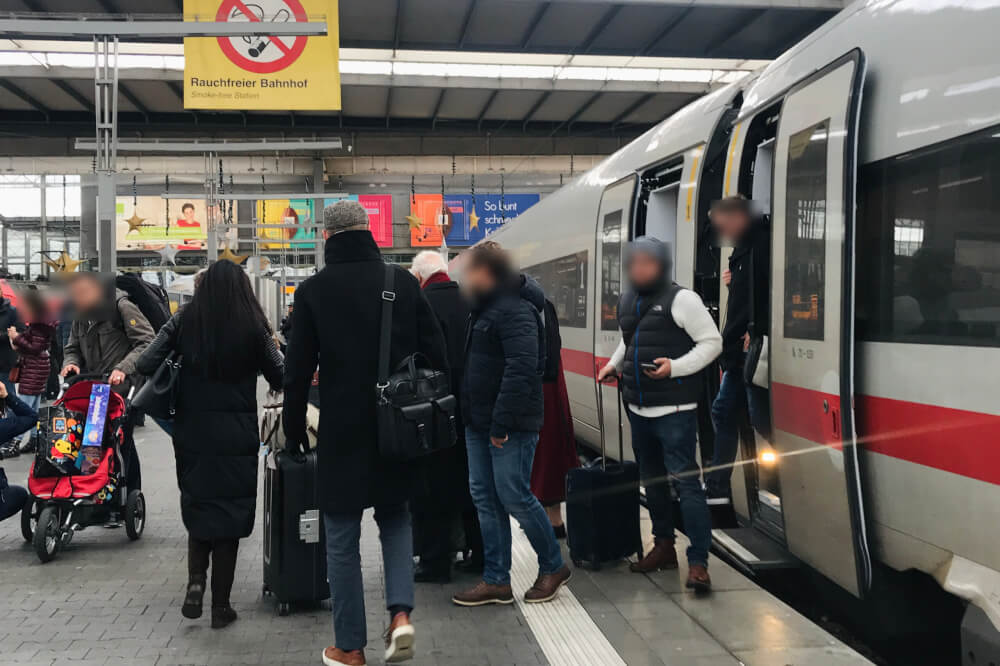
Use the bathroom on the train – bathrooms at the station cost money
As I mentioned in my Germany must-knows post, free public restrooms are quite rare in Germany, which means you’ll usually have to cough up 50 cents or more to pee at train stations.
NOTE: If you do end up using a paid train station toilet, usually the machine will print you a little coupon to use on a future purchase, so if you need to go, head to the toilet first before buying your train station snack.
Luckily, trains on board are free! So take care of business before disembarking.
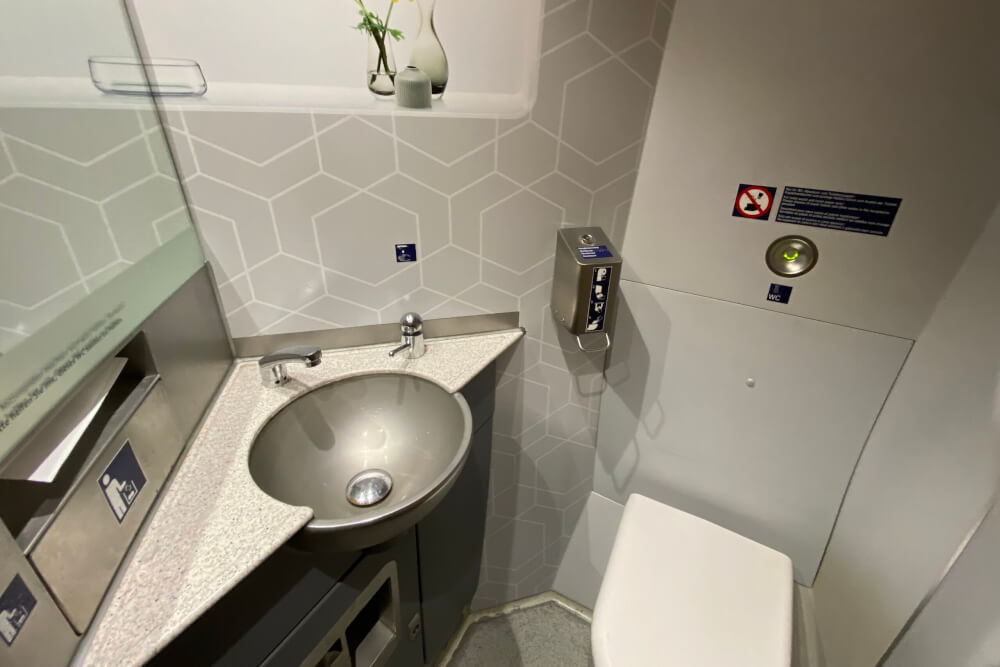
Don’t forget ID
Again, remember to have ID on you, even if it’s just a little day trip. Sometimes they will ask to see it.
NOTE: You might assume a driver’s license is okay, but I’ve had several instances where they’ve insisted on a passport because they don’t recognize foreign IDs.
It kind of depends on who checks you and how cranky they’re feeling that day, but if you’re from outside the EU, it’s a safer bet to just bring your passport… especially because it’s Germany, and your train might accidentally cross into Austria or something without you noticing.
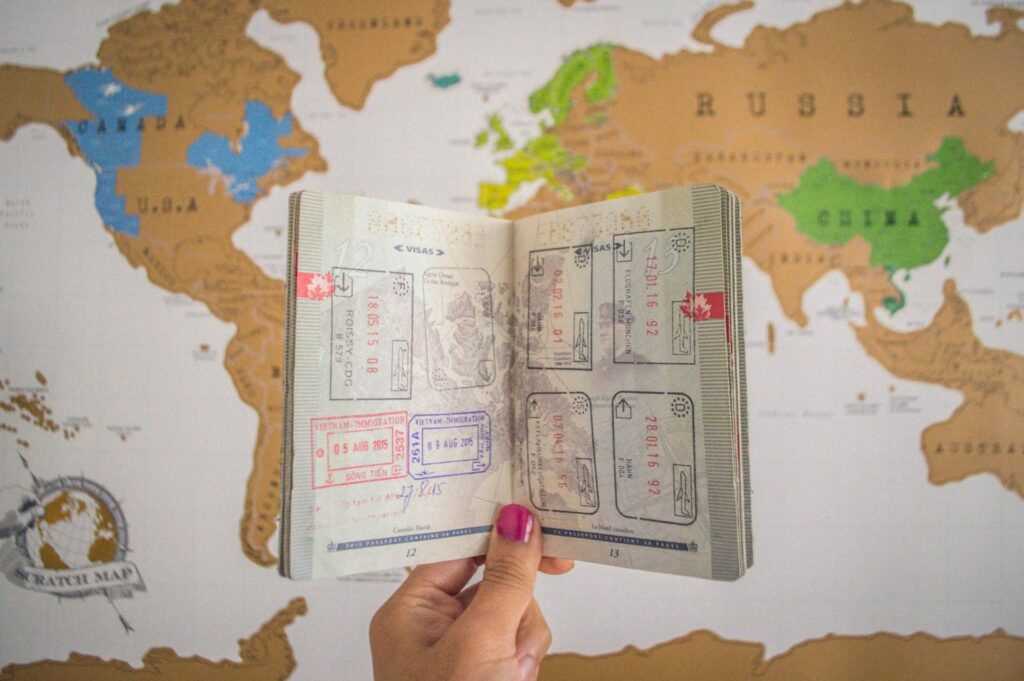
Beware of putting your bag in places you’re not supposed to
One time, I had a suitcase that was too huge and heavy to put in the overhead compartment, so I left it in the bike zone as no one was using it.
About an hour later, a cyclist got on and shouted at the top of his lungs “WHO IS THE HUMAN TRASHBUCKET THAT LEFT THIS SUITCASE HERE?” (Okay, just kidding – my German is bad and he probably didn’t phrase it like that but his tone did).
I was terrified, and was sitting pretty much right next to the suitcase. I had to meekly say it was mine and had the poor dude next to me try to hoist and cram it up in the overhead shelf.
I still have nightmares about it to this day.
So yes, don’t leave your bags where they’re not meant to be.

Learn the names of your destinations in German
Most places like Berlin or Frankfurt have the same name as in English, others like Munich (München) or Cologne (Köln) have a different name in German, so make sure you know the German name of your destination, and how to say it in German in case you need to ask for directions.
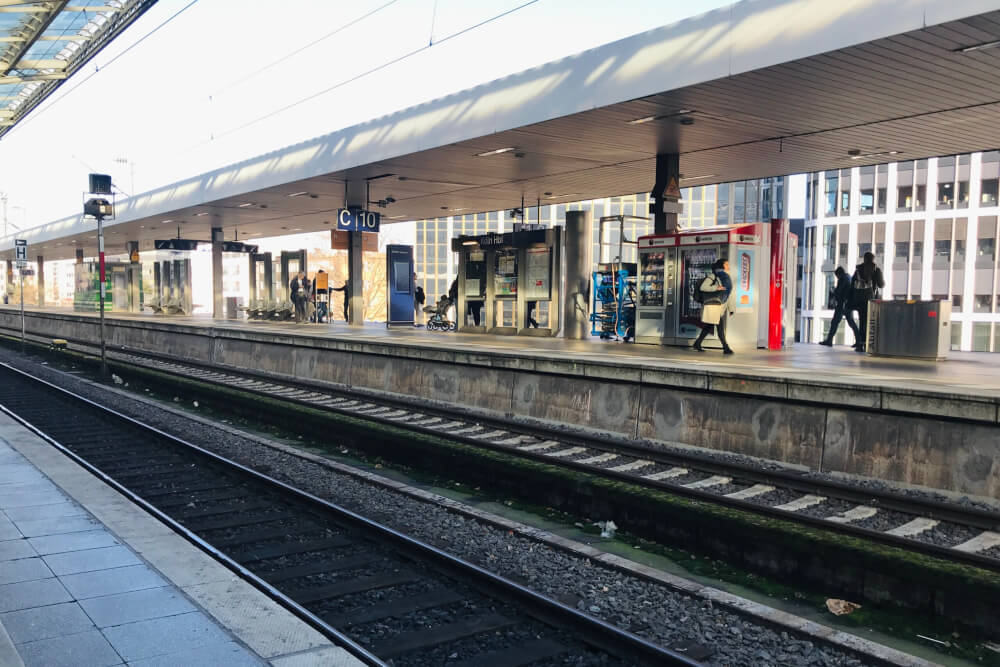
Similarly, learn how to say the names of trains the German way
For instance, ICE trains are not “ice” trains, but rather pronounced Ee Tsay Ay, like the German way of spelling it out.
Be sure to also ask for the U-Bahn, not the subway or Metro.
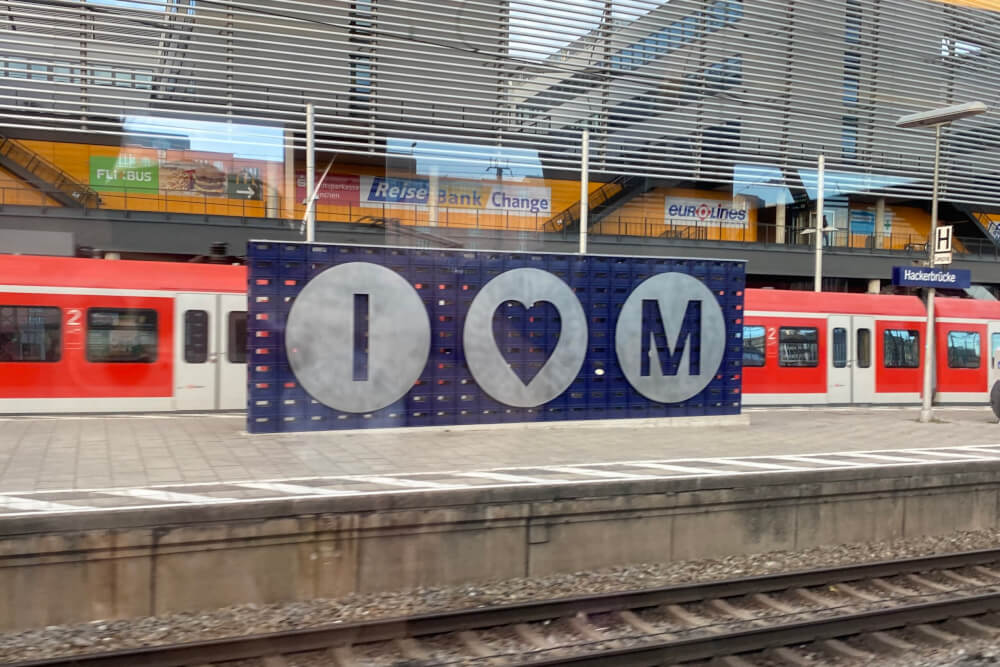
Don’t bank on the WiFi
The WiFi on German trains is hilariously bad considering how much you pay for those tickets… but yes, don’t rely on having WiFi (like setting aside a bunch of work to do on the train that requires it).
Cell service tends to be quite poor as well once you’re away from the big cities.
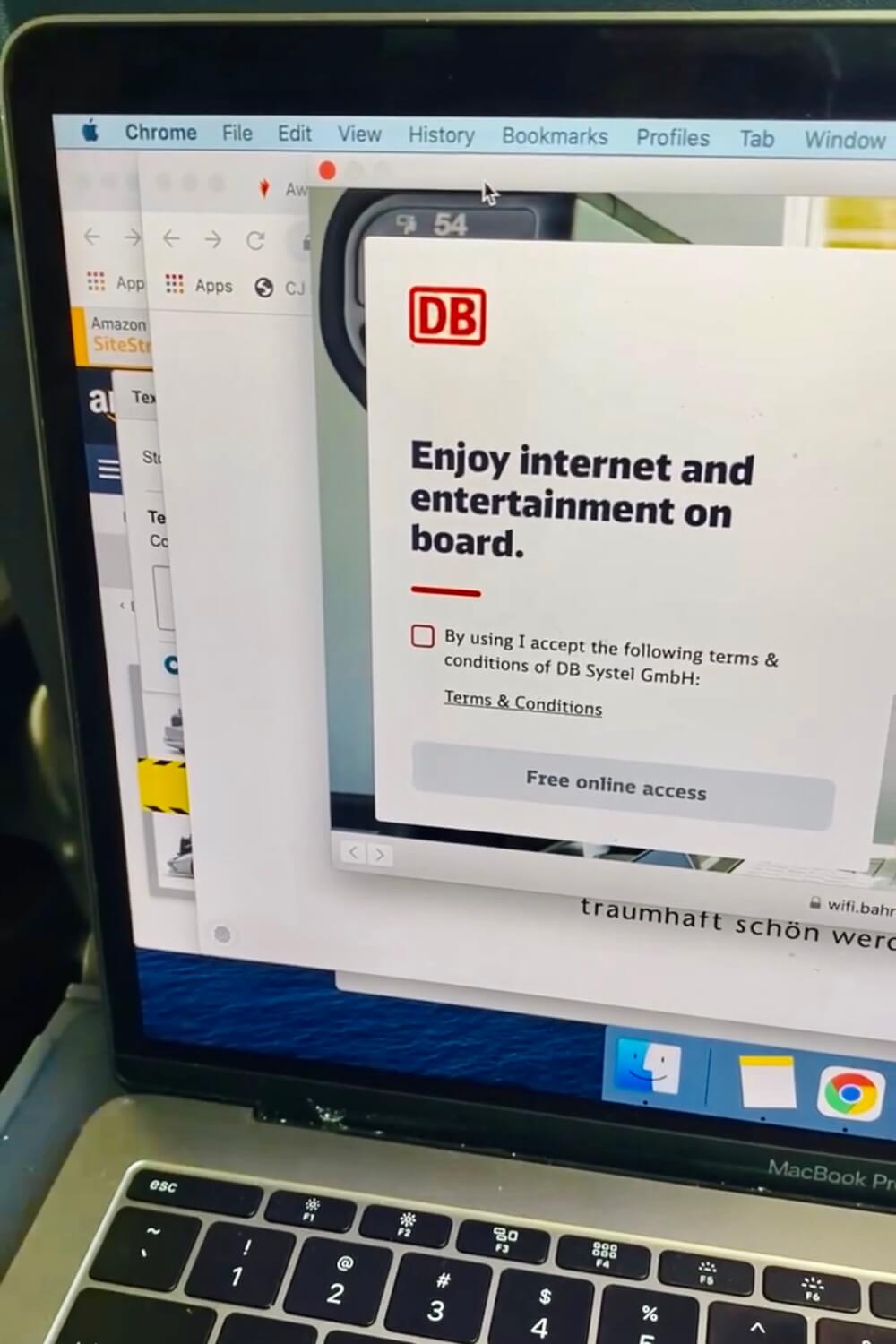
Know your route and stops
The last thing you want to do when travelling by train in Germany is relying solely on the announcements to know when to get off or what to do.
Seriously, mumbling seems to be a skill requirement for workers of DB. Mixed in with ambient train noise and the screeching of rails, I have had it far too many times where I’ve been unable to hear anything the conductor is saying.
They also seem to randomly translate in English when they feel like it, so a translation isn’t guaranteed if you don’t speak German. So, make sure you know your route and approximately when you’ll need to get off, transfer, etc.

Beware of “on demand stops” where you must press a button for the train to make your stop
Very rarely, you may come across stops that only stop when someone requests it. These are known as Bedarfshaltestellen .
This shouldn’t be a concern unless you’re travelling to very small, quiet stations, so I wouldn’t worry too much, but if you notice anything on your ticket that mentions the word “Bedarfshalt” or any signs that say “”Der Zug hält nur bei bedarf” (the train only stops on demand) then be prepared to press a special button before your stop, kind of like on a bus.
If you are boarding at one of these Bedarfshaltestelle , then don’t worry – the train will stop so long as they see you on the platform.
I had this (stressful) experience when I travelled to Untergrainau:
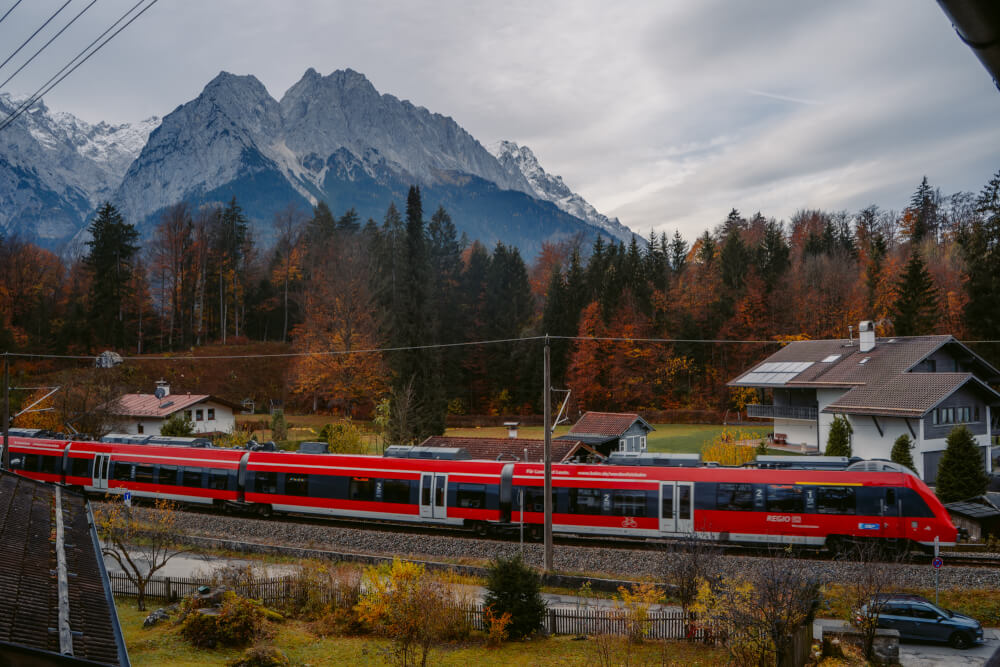
Always read the fine print
Lastly, especially when buying discounted offers for German trains, be sure to read the fine print!
With regional tickets for instance, it’s very common for there to be time restrictions on when the ticket is valid, or when it expires.
Likewise, there’s often restrictions on which types of trains you can take with your ticket, so be sure to read up on these or you may be fined as your ticket will be considered invalid.
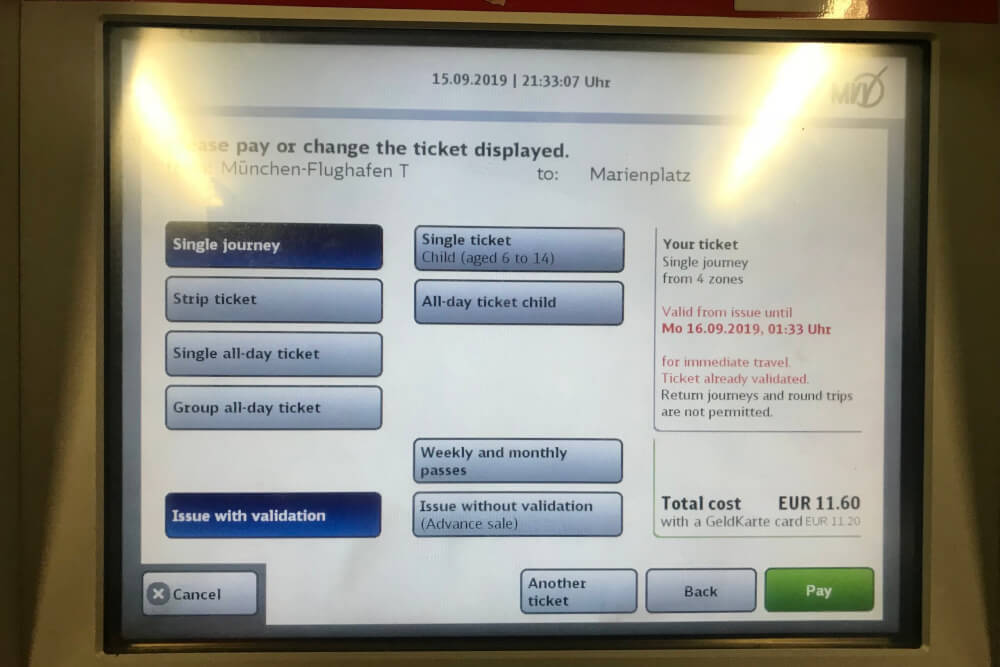
I Hope This Step by Step Guide on Taking Trains in Germany was Helpful!
Let me know in the comments if you have any more questions.
My Go-To Travel Favourites:
🧳 Eagle Creek: My favourite packing cubes
💳 Wise: For FREE travel friendly credit cards
🍯 Airalo: My go-to eSIM
🏨 Booking.com: For searching hotels
📷 Sony A7IV: My (amazing) camera
✈️ Google Flights : For finding flight deals
🌎 WorldNomads: For travel insurance
🎉 GetYourGuide: For booking activities
2 thoughts on “How to Take the Train in Germany: A Step by Step Guide!”
Thank you so much for putting this post together. This was extremely helpful for planning some train travel in Germany. The information is really clear and the pictures are super helpful.
So glad you found it helpful!! Safe travels 🙂
Leave a Comment Cancel reply
By using this form you agree with the storage and handling of your data by this website. *
- Travel recommendations
- The taste of travel
- Tips & tricks
- Travel experiences

3 amazing Germany road trip ideas

Fancy a vacation on the road in the home country of the famous Autobahn? How about a Germany road trip? In this article, I share three exciting routes for a great road trip during a German summer or to see the best Christmas markets in December.
Even if you only have a week, there is much to do and see along the way. I am also giving you tried and tested tips to set your road trip budget and for choosing the best rental car.
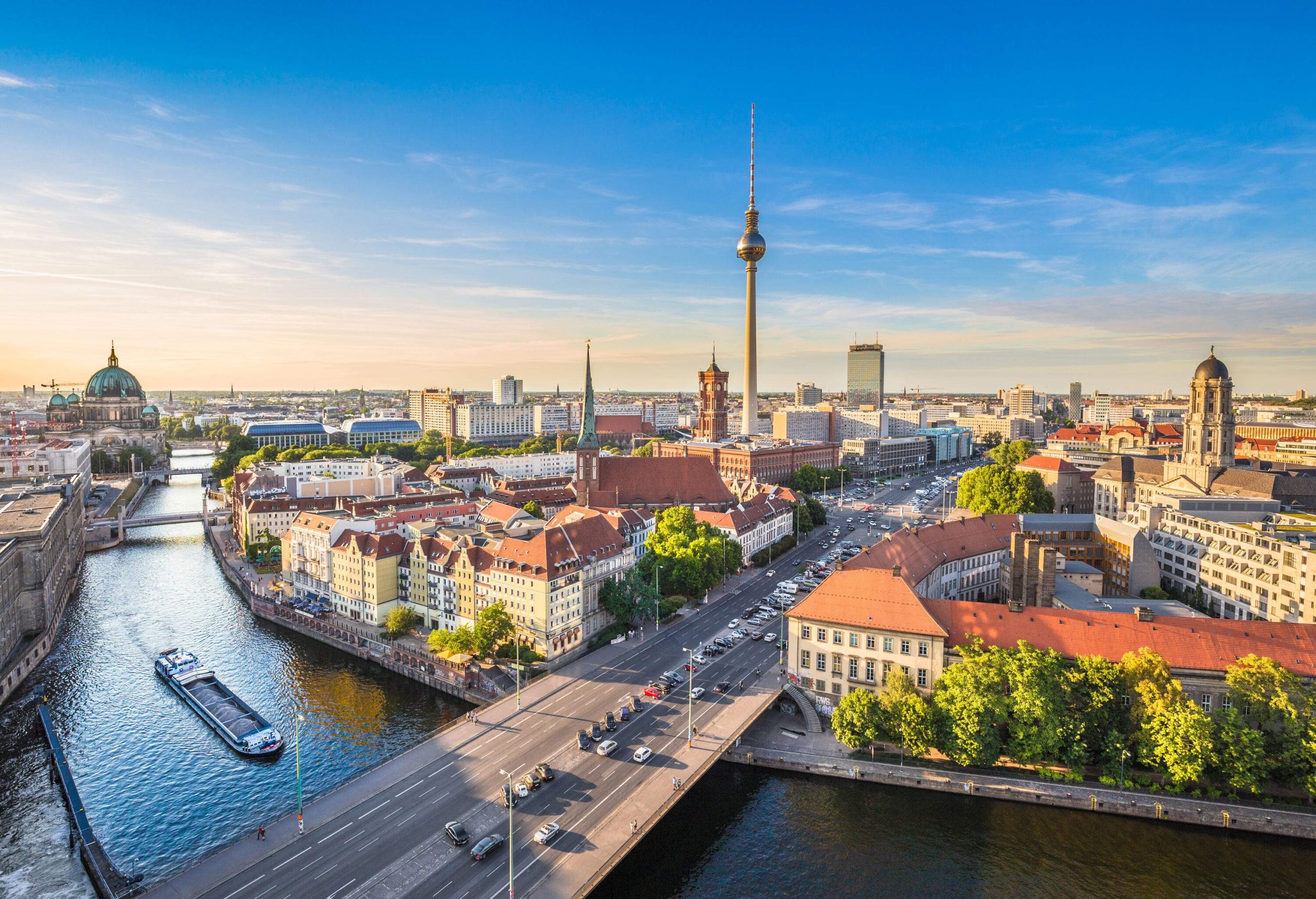
In this post
The best time for a Germany road trip
Average budget for a germany road trip, how to get to germany from the us, the best rental cars for a road trip in germany, germany road trip itinerary - from the north sea to the baltic sea, round trip germany from munich - mountains, lakes & castles, 7 days to the most beautiful christmas markets in germany, general tips for your road trip in germany.
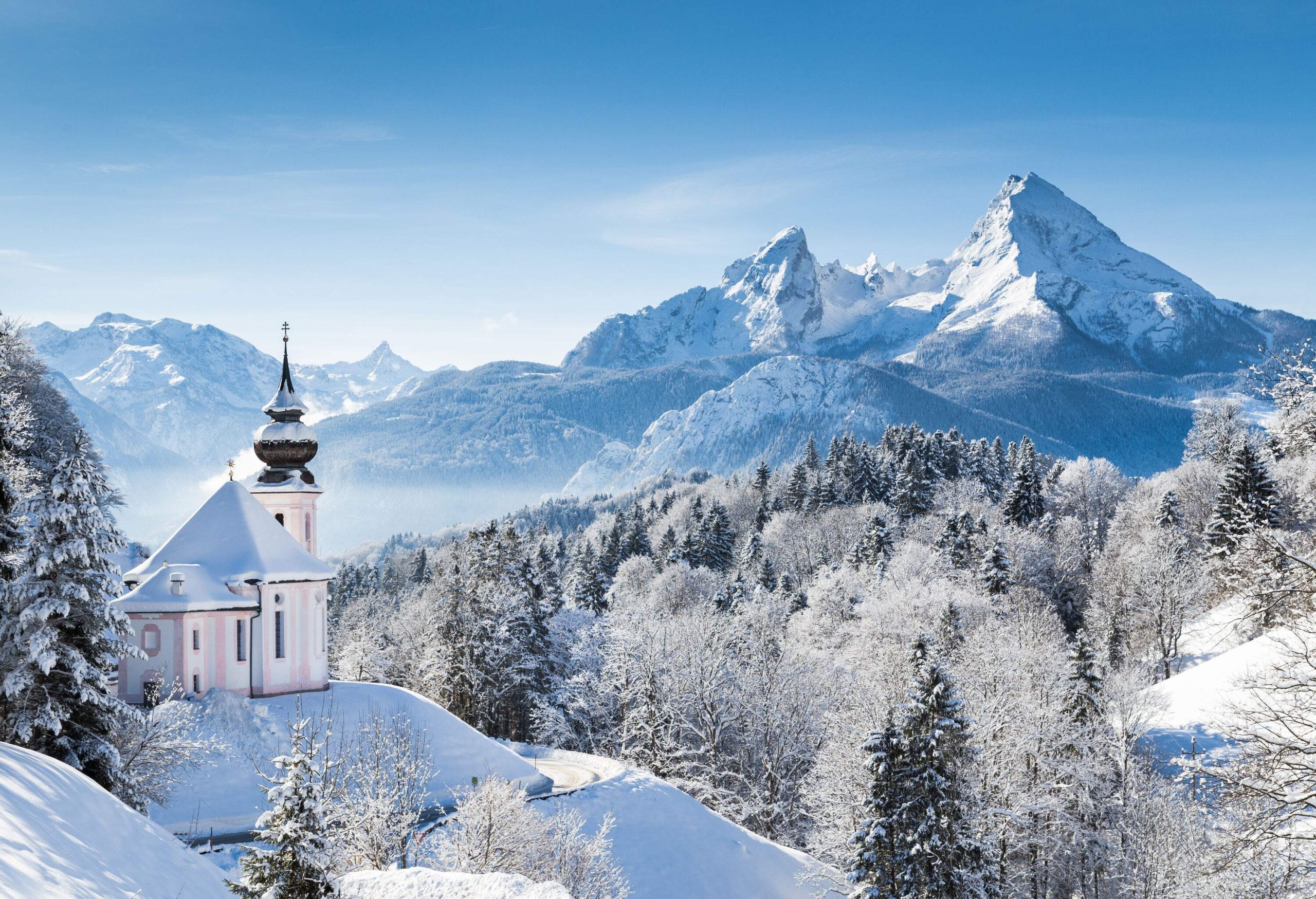
The most popular time to travel in Germany is from May to July when temperatures soar and the sun is out. However, December is also a favorite as the whole country is in a festive mood and the Christmas markets open their doors.
If you are planning a road trip through Germany, you shouldn't wait too long to book a hotel during these months. The best ones book up quickly, especially during vacation times and on weekends. You also shouldn’t wait too long to book your flight and rental car.
Speaking of vacation: Before you set off, you should take a look at when school vacation starts. German kids get six weeks in the summer and the period varies slightly in the different states. This way you can start your trip a few days earlier or later and avoid traffic jams on the highways. Keep this in mind when driving on the weekends too as roads get very crowded on Friday and Sunday afternoons.
The recommendations provided here are based on travelers’ searches on KAYAK, and on the average temperatures provided by weatherbase.com.

Before you set off, you might want to know how much a road trip in Germany will cost. We have compared hundreds of providers on your behalf and compiled average prices:
- Average price for a double room in Berlin: $152 per night
- Average price of a bed in a hostel in Berlin: $73 per night
- Average price of a rental car in Berlin: $75 per day
- Price for a gallon of gas in Berlin: $7.35*
*As of March 2024
For a seven-day road trip in Germany, during which you will cover approx. 560 miles, you should expect a total budget of approximately $900 per person based on two travelers sharing. This includes your taxes but not your flights. Also, there are no road tolls in Germany for regular cars so you don’t have to worry about these extras.
You can save on accommodation if you look for a hotel that is not directly in the city center (this is also usually better for parking).
Depending on which road trip itinerary you want to follow you may want to pick a flight that takes you to the starting point of the route. Most airports have rental car counters so you can start your Germany road trip as soon as you land.
There are plenty of flights from the US to Germany. Berlin is the capital and you can find roundtrip flights from NYC for an average of $871 and from LAX for $1066. However, you might have better chances for a direct flight to Frankfurt or Munich depending on your departure airport at home.
If you are doing the northern route that starts in Hamburg you will need to book a connecting flight with a layover. There are currently no direct flights from the US to Hamburg.
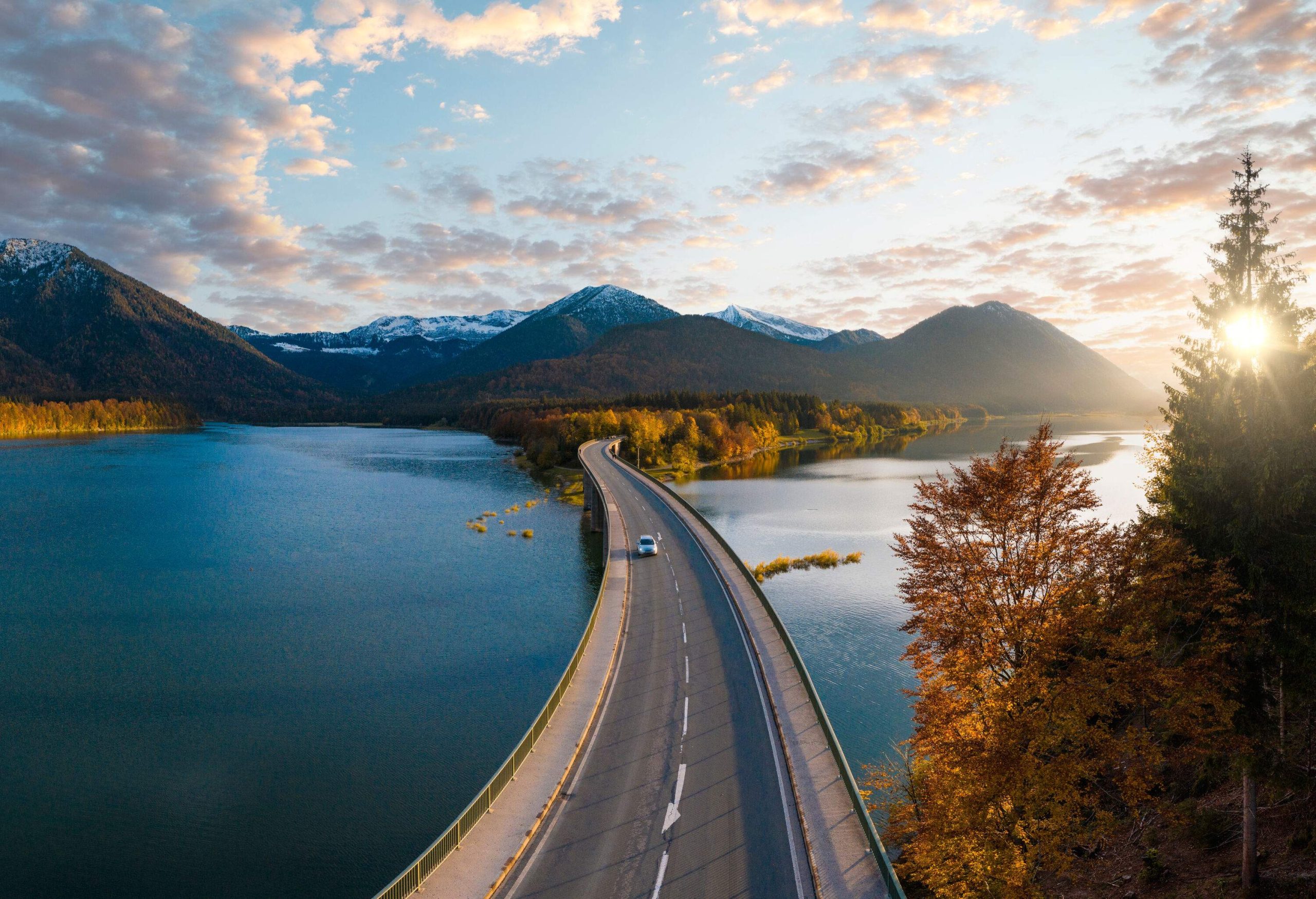
The type of rental car you choose for a road trip in Germany depends primarily on how much space you need. An economical car is particularly useful for longer trips. You should calculate beforehand whether unlimited mileage will pay off for your route.
Comprehensive insurance is always important and you may want to register a second driver so that you can take turns behind the wheel. If you are planning to visit a few cities, you may not want to take the biggest car available. Roads can be small and driving with a big SUV will make it even harder to find parking.
In Germany, your car needs winter tires if the conditions require it. If you are planning to drive from October to March when the weather can bring snow or ice, you should check with your car rental company if your vehicle is equipped with the correct tires.
Pack your bathing suit, because this route takes you to the most beautiful beaches and places by the North Sea and Baltic Sea.
Day 1: Hamburg
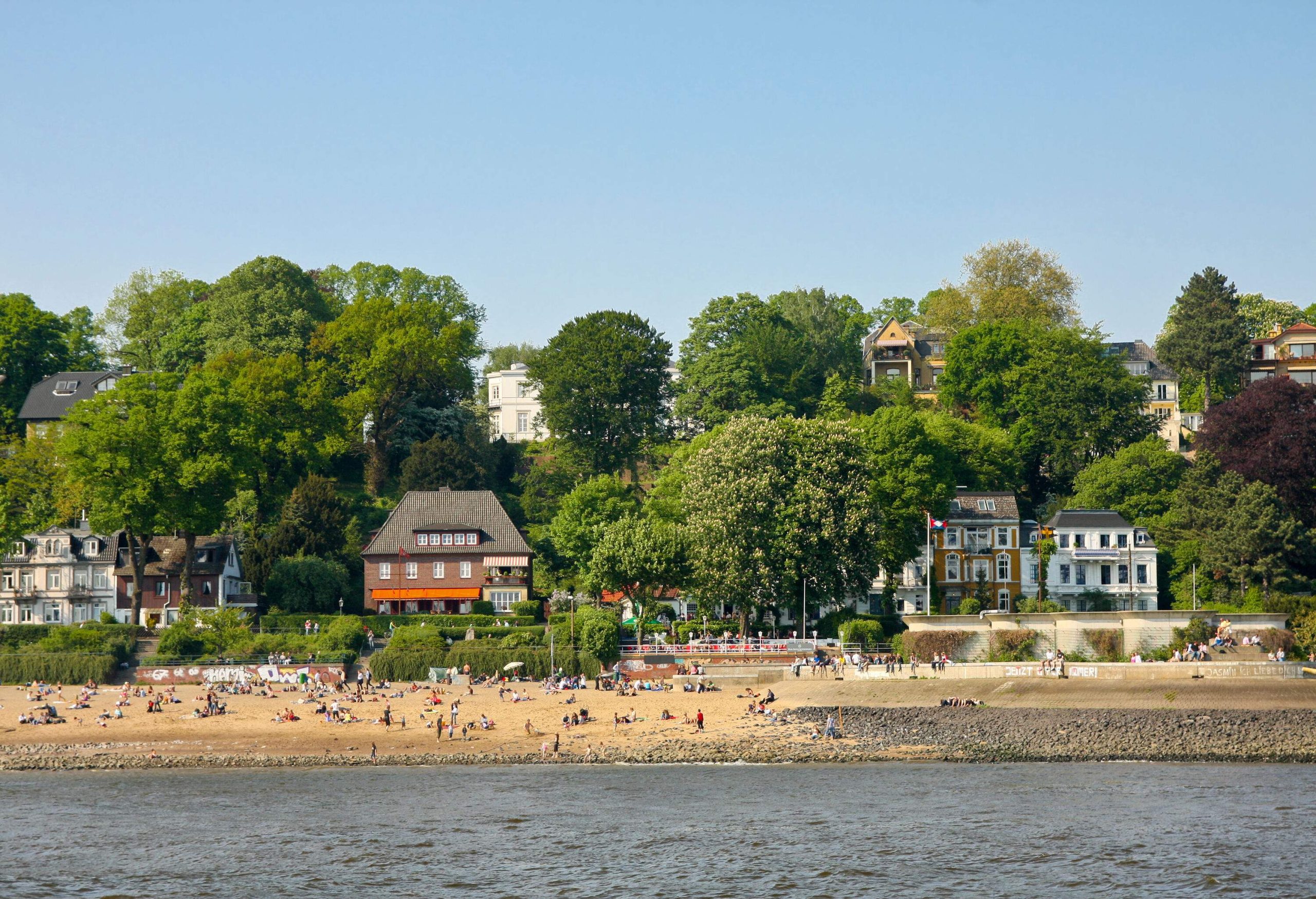
Your road trip along the coast begins with a visit to the Hanseatic City of Hamburg. If the weather is nice, you can put your feet in the sand on the beach by the river Elbe and count the containers in the harbor. Visit the Elbphilharmonie for a concert or a tour of its famous plaza.
Where to stay in Hamburg: 25hours Hotel Hafencity , a cool city hotel with Nordic flair
Day 2: Sankt Peter-Ording
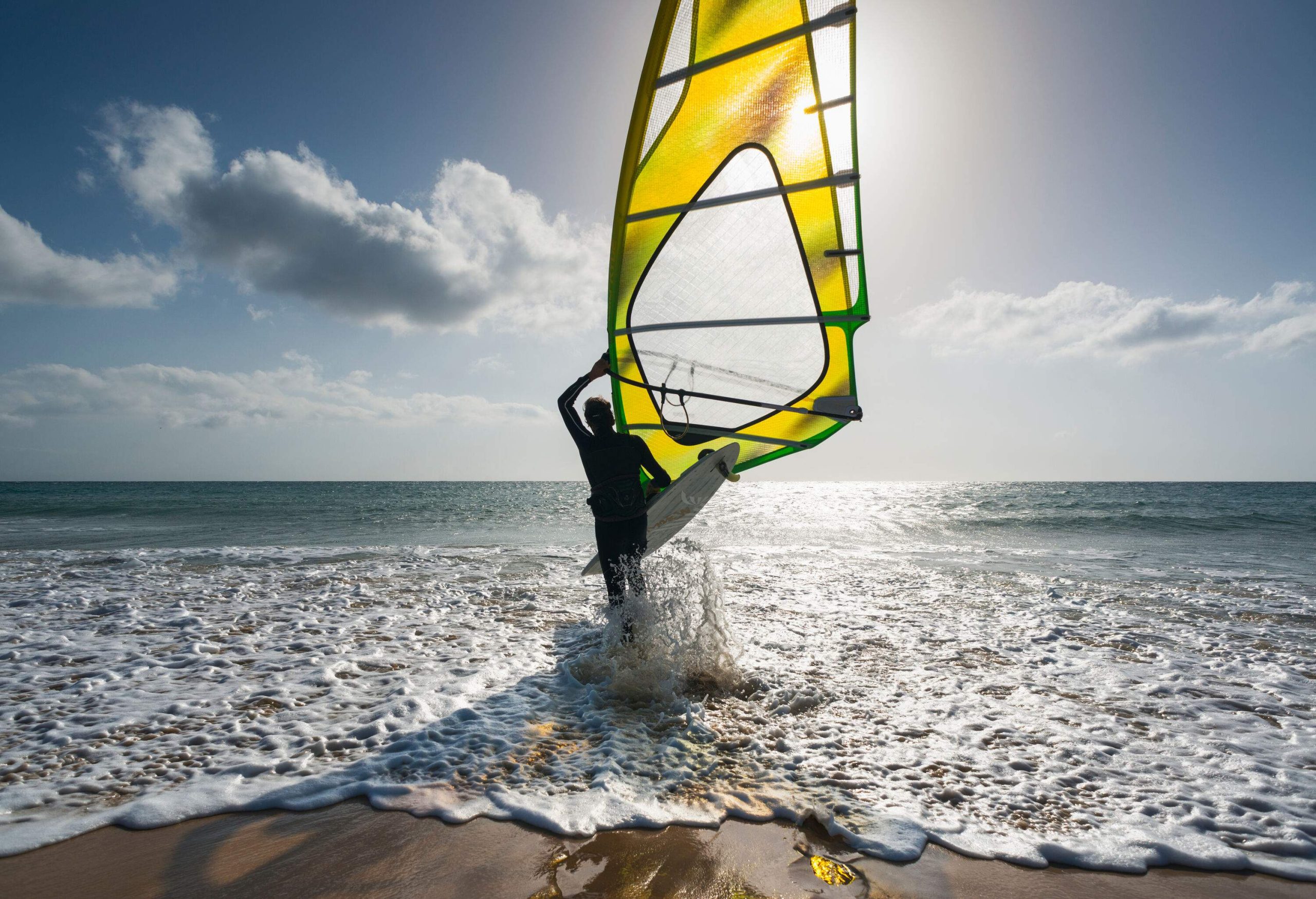
Distance from Hamburg: 87 mi - just under 2 hours
Enjoy the ocean breeze during a long walk on the beach in Sankt Peter-Ording. You can also jump on a board as windsurfing is the thing to do here. Alternatively, take a stroll along the pier and enjoy a bite to eat in one of the restaurants that are set up in iconic stilt houses.
Where to stay in Sankt Peter-Ording: Seaside 43 , a beautiful wellness hotel by the sea
Day 3: Sylt
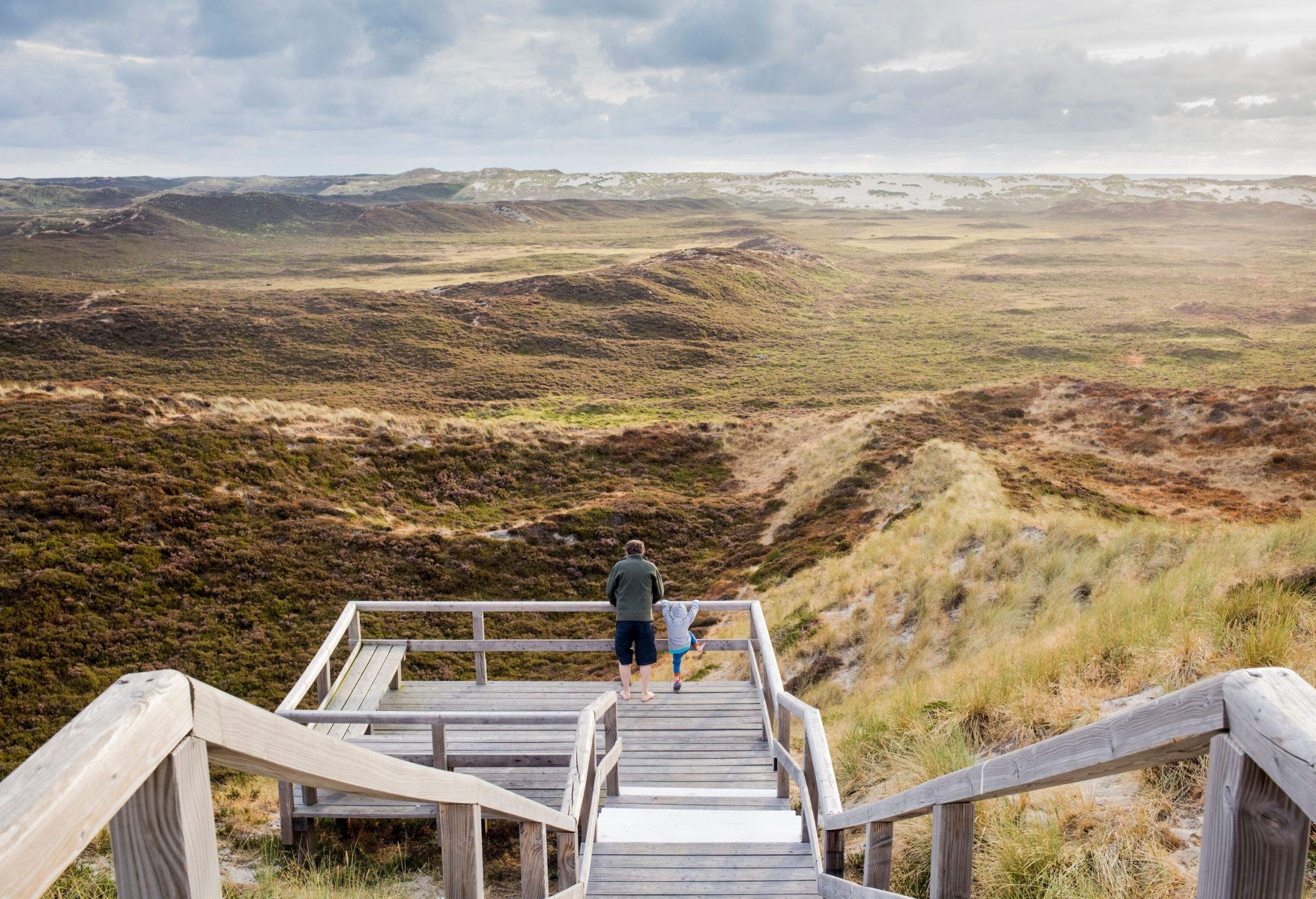
Distance from Sankt Peter-Ording: 80 mi - 2.5 hours including the journey by car train
Sylt is the destination for a seaside vacation and the Wadden Sea National Park awaits. It is best explored on a guided tour. Afterwards, you can admire the dunes and the Red Cliff, and enjoy a fish sandwich at the northernmost fish shack in Germany.
Where to stay on Sylt: Hotel Stadt Hamburg , a chic hotel in the middle of Westerland
Day 4: Fehmarn
Distance from Sylt: 155 mi - just under 4 hours including the journey by car train
Fehmarn is a great island for a family vacation. Beach volleyball, kiting, or splashing around in the waves - there is a beach for every taste on this Baltic island. Children and teenagers can get to know the area with geocaching and if it rains, you can play or relax in the indoor wave pool.
Where to stay on Fehmarn: Strandhotel Bene , beautiful accommodation with a sea view
Day 5: Lübeck
Distance from Fehmarn: 55 mi - just over 1 hour
Start by saying hello to the Holsten Gate and Lübeck's old city, a UNESCO World Heritage Site, Nibble on some famous Lübeck marzipan while you stroll around. Literature fans can visit the Buddenbrookhaus , where you can learn all about the life of Germany’s best-known author Thomas Mann.
Where to stay in Lübeck: Fisher's Loft , a cool city hotel in the center
Day 6: Fischland Darß Zingst

Distance from Lübeck: 120 mi - 2.5 hours
Which is the most beautiful beach in Germany? For many, it is without question the western beach in Darß, which resembles a Caribbean beach. There is also the Vorpommersche Boddenlandschaft National Park, which delights nature lovers thanks to its lagoons, forests, and steep cliffs.
Where to stay in Darß: Domizil am Ostseewald , a spacious vacation rental near the beach
Day 7: Rügen
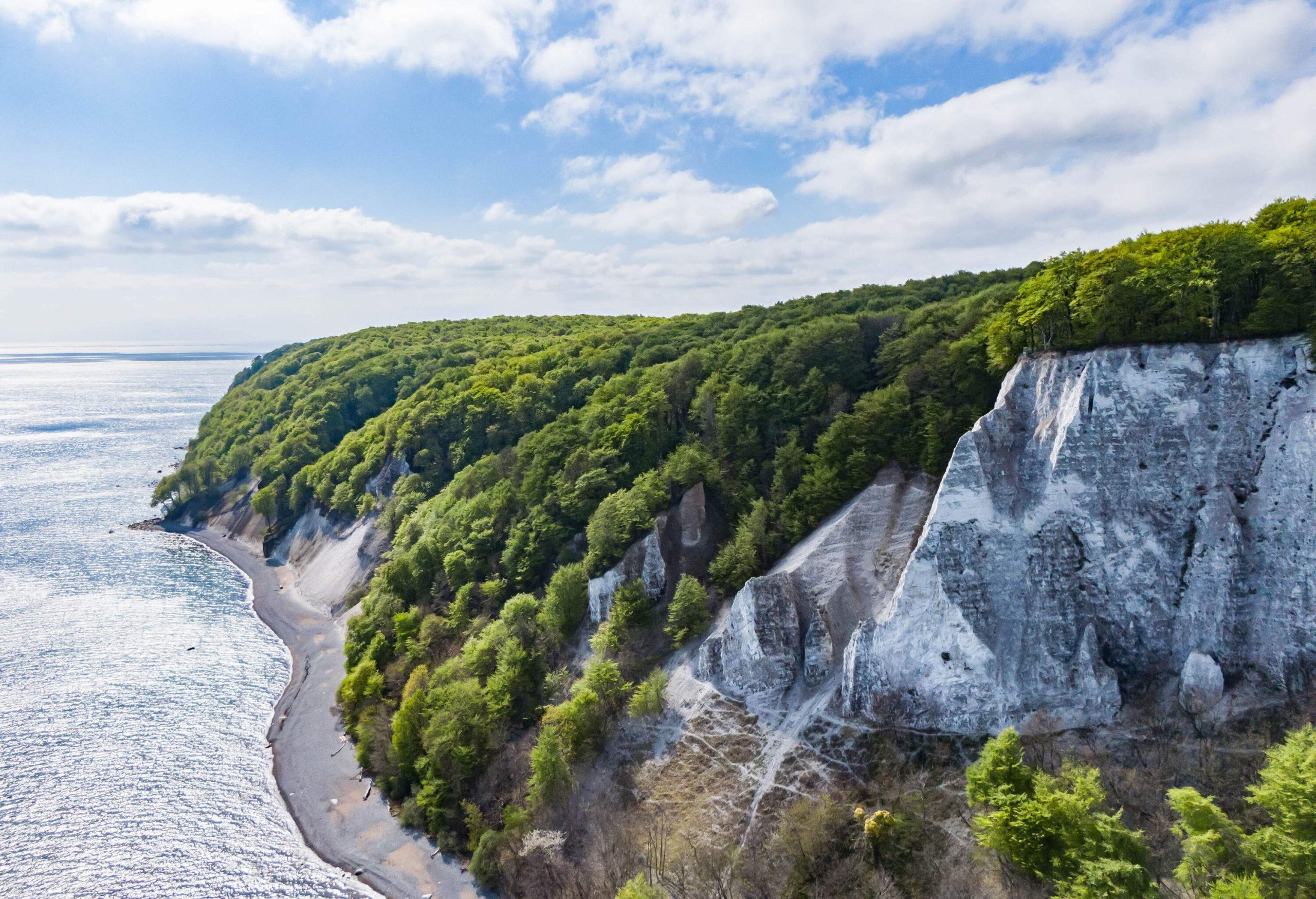
Distance from Zingst: 45 mi - just over 1 hour
In addition to beautiful beaches and one of the most famous piers in the Baltic Sea, Rügen is particularly famous for the Jasmund National Park. Hike to the Königsstuhl and admire the chalk cliffs. A special highlight is the treetop walk with a slide and a great view over the beech forest, a natural heritage site.
Where to stay on Rügen: Der Wilde Schwan , a pretty hotel with sauna
From Rügen, you will either drive back to Hamburg to catch your flight home or to Berlin if you want to add a trip to the German capital. Both cities are approximately 3 hours away by car.
Fancy feeling like a princess or even a queen? This road trip through Germany will take you to the most beautiful castles in Bavaria.
Day 1: München
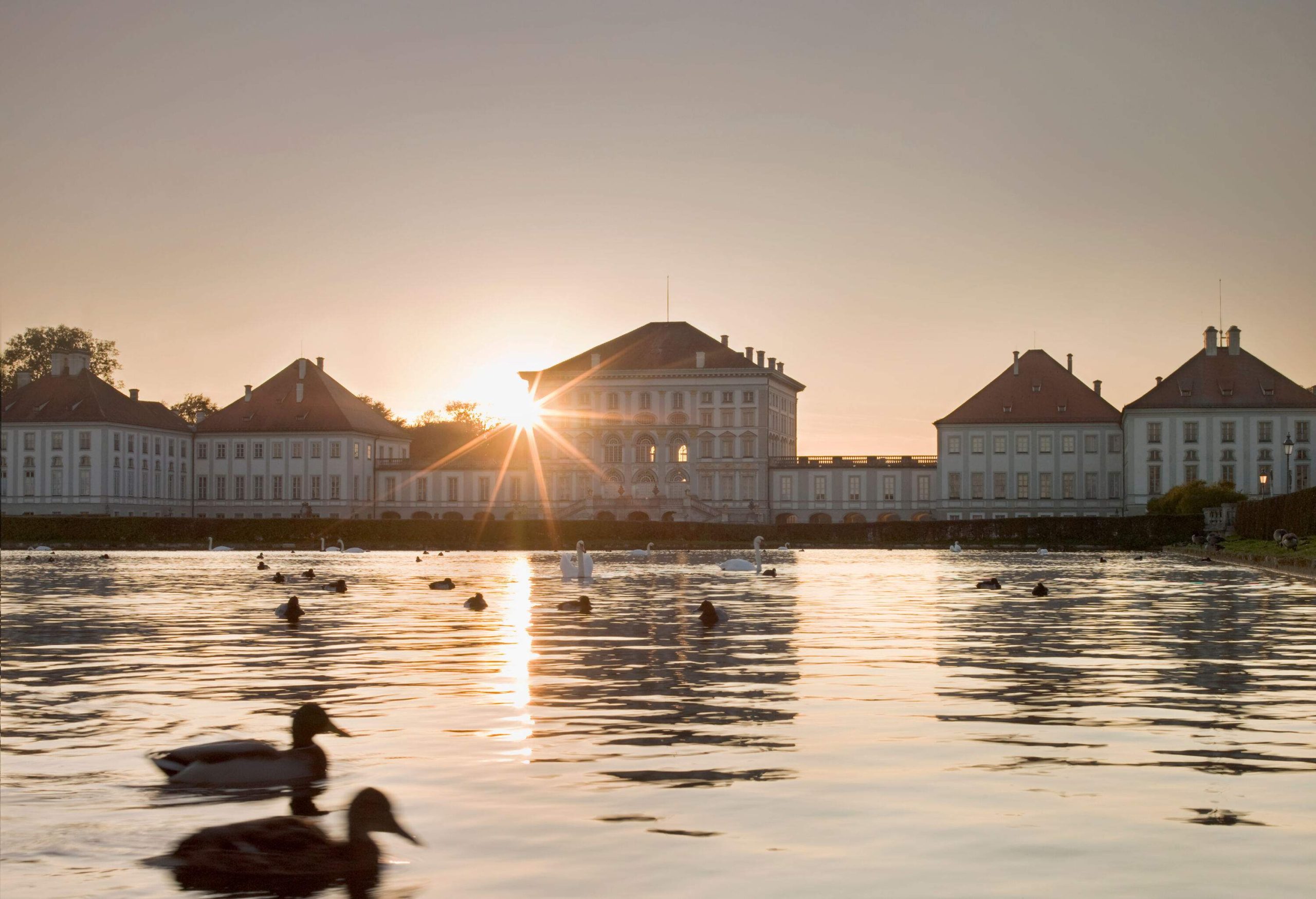
Your fairytale road trip begins in Munich, home to Nymphenburg Palace. Admire the former summer residence of the Bavarian electors and stroll through the fantastic park of the palace. They offer special themed tours for families.
Don’t forget to try a Bavarian veal sausage in a traditional beer garden - but hurry, because they are only served until midday!
Where to stay in Munich: Augustin Hotel , a modern family hotel in Schwanthalerhöhe
Day 2: Füssen
Distance from Munich: 80 mi - just under 2 hours
Germany's most famous castle is located very close to Füssen: welcome to Neuschwanstein! King Ludwig II's home is a real fairytale castle and is charming any time of the year. To visit, you must take part in a guided tour with tickets available online.
Where to stay in Schwangau: Hotel Christine , only 15 minutes away from Neuschwanstein
Day 3: Ettal
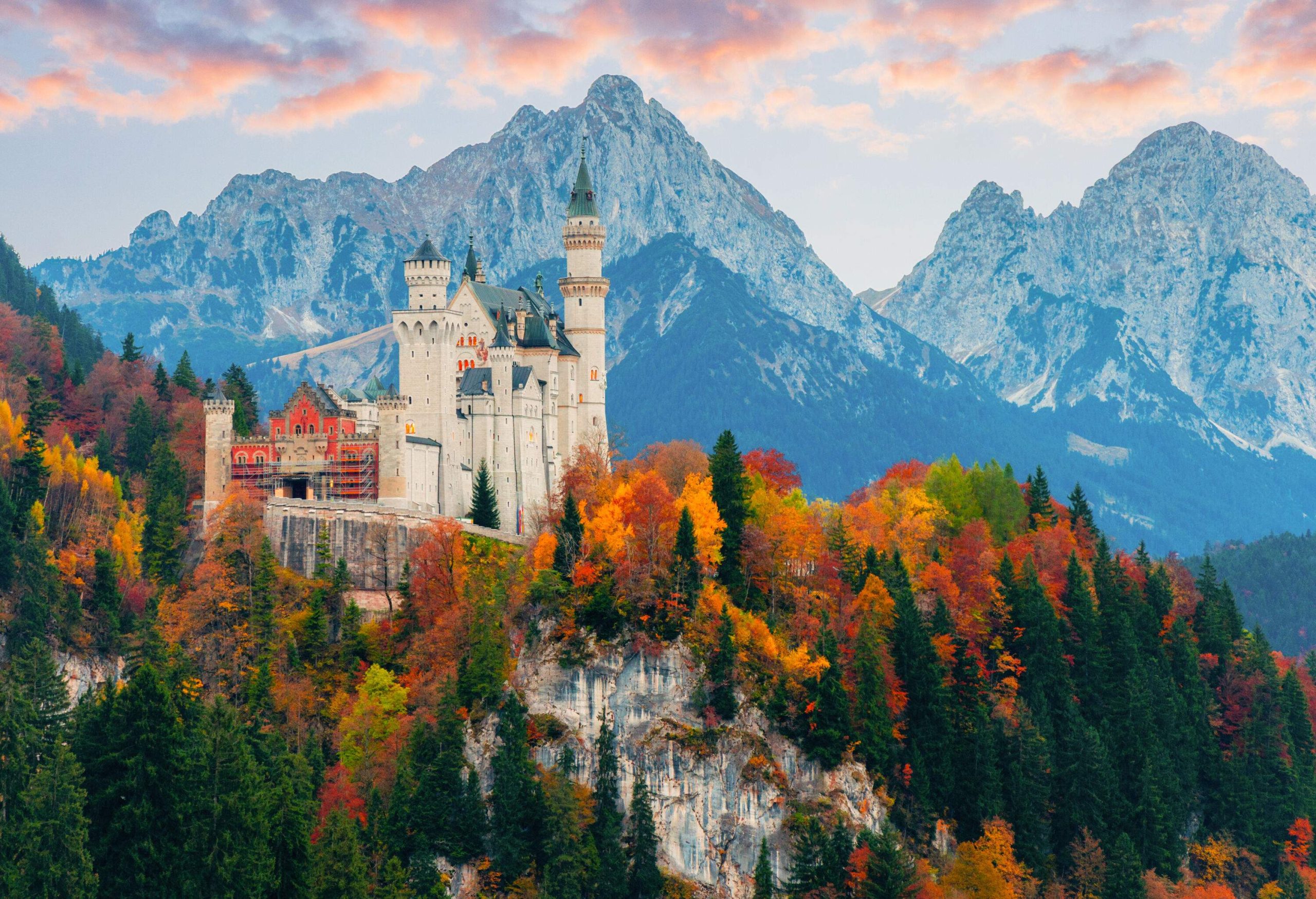
Distance from Füssen: 32 mi - just under 1 hour
The next castle is very close: Linderhof Castle, which was Ludwig II’s pleasure palace that he visited during hunting trips. You also have to book a guided tour and they offer themed tours for children and adults. The castle park is particularly beautiful with the famous Venus Grotto and other interesting building projects the king started.
Where to stay in Ettal: Mammhofer Suite , a charming guesthouse in the heart of Oberammergau
Day 4: Garmisch-Partenkirchen
Distance from Ettal: 9 mi - 20 minutes
Even without a castle, Garmisch-Partenkirchen is a great stopover on your road trip through Bavaria. From here, you can take the cog railroad up to the Zugspitze. At the top, you can enjoy a view over four countries and with a bit of luck and clear skies count a total of 400 mountain peaks.
Where to stay in Garmisch-Partenkirchen: Hotel Zugspitze , a wellness hotel in the middle of the Alps
Day 5: Prien am Chiemsee
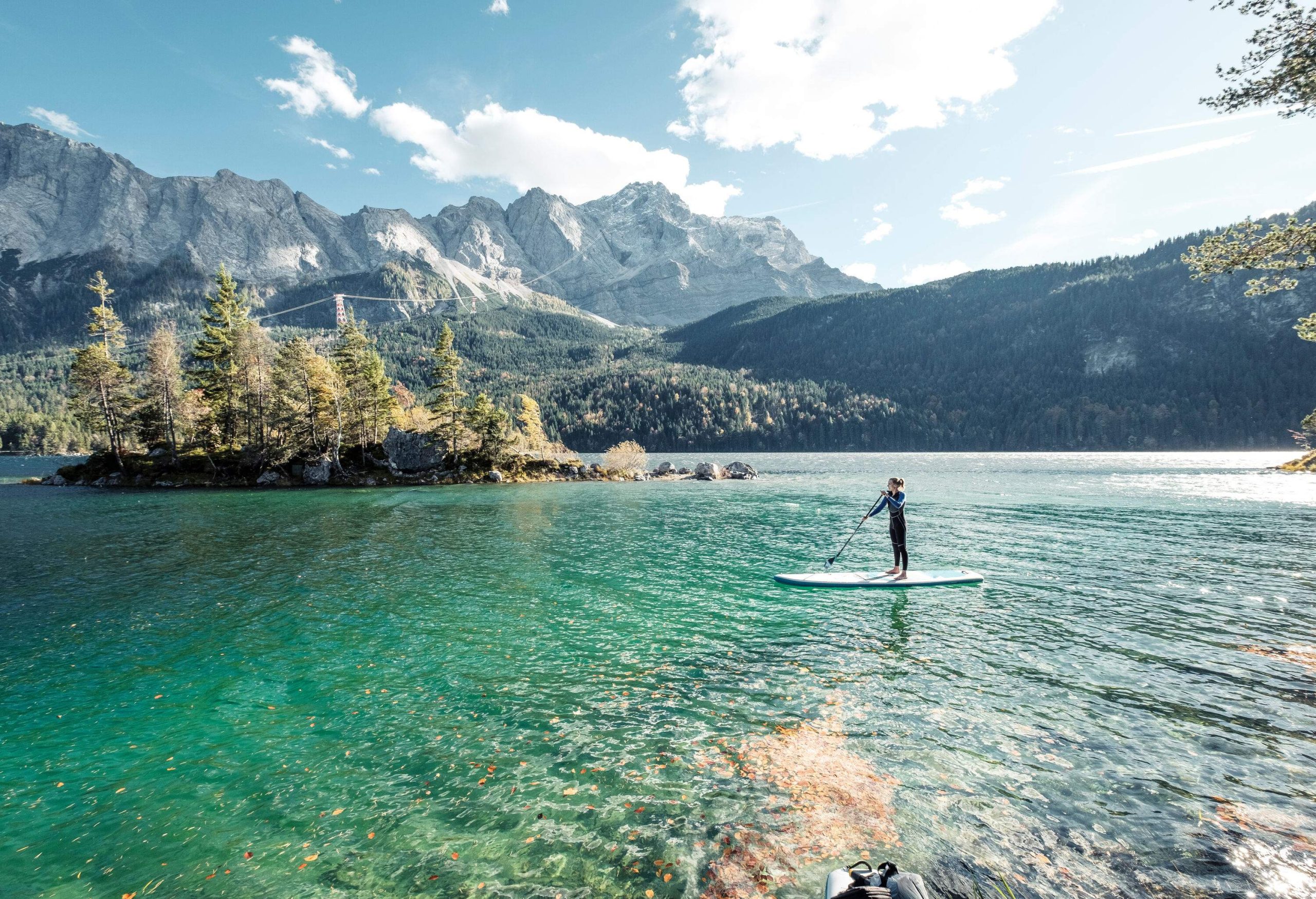
Distance from Garmisch-Partenkirchen: 80 mi - just under 2 hours
Ludwig II's third palace was built on the island of Herrenchiemsee and modeled after Versailles. Even though it was never completed, its hall of mirrors is actually longer than the original’s. You can reach the island by boat from Prien and get tickets for a guided tour at the pier.
Where to stay in Prien: Hotel Zur Sonne , not far from the lake
From Prien, it will take a good hour to get to Munich Airport for your return flight. Make sure to leave enough time to drop your rental car off.
December means Christmas market season in Germany. This one-week road trip takes you from Frankfurt to Berlin to see some of the most beautiful Christmas markets in Germany.
Day 1: Frankfurt am Main
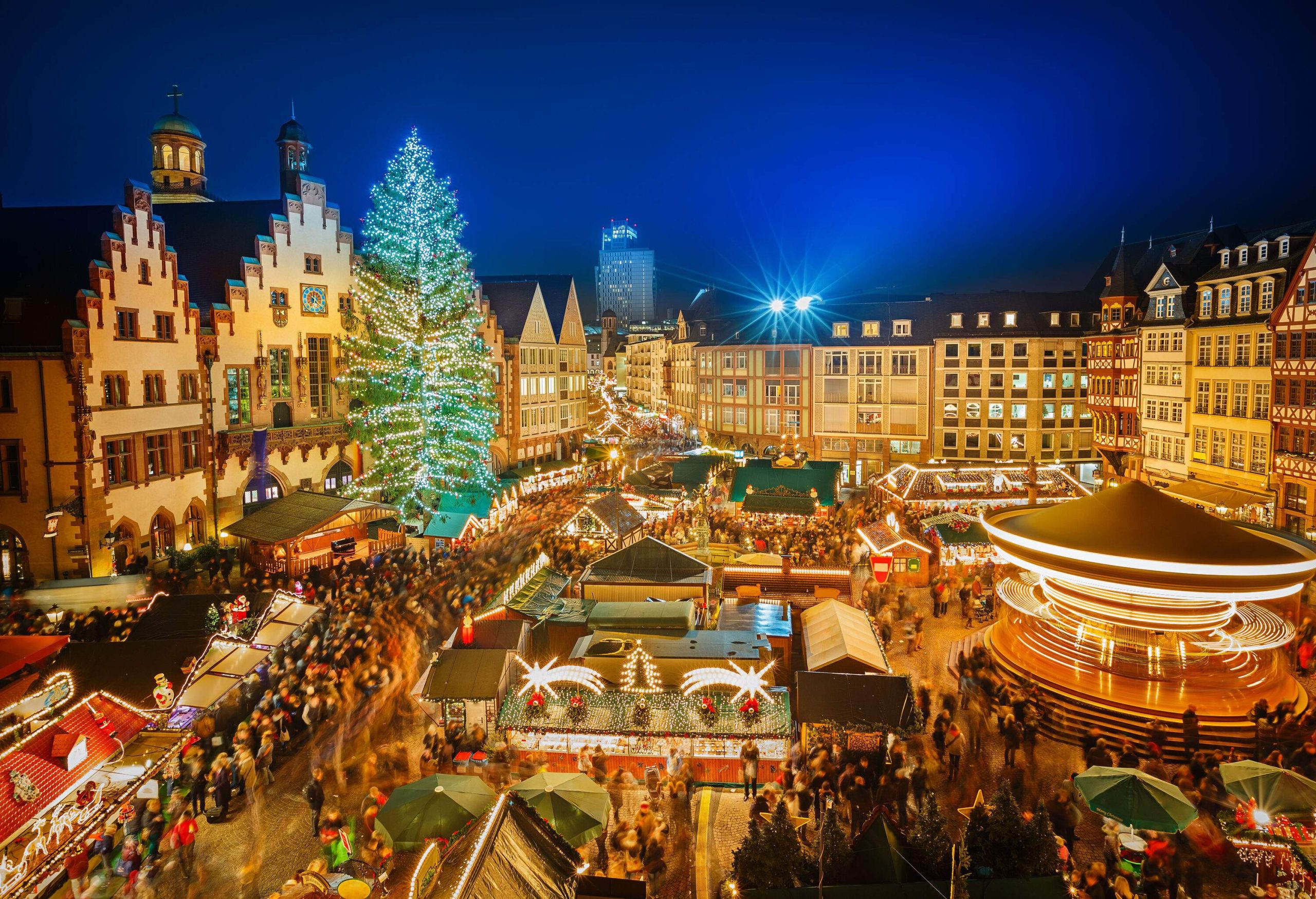
The first Christmas lights are being lit in Frankfurt by the end of November. There are Christmas markets in many parts of the city, but none are as beautiful as the market in the historic old town. My tip: In addition to traditional mulled wine, many local winemakers have stalls in the area. Perfect if you don't like warm wine but prefer Riesling instead.
Where to stay in Frankfurt: Motel One Frankfurt-Römer , a modern hotel near the old town
Day 2: Rothenburg ob der Tauber
Distance from Frankfurt: 112 mi - 2 hours
Admittedly, the Christmas market in Rothenburg ob der Tauber is not the biggest, but the town likes to call itself a Christmas fairytale. It is most beautiful when it snows, but the Christmas lights provide a charming backdrop in any weather. Yummy mulled white wine and the so-called Rothenburg snowballs will warm you up in no time.
Where to stay in Rothenburg ob der Tauber: Burghotel , a medieval hotel on the edge of the old town
Day 3: Nürnberg
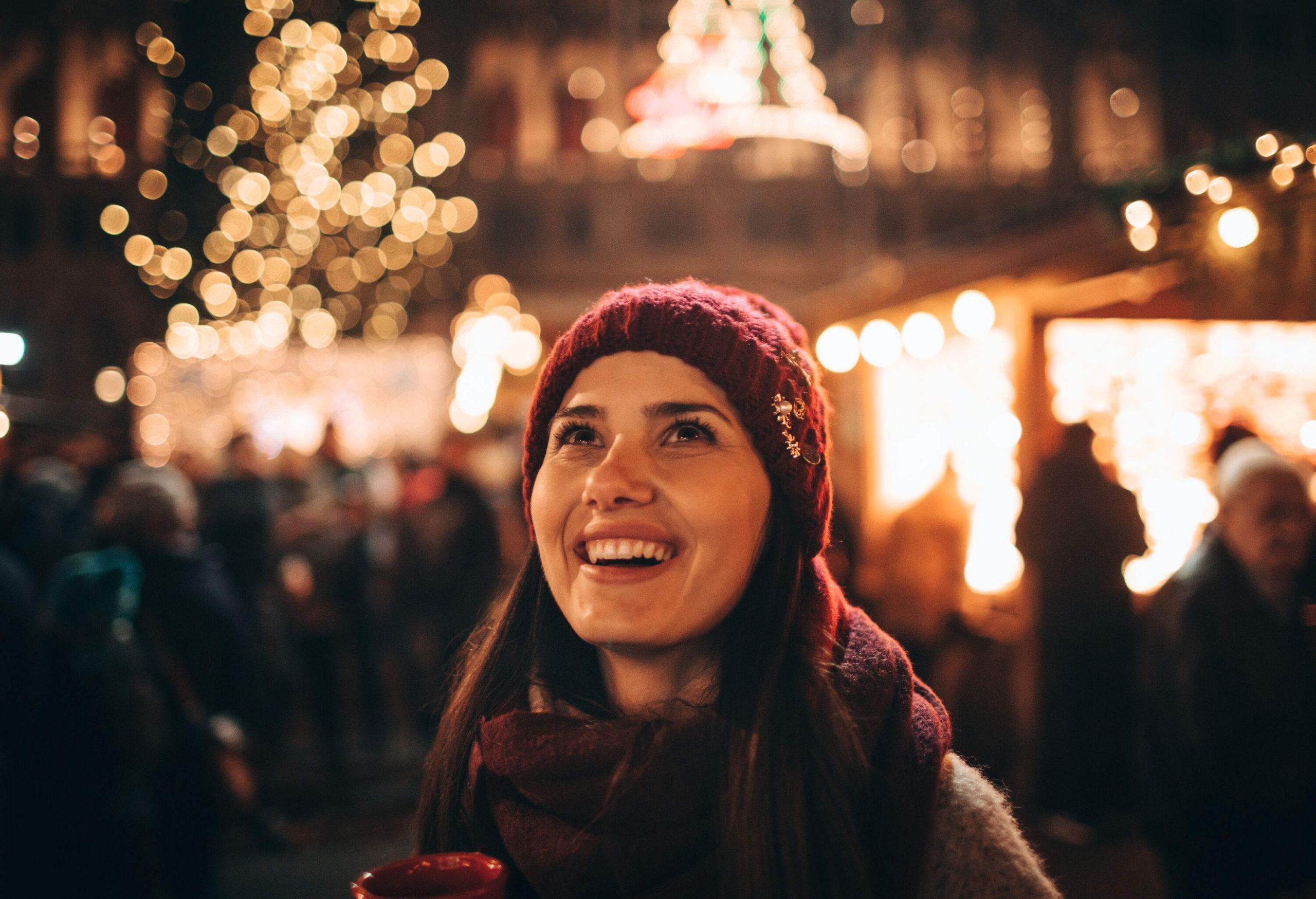
Distance from Rothenburg ob der Tauber: 50 mi - just over 1 hour
The Nürnberg Christmas Market is one of the oldest and most beautiful Christmas markets in Europe. Nibble on traditional gingerbread and sausages while you shop for handicrafts. A highlight are the adventure trails, which allow you to discover completely new parts of the market.
Where to stay in Nürnberg: Hotel Drei Raben , a central accommodation not far from the market
Day 4: Erfurt
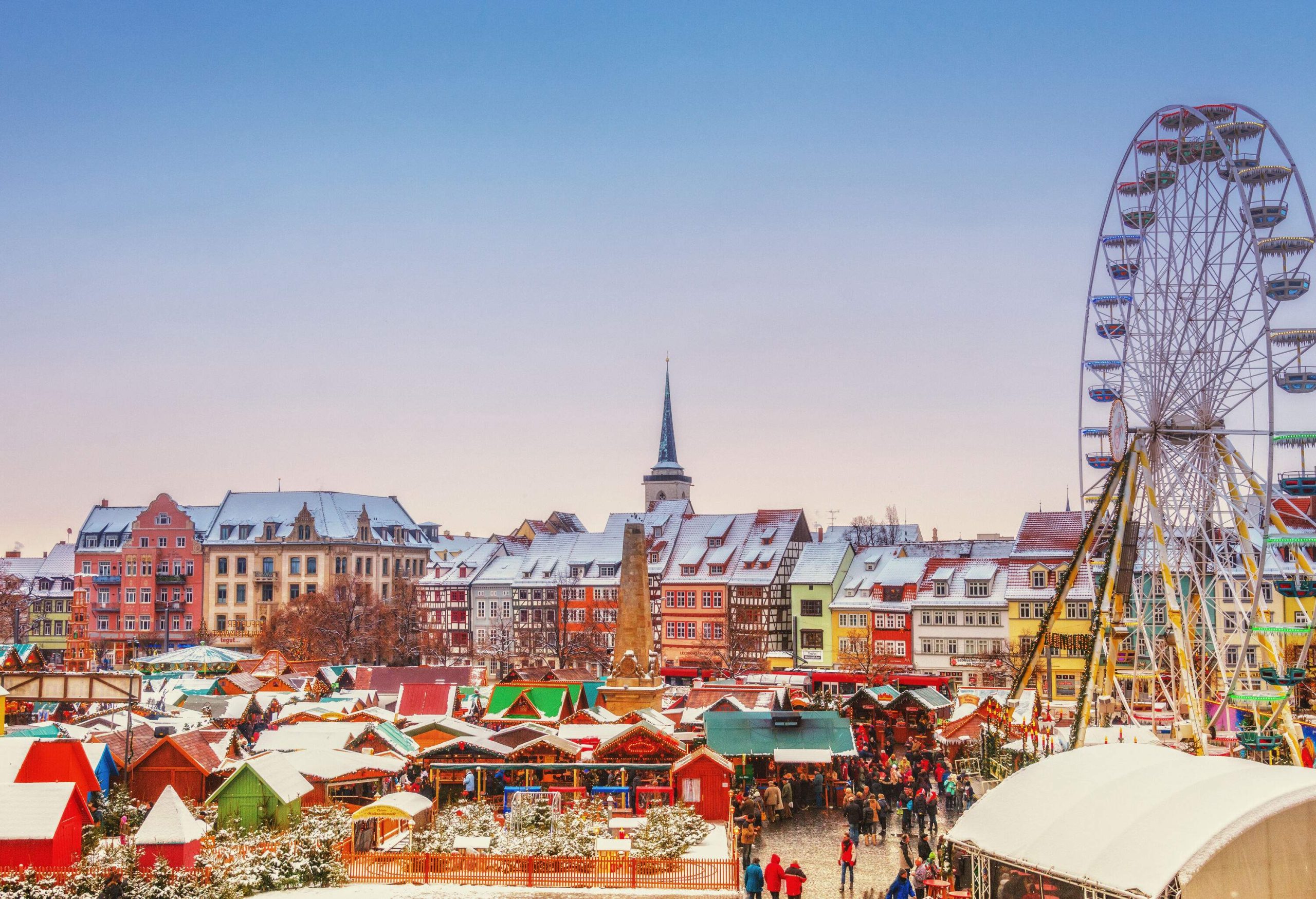
Distance from Nürnberg: 143 mi - 2.5 hours
One of the most beautiful medieval Christmas markets in Germany opens its doors every year in front of the cathedral in Erfurt. In addition to local delicacies and crafts, it is particularly famous for its life-size nativity scene. If it gets too busy you can relax in the enchanted Christmas forest at the edge of the market.
Where to stay in Erfurt: Hotel Domizil , a lovely accommodation close to the cathedral
Day 5: Leipzig
Distance from Erfurt: 93 mi - just under 2 hours
Leipzig is one of my absolute favorite cities in Germany and it shines especially bright in the weeks before Christmas. The Christmas market in front of the old town hall dates back to the 15th century. It gets particularly festive when the famous Thomanerchor opens the market with Christmas carols.
Where to stay in Leipzig: Radisson Blu Hotel , with a great view of the Augustusplatz
Day 6: Dresden
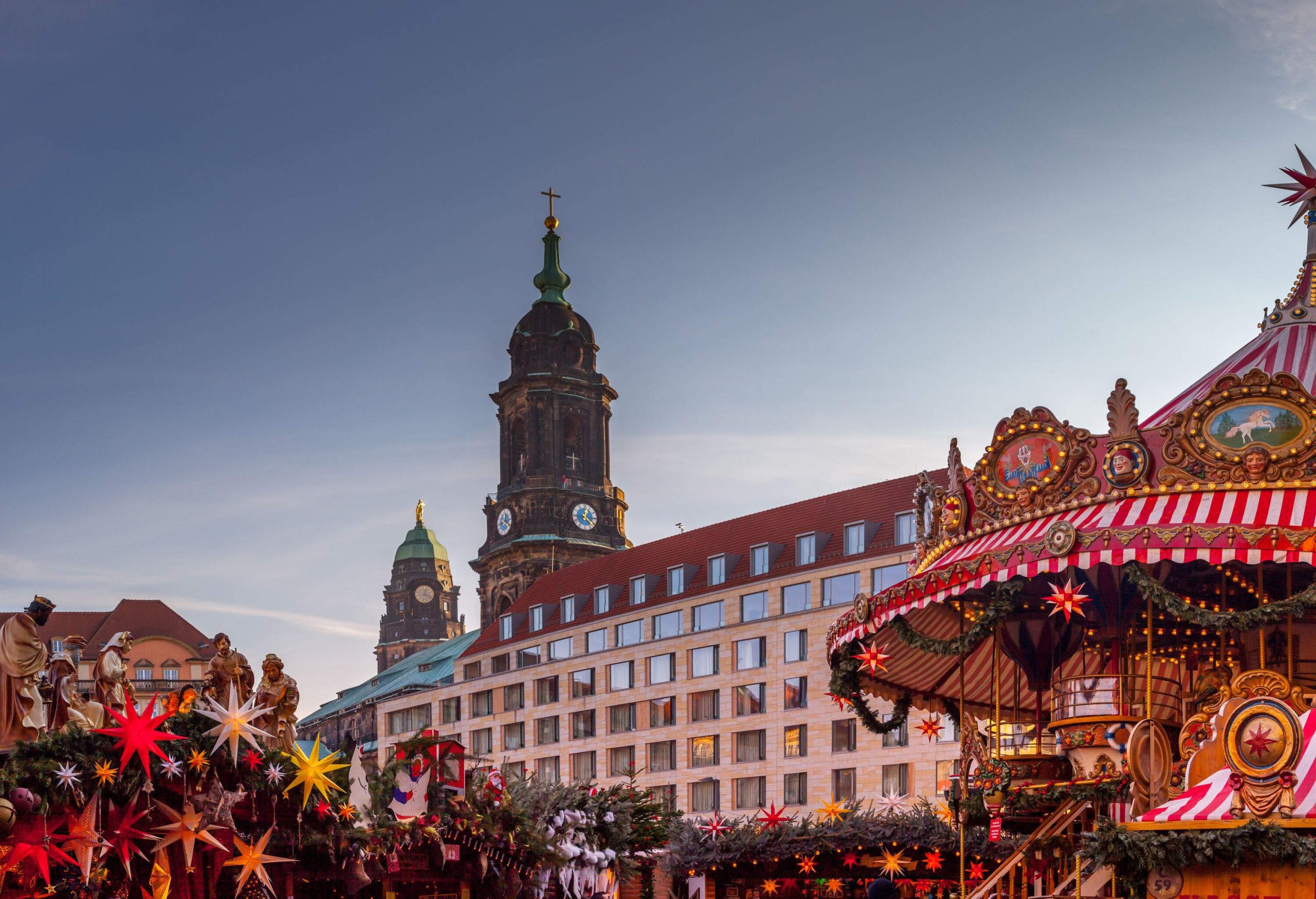
Distance from Leipzig: 137 mi - 2.5 hours
Dresden's Striezelmarkt has the official title of being the oldest recorded Christmas market. During a stroll, you can buy delicious Dresden Christmas Stollen, a famous fruit bread with its very own festival. You can also admire beautiful pyramids and candle arches all over the market. And yes, you can buy some to take home too!
Where to stay overnight in Dresden: Townhouse Dresden , a luxury hotel right next to the Frauenkirche
Day 7: Berlin

Distance from Dresden: 125 mi - just over 2 hours
Berlin is one of the coolest destinations in winter and of course, there is not just one Christmas market in our capital. From traditional to just a little bit different, Berlin's Christmas markets have it all. The historic Christmas market at RAW and the Winterworld at Potsdamer Platz, where you can go sledding too, are particularly beautiful.
Where to stay in Berlin: Wild Aparthotels, cool studios right by Checkpoint Charlie
After your Christmas Market trip, it is best if you catch a connecting flight from Berlin to Frankfurt for your international departure. Alternatively, you might be able to book a multi-city flight with arrival in Frankfurt and departure from Berlin.
If you fancy a truly epic road trip through Germany, you can also combine the three suggested routes and drive across the whole country.
US citizens can use their US driver’s license to drive in Germany for a stay of up to six months. If you plan on staying longer you will need to get a German license as well.
You need to be at least 18 years old to legally drive a car in Germany. Most car rental companies have a minimum and a maximum age requirement for the driver. Sometimes you also have to prove that you have had your license for a certain number of years.
Remember that Germans use the metric system. Distances are shown in kilometers (km) and speed in kilometers per hour (kph). Also, petrol prices are shown per liter, not per gallon.
While the German Autobahn is world-renowned for not having a speed limit, don’t get too excited - there are only very few stretches where you can drive to your heart’s content. And of course, you need to be mindful of the traffic around you as well as your driving skills.
Here are some more tips for driving in Germany.
Flight and hotel rates are averages based on data collected by KAYAK. These prices offer an estimate for organizing your trip, but they may vary according to offers, period, destination or your preferences. The price per liter of gasoline, as of April 1st, 2024, is subject to fluctuations, and comes from numbeo.com.
The hotel recommendations included in this article are based on customer ratings and the author's personal choices, so please feel free to use our hotel finder to find the accommodation best suited to your needs.
About the author
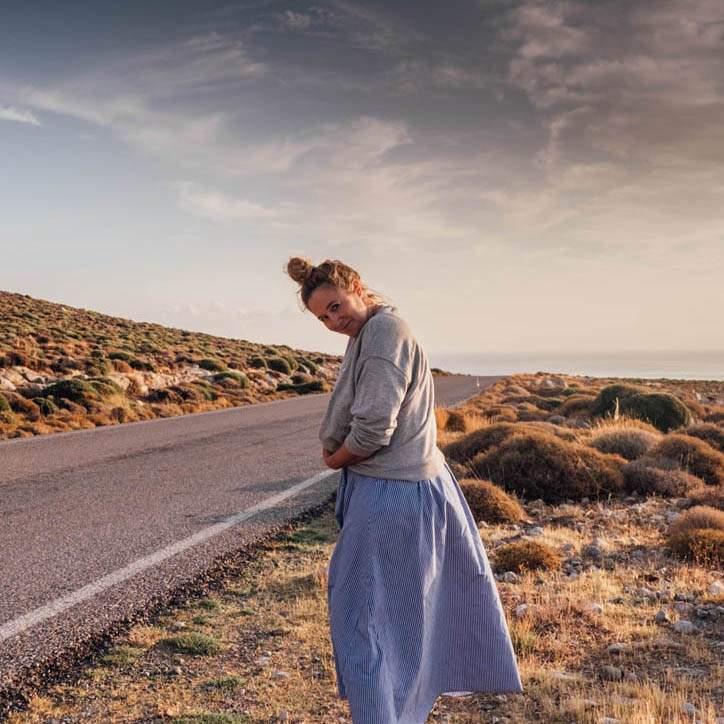
Explore more articles
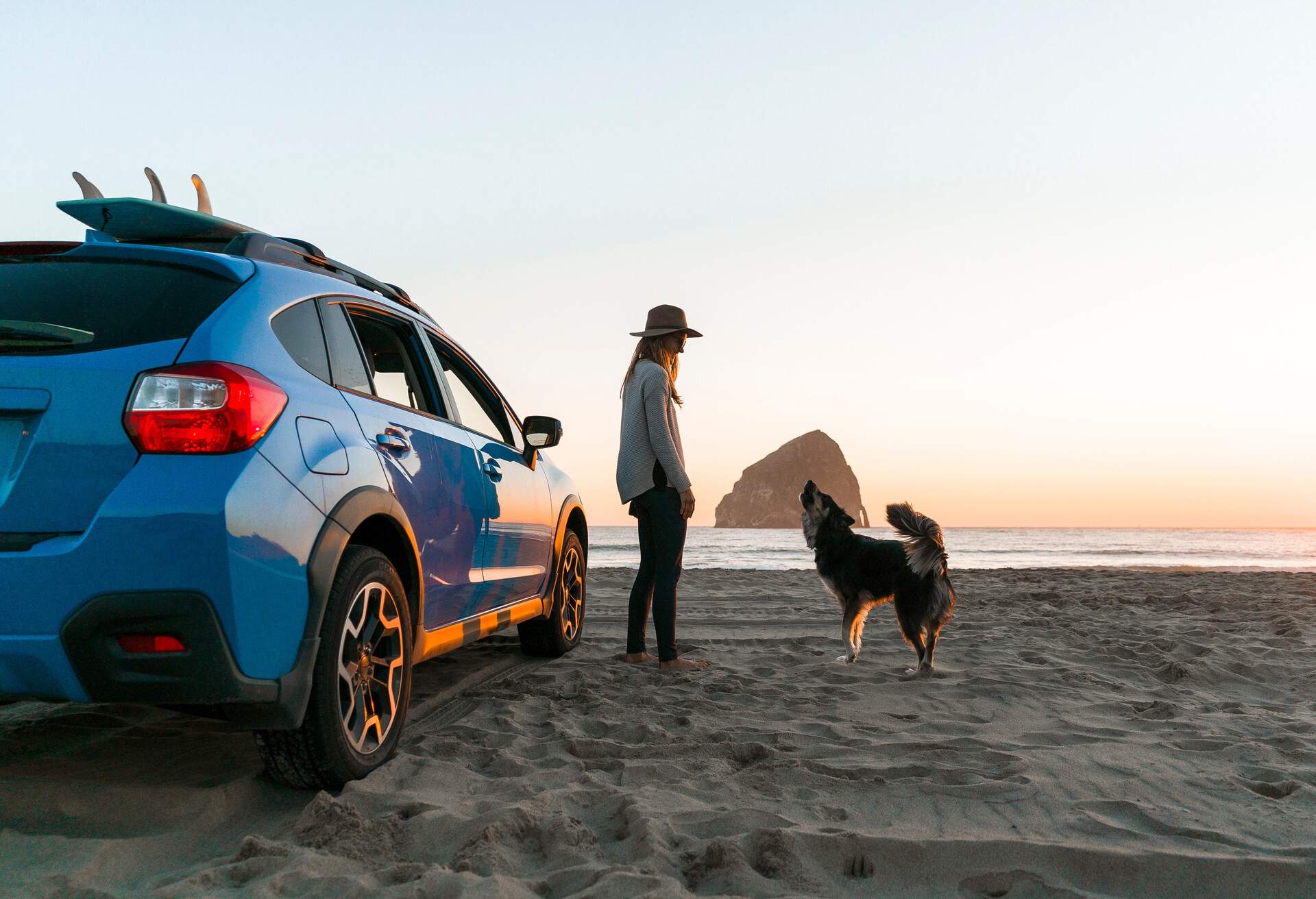
California consumers have the right to opt out of the sale * of their personal information. For more information on how we securely process personal information, please see our Privacy Policy .
Do not sell my info ON
* The definition of "sale" under the California Consumer Privacy Act is applicable only to California consumers.

Love Exploring
Scenic German Road Trips You Will LOVE
Posted: November 14, 2023 | Last updated: November 14, 2023
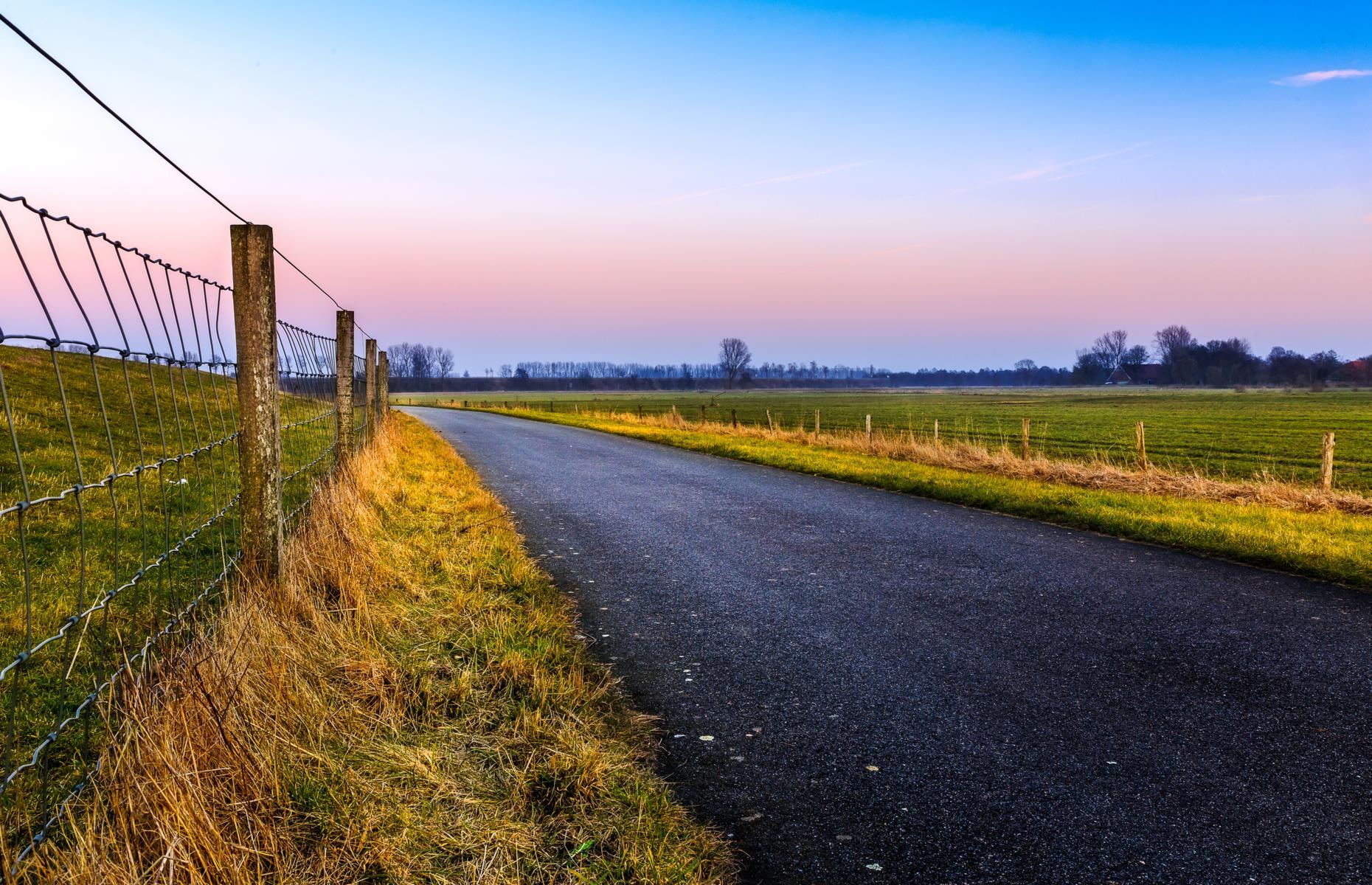
From castles to coast
Germany has many highlights, from cities overflowing with culture and world-famous landmarks to mountains that harbor fairy-tale castles. Then there’s the nature: the less-explored Baltic coastline, waterfalls found deep in the Black Forest, lakes dotted with islets and vast nature reserves. The best way to appreciate all this loveliness is on a road trip. From a journey inspired by the Brothers Grimm to roads that follow the salt-sprayed “German Riviera”, here are some of the best scenic road trips in Germany.
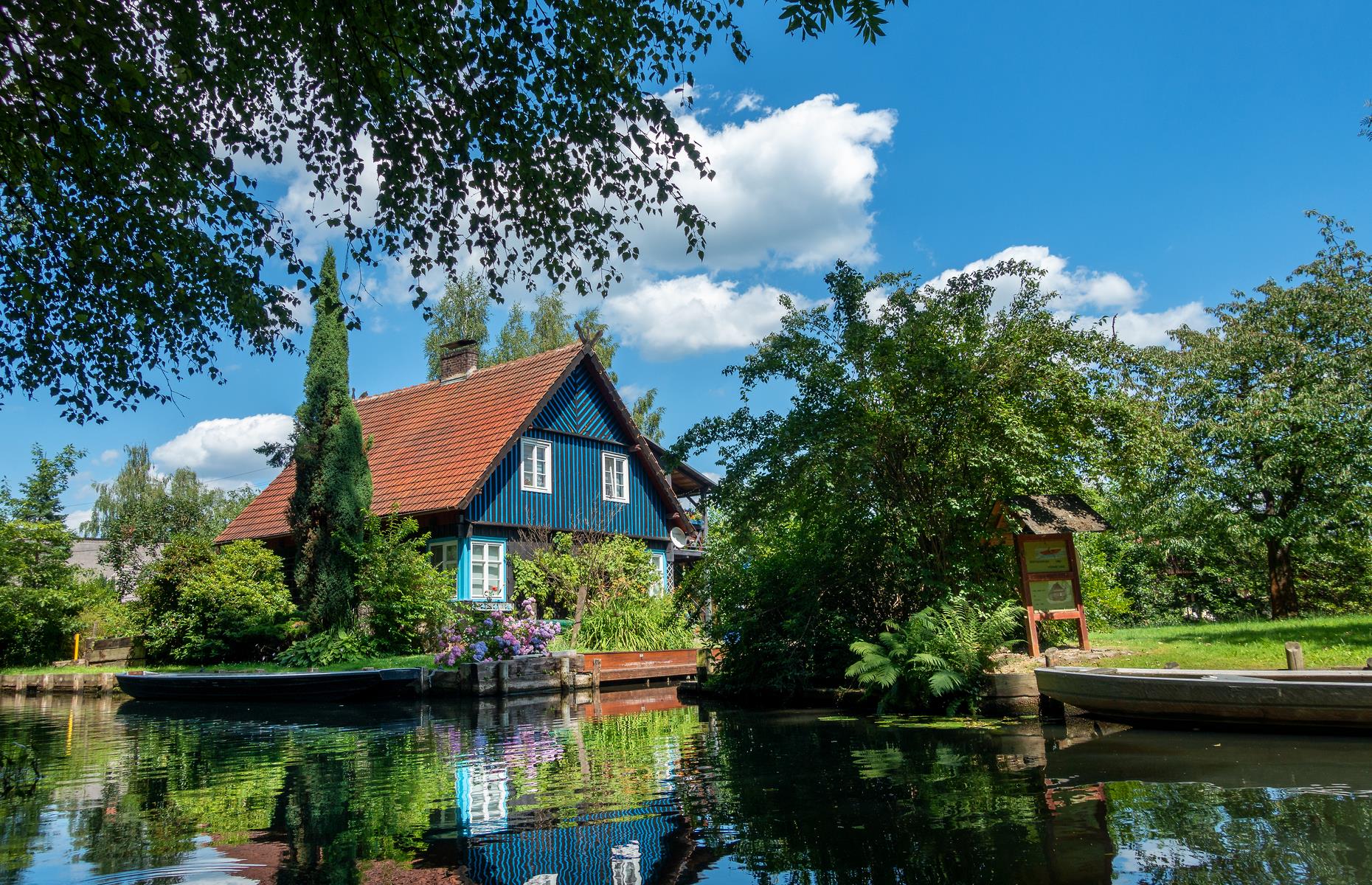
Berlin to Hainich National Park
This route is like a series of snapshots of Germany’s best bits. Starting in Berlin, and lasting for around 350 miles (563km), the journey first dips south to Potsdam, with opulent buildings like the 18th-century Sanssouci Palace, dubbed the “Prussian Versailles”. Then there's the medieval town of Brandenburg, famed for its Gothic architecture. Among more enchanting stops along the way is Spreewald or Spree Forest, a forest and biosphere reserve laced with wetlands and canals, and dotted with “floating” houses (pictured).

Drivers can travel via scenic roads that skim past nature reserves and wiggle through the conservation area of Naturpark Thüringer Schiefergebirge, so the journey is best taken leisurely over a few days. The destination is also worthy of slow exploration. Hainich National Park (pictured) is one of the last remaining primeval beech forests in Central Europe, with a canopy walk that takes hikers through the treetops as lynx and wolves roam the forest below.
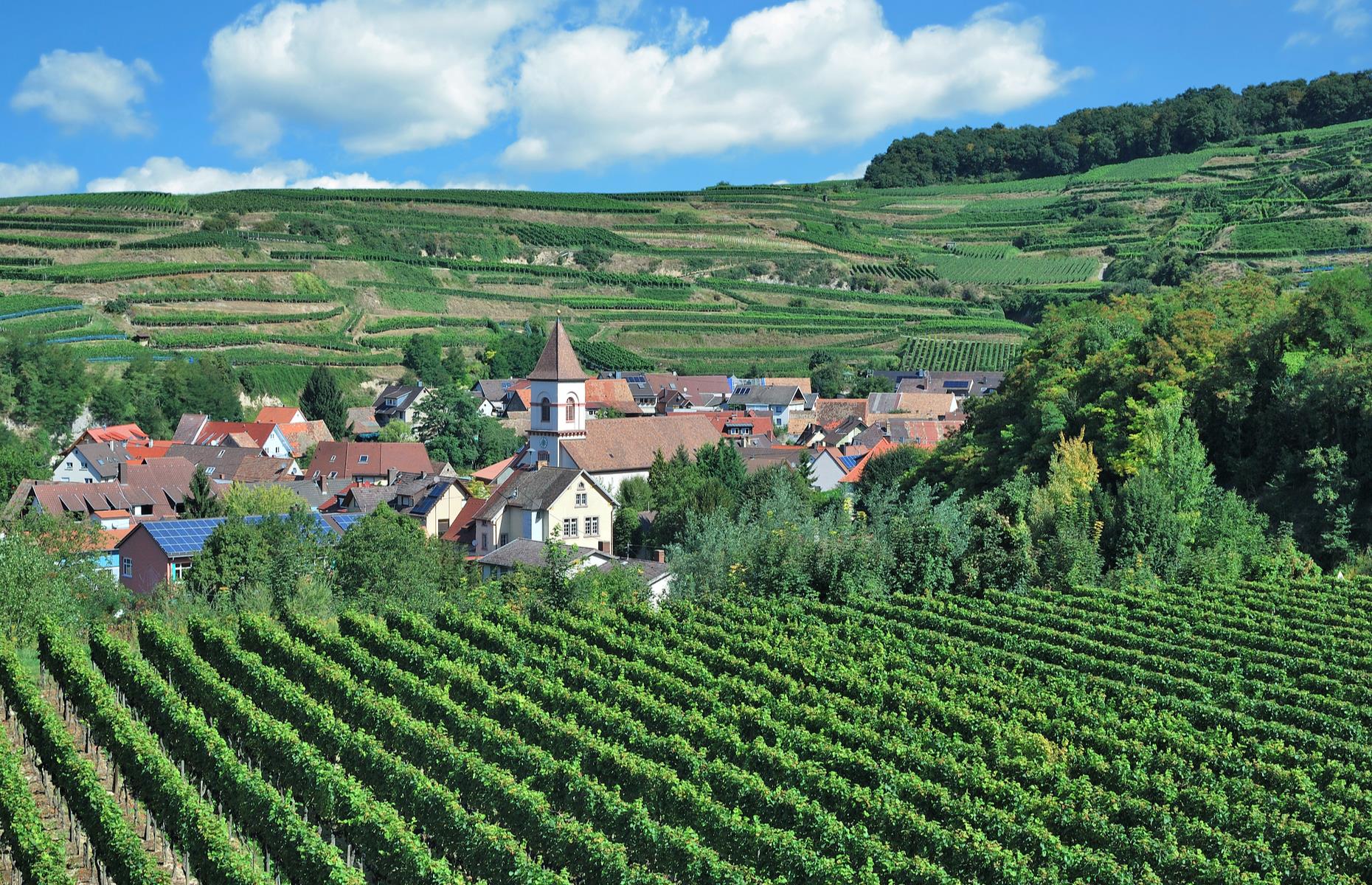
Stuttgart to Weil am Rhein
This delightful route delves into parts of the ever-popular Baden Wine Route , while also devouring portions of the Black Forest. Covering around 175 miles (282km), the journey out from Stuttgart weaves through wine-growing villages on the edge of the Black Forest while also taking in vineyards in the foothills of the Upper Rhine Valley. The elegant spa town of Baden Baden and the Kaiserstuhl wine region (pictured) are among the string of scenic highlights.
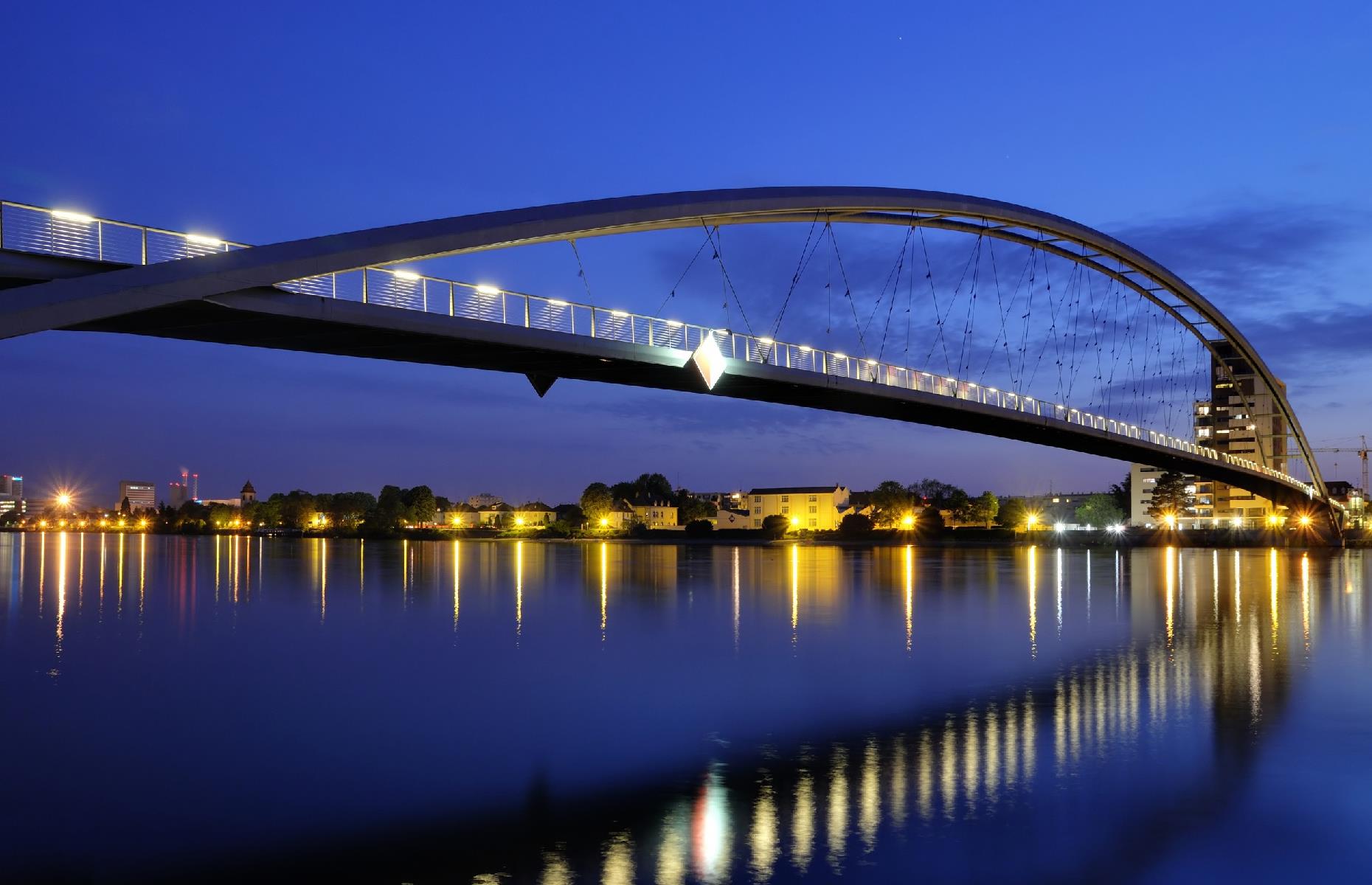
There are many opportunities to take detours through different wine areas along the route, heading into the hilly Kraichgau district, known for pinot noir, or spending time around Badische Bergstraße near Heidelberg. A natural journey’s end is Weil am Rhein, the most southwesterly town in Germany on the east bank of the River Rhine. The town is home to the striking Vitra Design Museum , which has buildings designed by Frank Gehry and Zaha Hadid, and the Three Countries Bridge (pictured), which crosses the Rhine to link Germany with Switzerland and France.
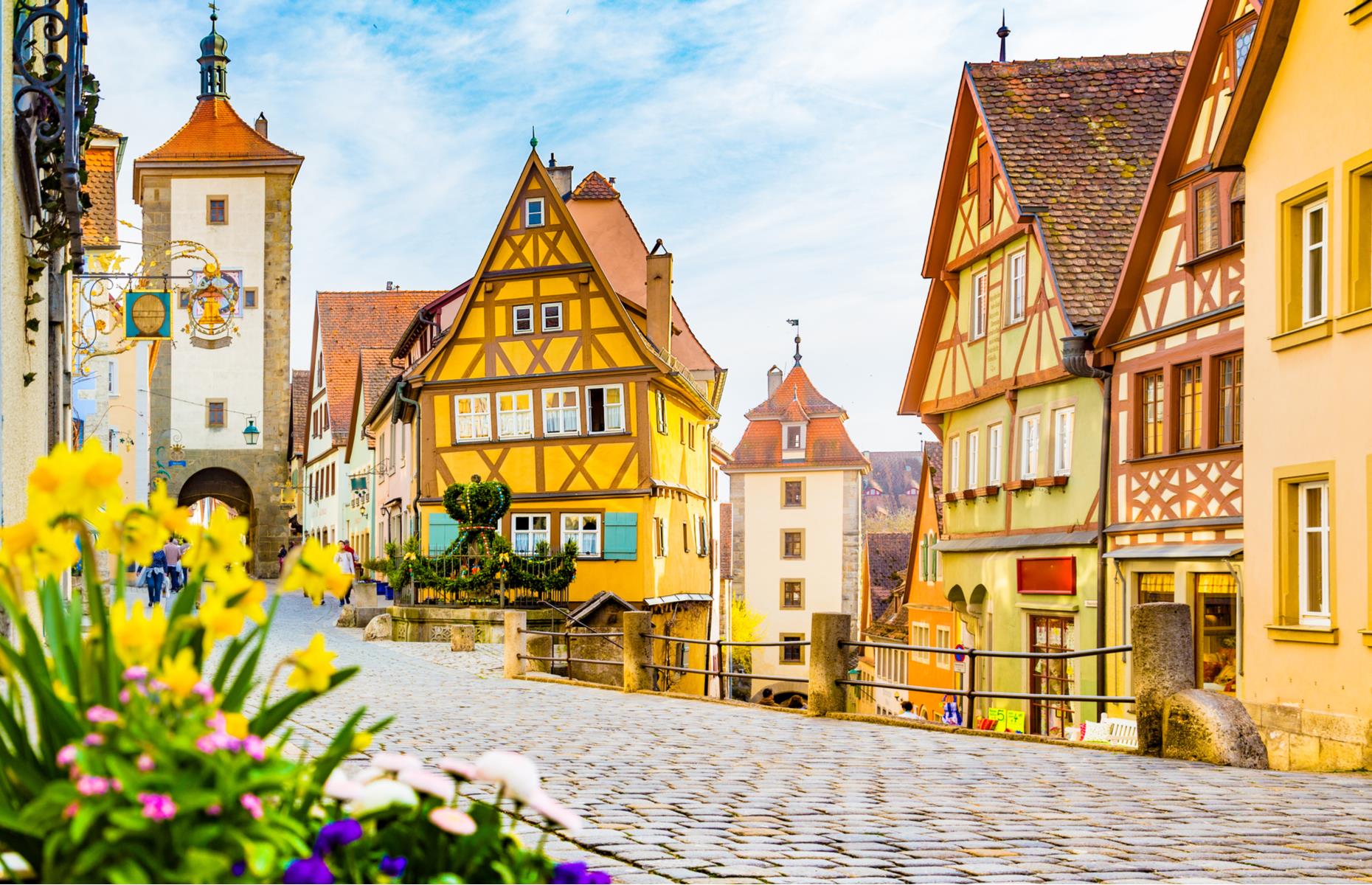
Mannheim to Bayreuth
Stretching for an epic 746 miles (1,200km), the Castle Road runs all the way to Prague in the Czech Republic. This 373-mile (600km) section weaves through southern Germany, incorporating some of the country’s most fascinating fortresses. The line-up of captivating castles and royal residences is dizzying, with the Baroque 18th-century Mannheim Palace at the start of the route and jaw-dropping stops at Nuremberg and Heidelberg Castles. Picturesque towns along the way include the incredibly pretty Rothenburg ob der Tauber (pictured).
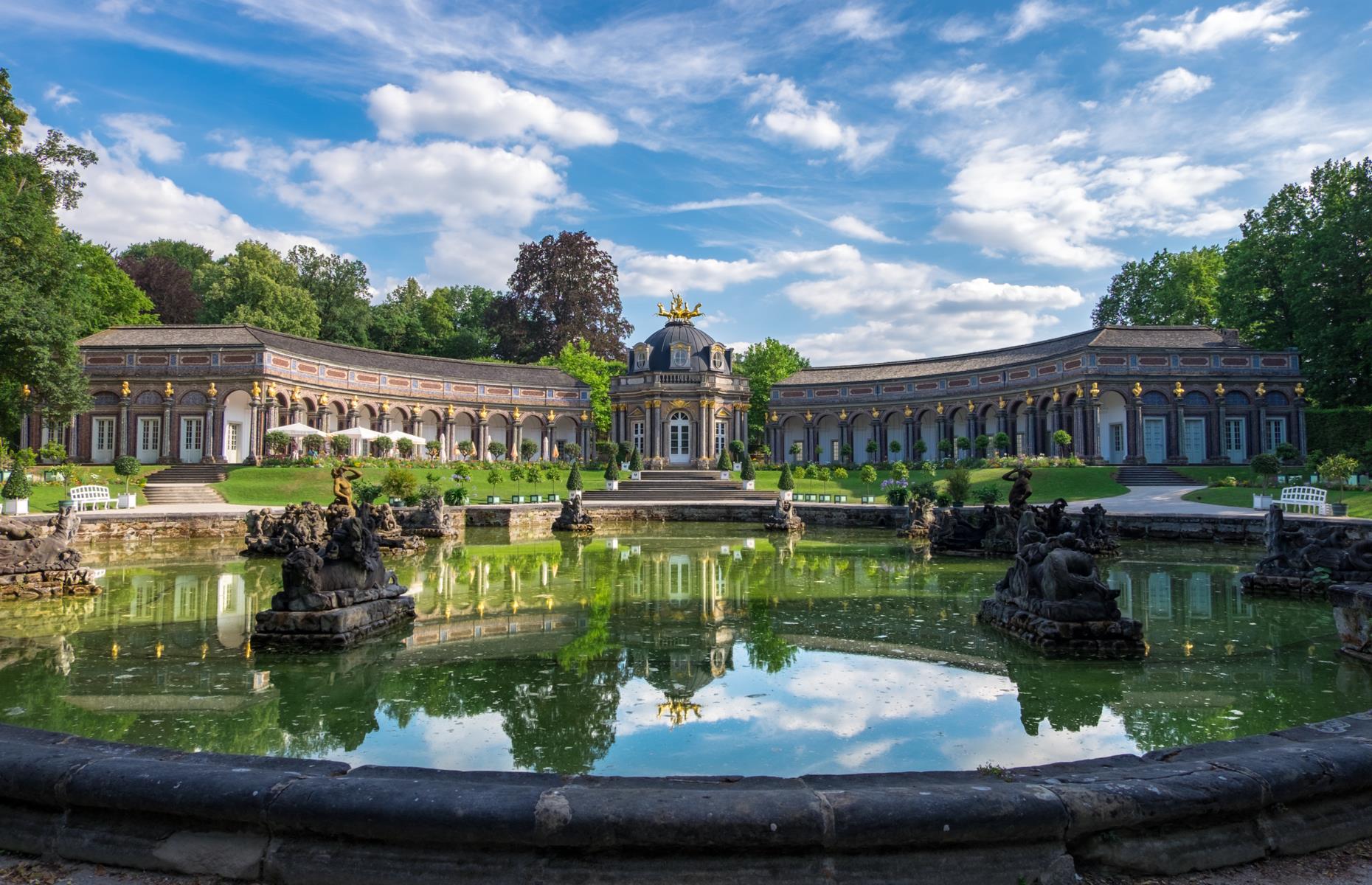
Driving this route spans millennia and passes through some of Germany’s most stunning architecture, from hilltop fortresses and medieval ruins to lavish palaces and summer residences. The final castle is Hermitage Old Palace in Bayreuth, built in 1715 by Margrave Georg Wilhelm for his wife Wilhelmine, who extended it into a lavish example of Rococo architecture (pictured).
Discover Germany's most beautiful towns and villages
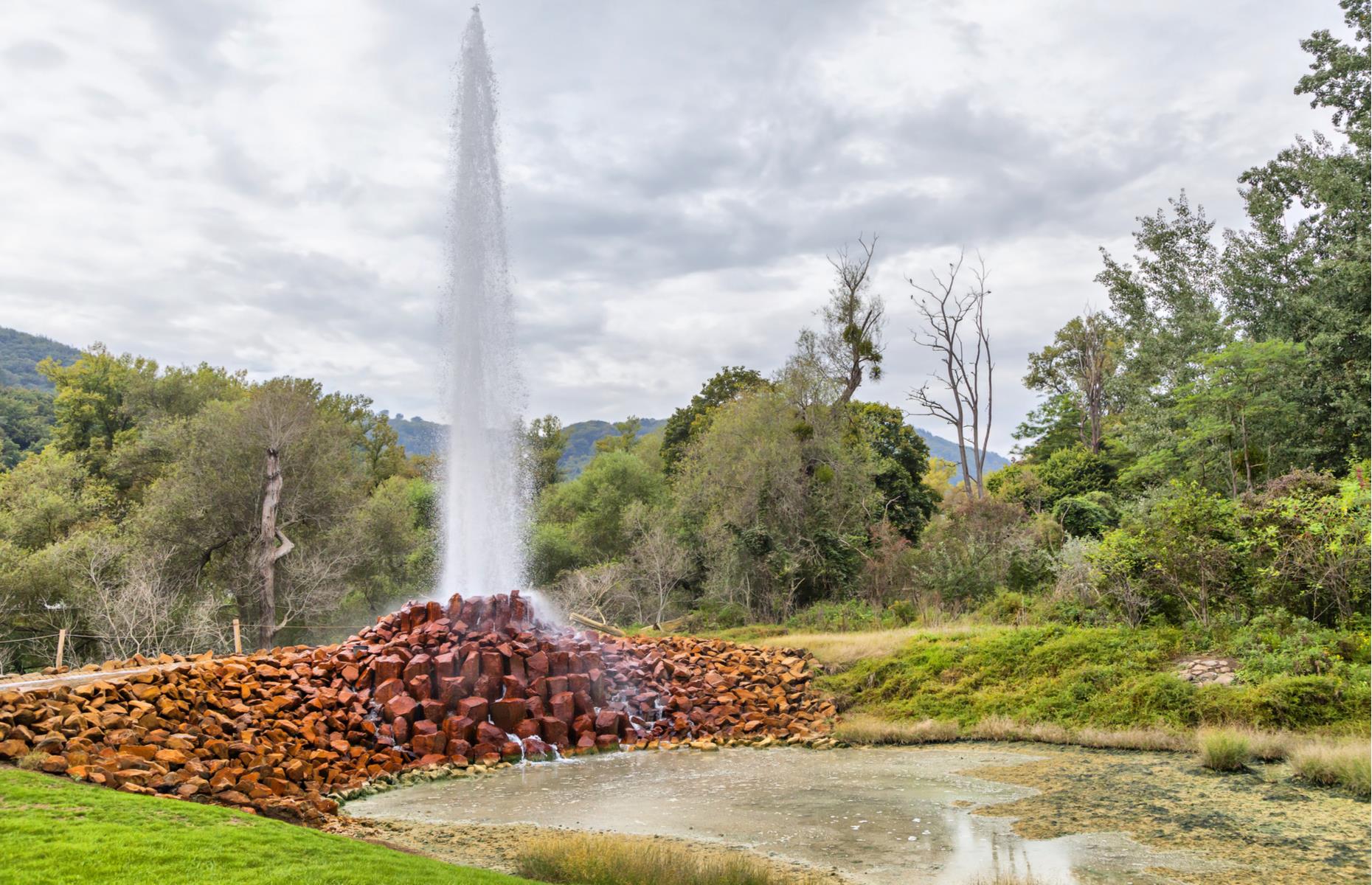
Bonn to Trier
The Volcanoes Route showcases a side of Germany beyond its famous castles and captivating, culturally rich cities. This 174-mile (280km) journey passes through the mountainous Eifel region, which is the country’s most geologically active area and – as the scenic route’s name suggests – strings together several volcanoes. It’s a starkly beautiful landscape shaped by lava flow, although thankfully the volcanoes have laid dormant for around 10,000 years. Signs along the route weave together stories of eruptions, while highlights include the caldera lake Laacher See and nearby Andernach Geyser (pictured).
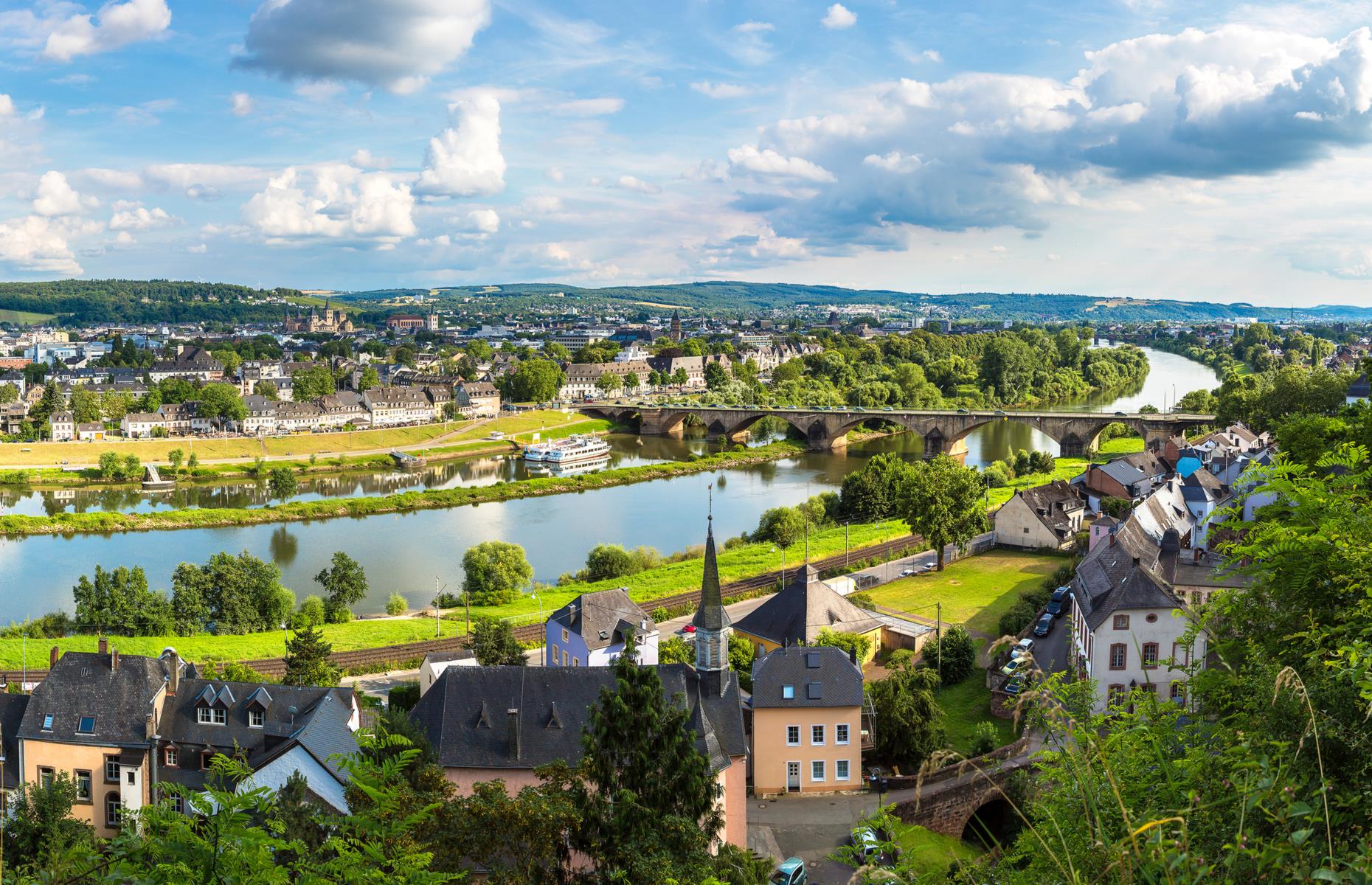
Easily completed at a leisurely pace within a day, the route also passes cinder cones, quarries and spurting geysers. It ends at the southwestern city of Trier (pictured), once a Roman colony and trading hub known as the “second Rome”. Unsurprisingly it’s rich in architecture, including the 4th-century High Cathedral of St. Peter, the oldest bishop’s church in Germany. It stands above a former emperor’s palace, with the original Roman walls still visible inside. The setting is particularly lovely, with the city arranged by the Moselle River and surrounded by vineyards.
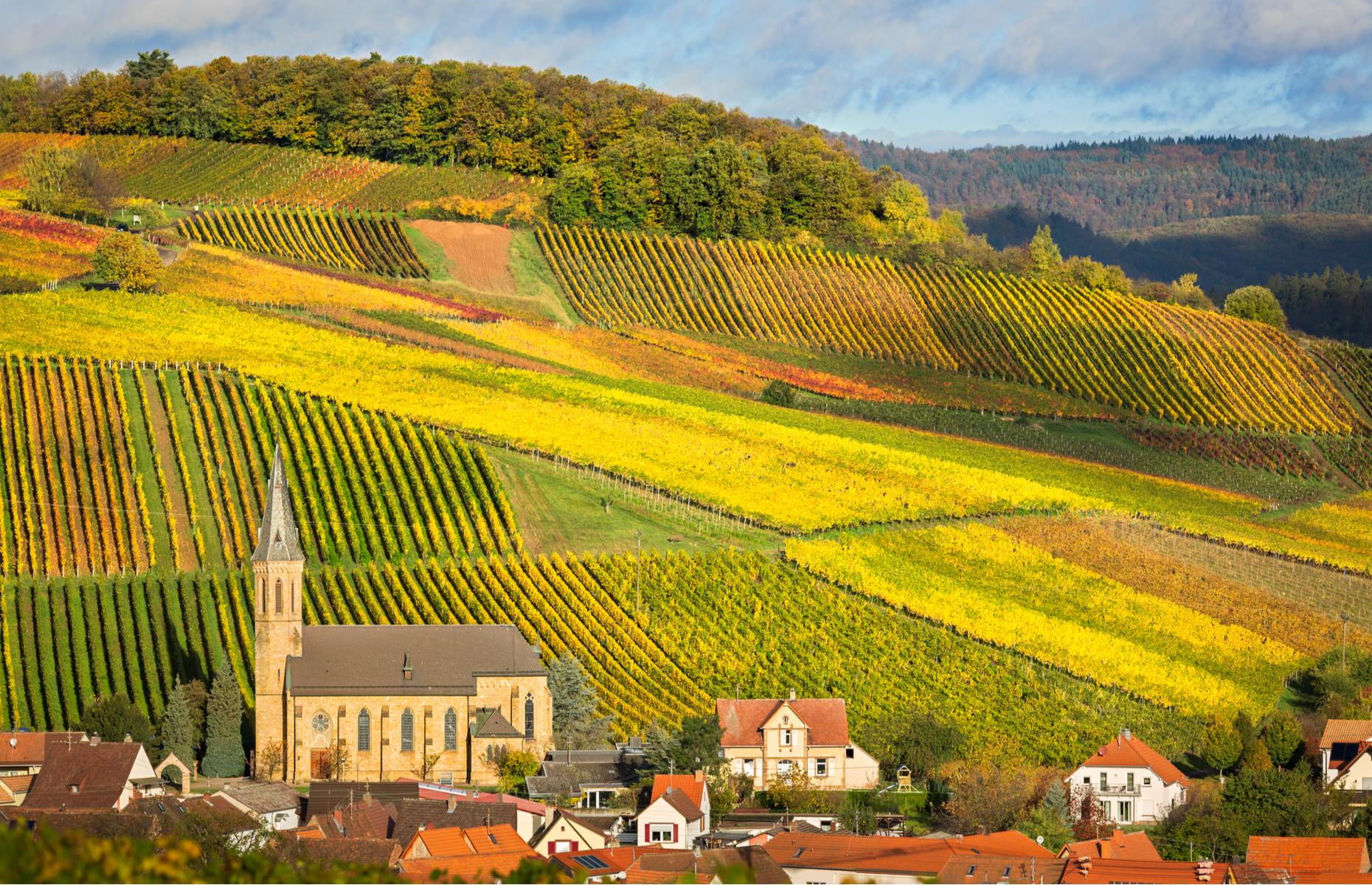
Frankfurt to Schweigen-Rechtenbach
Incorporating the country’s oldest scenic drive, the German Wine Route which was designated in 1935, these 115 miles (185km) or so are best taken slowly, especially for those who plan to taste some of the renowned Riesling wines along the way. From Frankfurt, the road dips south to Bockenheim, the route’s official starting point, and plunges right into the heart of the Palatinate or Pfalz wine region (pictured).
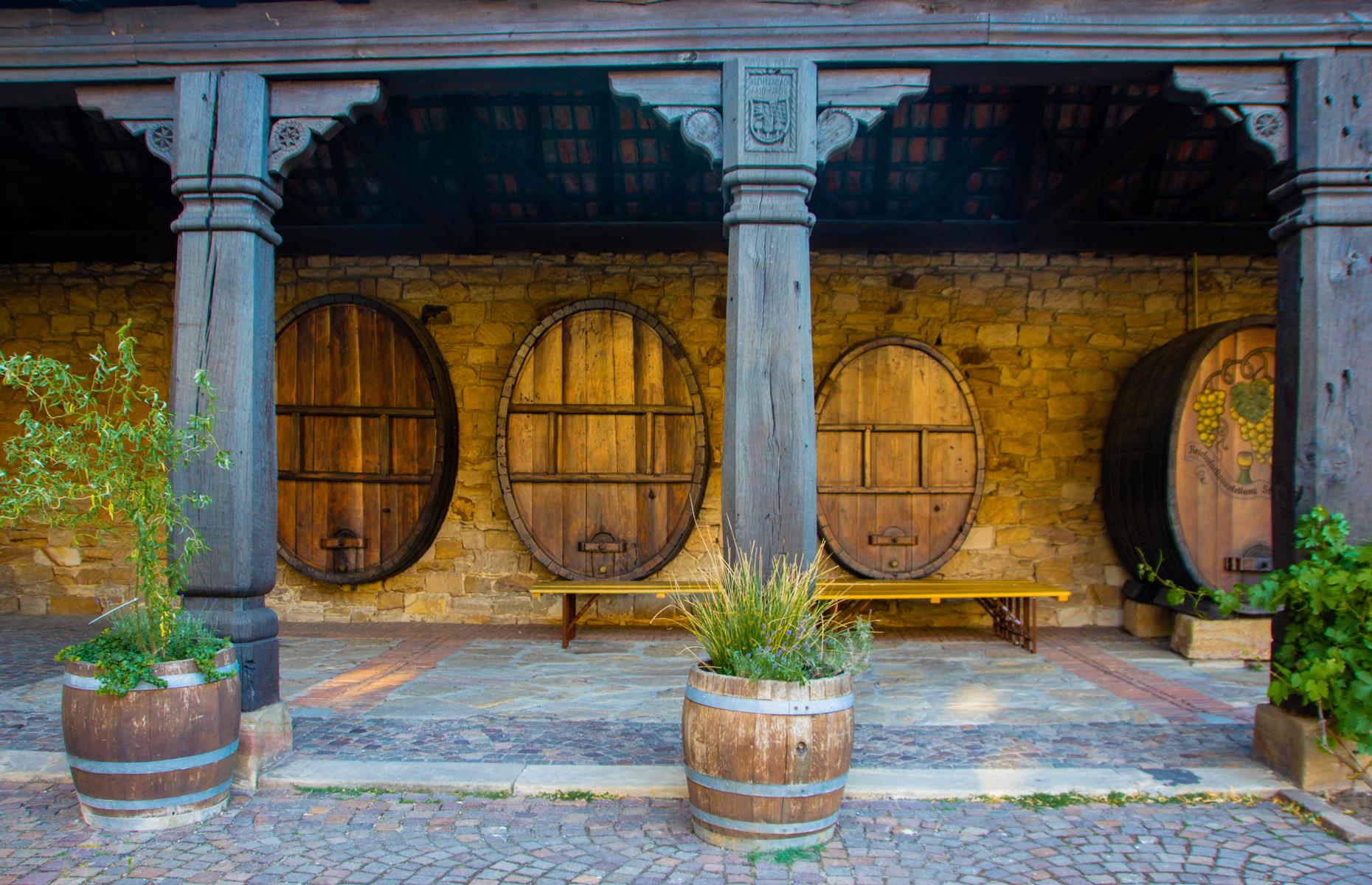
Tasting rooms, pretty villages and even roadside sampling spots line the route, while the Dürkheim Barrel – the world’s largest wine barrel used for dining and tasting – is a must-stop. It’s an especially pretty stretch in spring, when almond trees are in full blossom and fruit shrubs are bursting into life. The route ends at the German Wine Gate (pictured) in Schweigen-Rechtenbach on the border with France.
Love this? Follow our Facebook page for more travel inspiration
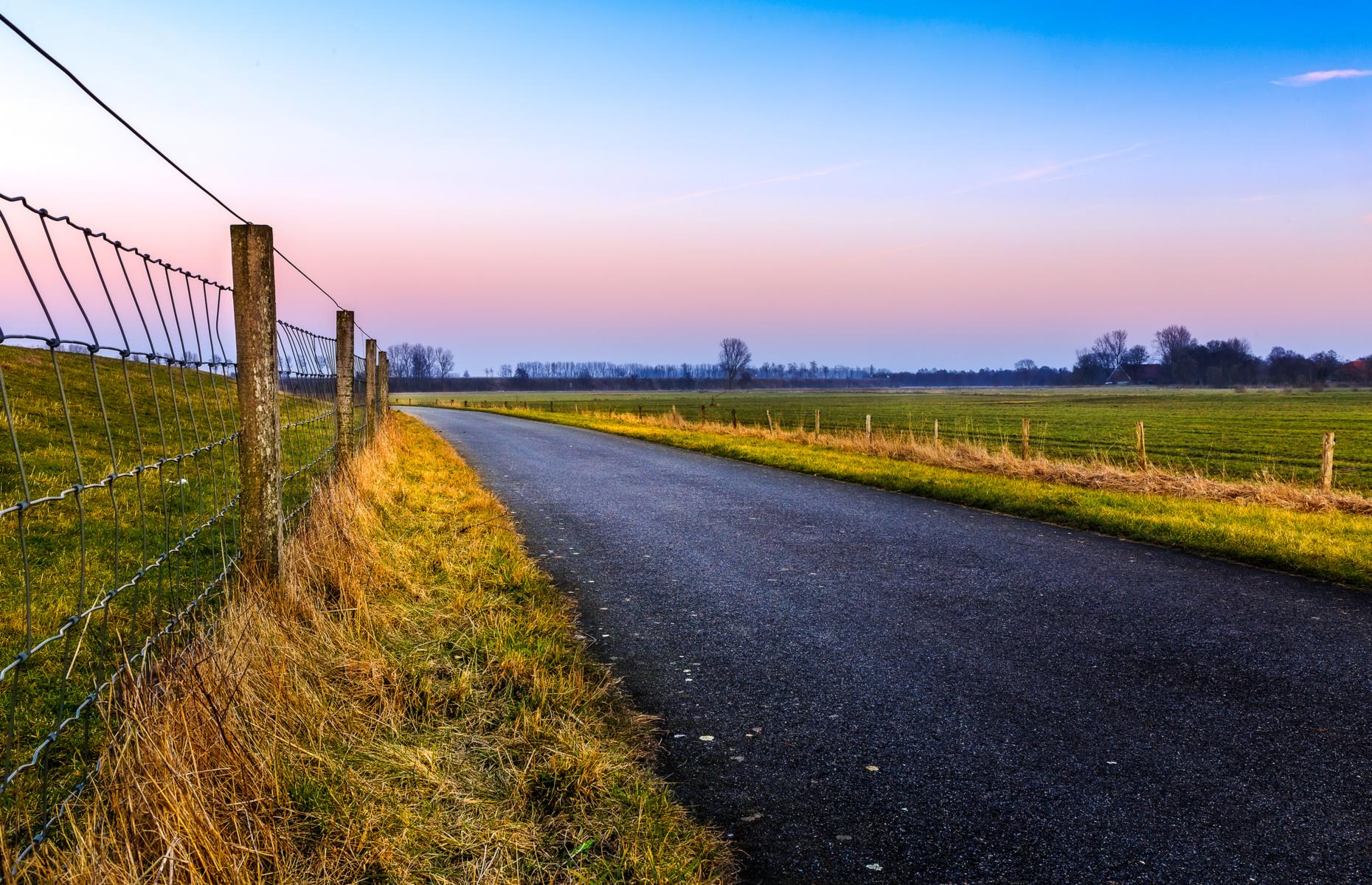
Papenburg to Papenburg
Starting and finishing in Papenburg, a city in the northern Emsland region of Lower Saxony, this scenic 106-mile (170km) loop – also a popular cycling route – heads north to Aurich before circling back. Along the way, it takes in landscapes from a patchwork of greenery and farms in the Ammerland region, to charming canal-side villages. Skirting near the border with the Netherlands, the Fen Route is named for the Dutch word “fehn”, referring to the methods used in the 16th and 17th centuries to dig canals for drainage by marshland.

The views are unrelentingly glorious, from meadows with picture-book windmills to nature reserves. Back in Papenburg , a vibrant port city known for shipbuilding, several museums trace the history of sailing and the shipping industry in the region. The city is also laced with canals, crossed by bascule bridges (drawbridges) and dotted with permanently moored, historic ships (pictured).
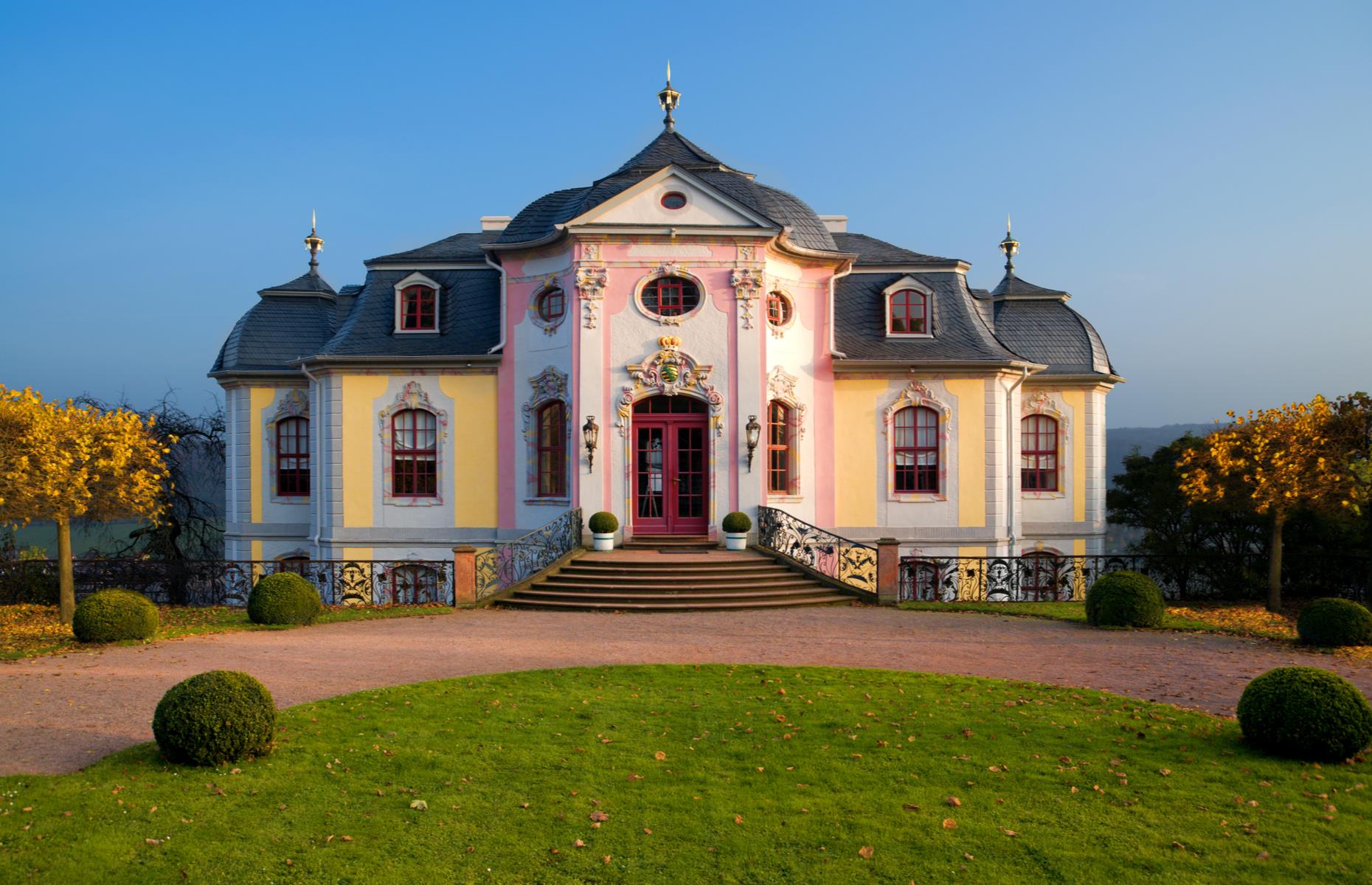
Weimar to Dessau
The influence of Bauhaus, a progressive design movement born in Weimar in 1919, can still be seen in buildings around the world. But its tenure in its home country was relatively short-lived, with the school forced to close by the Nazi regime in 1933. This fascinating trip – covering around 178 miles (286km) – takes in important Bauhaus sites including Weimar’s new museum , 1923-built experimental house Haus am Horn and Dornburg, whose Rococo palaces (pictured) are home to the Bauhaus Pottery Workshop.
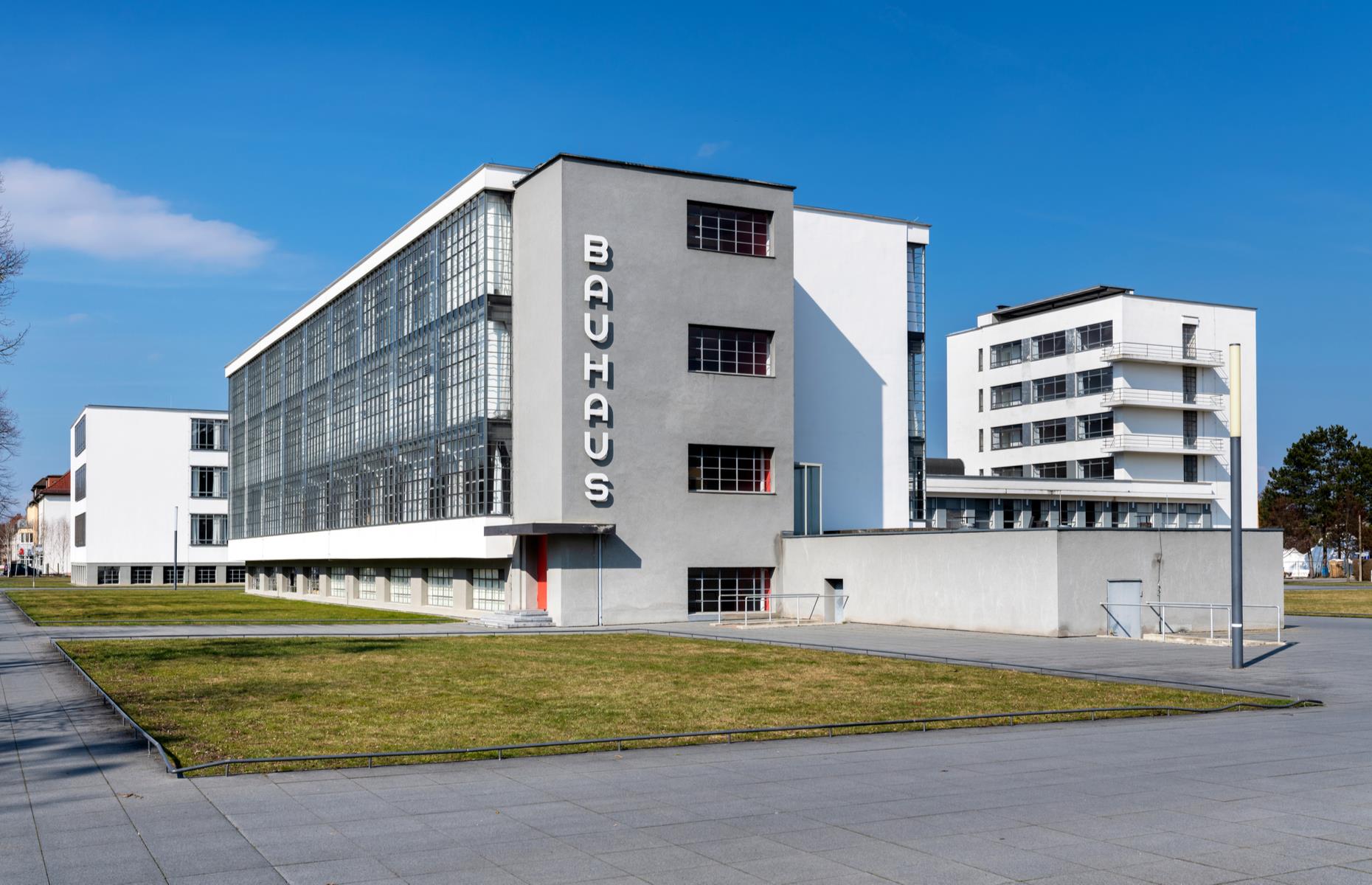
Other stops include Chemnitz, known as the City of Modernity thanks to buildings such as Villa Esche , and Leipzig’s Grassi Museum whose distinctive stained-glass windows were designed by Josef Albers, who taught at Bauhaus. The final stop – Dessau – was home to the school from 1925 until it was forced out of the country. Here, the Bauhaus Building , designed by the movement’s founder Walter Gropius as the new school and workshop, is now UNESCO-protected.
These are Germany's most historic sights

Düsseldorf to Mainz
Officially designated as the Romantic Rhine route, this road trip scoops up some of the country’s most beguiling cities and stunning landscapes into its 155 miles (250km). Think majestic cliffs, rolling vineyards and fascinating castles clinging to forest-blanketed hillsides. The scenic journey starts in riverside Düsseldorf before heading south to Cologne, whose fabled Gothic cathedral dominates the landscape. The road continues to beautiful Bonn before unfurling through the spectacular Rhine Valley (pictured).
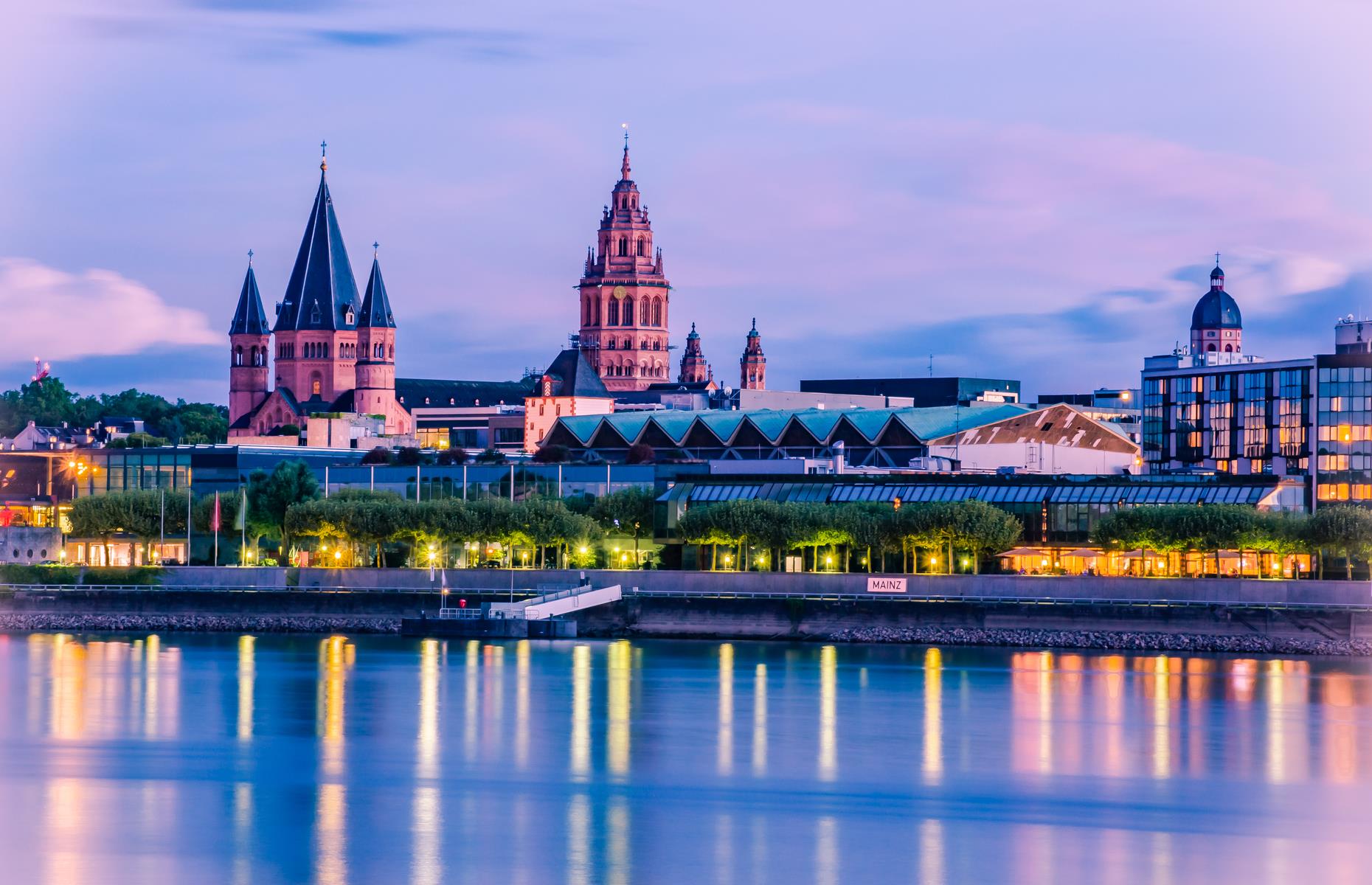
The final destination on this inspiring route is Mainz (pictured), just south of Frankfurt. Sitting pretty at the confluence of the Rhine and Main Rivers, it’s both charmingly quaint and wonderfully vibrant, with wine bars and restaurants in half-timbered houses. The city’s crowning glory is the Romanesque Mainz Cathedral, dating back to the 10th century.
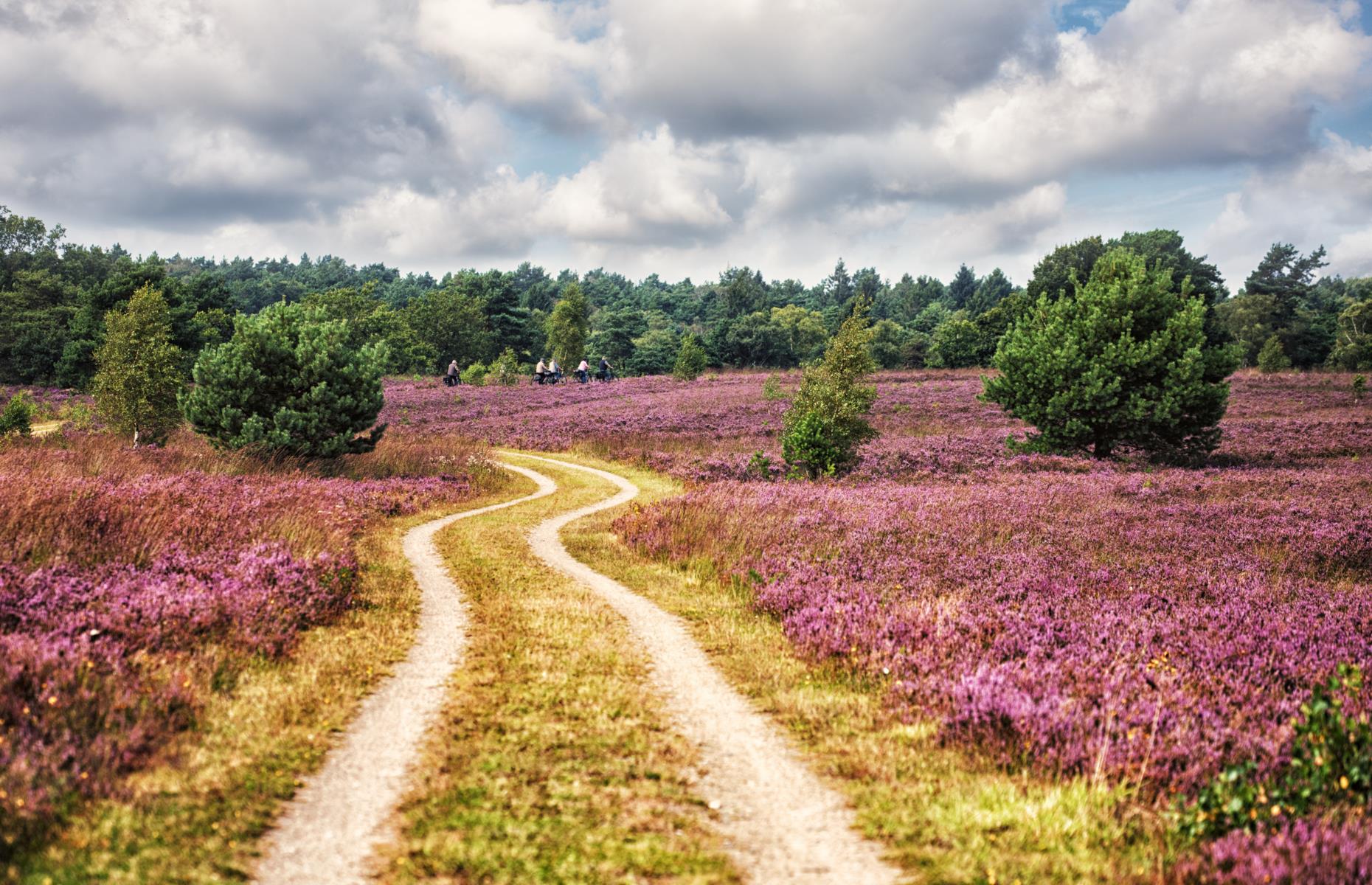
Hanover to Hanover
Dubbed the Asparagus Route , this journey really is all about the vegetable, although the pretty scenery should appeal even to those who dislike the spears. Lower Saxony is the heart of asparagus growing in Germany and this loop links up around 470 miles (756km) of towns, farms and countryside. The route officially starts and ends in Burgdorf, known for white asparagus, though Hanover is the closest big city (around half an hour away by car). Then it’s a journey tracing the vegetable’s heritage from root to tip, with Lüneburg Heath (pictured) among the gorgeous places it grows.
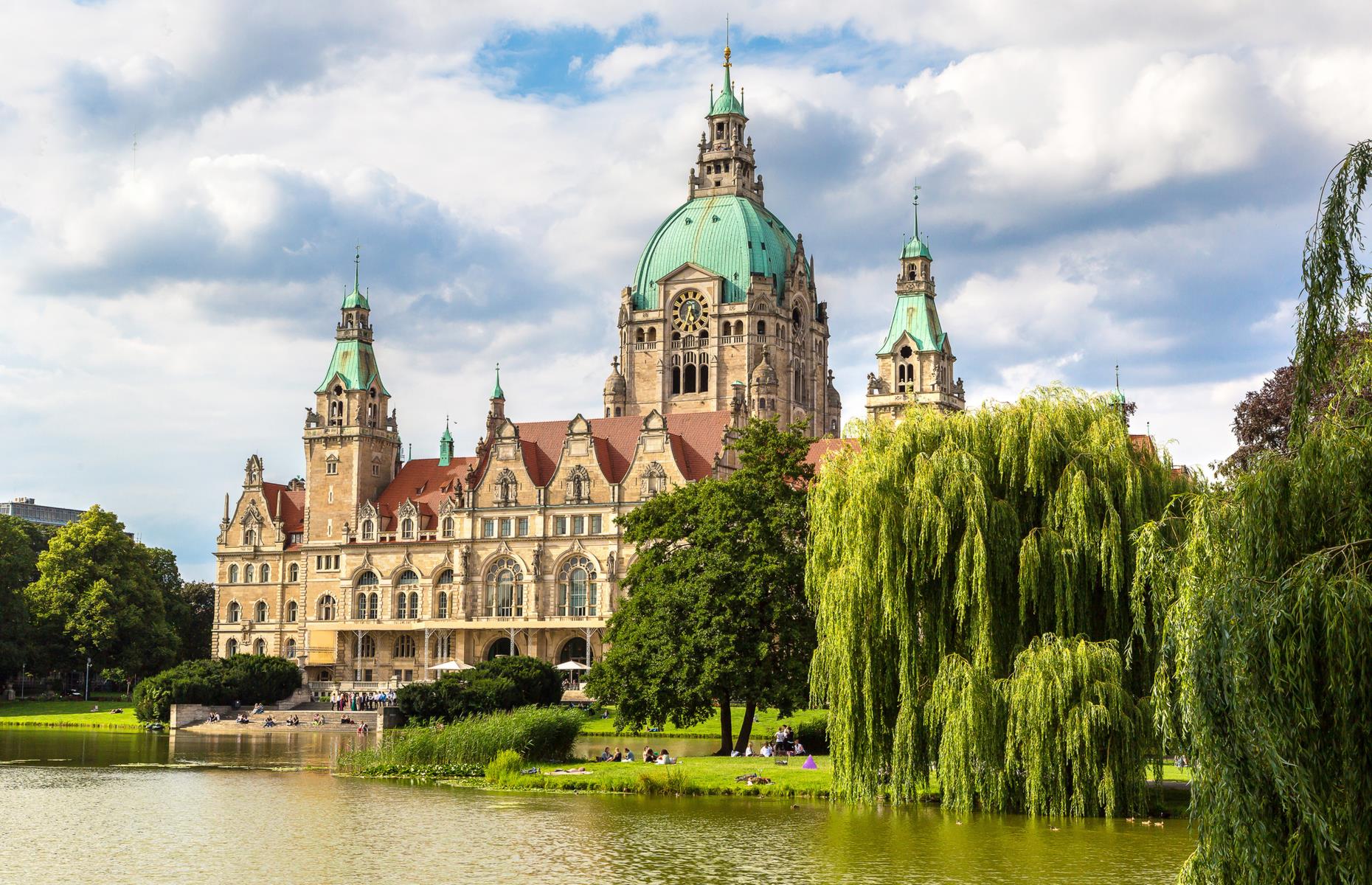
The road is happily well-signposted and also traverses the asparagus-growing regions of Brunswick, Mittelweser and Oldenburg Münsterland. During harvest season, usually from April to June, the spears can be sampled along the route and in restaurants, while the plants – bearing red berries – look lovely in fall too. Bookending the trip, Hanover has some incredible architecture including the 14th-century Market Church and the elegant, castle-like New Town Hall (pictured) dating from 1913.
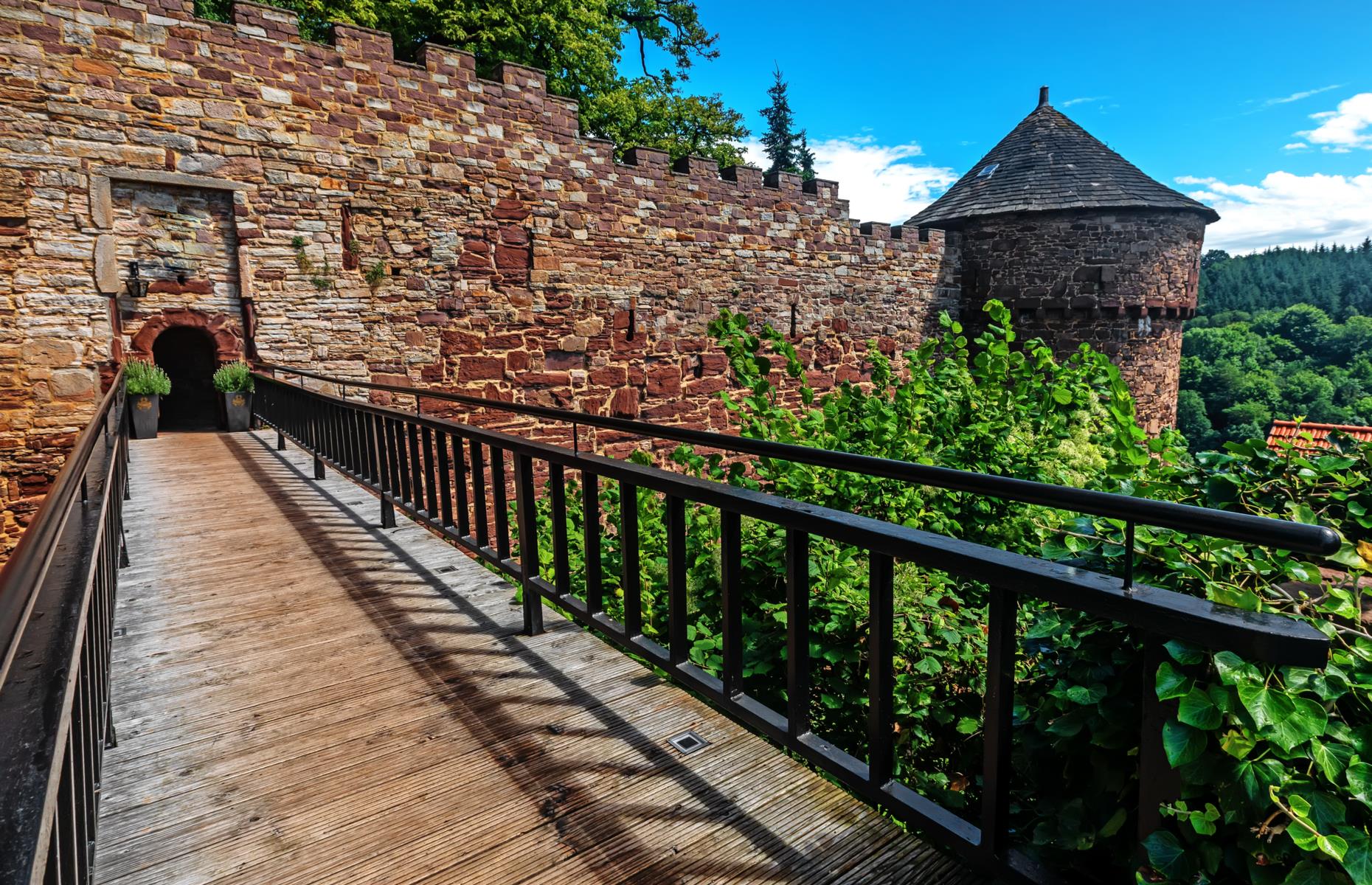
Frankfurt to Bremen
Fairy-tale scenery is almost commonplace in Germany, so it stands to reason there’s a designated Fairy Tale Route , known as Märchenstraße. The route joins up magical sites connected to the works of the Brothers Grimm (Wilhelm and Jacob). There are more than 60 stops marked out along its 375 miles (604km), including the brothers’ birthplace in Hanau, enchanting villages, and castles and palaces straight from a children’s picture book – including Trendelburg (pictured), the purported setting for Rapunzel. In Hamelin, the pavements are inlaid with brass rats, while Kassel’s Grimm World houses original manuscripts.

The journey is so pinch-me pretty that it doesn’t feel real, which is apt given the theme. Aside from fairy tales and folklore, the scenic route includes several nature parks, forests, flower-strewn meadows, mountains and rivers. At the journey’s end, Bremen has its own connection to the Brothers Grimm as the setting for their tale Town Musicians of Bremen , about a donkey, a dog, a cat and a rooster who journey to the city in search of a better life. A bronze statue in the market square pays homage to the legend.
Discover the world's most magical places
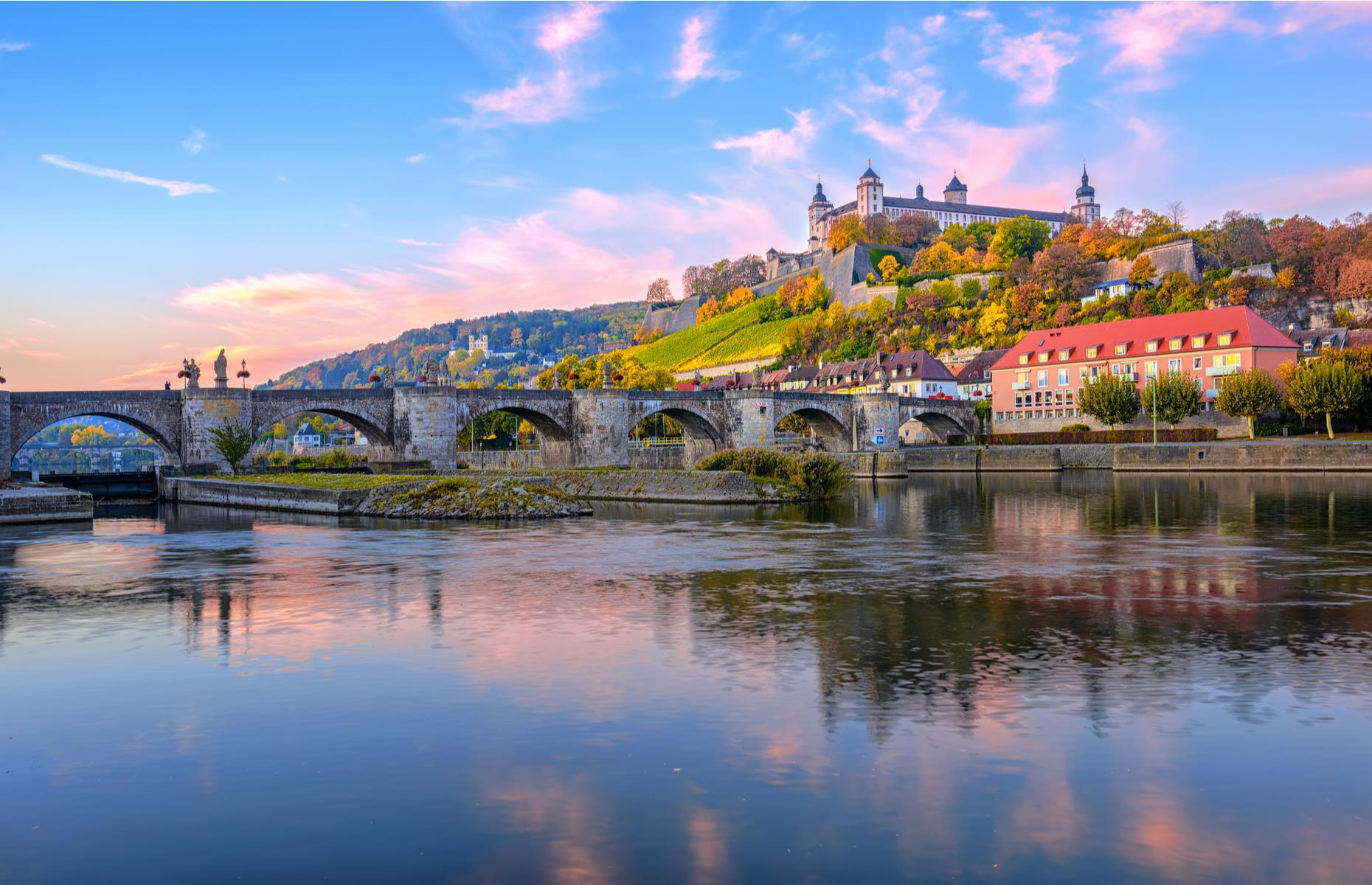
Würzburg to Füssen
The storybook scenery continues on this north-to-south route, known as the Romantic Road or Romantische Straße. It’s one of Germany’s most popular road trips for good reason. Lots of reasons, actually: chocolate-box Bavarian villages, vineyards in the Alpine foothills, medieval walled towns and dreamy hilltop castles are just a few of them. The 249-mile (400km) journey begins in Würzburg (pictured) and continues along to Füssen with a string of stunning sights.
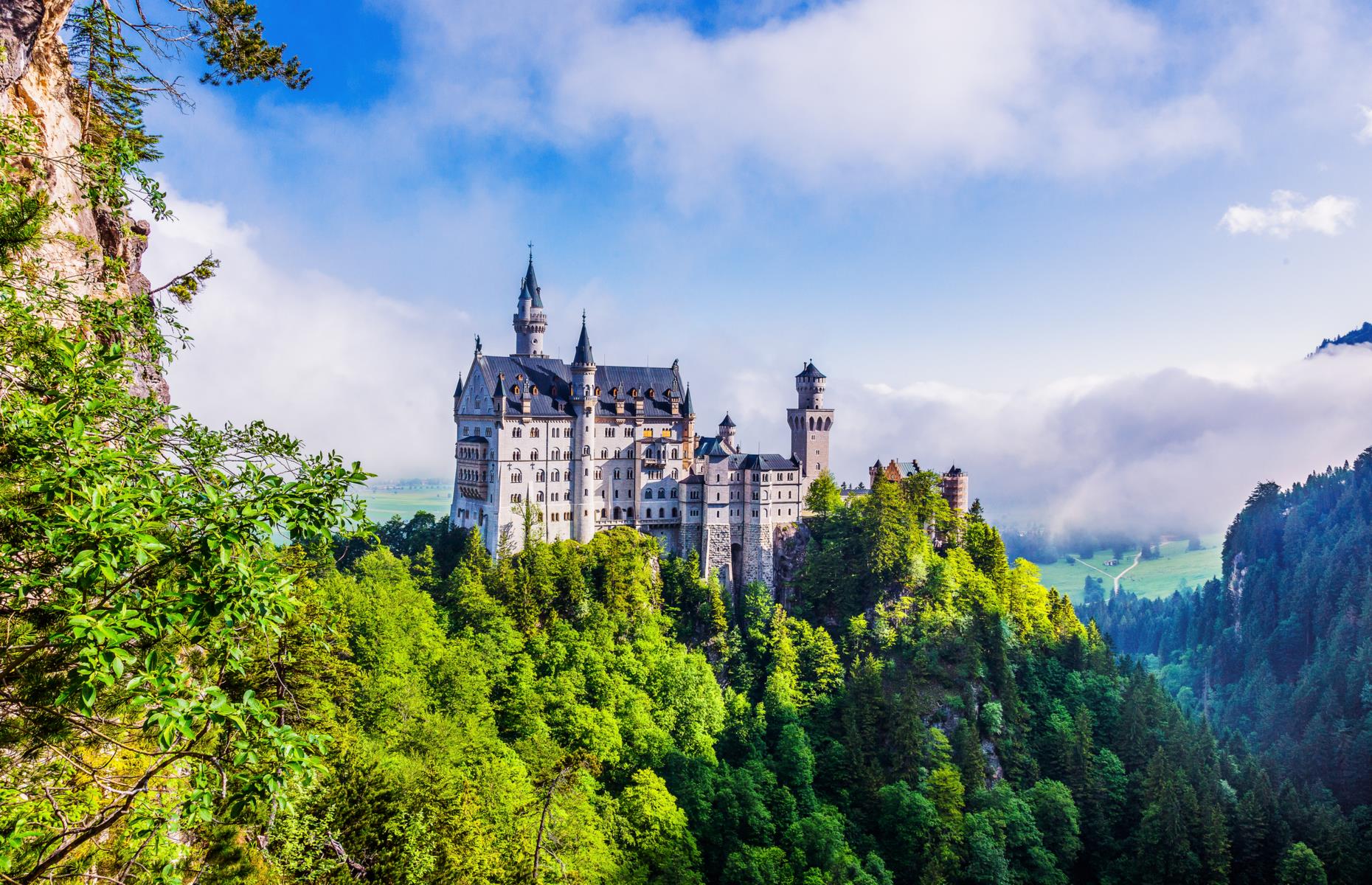
One of the route’s most spectacular sights is actually right at the end, near the Bavarian town of Füssen, and it links this journey with another spectacular road trip – the Alpine route or Alpenstraße. Bavarian King Ludwig II’s 19th-century Neuschwanstein Castle (pictured) is so ethereal and picture-perfect that it’s believed to have inspired Walt Disney’s Sleeping Beauty castle. Nearby Hohenschwangau Castle, the king’s childhood residence, is equally lavish.
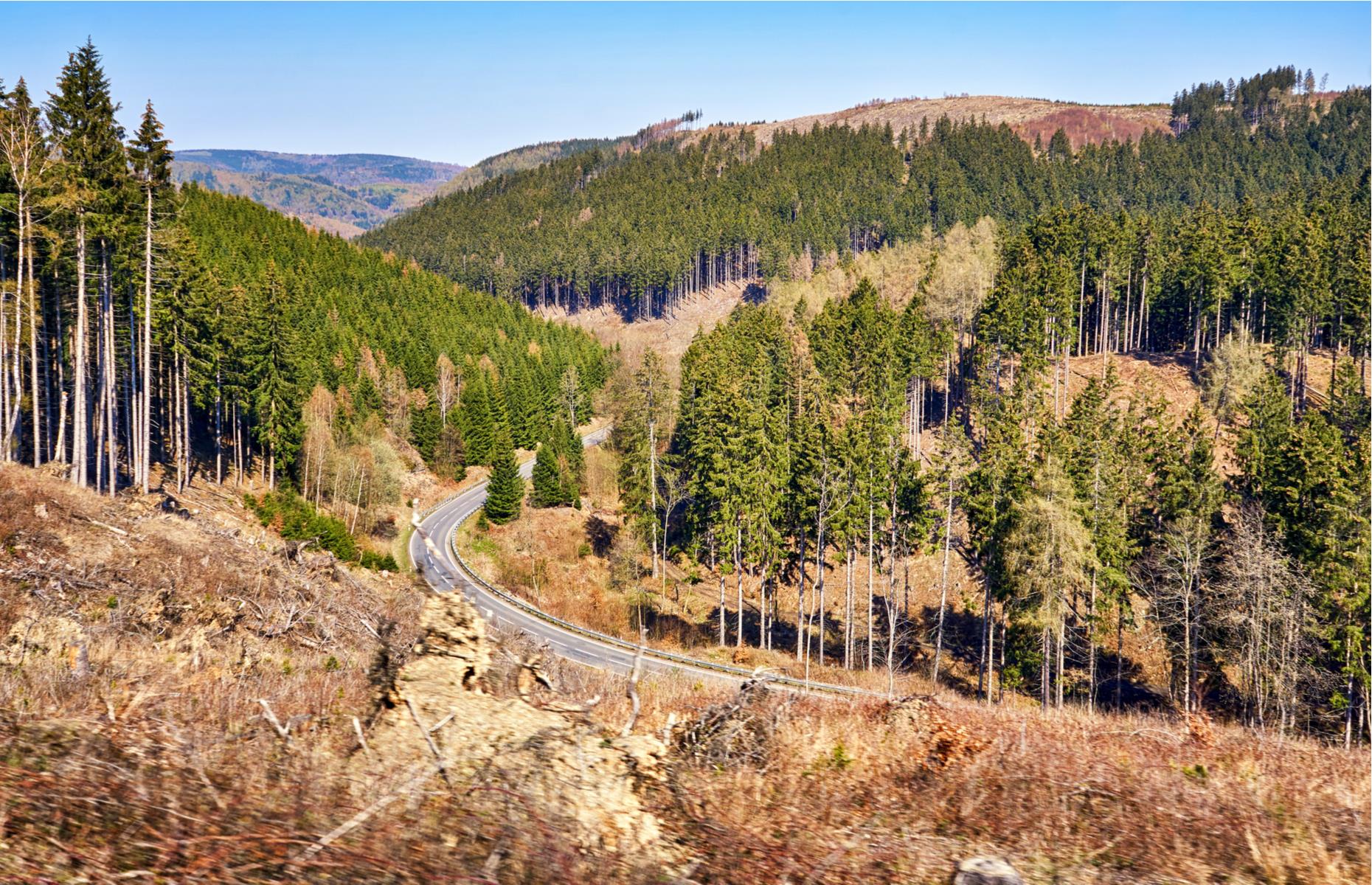
Berlin to Leipzig
The Avenues Route is all about the slow, scenic back way, and includes nearly 2,000 miles (around 3,000km) of tree-flanked road from the Baltic Sea in the north right down to Lake Constance in the south. This chunk of the route traces around 650 miles (1,046km) of these green avenues through the prettiest parts of central Germany. The route picks up in Dessau, around a 1.5-hour drive southwest of Berlin, before looping through the Harz Mountains (pictured).
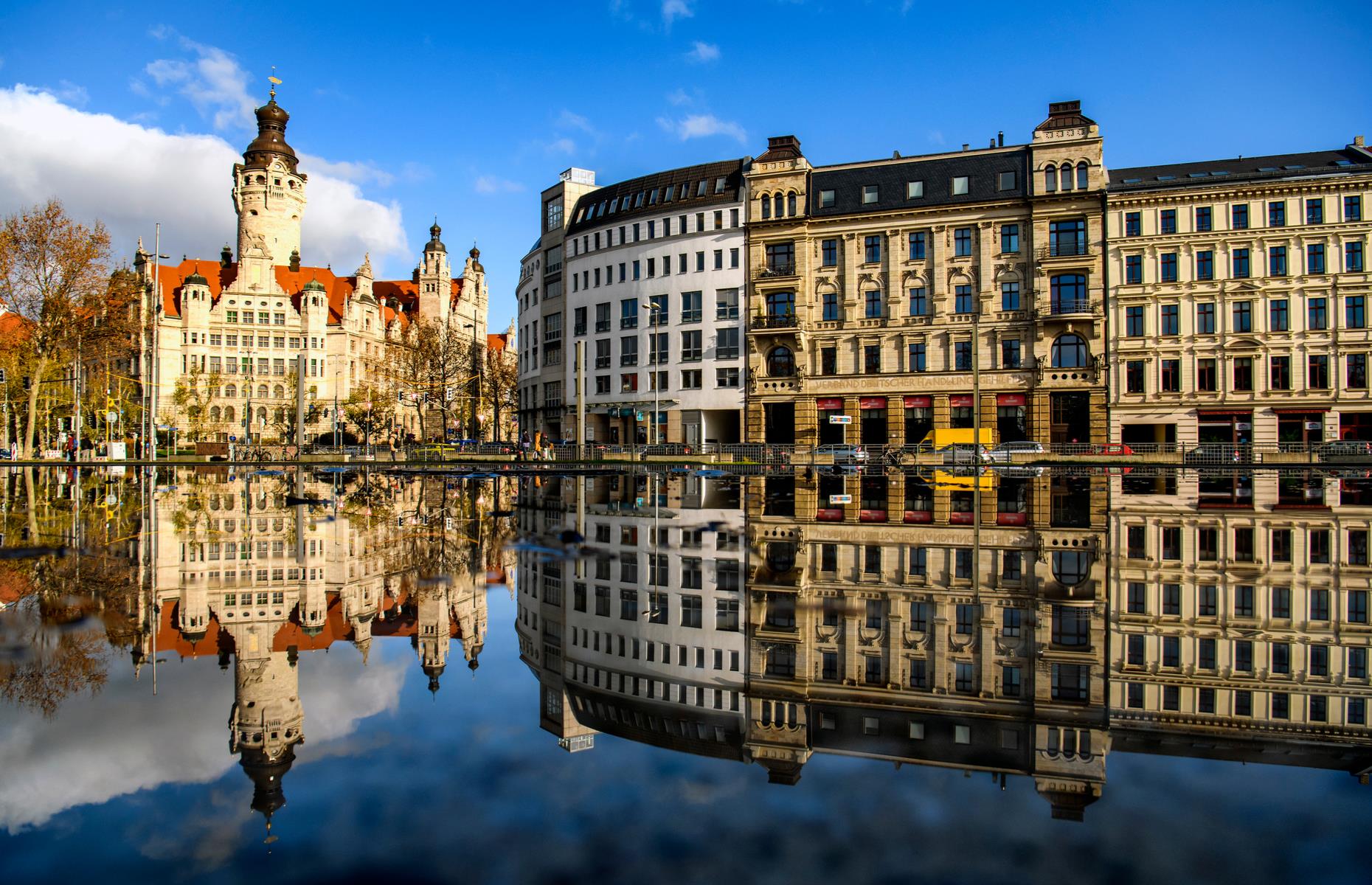
This road trip is like a jewel box of Germany’s charming spots, passing forests straight from fairy tales and villages with half-timbered houses. Quedlinburg is a particularly pretty example – cobbled lanes are lined with buildings in shades of spearmint and buttercup. The route also links up culturally rich cities including Erfurt, Weimar and Leipzig. The journey finishes in the latter, known for its elegant opera house and its New Town Hall, or Neues Rathaus (pictured on the left).
See Germany's most incredible natural wonders
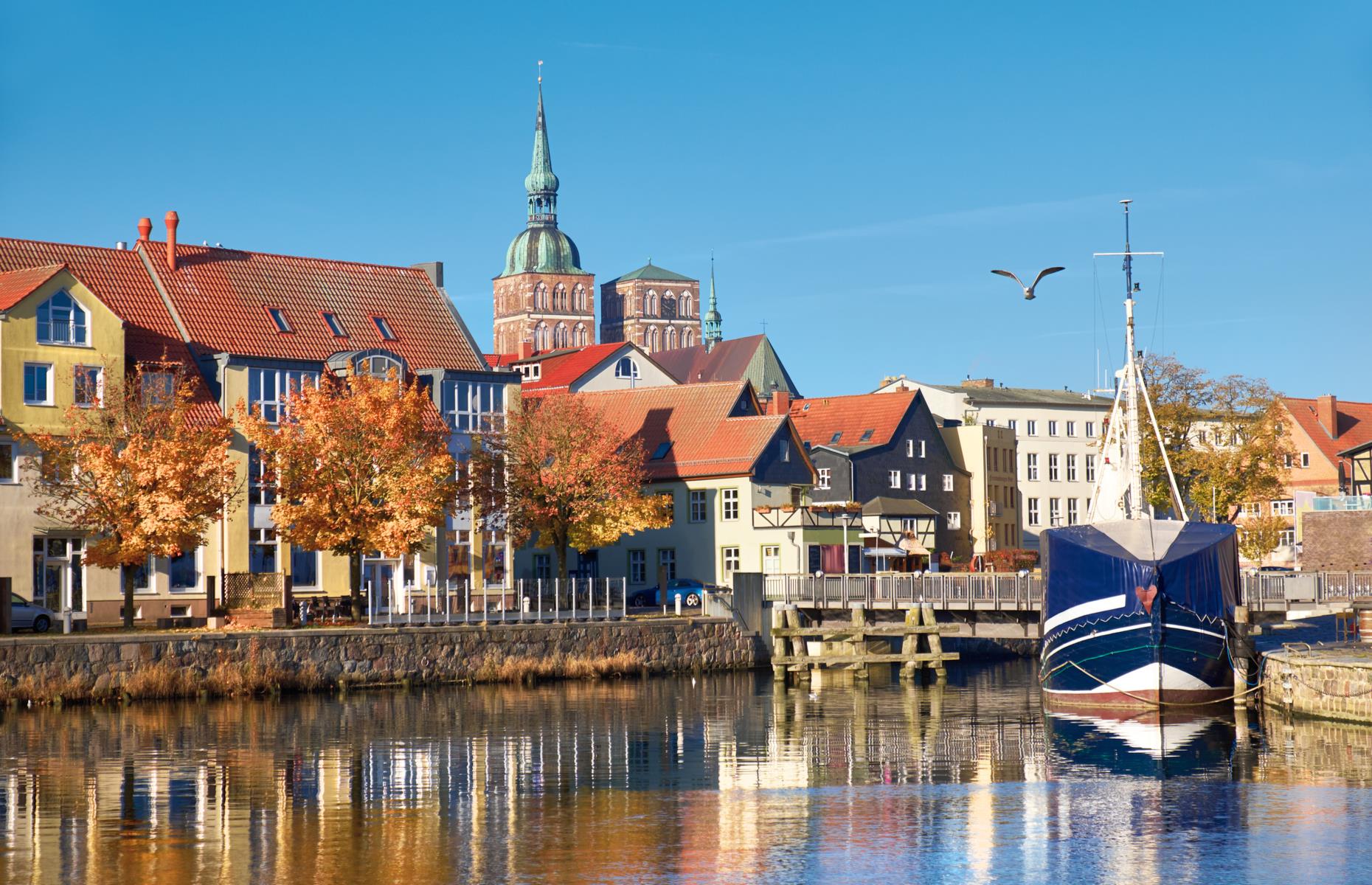
Lübeck to Binz
Take a trip to the seaside and breathe in the fresh salty air. This roughly 250-mile (402km) seaside drive showcases the glorious beauty of the Baltic coast, or “German Riviera”, tracing the shoreline from Lübeck – known for its medieval and Gothic architecture – and along the northern edge of the country. Opt for coastal roads that skim past the water, passing beaches, sand dunes and waterfront towns like Wismar and Stralsund (pictured).
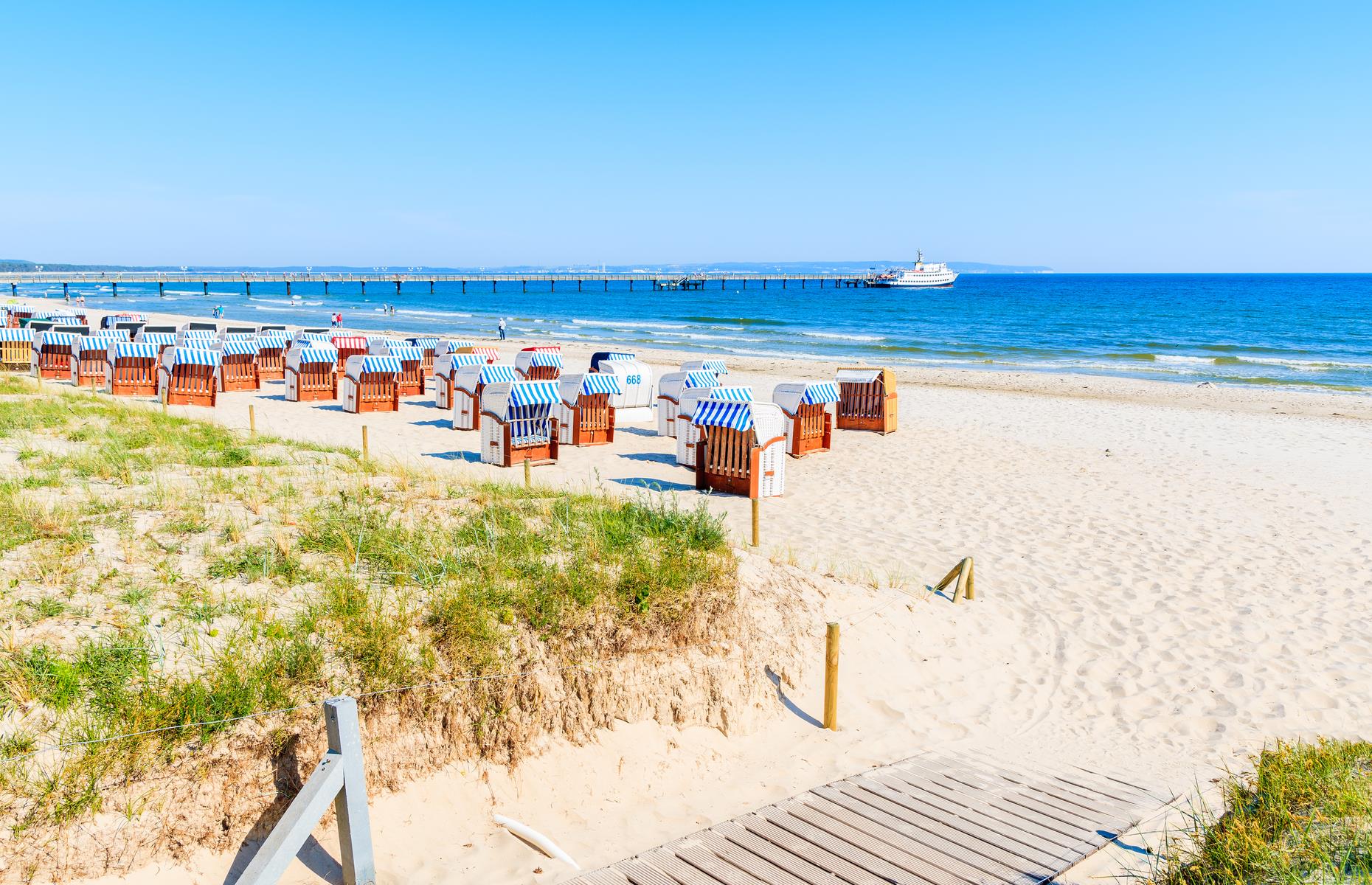
Binz is the final stop on this road trip and a real highlight. A seaside resort on the island of Rügen, it's famed for bright-white chalk cliffs and sand that’s just as pale and pristine (pictured). The island, linked to the mainland via a road from the Hanseatic city of Stralsund, is part of Jasmund National Park . It's a glorious blend of dramatic bluffs, ancient beech forest and gorgeous beaches lapped by blue-green water.
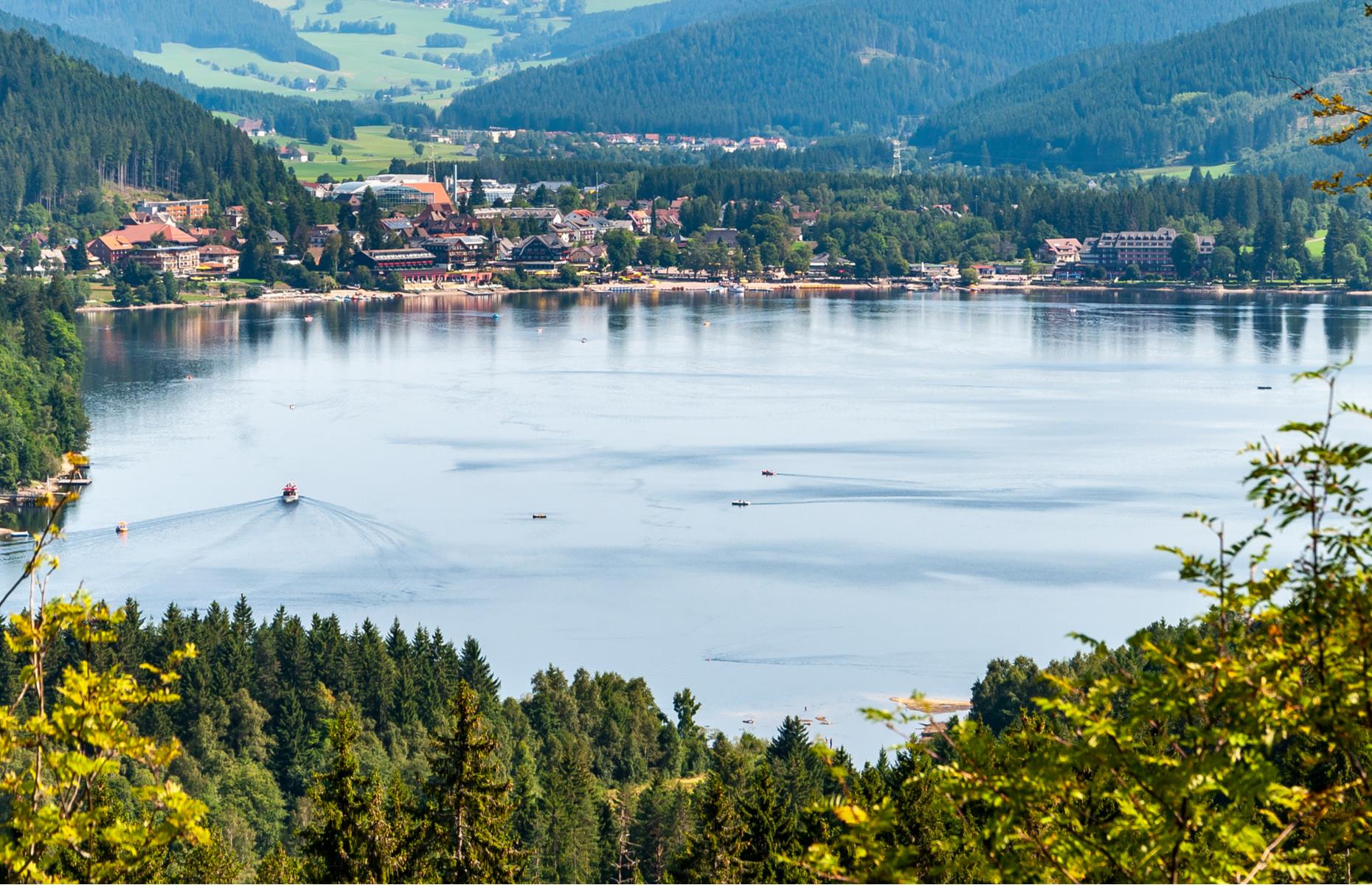
Stuttgart to Villingen-Schwenningen
It’s around a 1.5-hour drive from Stuttgart, the closest major city to this charming road trip, to the loop’s official start and end, Villingen-Schwenningen. Known as the Clock Route , it covers around 200 miles (322km) of the atmospheric Black Forest, famous for a history of intricate clock-making – particularly cuckoo clocks – dating back to the 17th century. The landscapes are spectacular, with the route taking in Triberg Falls, St. Peter's Abbey and Lake Titisee (pictured).
Read on for incredible German landmarks seen from the skies
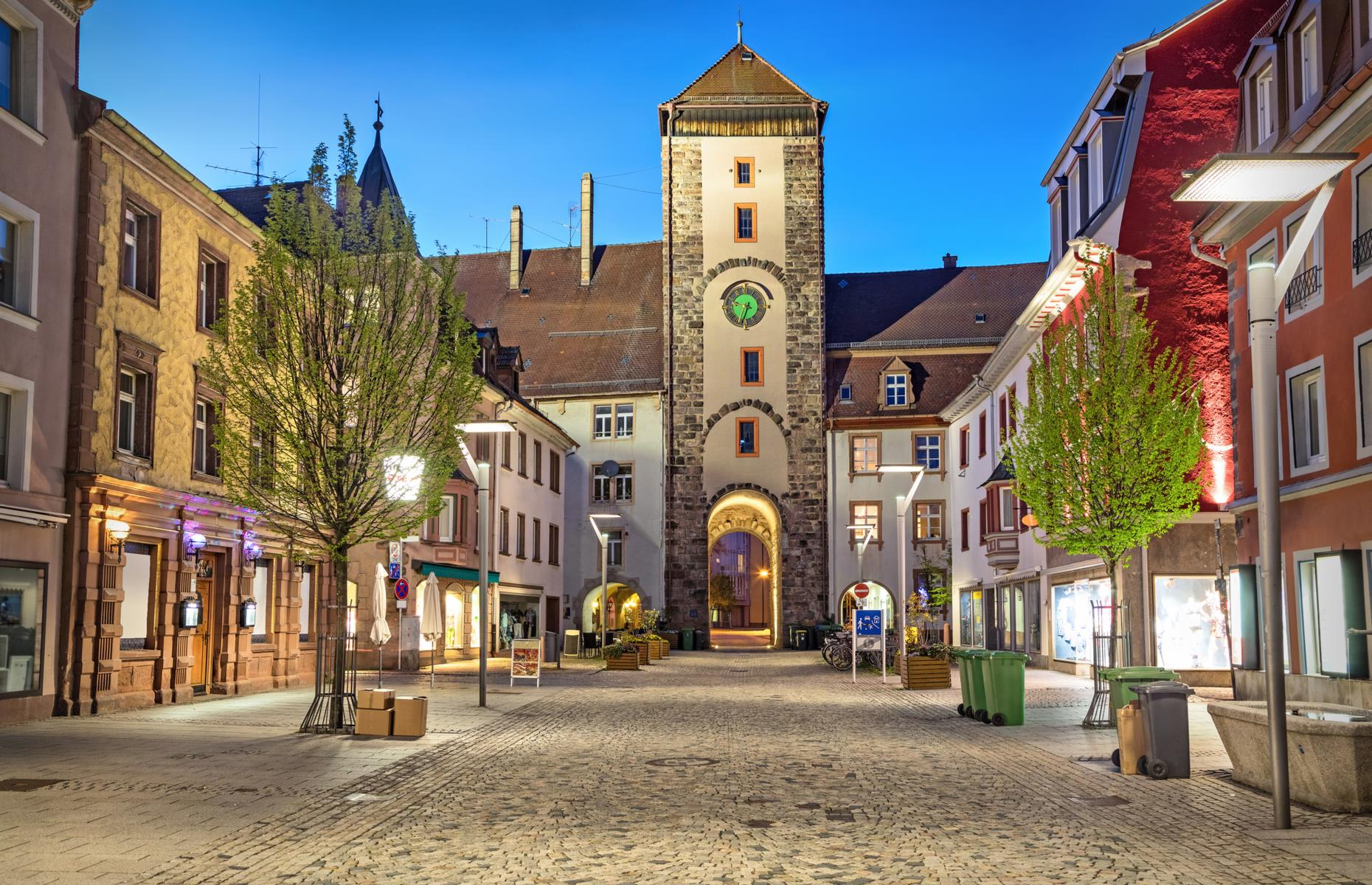
Museums dedicated to clock-making, workshops where people can see timepieces being made and villages with a tradition of the craft, are also laced into the itinerary. Villingen-Schwenningen, where the loop starts and ends, is itself a charming town on the edge of the Black Forest. Among its historic sites are three surviving 13th-century city gates , whose towers each have clocks with different colored dials – pictured is Obere Tor, with a green face.
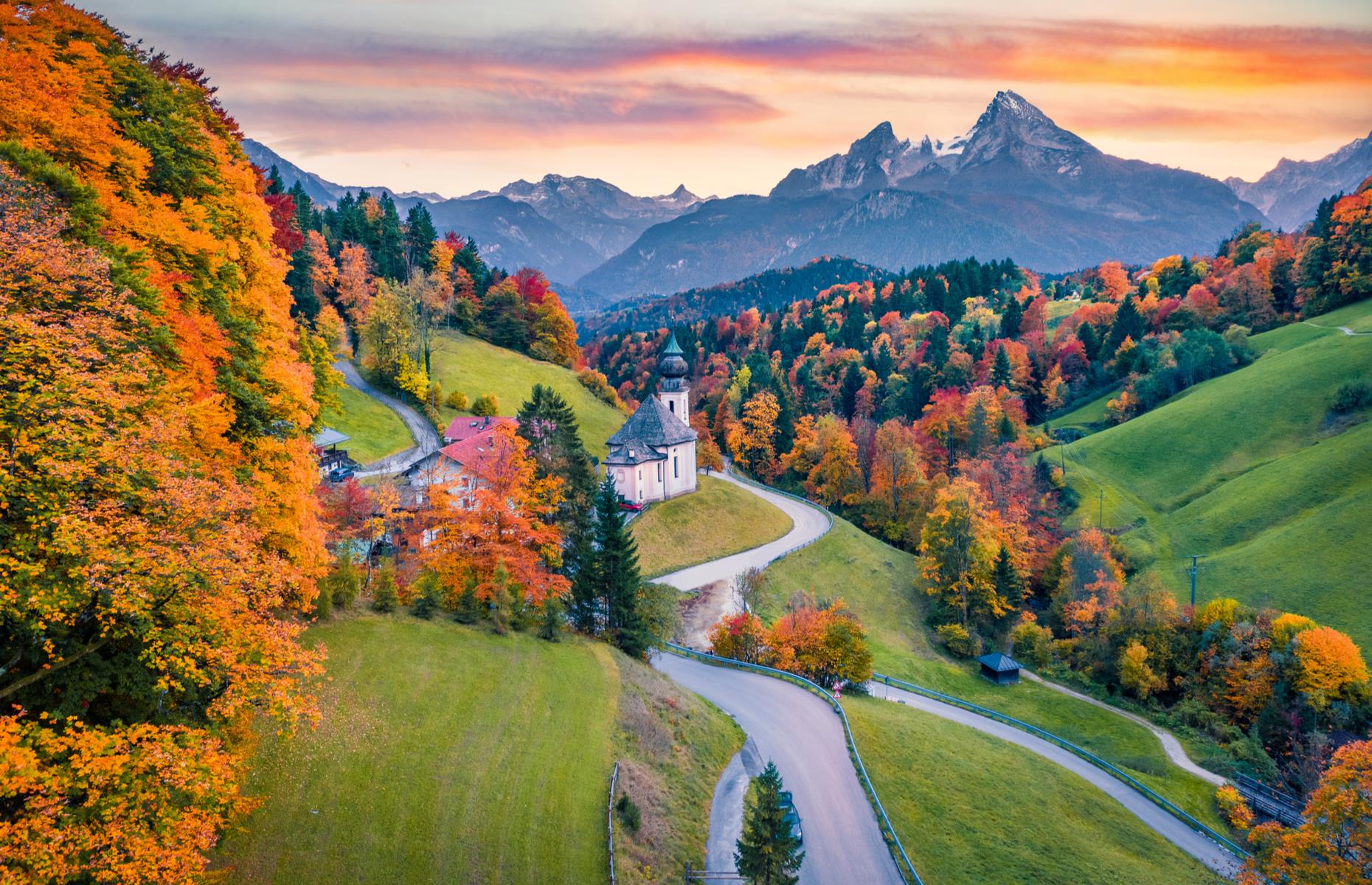
Munich to Lindau
The Alpine route or Alpenstraße is considered among the world’s most spectacularly beautiful drives, carving and curving through the Bavarian Alps and packing in breathtaking scenery. The roughly 175-mile (283km) journey from Munich to Lindau, via the stunning mountain town of Berchtesgaden (pictured), covers some of the best of it, passing dozens of castles, mountain peaks and limpid lakes. It also links up several dreamy spa towns and chocolate-box villages like Oberammergau.
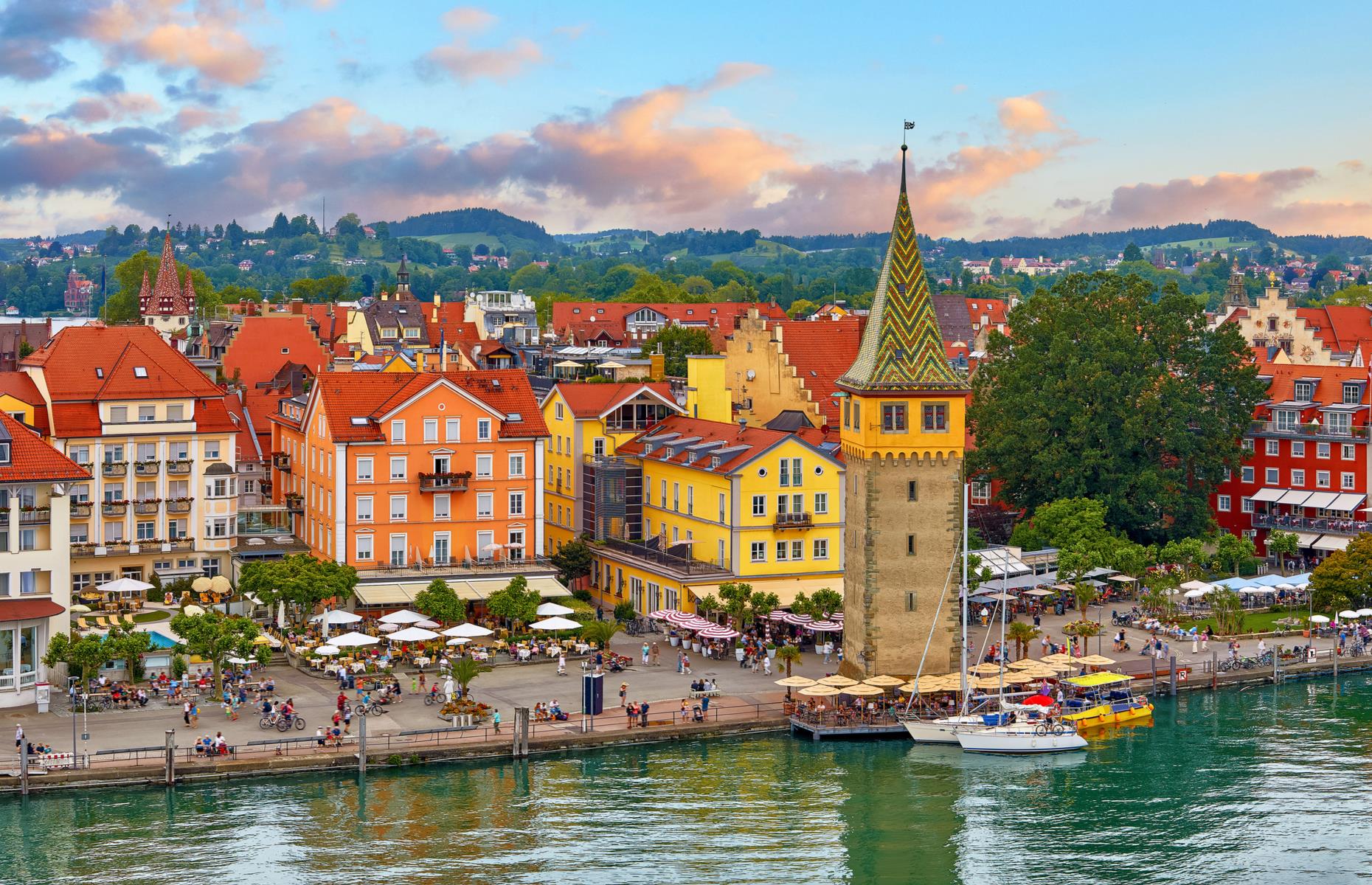
It’s a lot of beauty to live up to but the final destination of Lindau, on Lake Constance, is a match for the journey here. Its prime spot on the shores of Germany’s largest lake certainly helps, while its old town is like a chessboard crammed with striking structures. Among recognizable landmarks are the Bavarian Lion statue which signals the entrance to the harbor, a medieval lighthouse and the 12th-century watchtower Mangturm, whose roof is decorated with distinctive zigzagged tiles.
Now check out these surprising German sights around the world
More for You
Here's No. 1 thing mentally strong couples 'never' do, says relationship therapist of 20 years
I Was Told My Father Was A 'Deadbeat.' After He Died, I Found Out Everything I Knew About Him Was Wrong.
How Much Beer You'd Have To Drink To Equal A Single Shot Of Liquor
17 Phrases Older People Use That No One Else Gets
29 common human foods you may not realize are poisonous to your dog
Sports Cars As Cool as the Porsche 911 But Way More Affordable
Netflix’s new movie trailer slammed as ‘AI propaganda’
China could force Putin to leave Ukraine in 'major shockwave to Moscow'
I’m a psychologist and mom—here are 3 phrases I wish more parents would say to their kids
I'm a sniper in the US Army, and Hollywood doesn't show you the hardest part of my job
Unsellable Houses' Lyndsay Lamb Says Buyers Are Moving Away From This Color Trend
The Factory Turbocharged Car With The Most Horsepower In 2024
Martin Lewis issues warning to people choosing air fryer over oven
This is the ideal sleep temperature for older adults, new study finds
Caitlin Clark Tweaks Shoulder During Promotion at Bucks-Pacers Playoff Game
I Am Doing a PhD at 16—My Mother's Death Is the Reason
Best Movies Now on Netflix
Here is the true value of having a fully paid-off home in America — especially when you're heading into retirement
Hersh Goldberg-Polin's mother speaks out after Hamas releases hostage video of her son
What Happens to Your Body When You Eat Tomatoes Regularly

Best Germany Packing List for 2024
This post may contain affiliate links. Read my disclaimer policy.
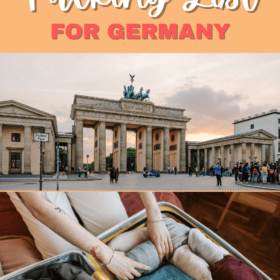
You’re planning a trip to Germany. What should you pack?!
I know how hard it is to decide what the must-bring items are (and what you should leave at home) before you even leave. In this guide I share what we bring on my trips to Germany and my best packing recommendations.
You can also check out the 15 most essential items we always pack here.
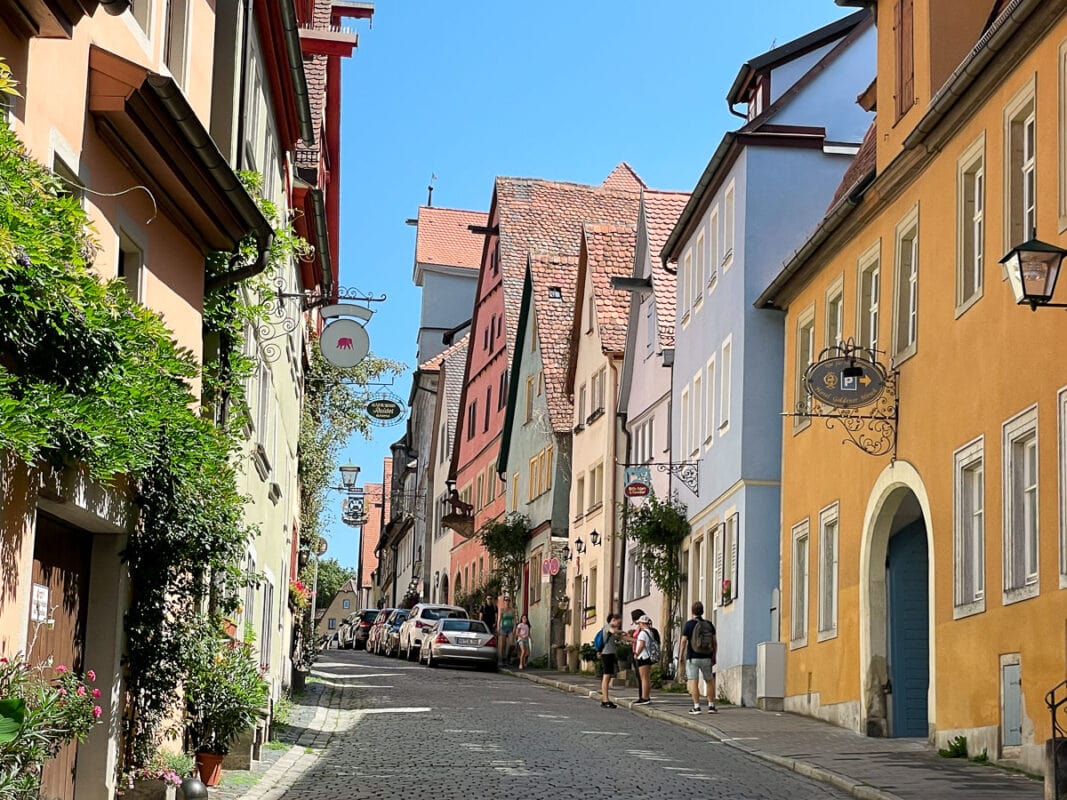
- 1 Quick Answer: Top Travel Items
- 2 Packing List for Germany
- 3 Luggage: Suitcases & Backpacks
- 4 Luggage I Use And Love:
- 5 Luggage: Day bags, Purses & Wallet
- 6 Packing & Organization
- 7 Doing Laundry & Hand Wash
- 8 Must-haves For the Flight
- 9 Clothes & Shoes
- 10 Technology
- 11 Other Must-Haves
- 12 Items I’m Thinking About Getting
- 13 Next Steps For Planning Your Trip:
Quick Answer: Top Travel Items
- Best European outlet adapter: we use this one every day
- Best power bank for charging your phone: we love this one to charge our phones on the go
- Best for keeping your phone secure: we use this Pop Socket and this wrist strap (Cate) and this wrist strap with this case (Aaron)
- Best TSA-approved bag for liquids: we’ve used this one for years
- Best refillable shampoo pouches: we love these flat pack pouches
Packing List for Germany
I’ve been traveling to Germany (and all over the world) for 30+ years and over the years have made every packing mistake you can imagine.
Join our FREE Germany Trip Planning Facebook Group!
I’ve overpacked, lugged around items I regretted packing, spent hours of my trip buying things I should have packed, and wasted more money than I’d like to admit.
Fortunately, I’m an excellent packer now! I’ve got packing down to a science. So I thought I’d share my most essential travel items.
This isn’t an exhaustive list of every t-shirt and skirt I bring, but everything on this list (except for just a few items at the very end) is something I’ve used for several years and love.
A few notes about how I travel and pack:
- I am mostly a carry-on only traveler, especially when I travel abroad. Sometimes I check my carry-on size suitcase or backpack out of convenience, but I still pack for carry-on only. Even when we traveled around Germany, Türkiye, and the UK for 6 months!
- I travel year-round for both work and fun, so I’ve learned how to pack for all seasons.
- I’m a frequent solo traveler but I also travel with Aaron a couple times a year. Update: now that we’re full-time digital nomads, we travel together most of the time now.
- My style is fairly practical. I like to be comfortable and I love it when items do double-duty. It’s not super important to me that I wear different and unique outfits ever day. I keep jewelry and make-up to a minimum when I travel.
- You’ll see below that I frequently say that I’ve had an item for years and years — it’s true! Except for a few items I have my eye on for my next trip, I’ve only listed the things I have used (and used and used) and love.
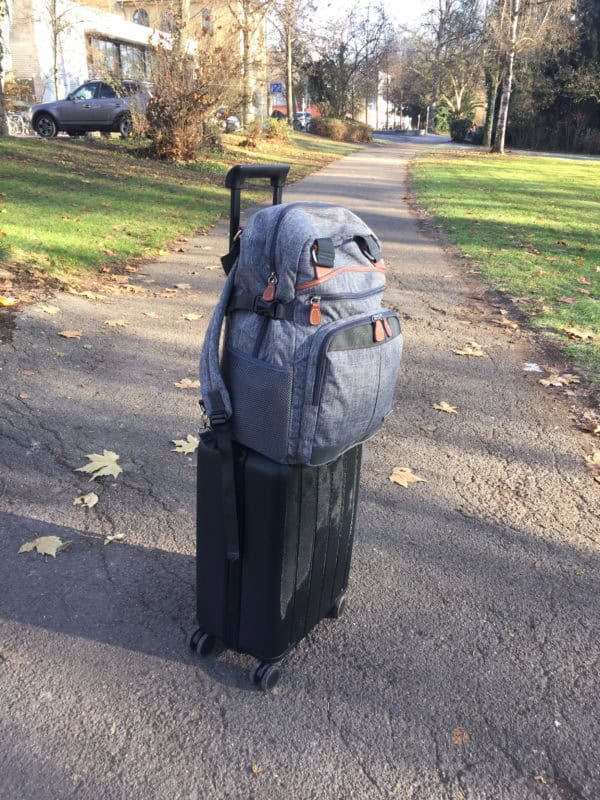
Luggage: Suitcases & Backpacks
I highly recommend bringing one carry-on size suitcase or travel backpack per person on your trip to Germany (plus a day bag, pack or purse).
You really don’t need to bring very much with you. Nobody will care if you wear the same clothes over and over. It’s easy to do laundry in Germany, so you can bring enough outfits for a few days and then do a load of laundry once or twice. And if you really need something, you can buy it.
Remember, if you’re traveling by public transportation you’ll need to take your luggage everywhere you go…that means up and down flights of stairs, on, off, and in the train, over cobblestone streets, over curbs, on and off busses, and up and down hotel stairs.
All of that is SO much easier with a small amount of luggage.
In the photo above you’ll see my carry-on size spinner suitcase and a backpack. That’s what I took on a 2 1/2 week solo trip to Germany in December a few years ago. It’s also what I’ve taken on all of my trips since 2019, including several months traveling around Europe.
On that 2019 winter trip I walked all over the Paris and Stuttgart airports, rode busses, walked 25 minutes from my Tübingen hotel to the train station, all over a Christmas market in a small town near Stuttgart (even popped into a bakery), and 20 minutes from the Stuttgart metro to my Airbnb with that pack on my back and my little suitcase. I could never have done that with larger or more luggage. Taking less gives you more flexibility.
Luggage I Use And Love:
1. travel backpack .
I have a much older version of this travel backpack and I LOVE IT. I’ve had it for over 15 years now and still use it. My backpack is comfortable, durable, and easy to pack and keep organized. I’ve had several travel backpacks over the years and because the one I have is built for a women’s frame, it fits me so much better than anything else (I’m 5′ 5”). It comes with a zip-off day pack but I don’t use it very much because I often bring a travel purse or crossbody bag instead. Aaron has even used this backpack!
2. Spinner Carry-on Suitcase
A few years ago a company asked if I’d like to try their new hard-sided carry-on suitcase (see photo above) and so I said yes, because why would I turn down a free suitcase? I’ve now used it on all of my domestic and international travel since 2019 (including our recent 6 months traveling around Europe) and am a convert to hard-sided spinner suitcases!
Unfortunately, the company that sent me my suitcase has gone out of business, which is too bad because it’s a great suitcase. So while I can’t recommend this specific spinner, I do recommend spinners in general. You can find several great alternatives here in all price points.
3. Carry-on Sized Suitcase
I loved my Eagle Creek travel backpack so much that I bought an Eagle Creek suitcase, too. The one I have is an older version of this carry-on suitcase and it’s still awesome.
I’ve used this suitcase for nearly 15 years and years and it still looks new. I’ve taken it to four continents, lugged it down cobblestone streets, up many fights of stairs, and stowed it in the overhead compartment on numerous flights with zero problems (on very small planes I gate check it).
The compartments are well-thought out and easy to pack (I can fit a huge amount of stuff in that little suitcase). I don’t use this suitcase as much as my hard-sided spinner suitcase, simply because after airlines changed their carry-on size regulations, my Eagle Creek is just a bit too big and I sometimes am required to check it. Makes me so sad because it’s such an awesome suitcase.
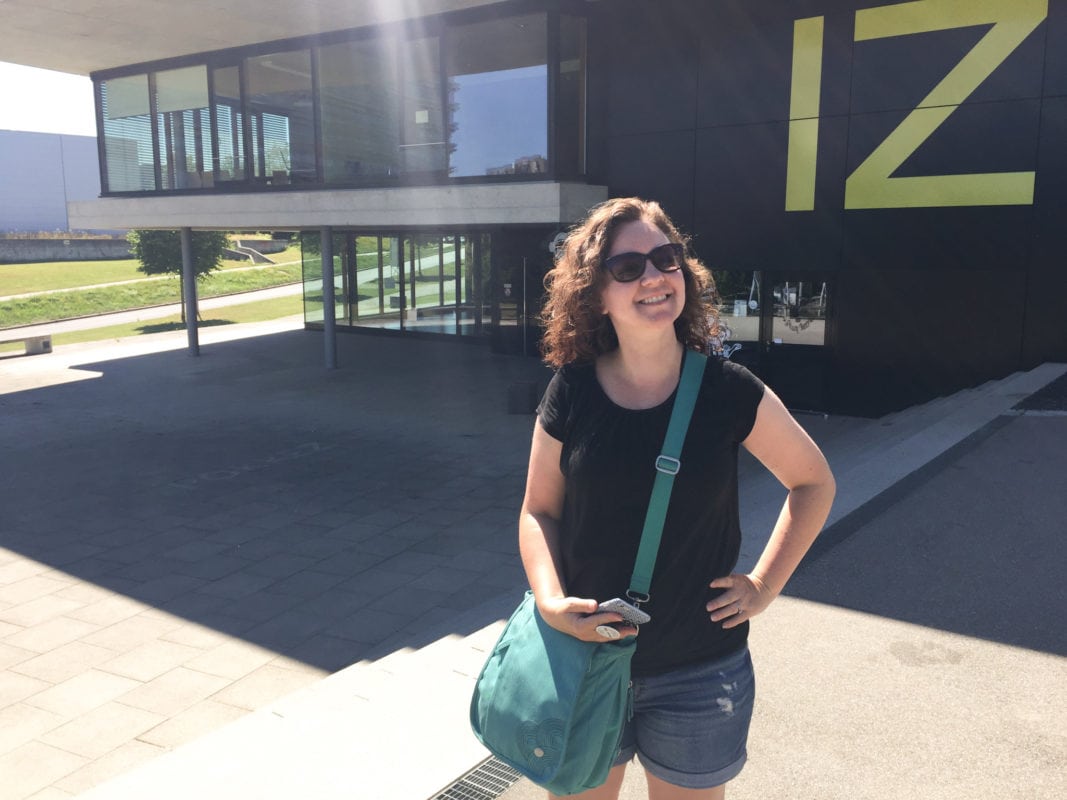
Luggage: Day bags, Purses & Wallet
In addition to my main suitcase (or travel backpack) I bring a day bag, purse, and wallet.
1. Small Backpack (Personal Item)
For many years I used an older version of this daypack as my personal item in conjunction with my carry-on suitcase. I love the size – big enough but not too big – and it’s comfortable, even when stuffed full or when I’m carrying heavy items. I’ve even used this as my main backpack on a 3-week trip to Europe. There are several pockets that make packing and staying organized easy, and I love the mesh pocket on the front for stowing things when I need my hands free (sunglasses, train ticket, lightweight jacket, etc).
Then I was sent a larger, cuter backpack by a bag company in Oregon ( I reviewed the backpack here ). I’ve since used this backpack on all of my trips since 2019. You can still find a few of them on Amazon .
If you’re looking for a cute, function, and affordable backpack for travel, try this one , this one , this one , this one , this one , and this one. If you’d prefer something convertible that you can wear as a backpack or a bag, take a look at this one and this one .
3. Travel Purse / Day Bag
I have several travel purses, bags, and clutches that I choose from when packing for a trip (I use them at home, as well). When I travel, I just choose one from my collection that will meet my needs on that particular trip. I generally choose purses and day bags that pack flat so I can take a couple options with me. My favorite cross-body bag is the teal one in the above photo. I hope it never breaks because they don’t make that size anymore! They do make a smaller crossbody , though, and that one even has a nice safety feature on the zipper.
If you’re looking for a travel purse with security features, check out my guide to finding the perfect travel purse .
4. Reusable Grocery Bags
We have 2 of these reusable shopping bags and take them on every trip! I bought ours about 14 years ago and they’re still going strong. We use them for groceries, souvenirs, laundry, taking snacks on trains, and luggage overflow. Ours roll up very small and are lightweight and durable. We highly recommend bringing one or two of these – they are invaluable!
5. Travel Wallet
I have a few different travel wallets that I use, depending on the type and length of my trip. One of my favorites is very similar to this one . The zipper makes it more secure and I like the option to use it as a clutch. More recently I decided to get something very small and lightweight liked this one the best.
6. Travel Lock For My Backpack
I always bring a small, lightweight but durable TSA-approved travel lock for my suitcase or backpack. I mostly use it on days when I’m in transit and can’t always keep my luggage near me. It’s nice to have for peace of mind. Update: since my spinner suitcase has a built-in lock, I don’t bring an extra lock anymore.
Grab our FREE Germany Trip Planning Checklist Now!
Packing & Organization
1. packing cubes.
I’ve used packing cubes to keep my suitcase organized for years. Aaron, too. Before I invested in a few sets of packing cubes I organized all of my clothes and other items with ziplock bags. I prefer the packing cubes because they don’t rip. But if you’re looking for an inexpensive option for just 1 trip, freezer bags of various sizes work well.
I have these three sets of packing cubes: these original packing cubes , this lightweight set , and a few others I’ve picked up along the way. I never use all of them on one trip. After I lay out all of the clothes and items I plan to pack, I choose my packing cubes. They keep my clothes, electronics, and miscellaneous items SO much more organized. And packing/unpacking takes about 5 seconds.
2. Lightweight Storage Bags
I sometimes use these lightweight storage bags for clothing but more often for all of those little miscellaneous items you need when traveling. I usually have one for things I need on the plane, one for my mobile office, and one for technology, batteries, and cords. If you’re worried about the white color, which I was, don’t worry. I wash mine after each trip and they still look good as new, even years later.
3. Lightweight Toiletries Bag
This lightweight toiletries bag is another item I’ve used for years. I love that it’s lightweight, not at all bulky, and easy to wash and keep clean and it packs pretty flat. I use that small toiletries bag for my non-liquid toiletries in conjunction with this TSA-approved liquids bag .
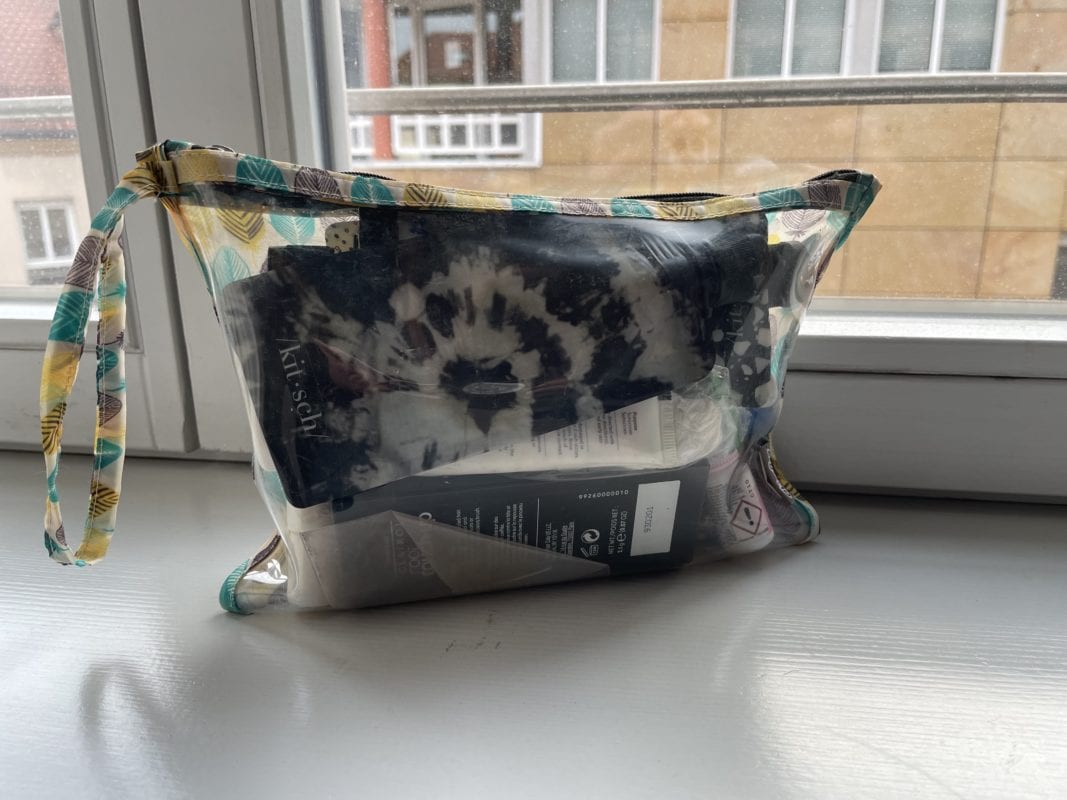
4. Refillable Flat Pack Shampoo Pouches
I used GoToobs bottles for years and years for all of my travel liquids. I loved them. But then, a few weeks before leaving for a 6-month trip to Europe last year I came across these flat pack refillable bottles and decided to give them a try. I liked them so I got a set for Aaron and we both used them every day for 6 months. They’re great! I like that I can label each one, they don’t leak, and that they take up less space as I use shampoo, conditioner, etc.
5. Travel Umbrella
If I’m traveling for business OR if I know I’m going to spend a lot of time outside and there’s a good chance of bad weather OR if I’m traveling with Aaron (he wears glasses and always uses an umbrella), I take a small, lightweight umbrella . Sometimes, though, I just risk it and either get a little wet or buy a cheap umbrella abroad (and then leave it in my last AirBnB for someone else to use).
6. Microfiber Towel
While I typically use the towels provided in my hotel or Airbnb, I usually bring a small microfiber towel when I travel. It comes in handy when the provided towel is small or if I decide to go to the beach or lake and don’t want to carry a larger towel with me.
That said, I’ve been looking at this Turkish Towel and am thinking about using that instead, as I’ve been hearing good things about them (super absorbent, dries quickly, large enough for the beach, and it seems like it would have a nicer feel than a microfiber towel).
Note: if you’re a wash cloth user be sure to bring some from home. You’re not likely to find them in German hotels.
7. Anti-frizz Towel for Curly Hair
I have curly-wavy hair and a little towel like this one has been a game-changer. My hair frizzes easily, especially when traveling in different climates, but using this towel has drastically reduced the frizz. And my hair dries faster. It’s small and light-weight so it doesn’t take up much space in my luggage.
Doing Laundry & Hand Wash
Because I usually take minimal clothes, I usually need to do laundry while traveling. I like to stay in AirBnBs that have a washing machine (usually no dryer, just a clothes rack), but when I can’t, I just find carve out a couple hours to spend at a laundromat. In-between, I do hand wash as needed. Here’s what I take with me to make doing laundry while traveling easy.
1. Dr. Bronner’s
I like to be ready to do hand wash laundry when I travel, so I always bring a small bottle of Dr. Bronner’s liquid soap . I’ve tried doing travel hand wash with all kinds of laundry soaps (liquid, powder and those little sheets of soap) and Dr. Bronner’s worked the best. It’s all natural, gets my clothes clean, and smells great (lavender is my favorite)! I buy a big bottle of Dr. Bronner’s (I use it at home all the time) and fill up a small bottle for each trip.
If you’d rather have individual packets, try Sink Suds packets.
If you’d rather wait until you’re in Germany, just buy a bottle of “Rei” at a drugstore – it’s cheap and works great for hand wash.
For years and years I did hand wash in a sink or bathtub while traveling (it’s hard to let go of my backpacker ways!). Then I tried using an extra large ziplock bag. The best method by far?
The Scrubba! It’s easy to use, there’s no mess, and it gets my clothes really clean. I like it for travel, camping, and for emergencies at home (if the power goes out during a hurricane, tornado or storm).
That said, I don’t take my Scrubba on every trip. If I’m staying in Airbnb’s where I know I’ll have access to a washing machine, I leave the Scrubba at home. It does pack down pretty small, though, and if you’ll be traveling for several weeks and would rather do laundry on your own time, rather than search for a laundromat, try a Scrubba .
Super cheap version: a super large ziplock will work for a couple small washes, too.
3. Sink Stopper
When I don’t bring my Scrubba, I bring a sink stopper so I can more easily do a little hand wash laundry in a sink or bathtub. These days, I usually just do a little hand wash here and there as needed.
4. Laundry Degergent Packets
You should be able to find these in the travel section of Target or Walmart. Sometimes I slip a couple in my TSA-approved 3-2-1 bag and use them when we do laundry in Germany so we don’t have to buy laundry soap. Usually, though, you can buy laundry detergent at a laundromat, and sometimes the AirBnB host will provide detergent – ask about this before you arrive.

Must-haves For the Flight
1. Memory Foam Travel Pillow I bought a memory foam travel pillow at the airport once just before flying from the US east coast to Melbourne, Australia and I’m SO glad I did. This pillow enabled me to sleep upright like no other travel pillow has. If we’re renting a car I’ll often bring this pillow with me to use on the plane and in the car. If we’re taking trains, I take the inflatable pillow below because it’s easier to pack.
2. Inflatable Travel Pillow I also have an inflatable travel pillow . It’s not quite as comfortable as the memory foam pillow but it’s more convenient because it packs up so small.
3. Travel Eye Mask Once I started wearing an eye mask on flights I was finally able to sleep!
4. Ear Plugs These are another must-have. I have a stash of disposable ear plugs and just grab several sets for each trip. With my travel pillow, eye mask, and ear plugs I can reliably get sleep on long flights, finally! They also come in handy in hotels (especially in cities or in the summer when we keep the windows open) or on trains.
5. Scarf with Hidden Pocket This is such a great idea! It’s an infinity scarf (so it won’t fall off) that has a secret pocket for items you want to keep close to you, like your passport, credit cards, room key, phone, etc. You can keep priority items secure and easily accessible while looking fantastic! Check out my guide to finding the perfect hidden pocket travel scarf .
6. Travel Wrap Scarf For an upcoming trip I just got this lightweight travel wrap scarf . It’s big enough to use as a lightweight wrap in warmer weather and a scarf in cooler weather. I’m eyeing this travel blanket/wrap scarf for my next trip. You can use it as a travel blanket on the plane and then as a travel wrap, scarf or shawl while traveling.
7. Travel Journal This is one of the most important things I take traveling. I love sitting down in a cafe or even on a park bench and jotting down notes about my day…and then having a wonderful memory of my travels to look at weeks, months, years later. The travel journal I’ve linked to is one I created. Click here to get one for your trip.
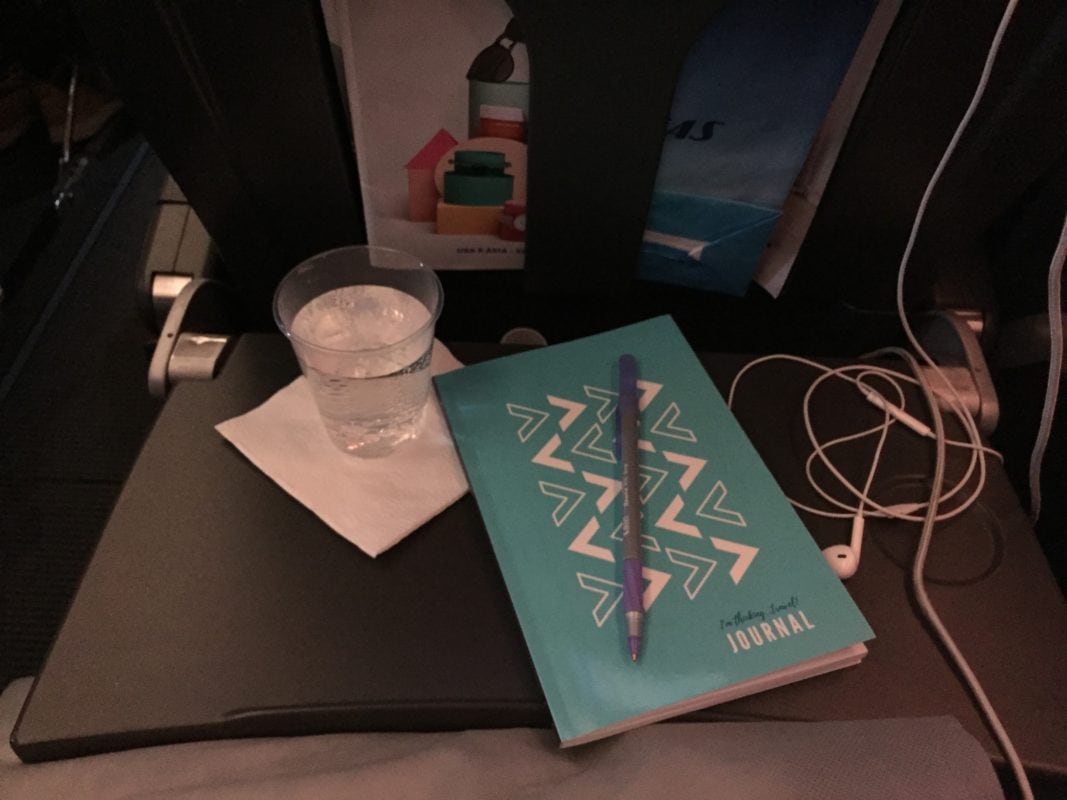
Clothes & Shoes
1. Merino Wool Cami I bought a merino wool cami a few years ago before I left for a month in Europe in the summer and it’s now one of my must-must-must have travel items. Merino wool is perfect for travel because it doesn’t absorb odors, and it will keep you warm on cold days and cool on warm days. It’s easy to wash by hand (if needed) or you can throw it in the washing machine. Plus, it dries quickly. I also recommend getting at least one merino wool t-shirt or long-sleeved base layer and/or a long-sleeved 1/4 zip pullover like this one . For our upcoming multi-season trip I have 2 merino wool camis, 2 merino wool t-shirts, and a long-sleeved merino wool 1/4 zip pullover. I love that I can wear them year round and layer them.
2. Merino Wool Shoes Merino wool shoes are awesome. Mine pack flat, which saves room in my suitcase or backpack, they keep my feet warm on cool days and cool on warm days, and – best of all – they don’t stink after I’ve worn them all day.
3. On Waterproof Cloud 5 Shoes These are my new favorite travel shoes. They were so comfortable that I wore them nearly every single day while traveling for over 3 months in Germany. I love that I can easily slip them on and off and the waterproofing kept my feet dryer when it rained (they’re more water resistant than fully waterproof). Tip: the waterproof version run small so size up.
4. Merino Wool Socks My secret to staying warm while traveling in the winter? Wool knee socks! They keep my legs warmer than when I wear boots and take up a lot less room in my luggage. These wool knee socks are similar to the ones I got about 10 years ago (that I’m still wearing). The only downside of these socks is that they don’t have any cushioning, so sometimes I switch them out for socks like these.
In the summer, I wear no-show merino wool socks like these . They’re easy to wash, comfortable to wear, and they don’t smell – perfect for travel.
5. Flip Mittens I got a pair of flip mittens in London several years ago and have used them every winter since. Aaron saw how I was able to easily use my phone, get into my day bag, and take money out of my wallet without taking my mittens off and then got himself a pair. Highly recommended if you’re traveling during the winter. This pair is similar to ours and comes in several colors.
6. Flat-back Earrings On our 3-month Germany trip I decided that I didn’t want to bother with much jewelry. So I got this set of surgical stainless steel stud earrings. They have flat backs so I can sleep comfortably in them, and the back screw onto the posts, so I don’t have to worry about losing them. The set comes with 18 different pairs, so before we left I chose the pairs I liked the best and put a few extras in a small pouch in case I want to switch them out. Click here to check out these cute stud earrings!
1. Pop Socket Makes holding your phone to take a photo, read on public transit or look at Google maps so much easier. We each have a Pop Socket on our phone cases.
2. Wrist Strap For Our Phones We use our phones to take photos and videos all day long while traveling. Even though we each have a Pop Socket on our phone case, we were still always a little worried we’d drop our phones, especially in crowded areas where people are bumping into us or if we’re on a boat, bridge, overlook, etc. So we got wrist straps – I got this wrist strap that works with my favorite phone case, and Aaron got this one that attaches to this phone case . Highly recommended!
3. Portable Back-up Battery for Our Phones This is another must-must-must have!! We use our iPhones all day when we travel (checking maps, reading guides, taking photos and videos, using navigation, reading restaurant reviews, etc) but doing all of that drains our phone battery by about 2pm. So, we bring this back-up battery with us each day. It’s easy to charge our phones while we’re out and about because the battery is fairy small, lightweight, and easily fits in my purse or bag or Aaron’s backpack.
It also comes in handy on long flights, trains, and in Airbnbs and hotels where the outlet is really far away from the bed. I’ve had two Anker back-up batteries and I’ve been impressed with both. We can get 2-3 full phone charges before needing to charge the back-up battery (we charge it each night, though, just to be on the safe side).
4. European Outlet Adapter I always bring enough socket adapters so I can charge all of my devices at the same time. They’re small and lightweight (the ones you need for the UK are a bit bigger) and worth the little bit of extra space they take up. If you’re not sure what you need to safely use your tech in Germany, read our guide to voltage converters and adapters.
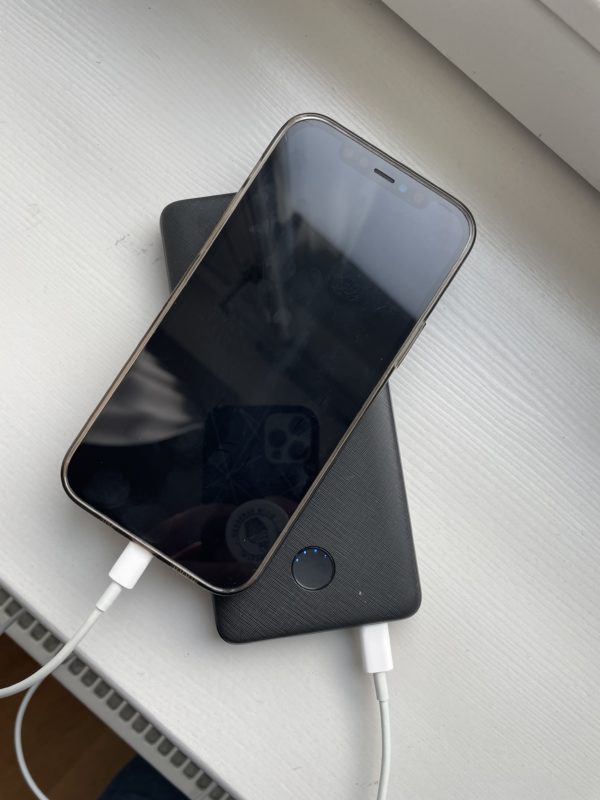
5. Apple Laptop Adapter A few years ago I got this special Apple Laptop Adapter kit and I love that the socket adapter fits right into my power cord. So much easier to use when I’m traveling for work or want to use my laptop in a cafe.
6. Protective Laptop Shell After my laptop slid off my lap and the screen cracked – 3 days before leaving for a work trip in Europe! – I bought a hard laptop shell . It makes my laptop slightly thicker but much safer, which is important to me, since I almost always take my laptop when I travel. These laptop shells are inexpensive and come in tons of colors and designs. 7. Kindle Paperwhite I love to read when I travel and I rarely buy hardcopy travel guides anymore, so my Kindle Paperwhite comes in very handy when I travel. If I’m really pressed for space I’ll leave the Kindle at home and just use my iPhone but I prefer to read on my Kindle.
Other Must-Haves
Portable Coffee Pour-over Having good coffee in the morning is a must-have for Aaron, so he got this collapsable coffee pour-over filter . It’s small but will make a nice big cup of coffee (he’ll buy ground coffee once we’re back in Germany). If you’re not sure whether you’ll be able to heat water in your hotel room, you can also take a portable water kettle !
Organic Fairtrade Single Serve Instant Coffee Packets Aaron also bought a box of this highly rated instant coffee for travel coffee emergencies. The packets are single serve so you can take just a couple or have enough for coffee every day.
Travel Insurance I admit, travel insurance isn’t something I’ve always packed. But after Aaron needed emergency surgery in Germany several years ago, and the two of us were evacuated during a forest fire in Washington State, I’ve realized how important travel insurance is! I highly recommend putting travel insurance on your packing list. For our most recent trip we used Safety Wing and were very happy with it.
Items I’m Thinking About Getting
1. Shoe Bag I typically wrap my shoes in simple plastic shopping bags but they rip easily, so I’ve been considering investing in a few reusable shoe bags instead.
2. Cinch-it Organizer This seems more like a nice-to-have rather than a must-have but I’m intrigued by it! I like that you can open this bag up and easily see everything inside. I also love the lightweight fabric and that there are six pockets for organizing your things.
3. Noise-canceling Headphones I always bring ear buds when I travel but I’m thinking about investing in noise-canceling headphones .
4. Multi-device Charger/Adapter I always need to charge multiple devices when I travel and I often don’t have enough outlets in hotel rooms and AirBnBs – or they’re hard to reach behind a couch or nightstand table. I’m considering a multi-device charger so I can charge all of my devices easily and in one location. Update: we bought this one and used it every day during our recent 6 months in Germany. Highly recommended!
5. iPhone Stabilizer/Gimbal Now that we take more video when we travel (as well as at home), we’re looking at getting a stabilizer/gimbal . I’m amazed at how much smoother and better videos are when you use a gimble! I’m just not sure I want to carry it around all day.
Update: We bought a gimbal and took it on our most recent 3-month stint in Germany. The video we shot with it was excellent! But it was a pain to set up on the fly so we didn’t use it nearly as much as we thought we would. A a friend of mine says she uses this GorillaPod instead. It’s not as smooth as a gimbal but she said it works pretty well and is a lot less expensive. We also found we could shoot pretty smooth video if we simply were mindful about what we were filming. Not as good as with the gimbal, of course, but much easier.
6. Reusable snack pouches and straws I like to buy healthy snacks at the local grocery store to eat while I’m out sight-seeing and on transit days. I often bring a few ziplock bags with me when I travel but they wear out pretty quickly. So I’m thinking about buying a few reusable bags. I’m trying to decide between these , these , and these . Update: I’m now thinking about getting this beeswax wrap instead because I think it’ll pack flatter and be more versatile. I’m also trying to reduce my plastic straw use and am consequently looking at this reusable straw and this one .
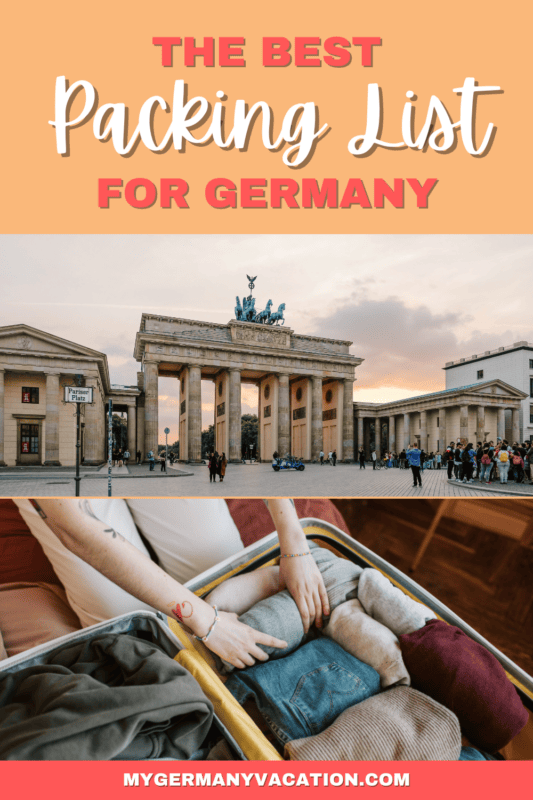
Next Steps For Planning Your Trip:
- Start planning an unforgettable trip to Germany here !
- Book a personalized travel consult or itinerary review with Cate .
- Join our friendly Facebook group .
Cate has been traveling to Germany for 30+ years. She has lived in Germany, taught college German, and has a PhD in German Applied Linguistics. She loves helping travelers plan their dream trips to Germany!
Similar Posts
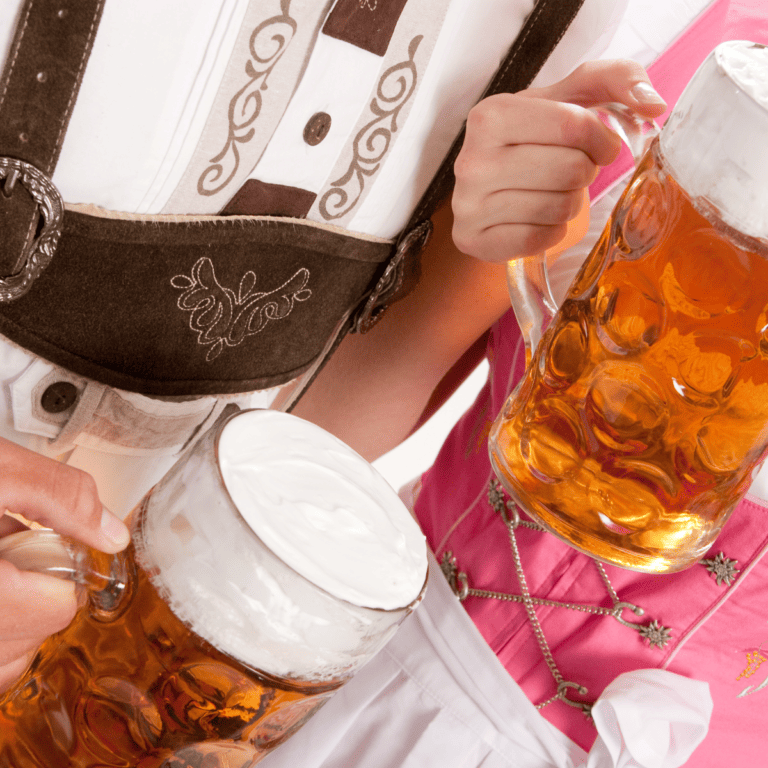
What to Wear to Oktoberfest in Munich in 2023
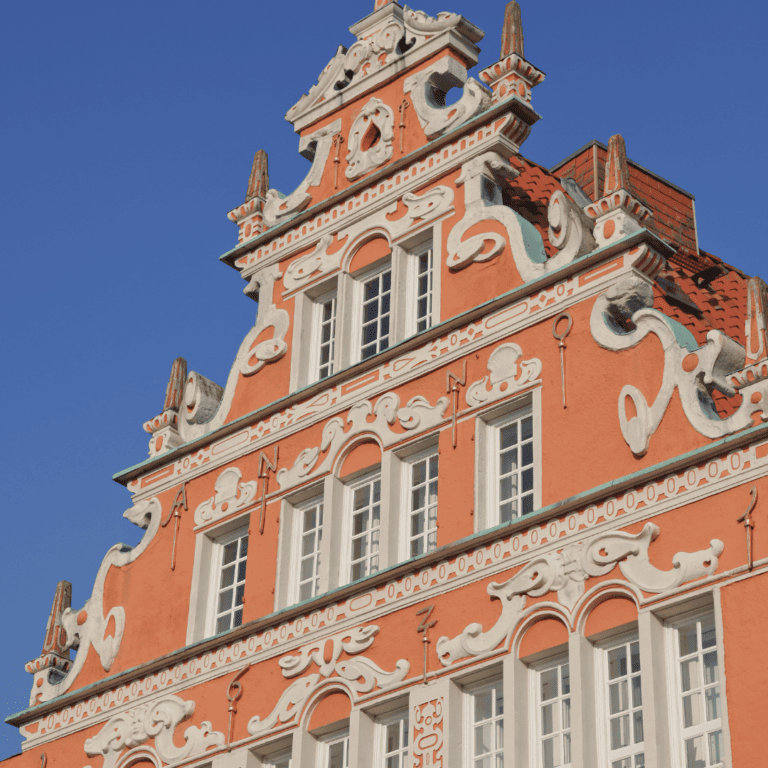
Can I Go to Germany Right Now? (Your COVID-19 Questions Answered)

Best Electric Travel Tea Kettle in 2023
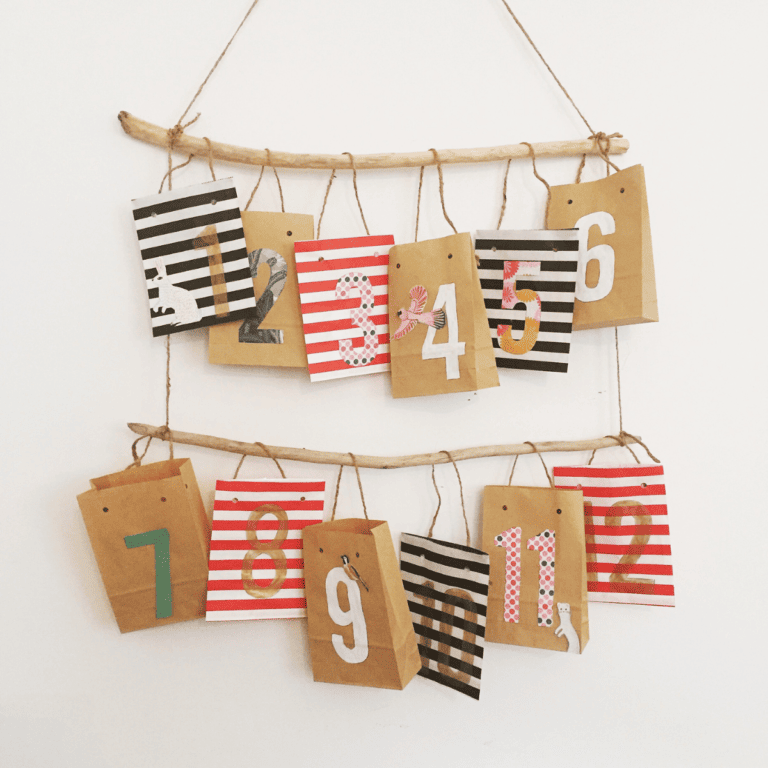
German Christmas Advent Calendar Ideas for Kids & Adults
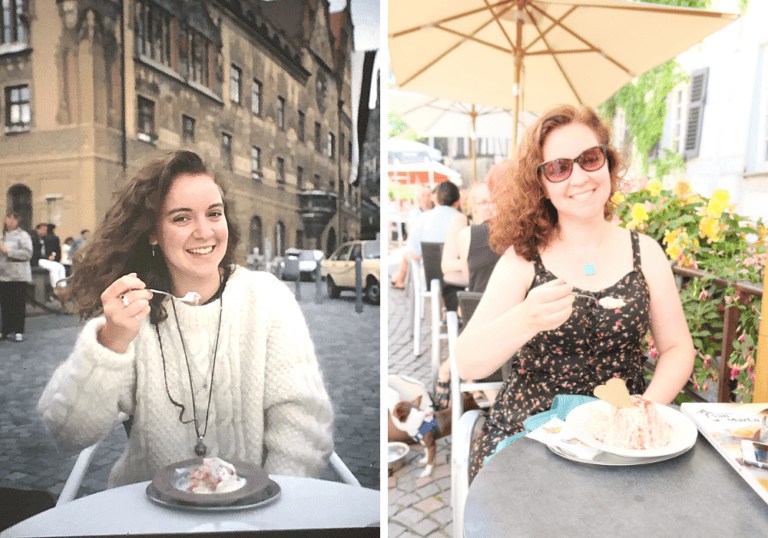
Recreating 25 Old Photos From Living And Traveling In Germany
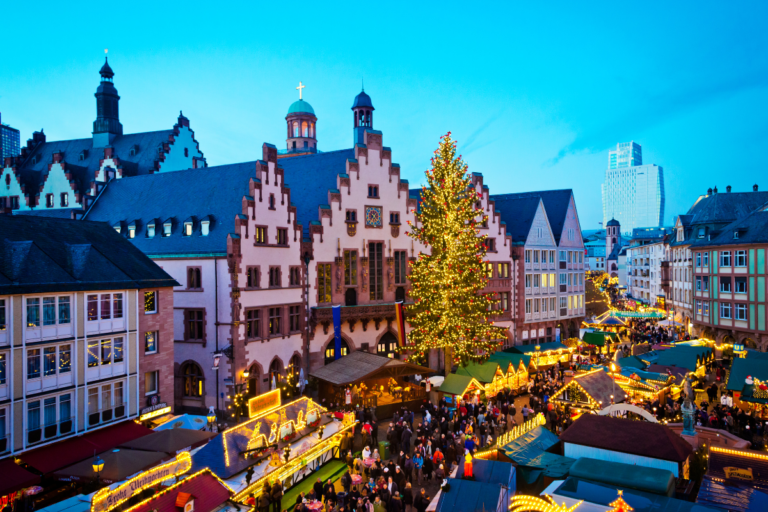
How to Celebrate Saint Nicholas Day Like a German
Here’s how we can help you plan your perfect trip in 2024.
GERMANY TRAVEL PLANNER: Just getting started? Have questions about Germany’s confusing train tickets or how to find the best guided tours? Not sure which parts of Germany should be in your itinerary (and what to leave out)? Our Germany Travel Planner answers those questions and more via how-to videos, our interactive Germany Planning Map, City Cheatsheets, and MUCH more. Click here to unlock the best of Germany the easy way!
GERMANY TRAVEL CONSULT: Feeling overwhelmed? Itinerary just not coming together? Wonder if a few tweaks would take your trip to the next level? Book a Mini or Full consult with Cate! She’ll help you create or tweak your itinerary, recommend train tickets/passes, hotels, things to do, guided tours, show you how to buy train tickets, orient you to specific cities, help you plan out day trips, and answer your Germany travel questions.
ACCOMMODATIONS: We recommend using Booking.com since they have widest range of accommodations available from hostels, boutique hotels, luxury chains, aparthotels, at the best prices. Check out our accommodation guides for specific recommended hotels.
WHAT TO PACK: If you’re bringing your phone, be sure to bring this plug adapter , this power bank , and this wrist strap . They’ve been lifesavers for us! You can see our other packing essentials here and here .
TICKETS & TOURS: For guided tours, day trips, private tours, and skip-the-line tickets, Get Your Guide is our go-to!
TRAINS & BUSES: To research train schedules and buy tickets or a Germany Rail Pass, we recommend the official Deutsche Bahn (German Rail System) website (and download their DB Navigator app). For buses, look at FlixBus , which offers tickets for routes within Germany and to other European countries. FlixBus is often cheaper than trains but can take longer.
hi kate, I have been reading your articles and love the way you put across things so simply. I am traveling to Germany from oct 14-23,Rd. can you help me with a few walking/ trekking routes around Lake Konigsee on reaching st. Bartholomew. duration can be about 4 hrs.
There are so many hiking opportunities in that area! Here’s a website that has some hiking ideas for Königsee: https://www.alltrails.com/de/germany/bavaria/schonau-a-konigssee–2 (you can use google translate to read it in English). You can also take the boat to St. B and then hike from there. One trail goes to an ice cave!
Leave a Reply Cancel reply
Your email address will not be published. Required fields are marked *
Save my name, email, and website in this browser for the next time I comment.
- International edition
- Australia edition
- Europe edition

Share a tip on travel in Germany – you could win a holiday voucher
Tell us about your favourite places to visit in Germany – the best tip wins £200 towards a Coolstays break
With the Euro 2024 football tournament just a month and half away, the spotlight is going to be on host nation Germany in the early part of this summer. Whether you’ve enjoyed visiting the big cities with their bierkellers and clubs, the country’s Baltic coast and islands, half-timbered ancient villages, or its famous forests and mountains, we’d love to hear about your favourite experiences.
If you have a relevant photo, do send it in – but it’s your words that will be judged for the competition .
Keep your tip to about 100 words
The best tip of the week, chosen by Tom Hall of Lonely Planet , will win a £200 voucher to stay at a Coolstays property – the company has more than 3,000 worldwide. The best tips will appear in the Guardian Travel section and website.
We’re sorry, but for legal reasons you must be a UK resident to enter this competition.
The competition closes on 29 April at 9am
You can tell us about your favourite trip in Germany by filling in the form below.
Please note, the maximum file size is 5.7 MB.
First name only if you prefer
This competition is only open to UK-based readers

Have a look at our past winners and other tips
Read the terms and conditions here
- Readers' travel tips
- Germany holidays
- competitions
Most viewed

IMAGES
VIDEO
COMMENTS
In this post we'll look at a lot of German vocabulary and expressions that will come in handy when you travel. Let's start with the basics. Mein Koffer: My Suitcase. Before you travel, you of course need to pack. So let's start there. der Koffer, -Ø suitcase; Ich muss meinen Koffer packen. I need to pack my suitcase.
Here are a few informal ways to express "have a safe trip" in German: Gute Reise! Yes, you read it right! "Gute Reise" can also be used in informal settings. It's a versatile phrase that works well regardless of the formality level. Whether you're saying goodbye to a close friend or a family member, "Gute Reise" will always be ...
136 Useful German Travel Phrases, Expressions and Vocabulary Words. Planning your big trip to Germany is so exciting—but you're not done until you've brushed up on common German phrases for travel. In this post, you'll find a handy phrasebook of German travel phrases and vocabulary, conveniently organized by group.
Introduction. If you're planning a trip to Germany, knowing a few basic German phrases can go a long way in enhancing your travel experience. While many Germans speak English, making an effort to communicate in their language shows respect and can lead to more meaningful interactions.
17 Important Must-Knows Before You Travel in Germany. 1. It's all about that cash money, yo. You might expect Germany, producer of supercars and epic technology to be on board with the whole credit card trend, but this simply isn't the case. I know it's weird, but you'll find that many places in Germany don't actually take credit card ...
If you have a week, you could visit 2 cities (plus 2 day trips) in different parts of Germany and allot one day for travel between cities (e.g., a few days in Munich with a day trip to Chiemsee, travel day to Berlin, then a few days in Berlin with a day trip to Potsdam). Or you could spend a week touring one region of Germany (e.g. the Black ...
Germany Travel Guide. Last Updated: April 18, 2024. Germany. The country is synonymous with beer, sausages, incredible hiking, majestic castles, serious people, and wild techno parties. It's huge, diverse, and utterly amazing. There's a vibrant art and music scene in Berlin, beautiful forests in the west, majestic cathedrals and castles ...
When you visit a country for the first time, it can be intimidating — especially if you don't speak the language. So getting to know a foreign language before visiting can take the pressure off of your trip and enhance your experiences. With a language like German, you're in luck because the words are generally phonetic like in Spanish.
1 Week in Germany: Maritime Experience. Rivers and boats have defined Germany's history and this sample itinerary shows them off. 4 days in Koblenz and the Rhine - Base yourself in Koblenz and explore the Rhein and Moselle river valleys. This is wine country and castle country, enjoy them.
Generally, Germany has a moderate climate. In summer you can walk around in shorts and a T-shirt — although some days it can get really hot. In spring and fall, be prepared to wear trousers ...
Plugs/Electronics Used in Germany. Germany uses a two-prong officially classified as Type C, or E/F plug with 230 Volt. This is also the kind of plug that will work in many other places in Europe. That means if you're coming from North America or the United Kingdom, you will need an adapter for your style of plug.
How to learn German for travel: Is 4 weeks enough? Earlier this year, I planned a trip to Italy and studied Italian for 4 months to prepare. It was great! I had lots of meaningful conversations, confidently navigated cities and towns in the countryside, and successfully ordered what I intended, every single time. 💯.
6 Stuttgart & the Black Forest in Southeastern Germany. 7 Rhine Valley & Cologne in Central Germany. 8 Lake Constance (Bodensee) in Southern Germany. 9 The Romantic Road (Romantische Strasse) in Southern Germany. 10 If You're in Germany in December. 11 If You Have Fewer than 10 Days in Germany.
Talking about vacation in German, part 2. In my yesterday's post I already discussed how to talk about vacation or vacation plans. Now, I'd like to continue with this topic. Further expressions around the topic "vacation" are: 1. Urlaub machen - to take a vacation. So, when you would like to know when someone is about to take a ...
Day 2: Heidelberg. Walk and window shop the vibrant old town. The main street, Hauptstrasse, will take you past many interesting places. Explore the ruins of the Heidelberg Castle on the hill, one of the most important Renaissance structures in the area. Relax with the swans on the riverfront, or take a boat cruise along the Neckar River.
Take a trip in German: What's German for take a trip? If you want to know how to say take a trip in German, you will find the translation here. You can also listen to audio pronunciation to learn how to pronounce take a trip in German and how to read it. We hope this will help you to understand German better.
The total driving time for this itinerary would be about 5 hours 30 minutes with a total distance of approx. 520 km. Of course, this can change depending on the route you are taking and the time of day you are travelling. Commuter traffic could add quite a bit of travel time to your journey. Day 1+2: Berlin.
Our Germany Travel Planner, video itinerary reviews, one-on-one consults, and custom itinerary services take the stress out of planning the trip of a lifetime. We're Cate and Aaron, two passionate travelers who have been exploring Germany for almost 35 years. Our mission is to help you make the most of your time in beautiful Deutschland.
Itinerary #1: Highlights of Germany's Cities. Consider this classic itinerary; an excellent choice for foodies and first-time visitors interested in experiencing German history, culture, arts, and cuisine in some of the most popular spots.You'll explore Frankfurt's historic center on a walking tour, go wine tasting in the Rhine Valley, check out the street art scene in Cologne, and learn about ...
Day 4 of road trip in Germany: Exploring the castle of Burg Eltz Driving Time: Munich to Burg Eltz Castle is 5.50 hours, one way. The next day get ready for another castle - Burg Eltz. This is one of the most beautiful places to visit in the whole country.. Burg Eltz is a beautiful German castle that lies merely 3.5 hours away from my hometown of Antwerp, and it's been on my to-do list for ...
5 Key Takeaways. Germany offers a multitude of epic road trip routes, including the Romantic Road, Fairy Tale Road, Wine Route, The Castle Road, and Black Forest Panoramic Road, each providing unique and breathtaking experiences. Preparation is key for a successful road trip in Germany. This includes understanding the local traffic rules ...
Step Two: Buy Your Germany Train Tickets. The pricing of trains in Germany is dynamic, meaning the cost changes depending on when you buy it and what demand is like. It is totally bananas to me that a ticket, when booked early, can be 20 euros but if you wait until the day before/day of it can go up to 180 euros.
Keep Your Voice Down. Germans value their privacy and personal space and hence don't engage in much small talk. Their blunt and straightforward nature may take some getting used to but it's refreshing to encounter. Be courteous and keep your voice down in public places, such as cafés, restaurants and shops.
Germany road trip itinerary - From the North Sea to the Baltic Sea. Pack your bathing suit, because this route takes you to the most beautiful beaches and places by the North Sea and Baltic Sea. 🗓️ Duration: 7 days. 📍 Route: Hamburg - Sankt Peter-Ording - Sylt - Fehmarn - Lübeck - Fischland Darß Zingst - Rügen.
The roughly 175-mile (283km) journey from Munich to Lindau, via the stunning mountain town of Berchtesgaden (pictured), covers some of the best of it, passing dozens of castles, mountain peaks and ...
1. Merino Wool Cami. I bought a merino wool cami a few years ago before I left for a month in Europe in the summer and it's now one of my must-must-must have travel items. Merino wool is perfect for travel because it doesn't absorb odors, and it will keep you warm on cold days and cool on warm days.
The best tip of the week, chosen by Tom Hall of Lonely Planet, will win a £200 voucher to stay at a Coolstays property - the company has more than 3,000 worldwide. The best tips will appear in ...